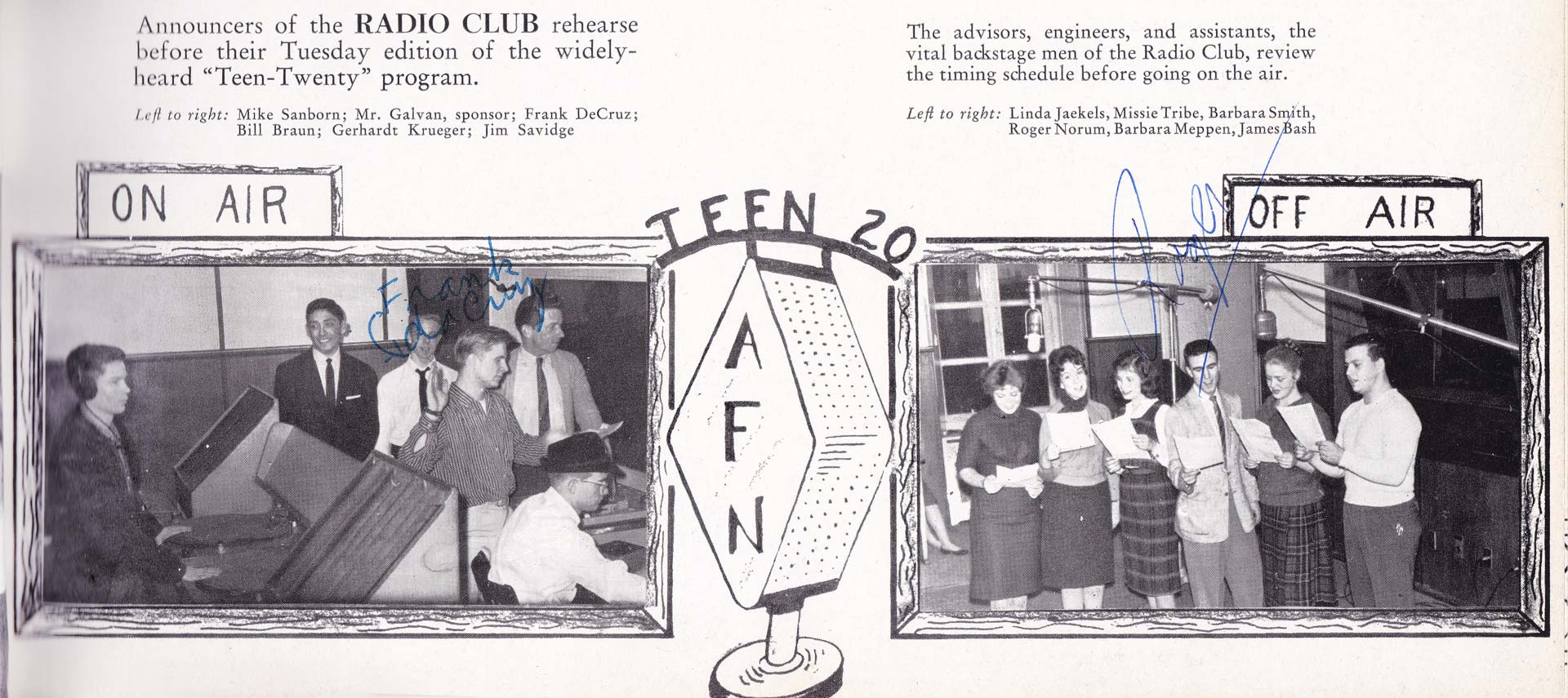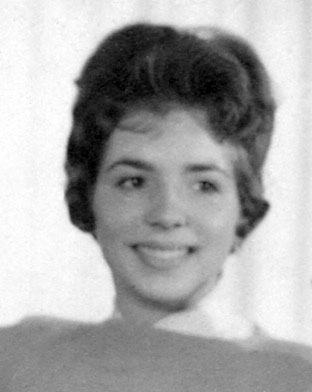|
|
←(Use Google Translate to see an approximate
translation into another relevant language)
|
[General index]
[Index to chapters]
[Index to galleries]
[Full family history]
This document is about when my Mom, Dad, brother, and I lived in Frankfurt
am Main, West Germany, 1959-61. It's just one part of a much larger family history written for my children, Peter and Amy.
To me, the Army base in Frankfurt was a model for a near-ideal society,
composed of people from all parts of the country, of all races and religions
and economic classes, living together, working together, going to school
together, learning about one another, all in low-stress economic security,
none rich, none poor; a way of life virtually extinct today. 'Nuff
said!
Cast of characters:
Mom: my mother
Vivian Lund, a housewife;
Dad: my father
Frank da Cruz Sr., who
worked for the CIA;
Dennis: my younger brother
Dennis da Cruz, who died in 1979;
Judy or Mommie: my ex-wife
Judy Scott, mother of Peter and Amy;
Granpa, Judy's father.
Photos: Most
were taken by me or my father, some others contributed by other Frankfurt
veterans, and others were found on the Internet. If you
have photos of the area that you think would fit, please send them to
me; if I use them, of course I'll credit them however you want.
—Frank da Cruz <fdc@columbia.edu>
Recent additions:
Most recent update: 30 March 2024 07:17:17
Frankfurt am Main, Germany, 1959-61
My dad's job takes us to postwar West Germany for two and a half years.
We lived in US Army housing and I went to the Army high school for 9th,
10th, and 11th grades.
Also see (onsite)...
Frankfurt aerial views
and WWII bomb damage
(Click image strip
to see gallery)
 Other galleries:
Other galleries:
AND (on Youtube)...
- The Abrams
Building and the American Experience in Frankfurt, a 30-minute video
production by the US Army V Corps with Hessischer Rundfunk on the occasion
of the withdrawal of US forces from the area in 1995. It focuses on the
Farben building (which the Army called the Abrams building) from its first
conception in the 1920s, through its construction, its role in the War, the
bombing of Frankfurt, the allied entry into Frankfurt, Germans living in the
rubble, soup lines, the Sperrgebiet (when the whole area was enclosed in
barbed wire 1945-1948), the construction of American housing and
facilities, the Berlin Airlift, AFN Frankfurt, formation of the
Bundesrepublik in 1949, and the Cold War. The first 20 minutes are mainly
archival footage from 1930s-50s, with a little borrowing from the 1948
film, Berlin Express. The video ends
with interviews with Germans and Americans upon its closing in 1995,
including
Leslie Spear, who was born in Frankfurt in 1948, graduated from
Frankfurt High School in 1967, and liked it so much there that she stayed on
and worked in the Farben building until it closed in 1995; she died in
Frankfurt five years later.
- Im Herzen
Frankfurts - Die neue Altstadt, HR Fernhsehen / Hessischer Rundfunk
(accessed 20 July 2021). A 44-minute German-language video on the
2012-2018 reconstruction of a portion of the Frankfurt Altstadt, which
had been destroyed in the war. Also see this
Wikipedia page.
References...
- Book: Lemza, John W, American
Military Communities in West Germany, McFarland & Company (2016).
- Book: Elkins, Walter, et
al. Amerikaner
in Heidelberg 1945-2013, Verlag Regionalkultur Heidelberg (2014), ISBN
978-3-89735-806-5 (auf Deutsch). Kind of like a coffee-table book
with lots of photos. If only there were a book like this for Frankfurt!
- Online:
Dewey Arthur Browder, The
Impact of the American Presence on Germans and German-American Grass
Roots Relations in Germany, 1950-1960, Louisiana State University and
Agricultural and Mechanical College PhD dissertation (1987), 274 pages.
Detailed social history of the early Occupation. In 1987 Browder was a
Lieutenant Colonel in the US Army with a German wife.
- Film:
Berlin
Express, Jacques Tourneur, 1948: extensive footage
of the Hauptbahnhof, the IG Farben building, and the ruins of Frankfurt.
I have a gallery of screenshots here.
- Video:
Frankfurt am Main
with Alemanizando: from half-timbered houses to the top of a skyscraper,
Youtube, about 7 minutes.
- Video:
Don't visit
Frankfurt's old quarter: let me show you an alternative (Höchst),
youtube, about 6 minutes. The Höchst castle housed the AFN Frankfurt radio studios when I lived in
Frankfurt, and a group of us Frankfurt High School students broadcasted a
live radio show from there every Tuesday.
Frankfurt 1959-61 narrative
"You should write a book about your theory that the only golden age that
this country ever experienced was in the military outposts overseas. A
totally new idea."
—Heidi Laird, email, 26 October 2023
Heidi
Laird is a German expatriate who grew up in Frankfurt during the
Nazizeit and the early postwar. She fled to the USA as soon as she was old
enough and has been here ever since. Now a retired clinical psychologist
and author of the books The
Frankfurt Kitchen and Letters
from Jenny, she looks on with horror as 1930s German history
repeats itself in the USA 90 years later.
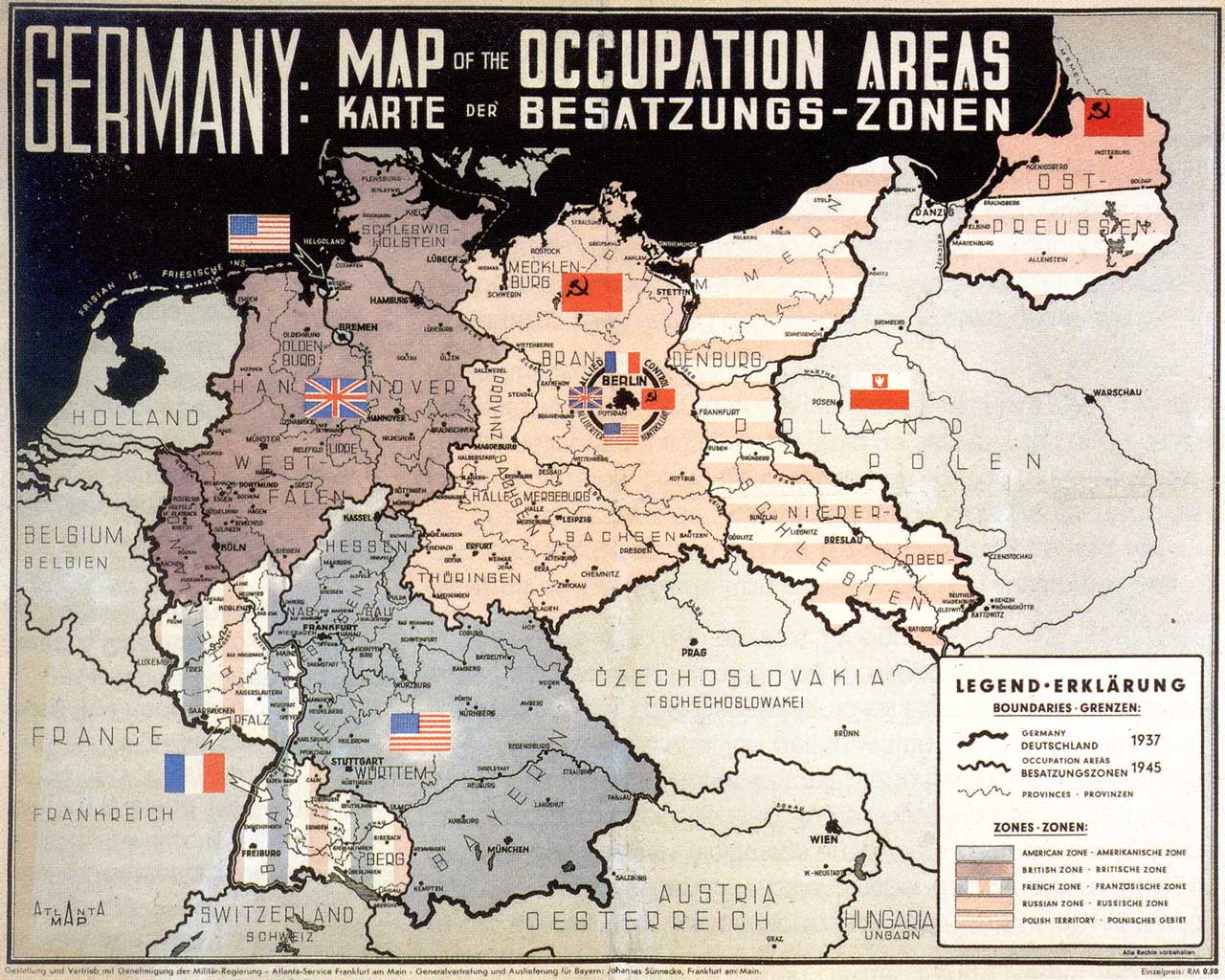
|
| Germany occupation zones
|
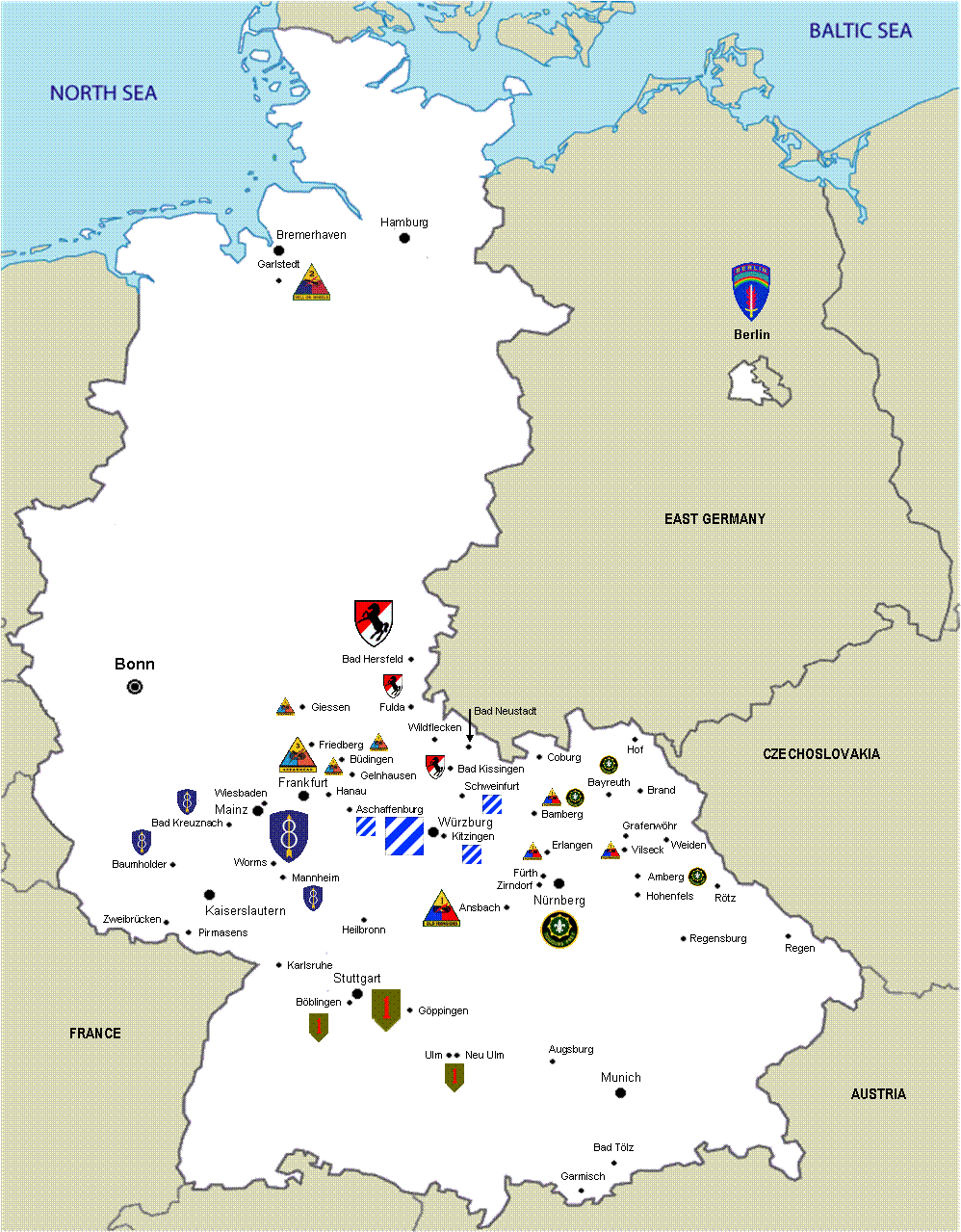
|
| US forces in 1959
|
At the beginning of 1959 (for me, the middle of 9th grade at
Williamsburg Junior High School in
Arlington, VA)
my dad was sent to Germany
and the government paid for the whole family to go. Germany was still
carved up into US, Soviet, British, and French occupation zones, although
technically the occupation ended in 1949. By the mid-1950s, the French zone
(mainly the Rheinland) existed only on paper; it was full of American
military bases, such as at Kaiserslautern where I would be stationed as a GI
just four years later, and many others including Baumholder, Zweibrücken,
Pirmasens, and Bad Kreuznach. Berlin was in the middle of the Soviet zone
which became a distinct country, the German Democratic Republic (DDR) or
"East Germany"; Berlin itself was still divided into Soviet, American,
British, and French zones. The geopolitical events of this period lent an
intensity to our experiences that now, six decades later, still has
not faded:
- 10 November 1958
-
As we were packing up to leave Virginia for Germany, Soviet Premier
Khrushchev gave a speech demanding that the Western powers withdraw from
West Berlin because they had violated the Potsdam agreement by rearming
West Germany and bringing it into NATO.
- 25-26 September 1959
- Camp David summit where President Eisenhower and Premier Khrushchev
de-escalated the Berlin situation.
- 1 May 1960
- The U-2 Incident, in which an American spy plane was shot down over the
Soviet Union, and which reignited US-Soviet tensions and re-escalated the
Berlin situation.
- 17 April 1961
- The Bay of Pigs Cuba invasion.
- 4 June 1961
- Vienna summit between Premier Khrushchev and the new American
president, John F. Kennedy, in which Khrushchev renewed his insistence that
Western forces leave West Berlin.
- July 1961
- President Kennedy, unwilling to abandon West Berlin, prepares for war by
calling up reserves and doubling the US military draft.
- Sunday 13 August 1961
- Stacheldratsonntag — Heavily guarded barbed wire is strung
along the East-West Berlin boundary line, which would soon become the Berlin
Wall. This marked the end of the Berlin Crisis of 1958-61 and averted World
War III.
(By this time I'm back in Virginia)
- 22 October 1961
- The Checkpoint Charlie standoff in Berlin.
- 16-28 October 1962
- The Cuban Missile Crisis.
(Now I'm in the Army and back in Germany)
- 26 June 1963
- President Kennedy visits Berlin and says "Ich bin ein Berliner".
- 22 November 1963
- President Kennedy assassinated.
During each of these incidents, US forces (our parents and, starting in
1963, myself) were on high alert, expecting either nuclear war or a massive
armored ground invasion of West Germany at any moment.
References...
- German
History in Documents and Images (GHDI), German Historical Institute,
Washington DC.
- Speech
by Soviet Premier Nikita S. Khrushchev, November 10, 1958 (GHDI).
- Peter J. Ortmann, Berlin
Mitte und die Welt - wie sie einmal war, ISBN 978-1-4452-6699-2 (2009),
668 pages.
- The Berlin
Crisis of 1961, Wikipedia (accessed 21 December 2019).
- Donald A. Carter, Forging
the Shield: The U.S. Army in Europe 1951-1962, U.S. Army Center for
Military History (2015), 513 pages, with photos: pp.363-368 and 403-427 on
the Berlin Crisis.
- Schulze, Inga,
Warum Frank aus N.Y. nicht von Frankfurt lassen
kann,
Frankfurter Neue Presse,
22 June 2006.
The Voyage to Germany
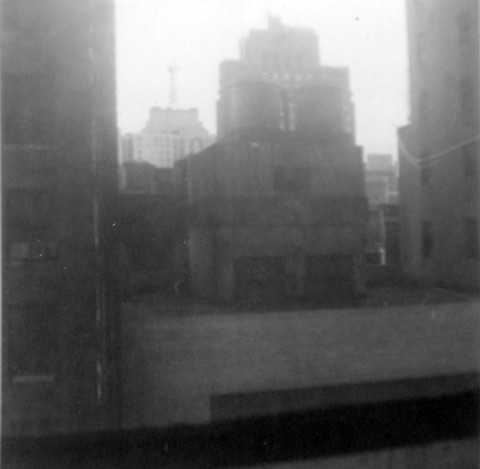
|
| View from Hotel Dixie 1959
|
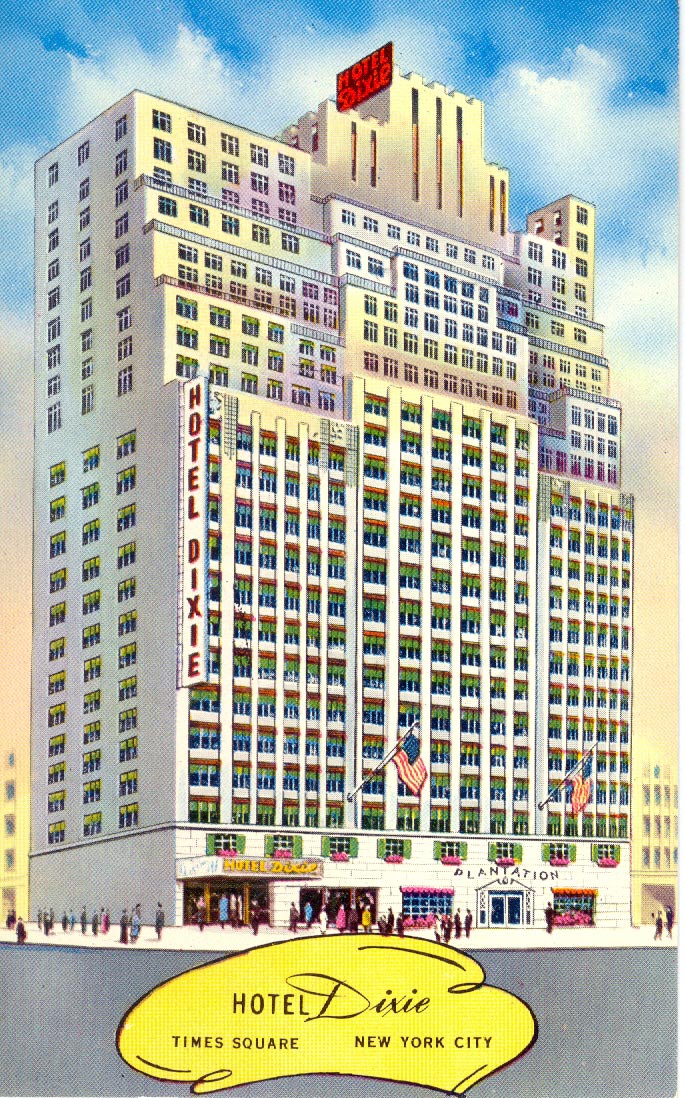
|
| Dixie Hotel 1959
|
On February 9, 1959 (give or take a day or two), we drove from Arlington,
Virginia, to New York City, which I had never seen before, and stayed at the
Dixie Hotel on 42nd Street, just off Times Square, which in those days was
100% drugs and prostitutes and peepshows and pickpockets (Times
Square, not the hotel, but the hotel was pretty sleazy too). My mother was
scared to even leave the room so I didn't see much of the city; only 42nd
Street and the view from the hotel window (second photo). We were on a very
high floor and couldn't see much through the filthy windows but I remember
we had a view of the light-blue McGraw-Hill building (where I would go many
years later when I published some articles in their magazine,
Data
Communications). I don't remember this part, but my brother told me
that dad took him to a movie at a sleazy Times Square theater and it was a
traumatic experience for him, creepy people grabbing at him, etc (I took
Peter — at his own insistence — to what might have been the same
theater 30 years later to see a Jean-Claude Van Damme movie,
Blood
Sport (his idea, not mine), and it was still just as sleazy.
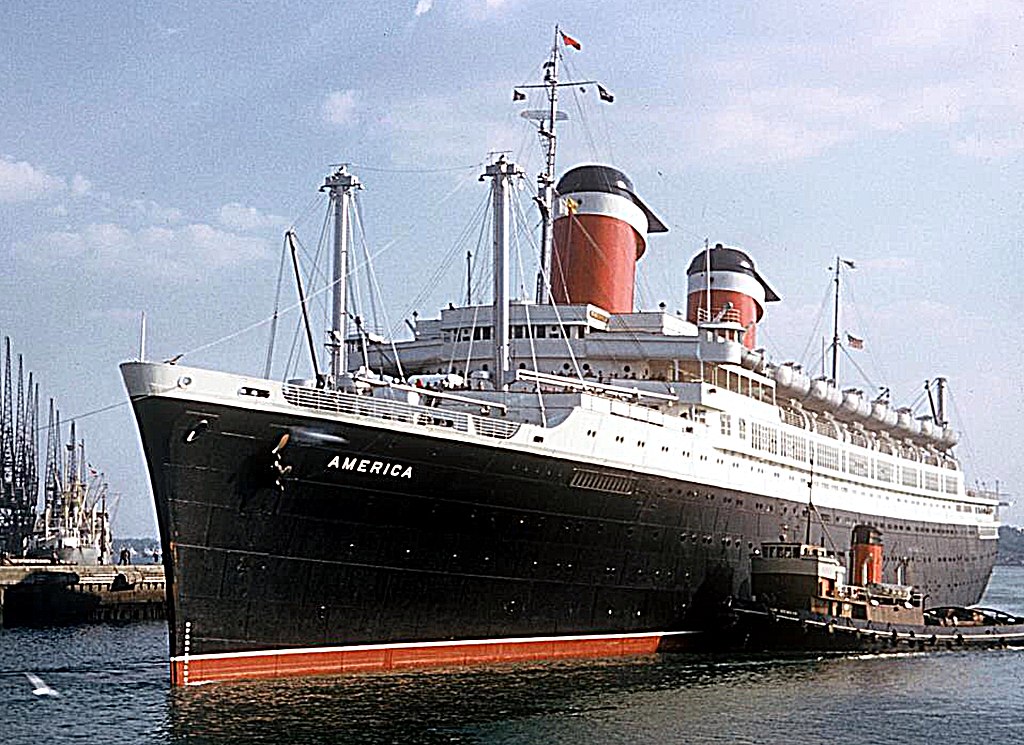
|
| SS America
|
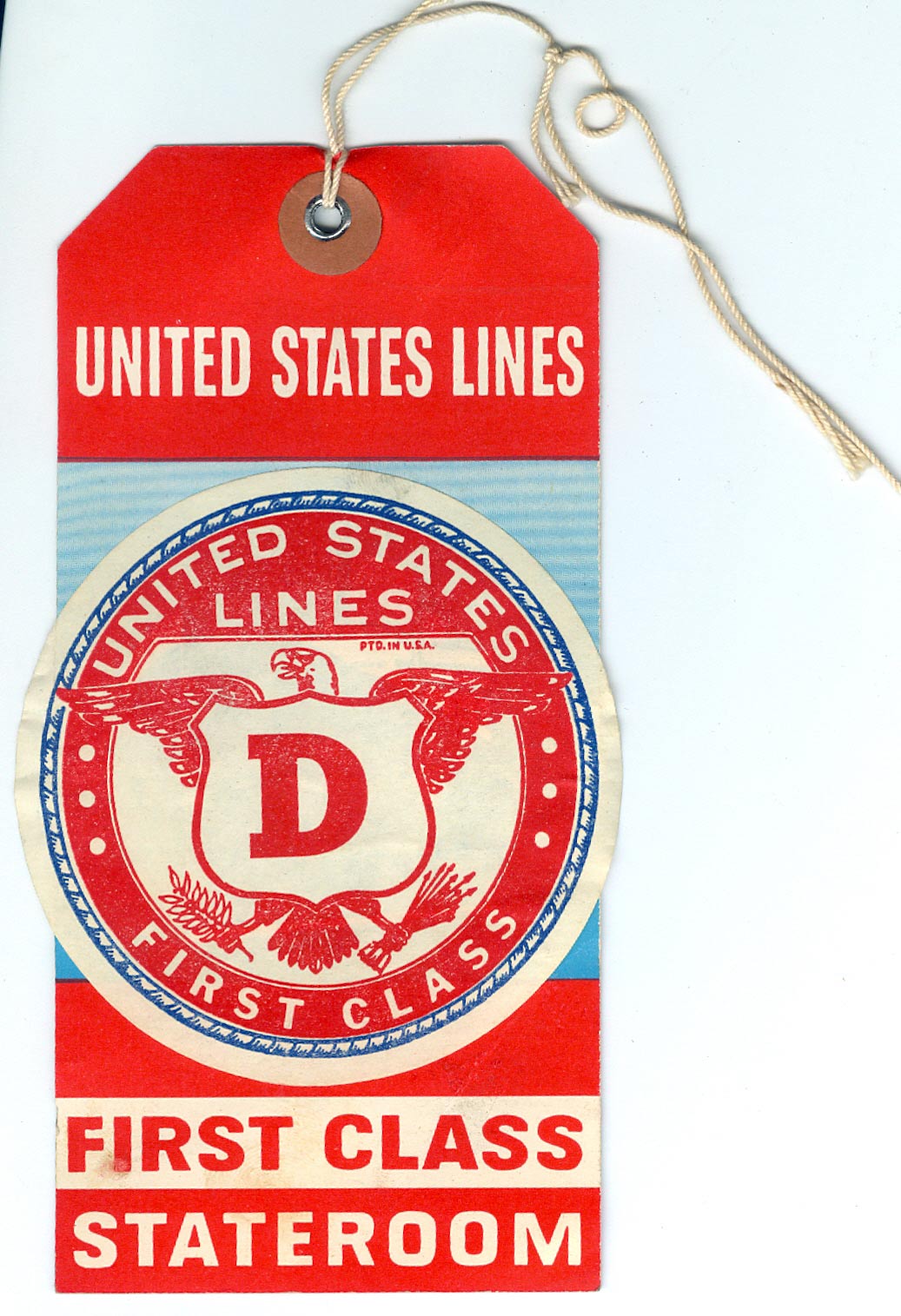
|
| SS America tag
|

|
| Pier 86, 42nd Street 1959
|
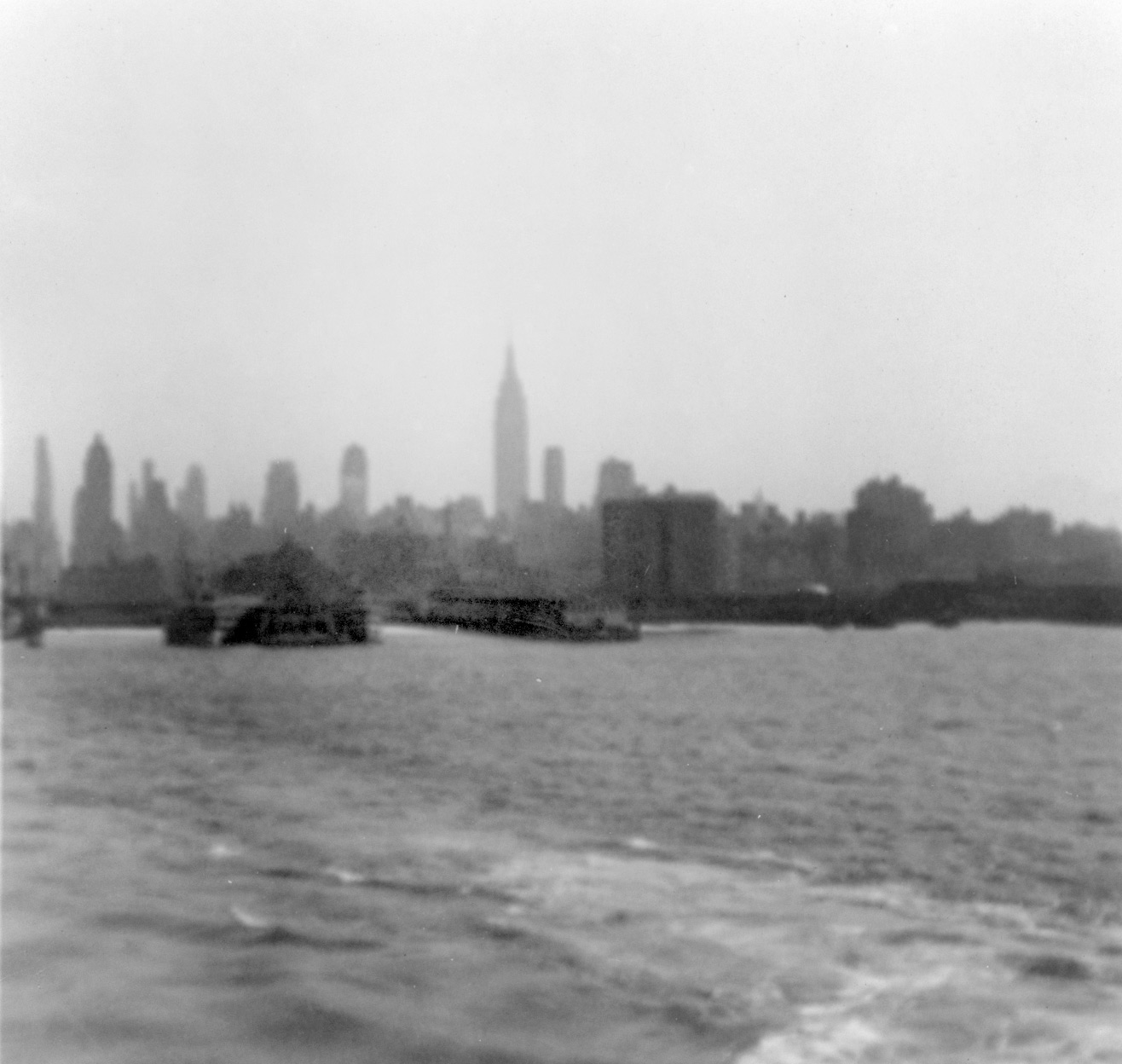
|
| NYC from SS America 1959
|
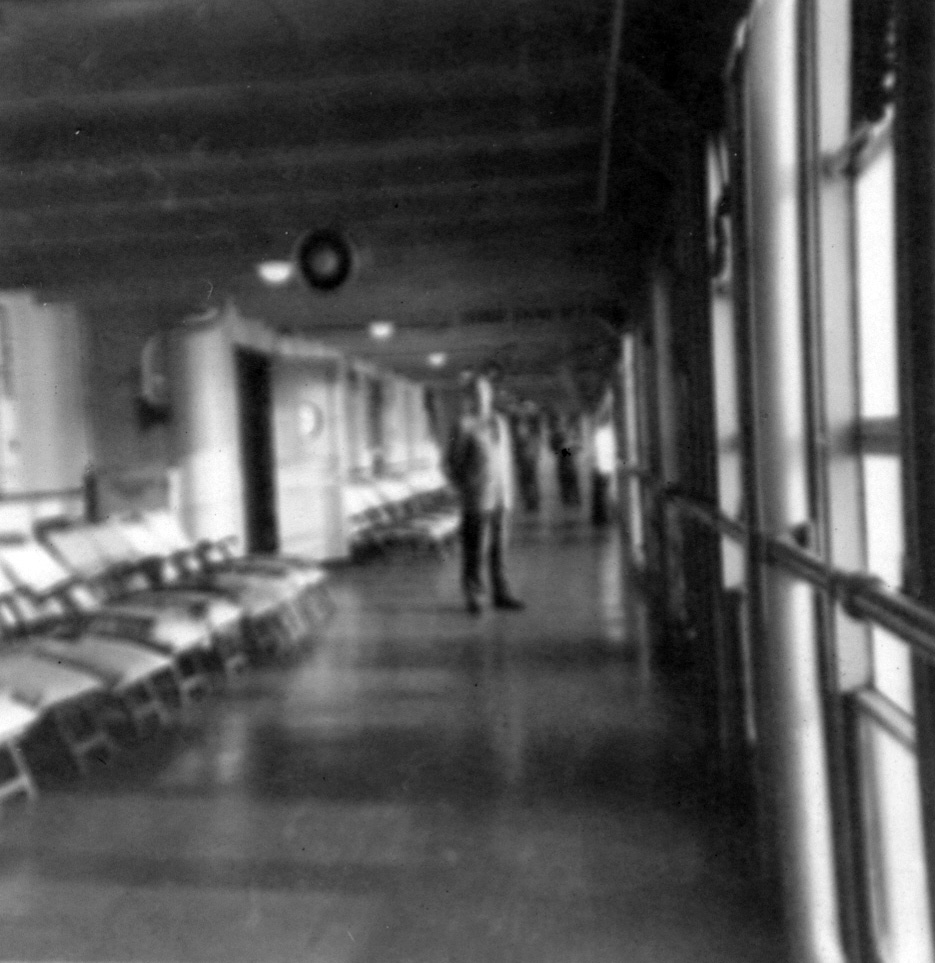
|
| Promenade & deck chairs
|
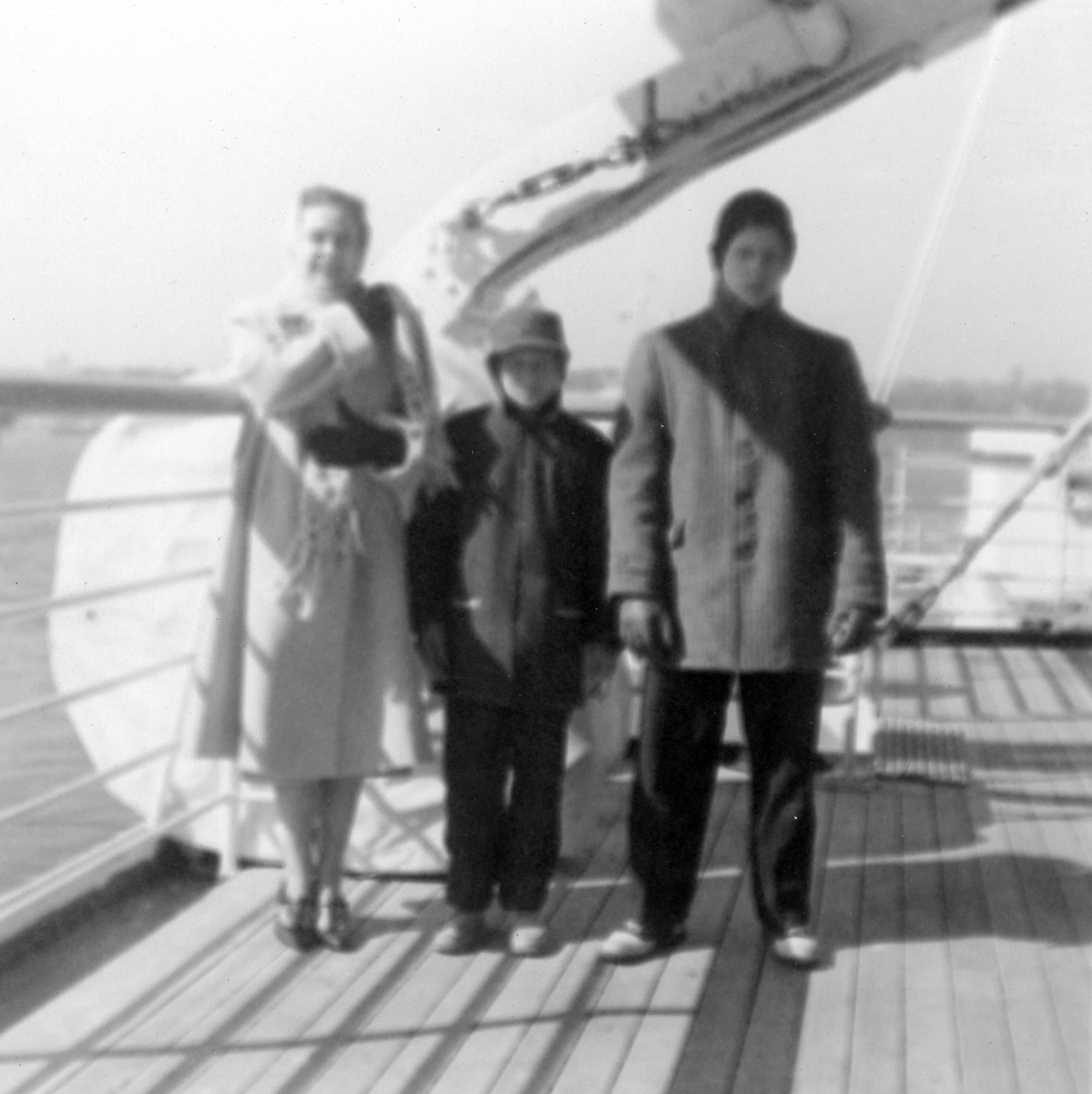
|
| On the deck 1959
|
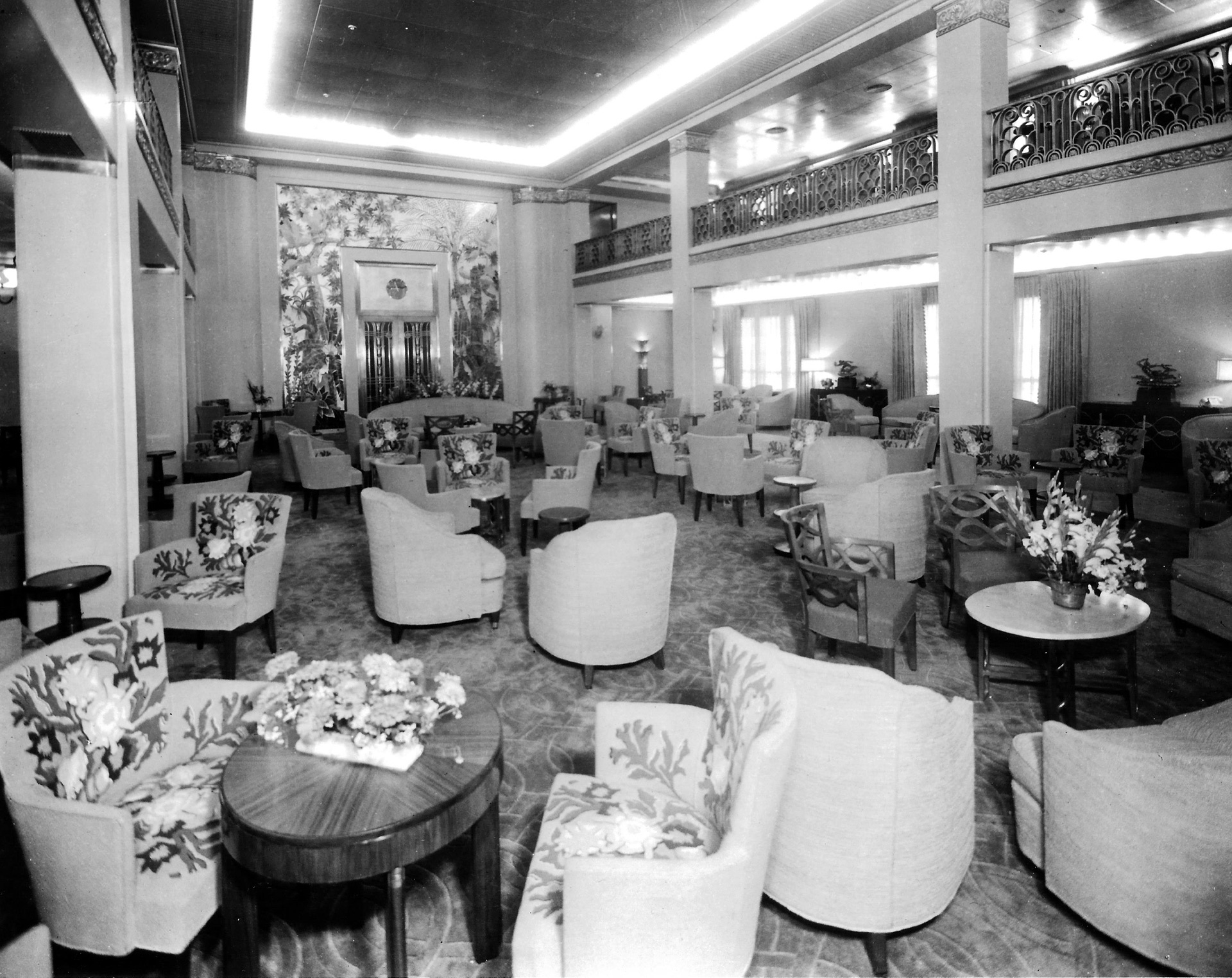
|
| SS America interior
|
The next morning we drove straight to Pier 86 at the west end of
42nd Street, where the
Intrepid is now. We boarded the ship, a
luxury liner in fact: the SS America (1939, christened by Eleanor Roosevelt,
served as a troop ship during WWII), occupying two first-class cabins, all
expenses paid by the CIA. Dad rented out our Arlington house while we were
gone and we took the car with us, a 1959 Studebaker Lark station wagon,
which they hoisted with a crane and lowered into the hold. I remember as we
left, we passed under the Verazzano Narrows Bridge, which was only about
half built and seemed a mile above us, the construction workers looking like
ants hanging from strings; 25 years later I would run across it in the NYC
Marathon.
The crossing was great fun, Dennis and I ran wild all over the whole ship.
Ping-pong was an interesting activity because the ship's rocking caused the
table to move out from under the ball. Swimming in the small indoor pool
was even more interesting… Just when you dived in, the water would
slosh over to the other side of the pool and you'd land on the bare bottom
and then, while you tried to recover your senses a huge tidal wave came down
on top of you. Dennis and I shared a cabin; he got seasick and I didn't. I
was always playing tricks on him to make him feel even more seasick like in
the Fred and Ginger movie Shall We Dance.
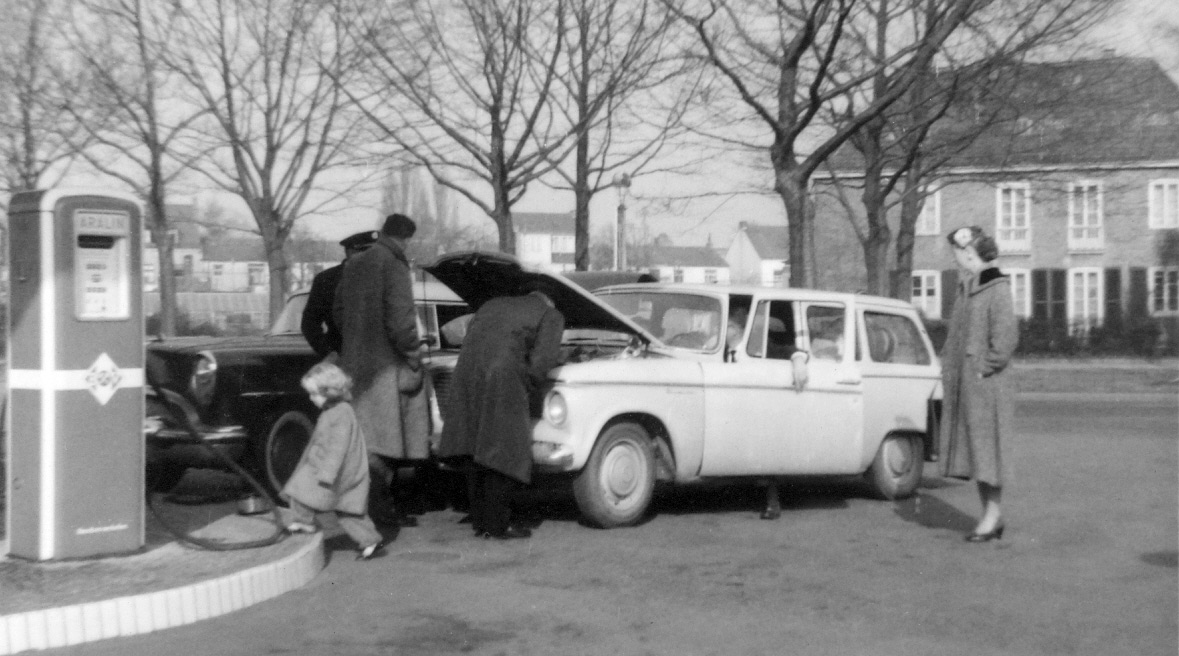
|
| Bremerhaven 1959 - Was ist los???
|
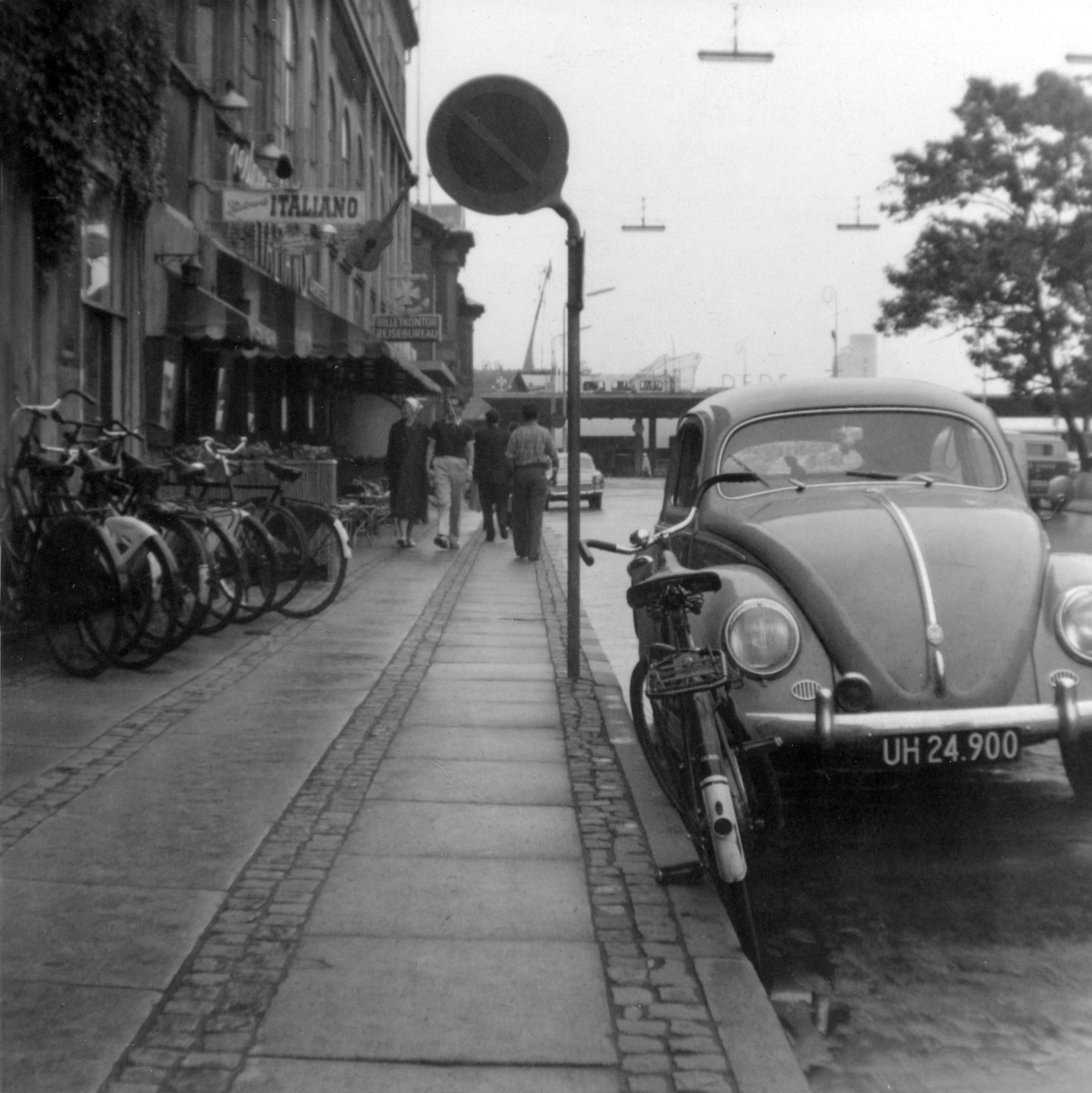
|
| Bremerhaven Feb 1959
|
After a week at sea we docked briefly in Cobh and in Southampton (so
technically I have been in Ireland and England even though we weren't
allowed to leave the ship), then finally in Bremerhaven on February 16th.
We waited for the car to be unloaded, then got in and started to drive
south. We had only gone a few blocks when the car stalled and couldn't be
started… And we were on train tracks! And a train was coming!!!
Seriously, we got out and pushed and saved the car and ourselves just in
time. Turned out the gas tank was full of water from condensation in the
hold. We got that fixed and then drove to Bremen where we had our first
German meal in a Gasthaus — sausages and black bread, and Fanta to
drink — then on to Frankfurt (via Hanover, Kassel, Fulda, and Hanau),
where we were going to live for three years.
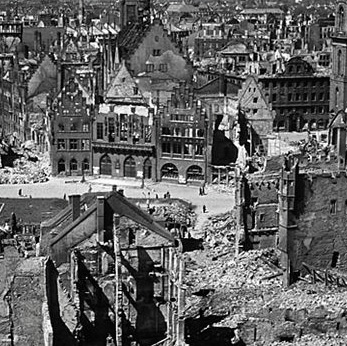
|
| Frankfurt Römerplatz 1945
|
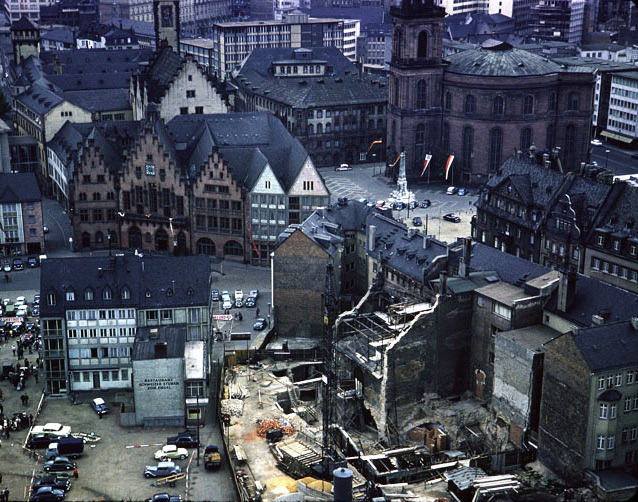
|
| Only
partially repaired in 1959
|
Germany was still a poor country, still marked by war and full of amputees;
the Wirtschaftwunder had not fully bloomed yet. Most people didn't have
cars, or if they did, they were the extremely cheap postwar "microcars" like
the
Messerschmitt (basically a fighter
plane cockpit with a lawnmower motor over three little wheels).
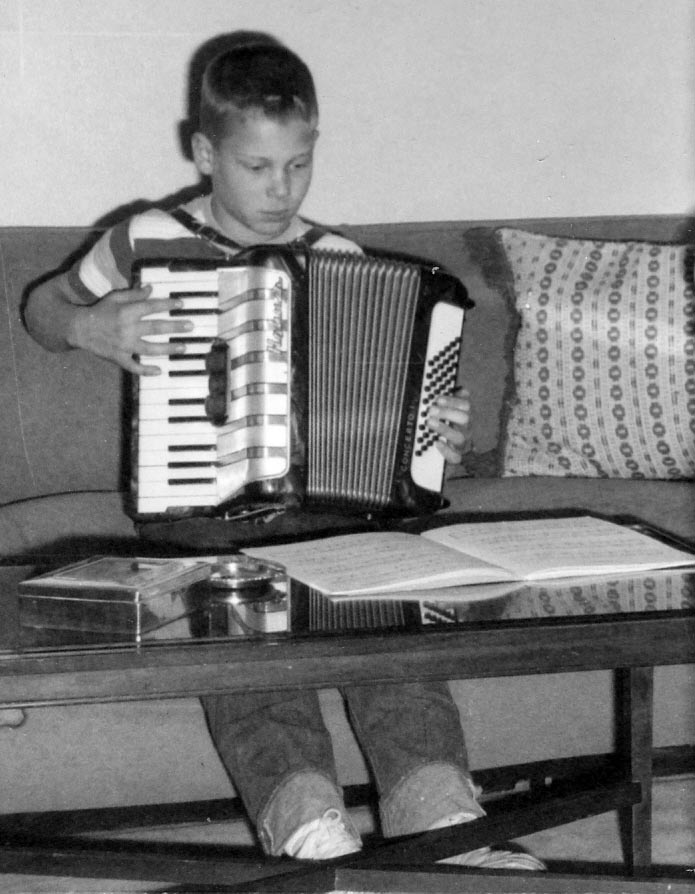
|
| Dennis & accordion
|
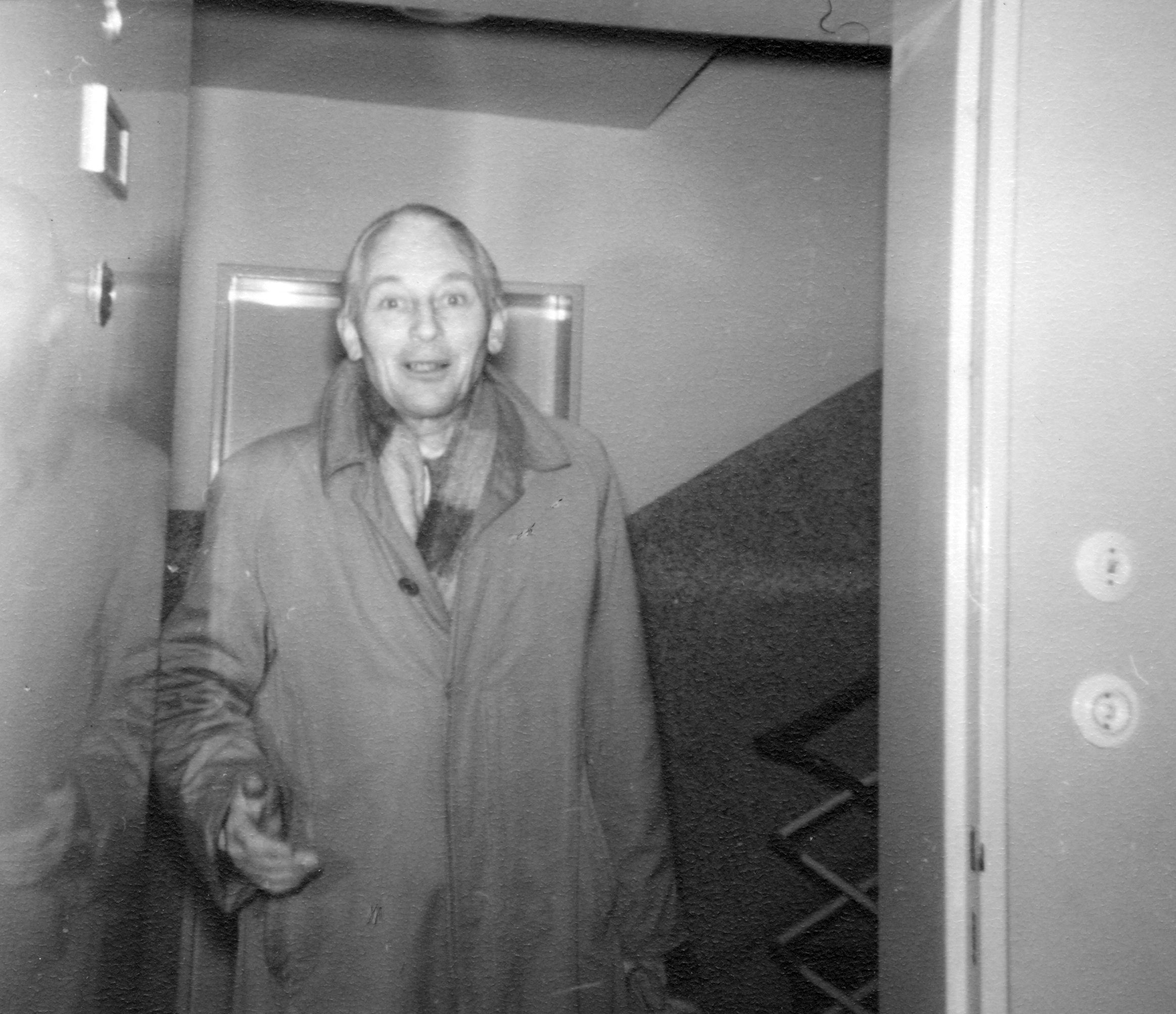
|
| German accordion teacher
|
Huge numbers of Germans depended on the American occupiers
for their living: working as Putzfrauen (cleaning ladies), cooks,
nannies, or prostitutes; giving music lessons to American brats
(like Dennis's accordion teacher shown at right), working as B-girls in
bars, working on the base in the PX or Snack Bar, or trading on the black
market. Most Germans got around on bicycles or (in the country) horse-drawn
wagons. Some German amputees had self-propelled wooden wheelchairs that had
a big lever on each side; the rider pushed and pulled the levers to power
the wheels. They could go fast, I even saw them zooming down the Autobahn.
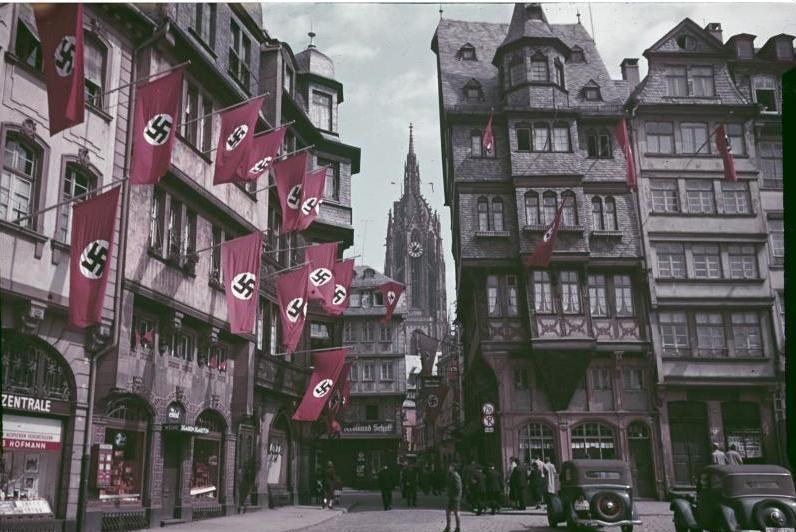
|
| Frankfurt 1938[3]
|
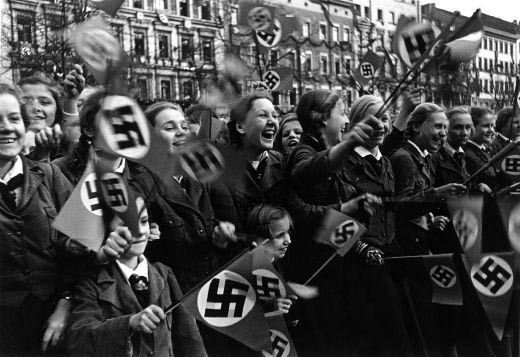
|
| Germans 1940s
|
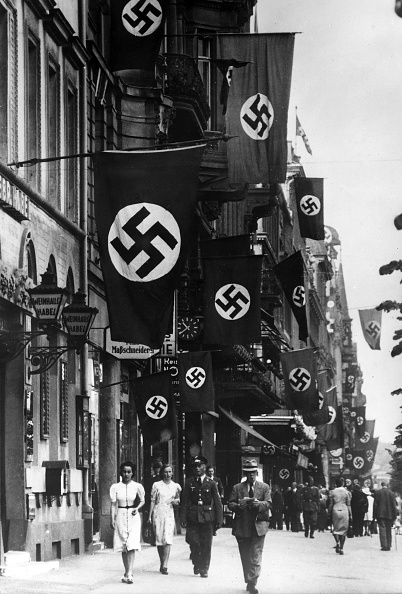
|
| Typical street 1940s
|
In general Germans were extremely friendly and polite. They greeted you
when you passed them in the street or when you entered a store and there was
always a lot of hand-shaking. But clearly they had mixed feelings about
Americans and about themselves too. Almost everyone over 30 years old had
been a Nazi (NSDAP, Hitler Youth, BDM...), or supported them, or went along
with them — with some notable exceptions[
1,2]
— and everybody over 30 had been involved in the war in one way or
another. Few ever talked about it, unless to claim they had served on the
Russian front. Germans were infinitely more friendly and jovial than (say)
the French or Belgians or Swiss. They loved to drink, sing, and have big
festivals, they invited you to their homes. But walk down any street, and
you could imagine it festooned with Nazi flags not so very long
before.
Still, the penalty for Gemans for merely critizing Hitler and Nazism, let
alone taking any form of action, was death or concentration camp. Contrast
with Trump-era USA where some 40-50% of the population is openly racist,
antisemitic, misogynistic, xenophobic, etc, of their own free will. The
Nazi Party received only 37% of the vote in the election of 1932 (the one
that launched Hitler's Führer career), suggesting the 63% of German voters
were antifascist, whereas Trump received 46% in 2016.
References...
-
German Resistence to Nazism, Wikipedia (accessed 17 February 2023):
"[D]uring the height of Nazi Germany, unlike the more coordinated efforts in
other countries ... [t]he German resistance consisted of small, isolated
groups that were unable to mobilize widespread political opposition."
- Rebecca Donner, All
the Frequent Troubles of Our Days - The True Story of the American Woman at
the Heart of the German Resistence to Hitler, Little, Brown, and
Company (2021), 559pp. The Woman was Mildred Harnack,
the author is her great-great-niece, and the resistence Die Rote Kapelle (the
Red
Orchestra); it didn't end happily.
- Color photo from the
Historiches
Museum Frankfurt,
Frankfurt and Nazism section
(accessed 17 February 2023).
Living in Frankfurt
The City of Frankfurt am Main had been
mostly
leveled by Allied bombing but was largely rebuilt by the time we
arrived. There were modern office buildings downtown but no skyscrapers.
In every town and city the church or cathedral (Dom) was supposed to
dominate the skyline, and in 1959 Frankfurt it still did and no matter where
you lived, you could always hear church bells. Beyond downtown, there had
been less destruction so buildings were older, although where I lived you
could still see walls that had been raked by machine-gun fire. "AMI GO
HOME" was written on walls all over the place. There was not actually any
perceptible anti-American sentiment in daily life; the graffiti was mainly
just from kids. If you went downtown at night (like to
the
Jazz Keller), it was dark and
quiet and there were rabbits hopping around the streets.
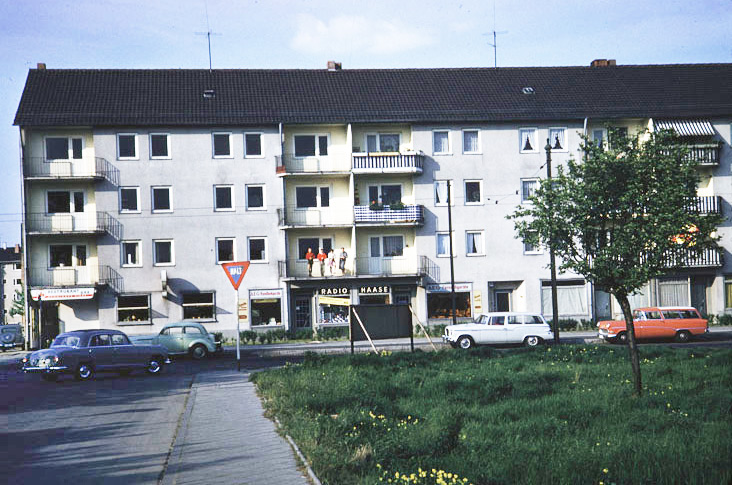
|
| 27 Raimundstraße in Frankfurt 1959
|
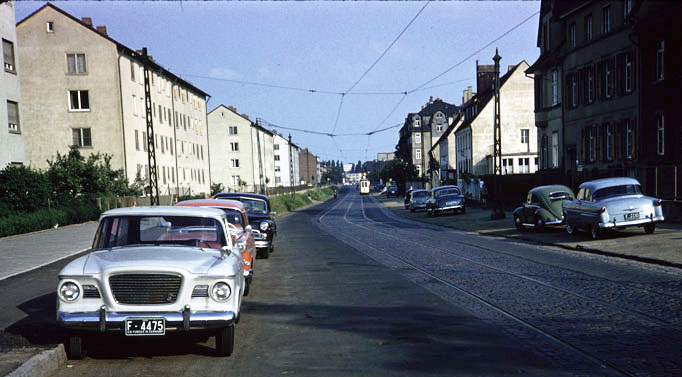
|
| Raimundstraße: our car with US Forces plates
|
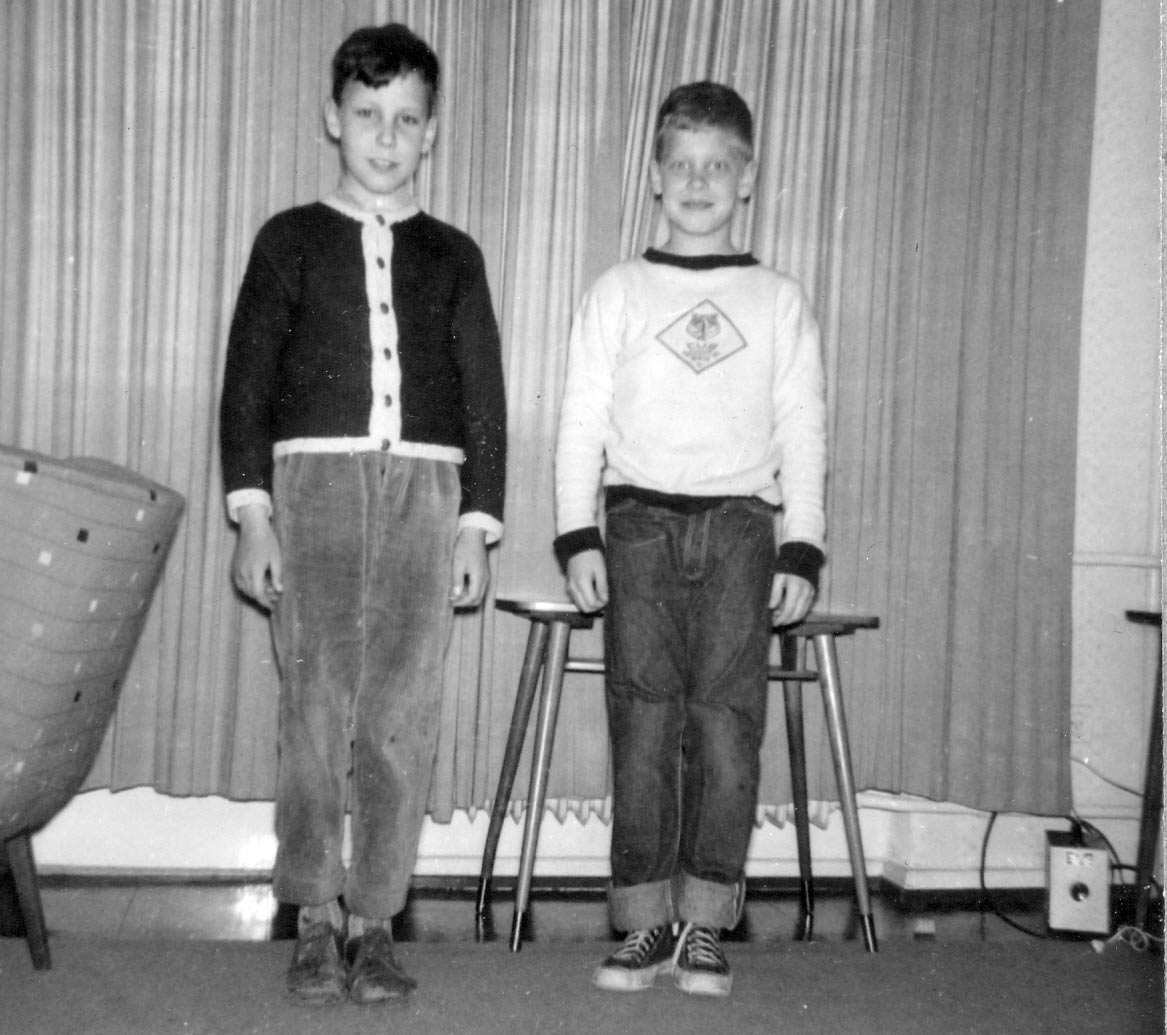
|
| Klaus-Dieter, Dennis, 1959
|
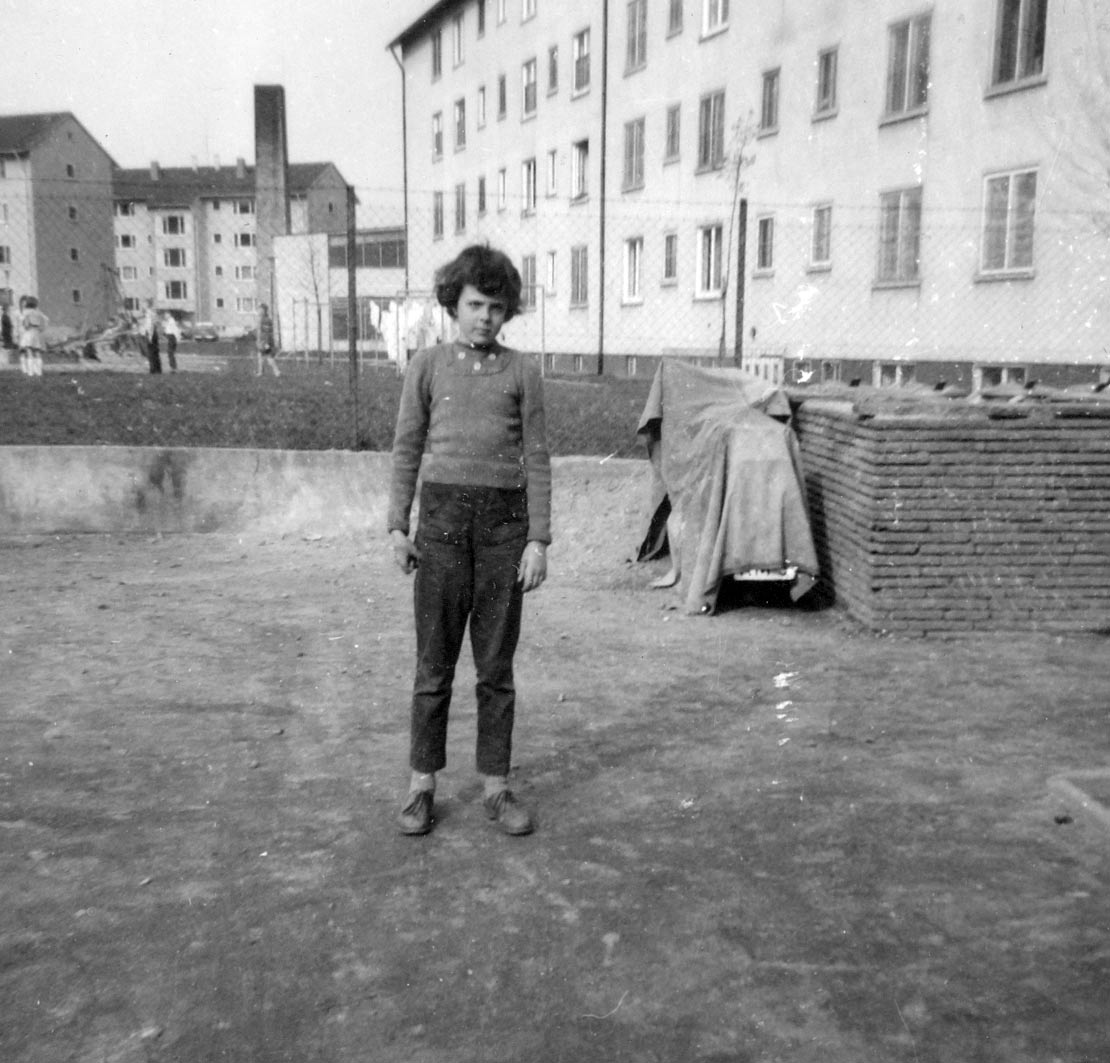
|
| Michelle 1959
|
At first we lived "on the economy" in a German apartment
at 27 Raimundstraße, right over a loud bar, Rudi's, second
floor far left in the left-hand color photo, with Rudi's beneath it. No
kids my age lived there but there was a family with two kids Dennis's age,
Klaus-Dieter and Michelle Böhm, children of the building's super, Herr Böhm;
they became great friends; Dennis learned German very fast playing with
them. If you click the left-hand color image to enlarge it you can see
Dennis (red shirt) with them and a third person, don't know who, on the
balcony next to ours.
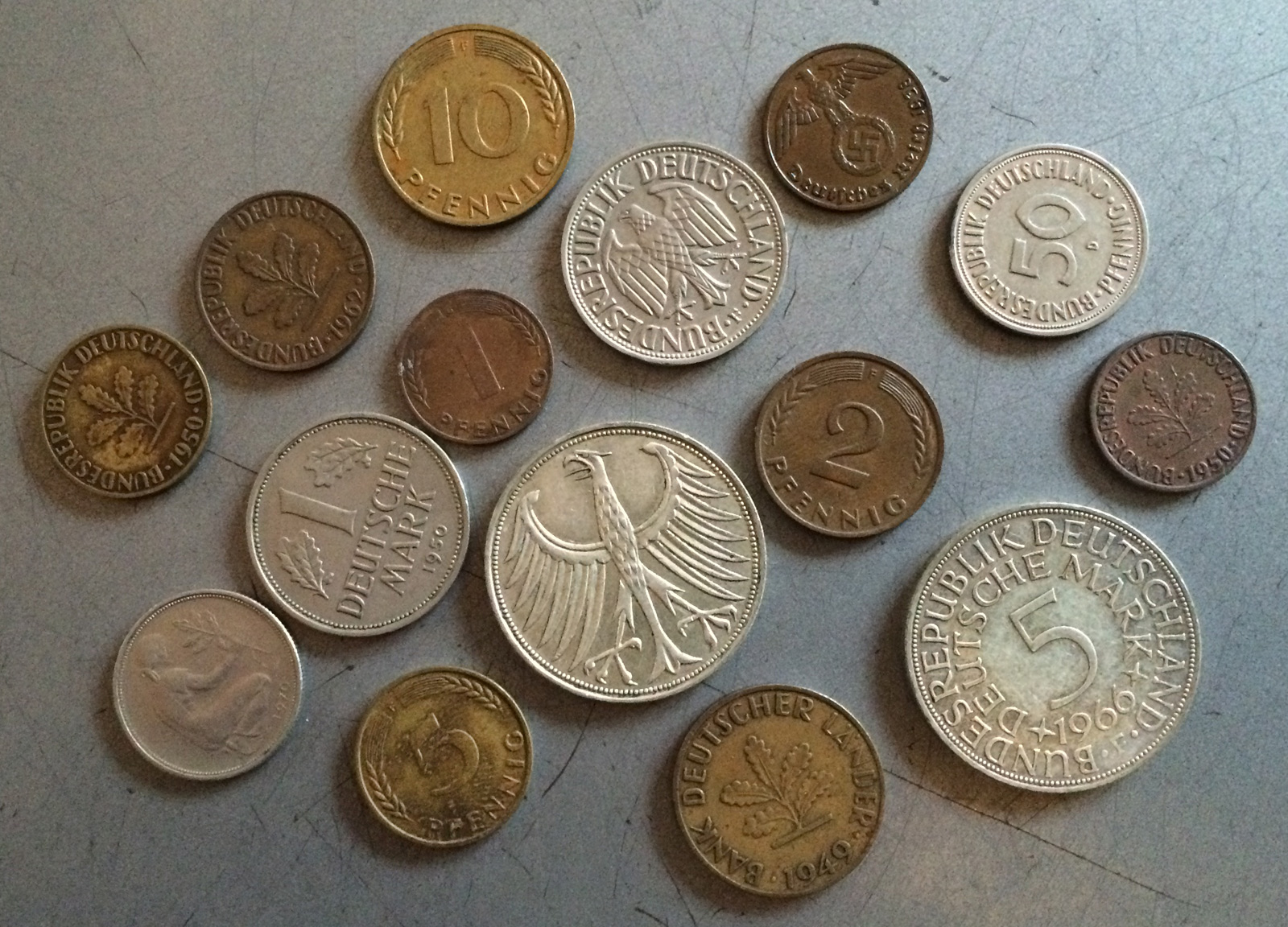
|
| German coins in circulation 1950s-60s
|
Our first day in the German apartment, my dad went to work and my mom was
panicked, she didn't know what to do. She sent me out to buy food…
There was a Lebensmittel (a small food store, like a bodega) up the street.
I didn't yet know where the PX and commissary were. I went in and bought
black bread, unsalted butter (the only kind Germans use), sausages, mustard,
milk, eggs, salt and pepper, etc. I knew a little German already from
phrase books. I was struck by the fact that food wasn't packaged at all.
If you wanted (say) five eggs, you just picked them up one by one. You also
had to bring your own shopping bag or basket (I don't remember what I did
about that). I managed everything OK, I understood numbers and basic
phrases and the money — 1 Mark had 100 Pfennig and was equal to 25
cents, pretty easy to deal with. Sixty years later (as I write this),
"zero waste" stores like this are starting to pop up in the USA (about time!).
Walking to the Lebensmittel I was struck by how clean everything was. In
those days, at least, Germans were fanatics about cleaning everything. Every
morning early everybody would be outside sweeping the sidewalks and streets
with those old kinds of brooms like in fairy tales. They also washed
sidewalks and steps and cobblestones. Nobody left trash behind, not only
because they were neat but there wasn't much to discard.
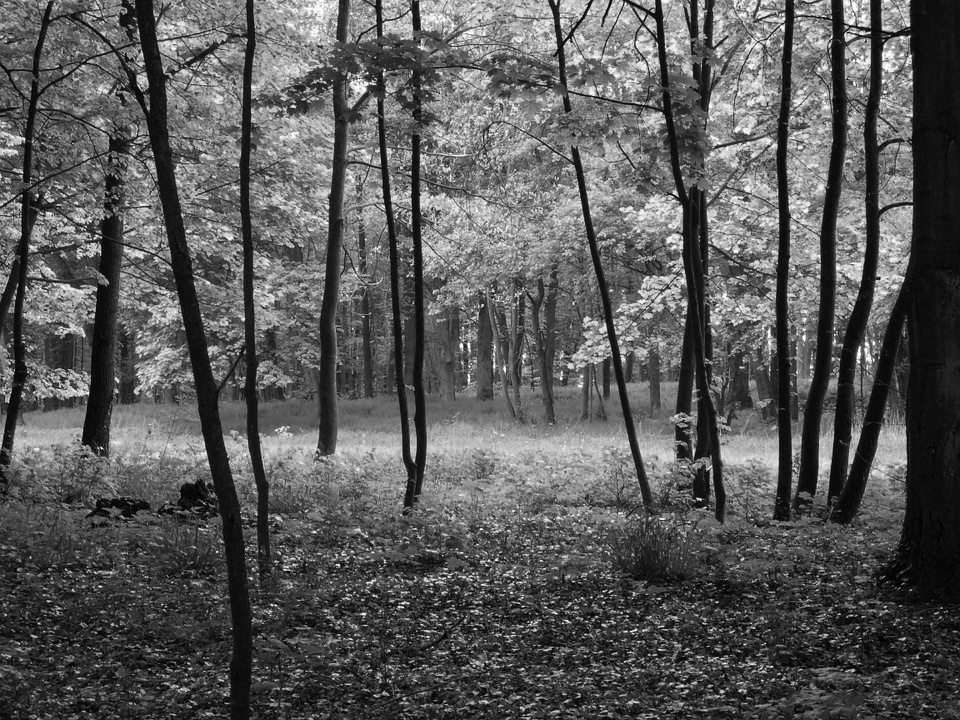
|
| A German forest
|
German forests were different too. In the USA forests have all kinds of
underbrush growing between the trees and there are fallen branches and
rotting tree trunks. In postwar Germany, the forest floor was perfectly
clean, a beautiful carpet of green grass. Germans scrounged everything else
for fuel, kindling, or food.

|
| German farms in the Rheinland
|
In fact the whole way Germans use land is completely different. In the USA
everybody is an individual, on their own. So American farms are isolated
from each other: a house surrounded by its land, far from any other house.
In Germany they put all the houses together in a little town that might also
have a church and a Gasthaus and maybe a shop or two. Everybody lives
together. If a family has a milch-cow, it lives in a room of their house,
not in a separate barn. So if you look at the German countryside from the
air you see little clumps of buildings surrounded by vast amounts of
cultivated land with no buildings, as in the aerial view in Rheinland-Pfalz
near Kaiserslautern. This way the people are closer to each other and they
can share resources more easily, so not everybody had to have a car or a
pickup truck or a tractor. Some of these little towns are 500 or 1000 years
old and they have a distinctive farmyard smell.
When I lived in Germany there were hardly any suburbs, and never had been.
You could be in a town or a city, or you could be in an agricultural area
or a forest. The boundaries were sharp, you could literally step out of
the city into the country.
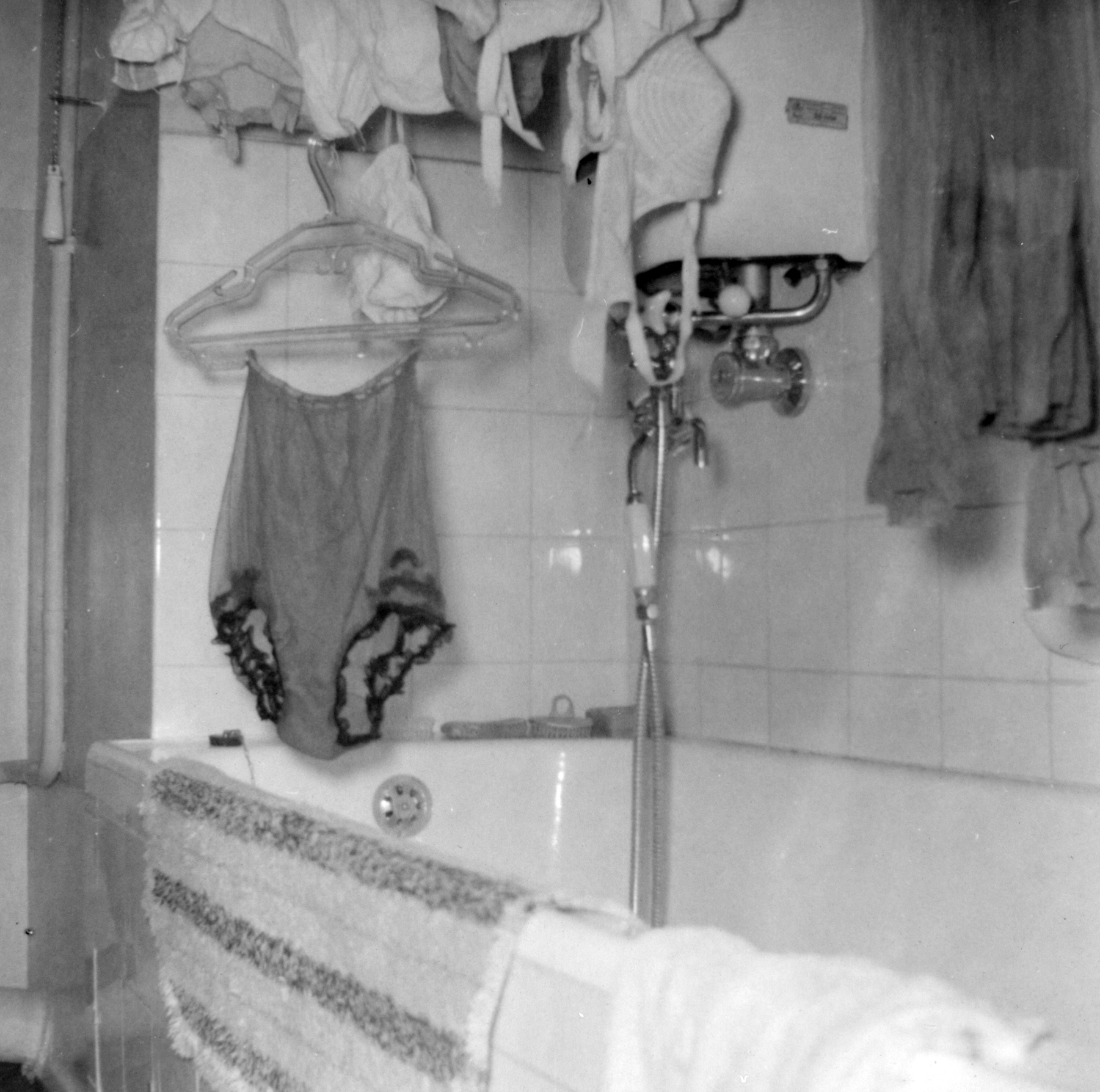
|
| German bathtub
|
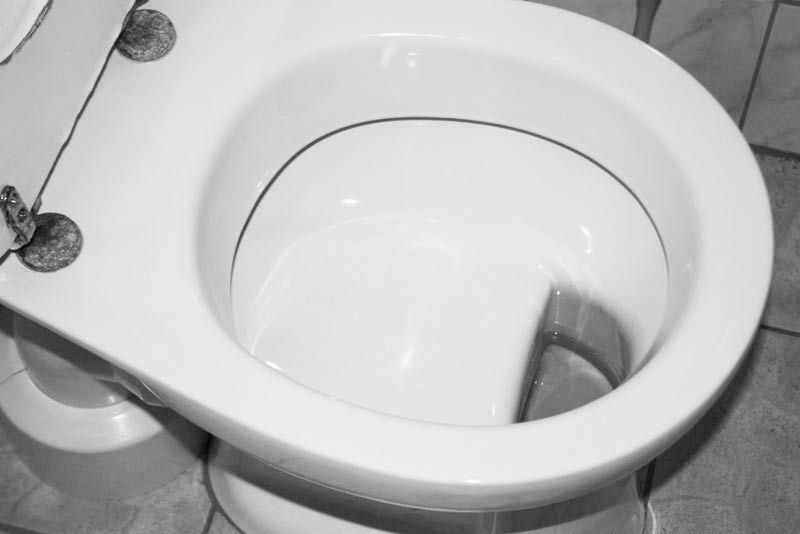
|
| German toilet with shelf
|
German apartment buildings are different too. In the staircases at night,
the lights go on only if you push a button, and then they go off
automatically after one minute; you have to push the button on each landing
as you go up the steps. Doors have latches instead of knobs. Bathrooms
don't have stand-up showers or shower curtains; toilets have a "continental
shelf" instead of a bowl and the water tank is up on the wall with a pull
chain. Supposedly the reason for the shelf is to prevent splashing and to
allow "inspection".
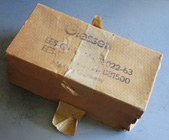
|
| 1959 PX transformer box
|
Germany, like the rest of Europe, uses 220V 50-cycle current, so if we
brought anything electrical from home we needed a transformer for each
thing. Electric clocks were no good even with a transformer; they only
showed 50 minutes per hour due to the lower frequency. We didn't bring a TV
either because in those days AFN (Armed Forces Network) didn't broadcast TV
and all you could see on German TV was Fußball games. The Army European
Exchange System (EES) made transformers at their facility in Gießen and sold
them by the thousands at the PX so we could use our radios, record players,
and toasters.
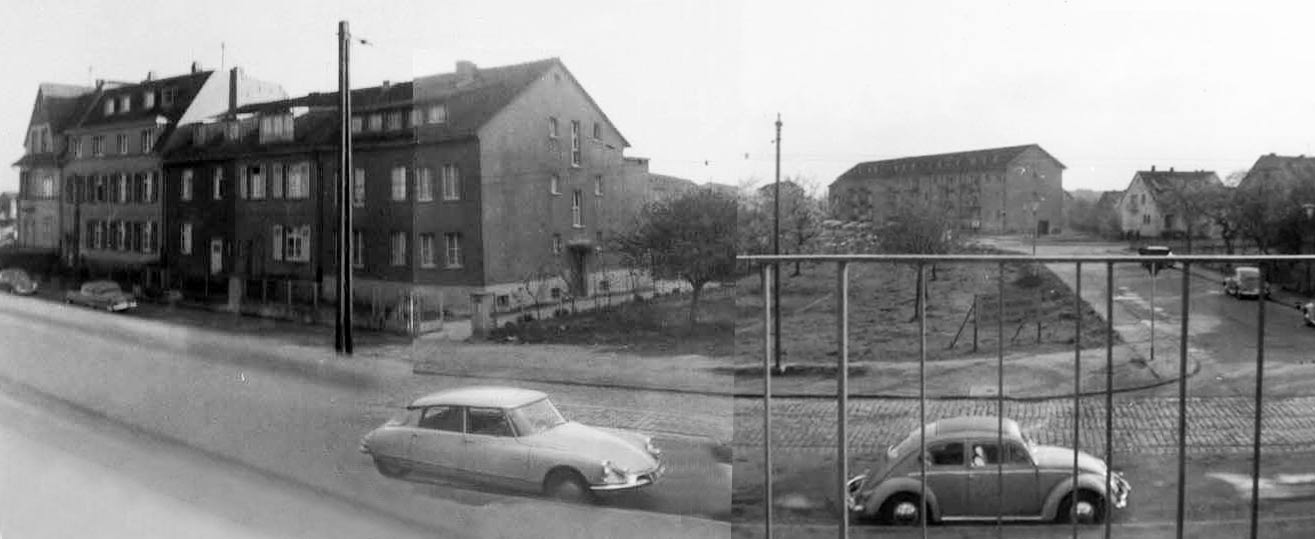
|
| Raimundstraße 1959 (panorama stitched from several photos)
|
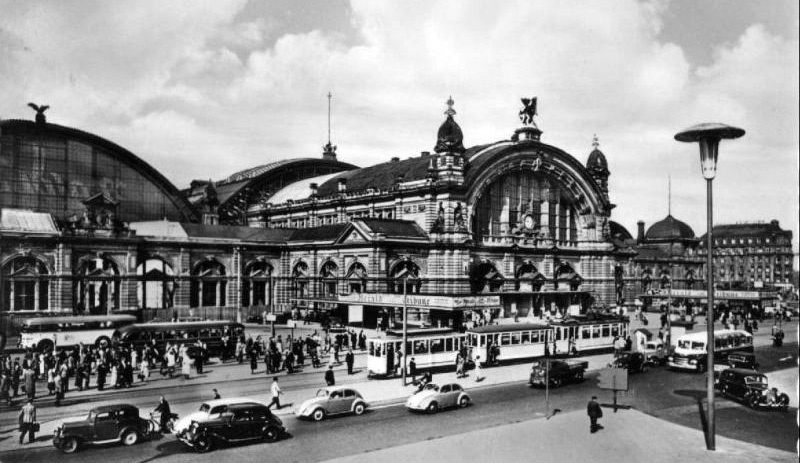
|
| Frankfurt Hauptbahnhof 1960
|
Our German apartment looked out over Raimundstraße, which was
paved with cobblestones and had trolley tracks, with the Number 17 trolly
(Straßenbahn) running on them, which consisted of one or two cars made of
wood (at least on the inside). Frankfurt did not have a subway until the
late 1960s. The 17 went to the Hauptbahnof, the majestic but war-blackened
Bismarck-era main railroad station, where you could transfer to any of the
other trolley lines, some of which went to neighboring cities like Höchst or
Offenbach or even up into Taunus mountains. The seats near the trolley
entrance were reserved for Schwerbeschädigte, badly damaged people —
war casualties, amputees, who were a large segment of the population.
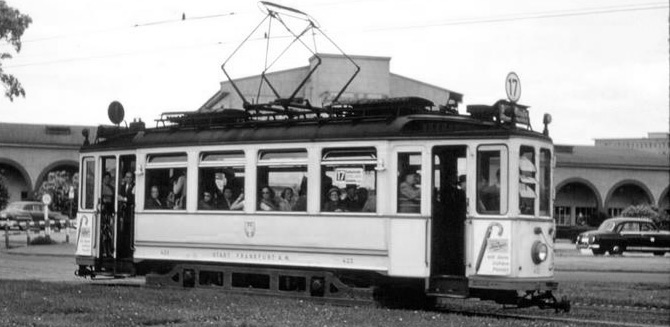
|
| Frankfurt Straßenbahn Nº17 at WAC Circle
|
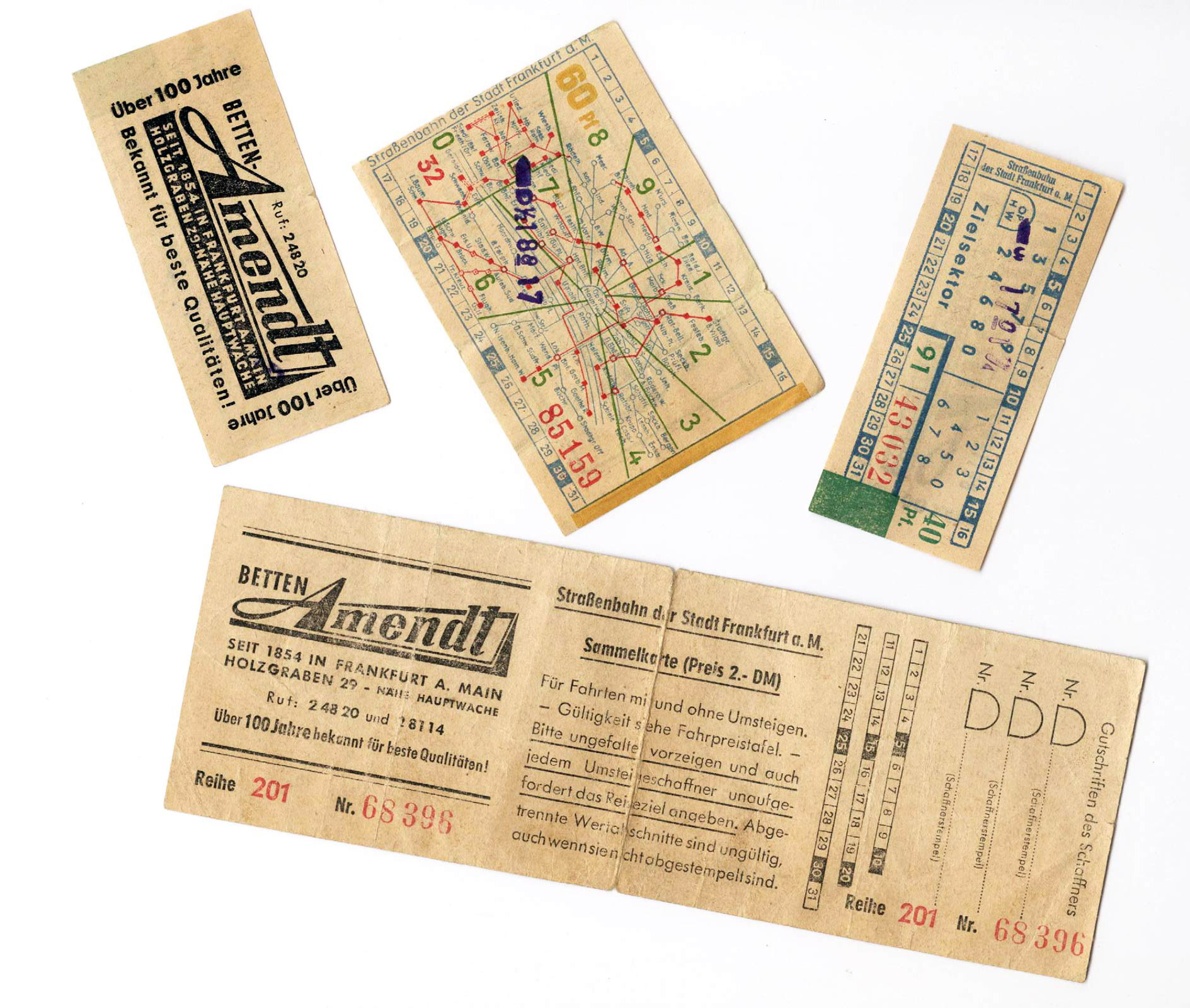
|
| Trolley tickets early 1960s
|
The trolleys had a driver and conductor. The conductor would walk up and
down the aisle selling and punching tickets — "Noch jemand bitte?"
— it was pretty much an honor system but fares were so cheap there was
no point in cheating. Some of the other trolley lines were starting to get
sleek modern metal trolleys where you had to stop at a ticket desk when you
entered, like on the Nº.11 to Höchst (this trolley line still exists
as of 2023).
When standing up in a crowded trolley, or even walking around in downtown
Frankfurt, I towered over all the Germans. I guess this is why I never
thought of myself as short until recently (I was 5'6" then, less now!). In
countries like Germany and Japan, it was only the postwar generation that
started to grow taller, supposedly due to the influence of the American
occupation on their diets.
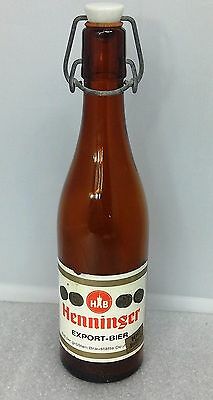
|
Henninger beer
bottle from 1960
|
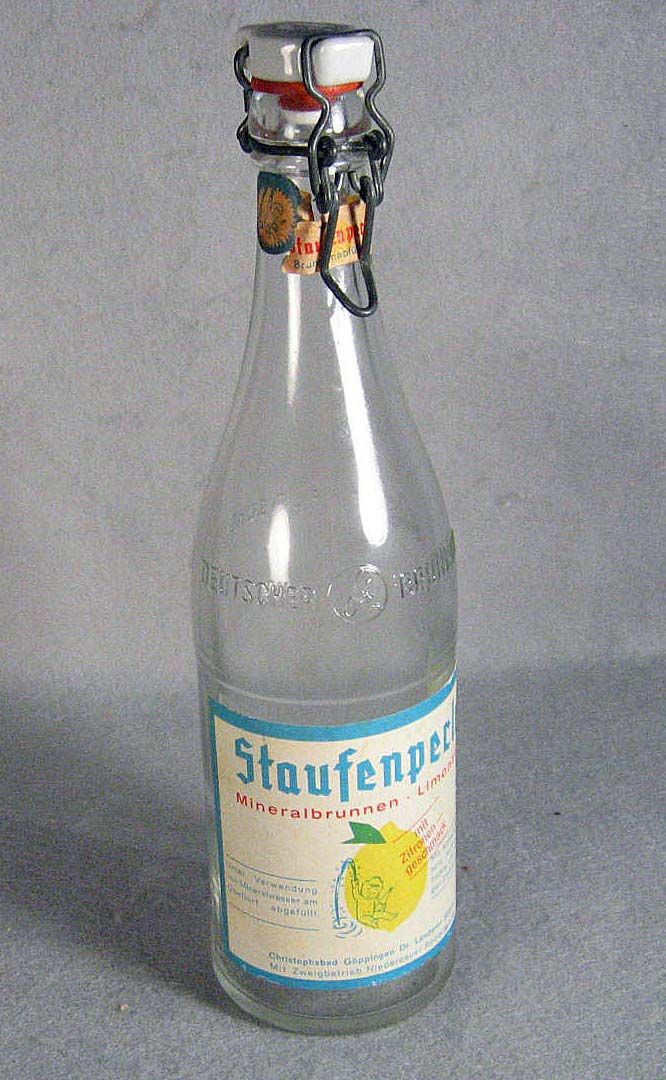
|
Limonade bottle
from the 1960s
|
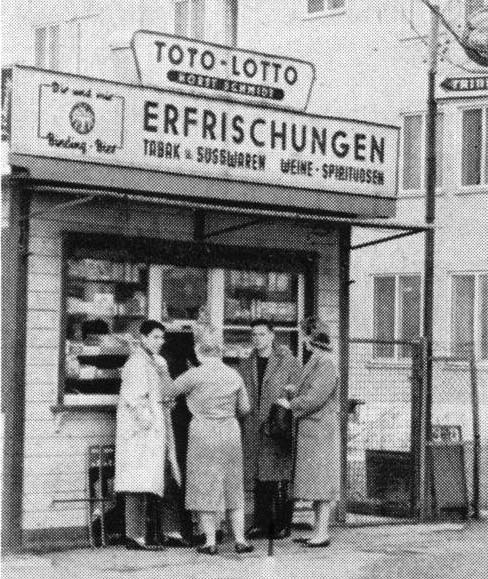
|
Frankfurt Trinkhalle 1960
(yearbook photo)
|
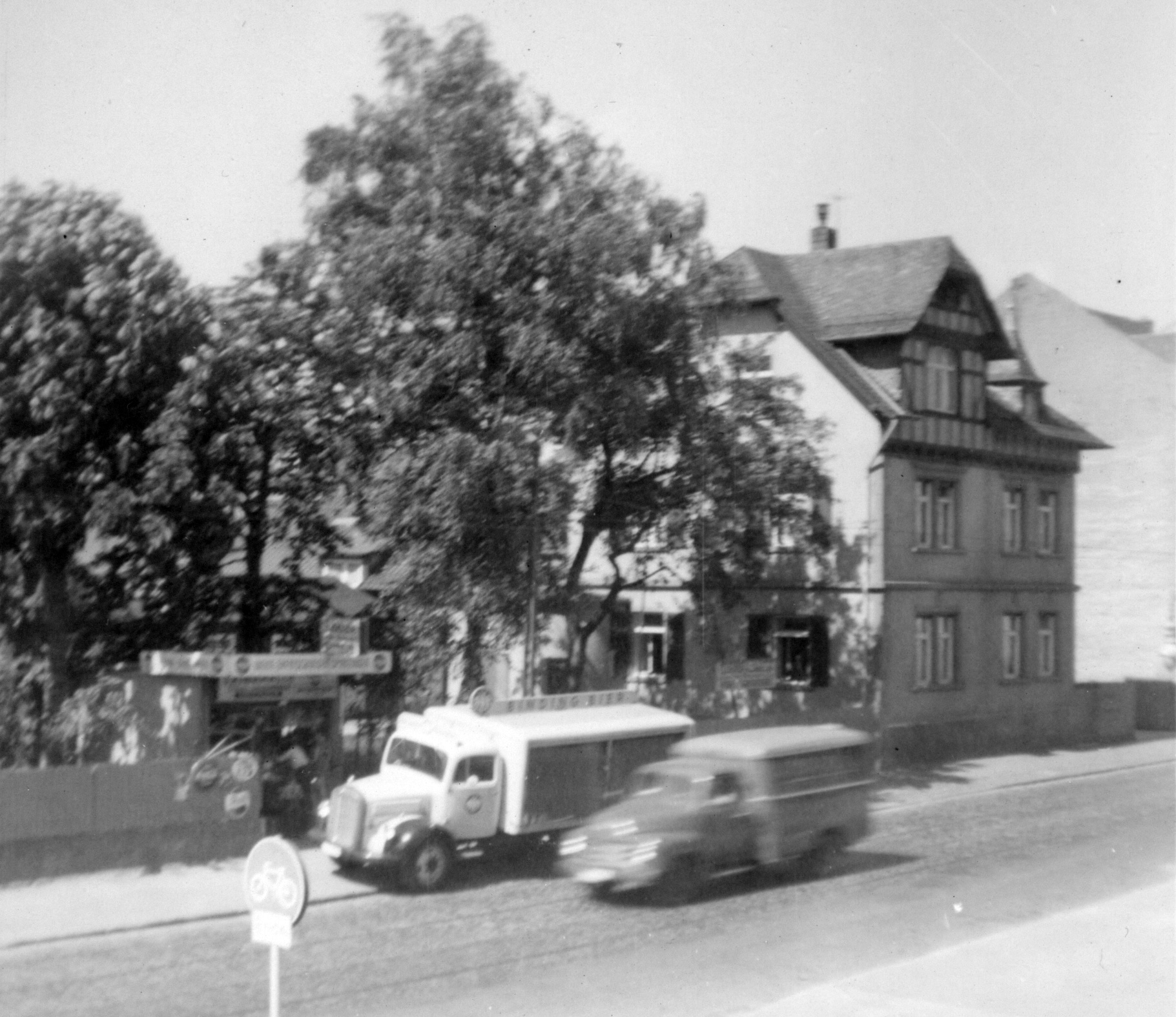
|
| Raimundstraße Trinkhalle and Binding beer truck, 1959
|
Across the street from our apartment was a Trinkhalle, a kiosk similar to a
NYC newsstand except it sold beer and schnapps as well as snacks like
Gummi bears and soft drinks called Limonade (four syllables) in big glass
bottles: sparkling mineral water with fruit juice, normally citrus (somewhat
like Orangina), or German sodas such
as
Fanta or Florida Boy.
There was also German Coca-Cola with a lemony taste. As for alcohol,
anybody could buy it, even little children. German beer was so much better
than what we can get here that I can't even describe it. It came in
half-liter bottles with ceramic tops (Bügelverschluß) like on the big
Grolsch bottles. My dad had a wooden case of Henninger Bier delivered to
our apartment in Frankfurt every week, much like New Yorkers used to get a
case of seltzer delivered every week in the old days. If he didn't drink the
whole case within a week, it would spoil. Seriously, it would turn into big
globs of slime. That was the difference, local beer was unpasteurized.
Once you boil it, it doesn't spoil but all the taste disappears. That's why
European export beer and all American beer is so tasteless.
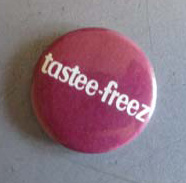
|
Other features of Raimundstraße that I remember include a fenced-in yard
with a big sign in English that said "BEWARE SHARP DOG", a Kino (movie
theater) that played the Horst Buchholtz - Hayley Mills film
Tiger Bay[3]
every single day for the whole time I lived in Frankfurt (and
there were always long lines to get in), a Tastee-Freez shop, and D'Angelo's
Pizza, the essential local hangout for us FHS kids.
References...
- Verkehrsplan der Stadt Frankfurt von 1956,
Verlag Richard Schwarz KG (1956), from
www.tramfan-ffm.de. Frankfurt map showing Straßenbahn (trolley) lines
as of 1956, which were very close if not identical to those of 1959-61,
before the subway and light-rail system was built starting in 1963 and
opening in 1968, replacing many of the trolley lines, with further expansion
later. On this map the trolley routes are shown as solid blue lines with
blue numbers such as 17; at an Endstation (terminus) the number is circled.
The map does not show the Platenstraße housing area or the American high
school, indicating the "plat" content of the map (buildings, etc) dates from
1954 or earlier.
- Horst Bosetzky, Alfred Gottwald und einem Mann an der Kurbel,
Noch
jemand ohne Fahrschein? Straßenbahnerinnerungen, Berlin,
Jaron Verlag (1997), about German trolleys in the postwar (but in Berlin,
not Frankfurt).
- Tiger
Bay of 1959
[Wikipedia]
was perhaps the beginning of the British New Wave,
preceding A
Taste of Honey by two years; it's quite good,
see
it!
American Housing in Frankfurt
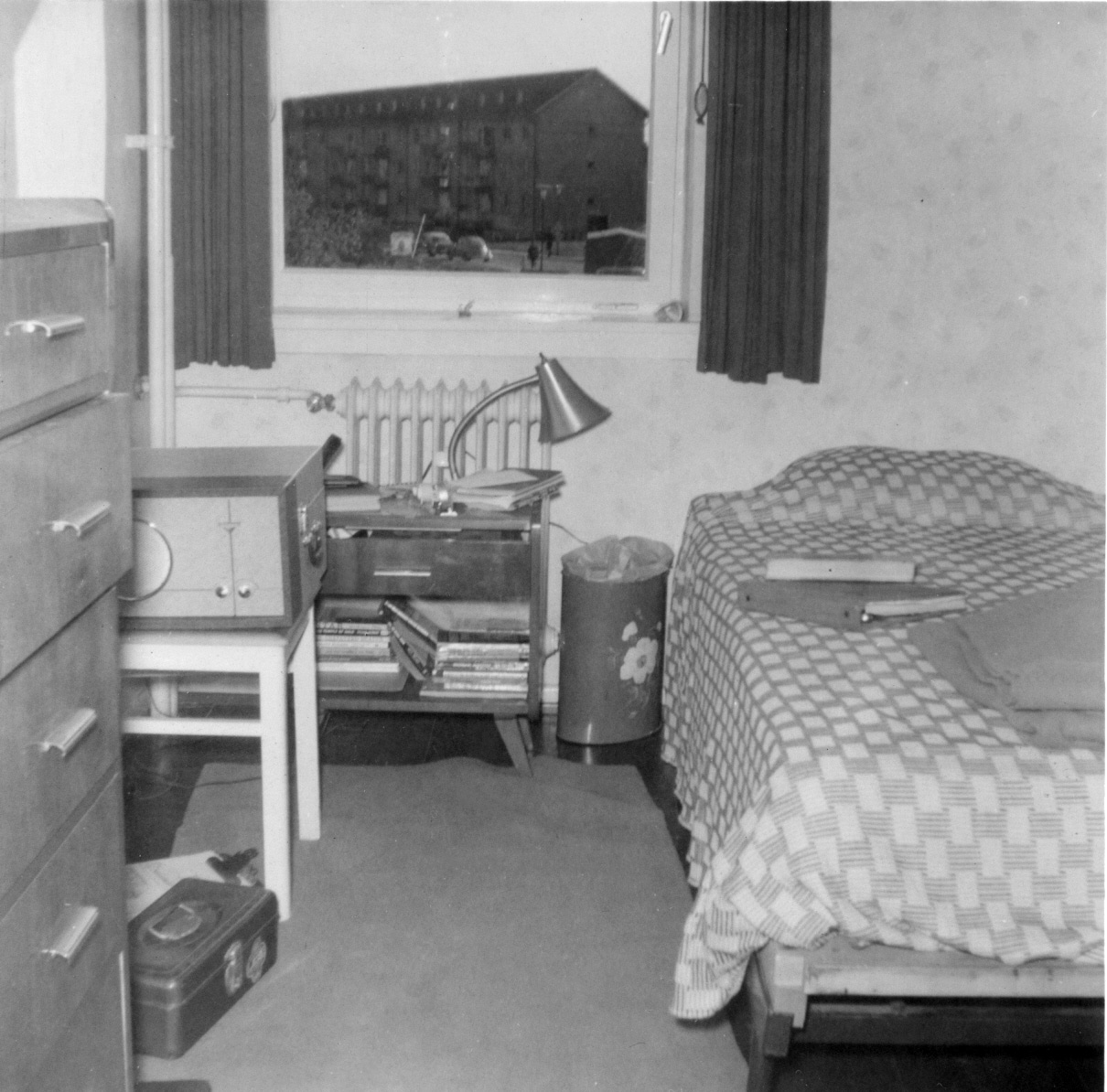
|
| Seen from Raimundstraße
|
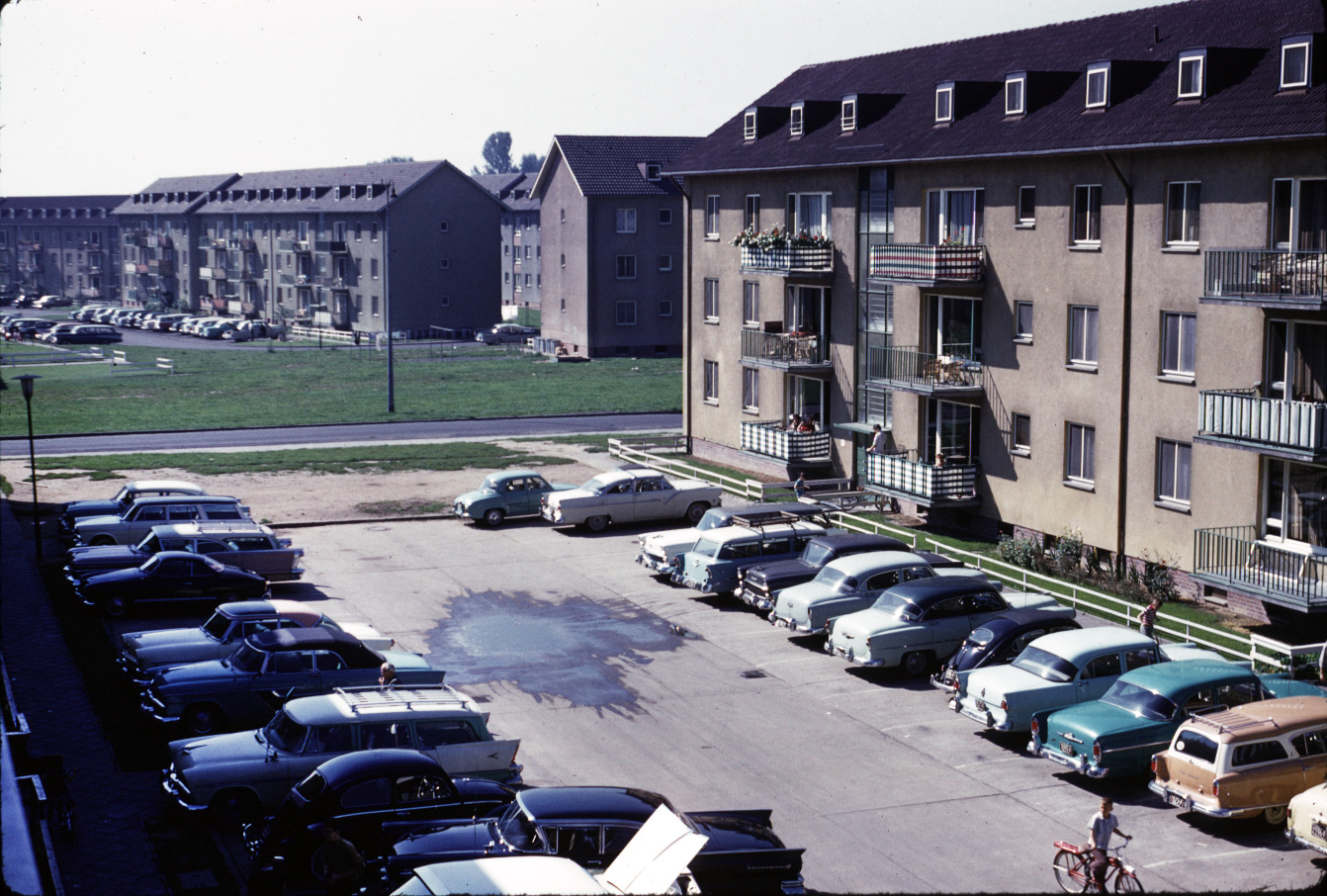
|
| The Platenstraße housing area 1960
|

|
| HiCoG building architectural rendering 1951[1]
- click to see gallery
|
In May 1959 we moved to American housing in Platenstraße, the housing area
just across from our first apartment; I could even see it from my
Raimundstraße bedroom (left photo). Our new address was 2231
Platenstraße, apartment on 3rd floor all the way to the left.
Platenstraße was medium-rank housing; for NCOs (sergeants) and company-grade
officers (lieutenants, captains) and their civilian equivalents who had
families. There was a higher level housing area for field grade officers
(majors and colonels) called HiCoG[
1] ("High
Commissioner of Germany"), a.k.a Carl-Schurz-Siedlung, a few blocks away and
there were also some Platenstraße clones (Hügel, Von Steuben) nearby to the
northeast (
see map). And then,
near the high school there was a little neighborhood
of
private houses for generals. For unmarried
officers there was the BOQ (Bachelor Officers' Quarters). Married enlisted
men ranking below some level of sergeant lived "on the economy"; i.e., in a
German apartment. Unmarried enlisted men lived in the barracks.
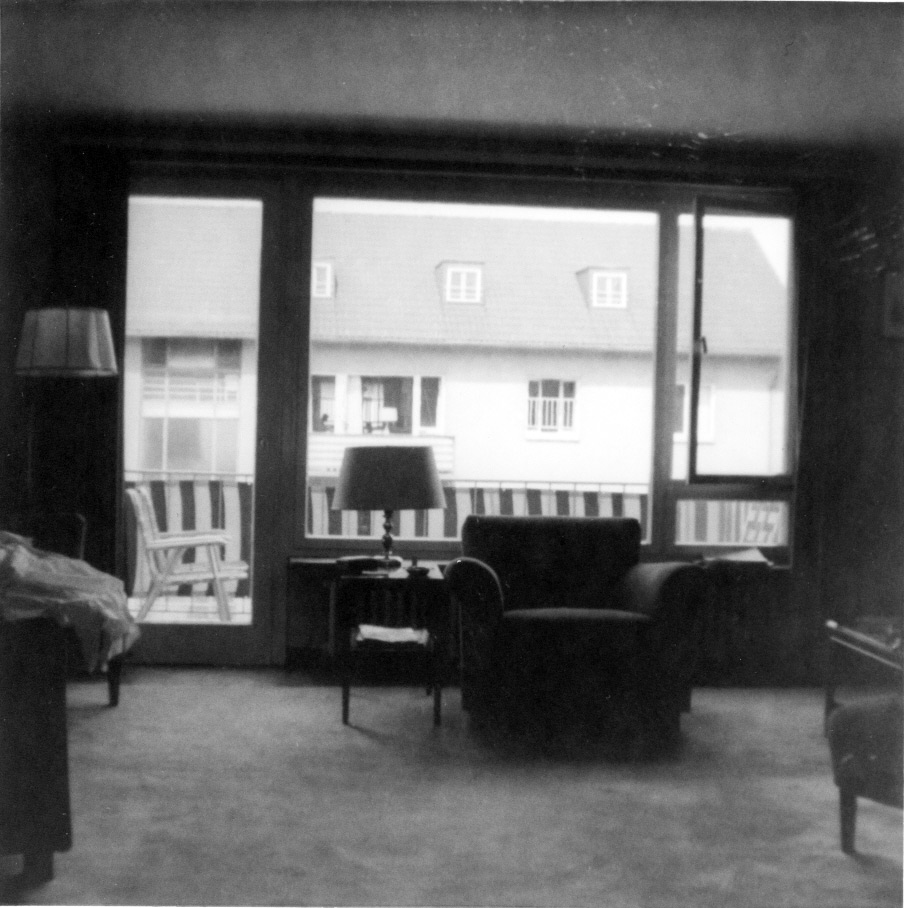
|
| Picture window and balcony
|
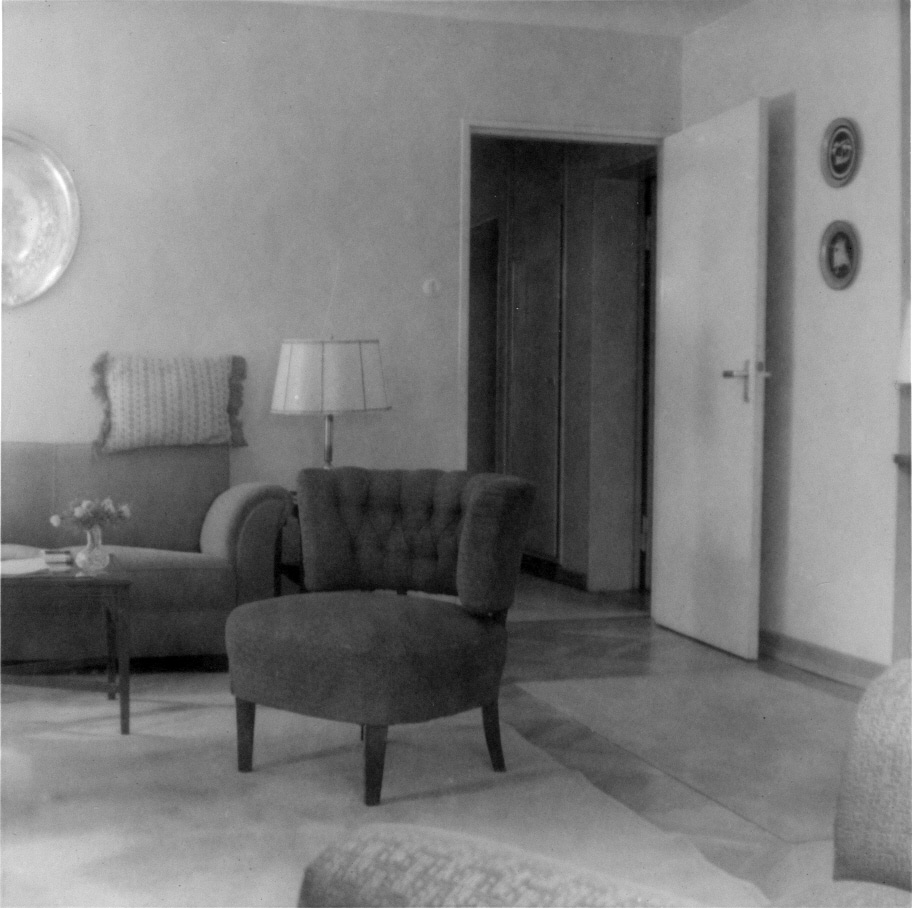
|
| Our Platenstraße apartment
|
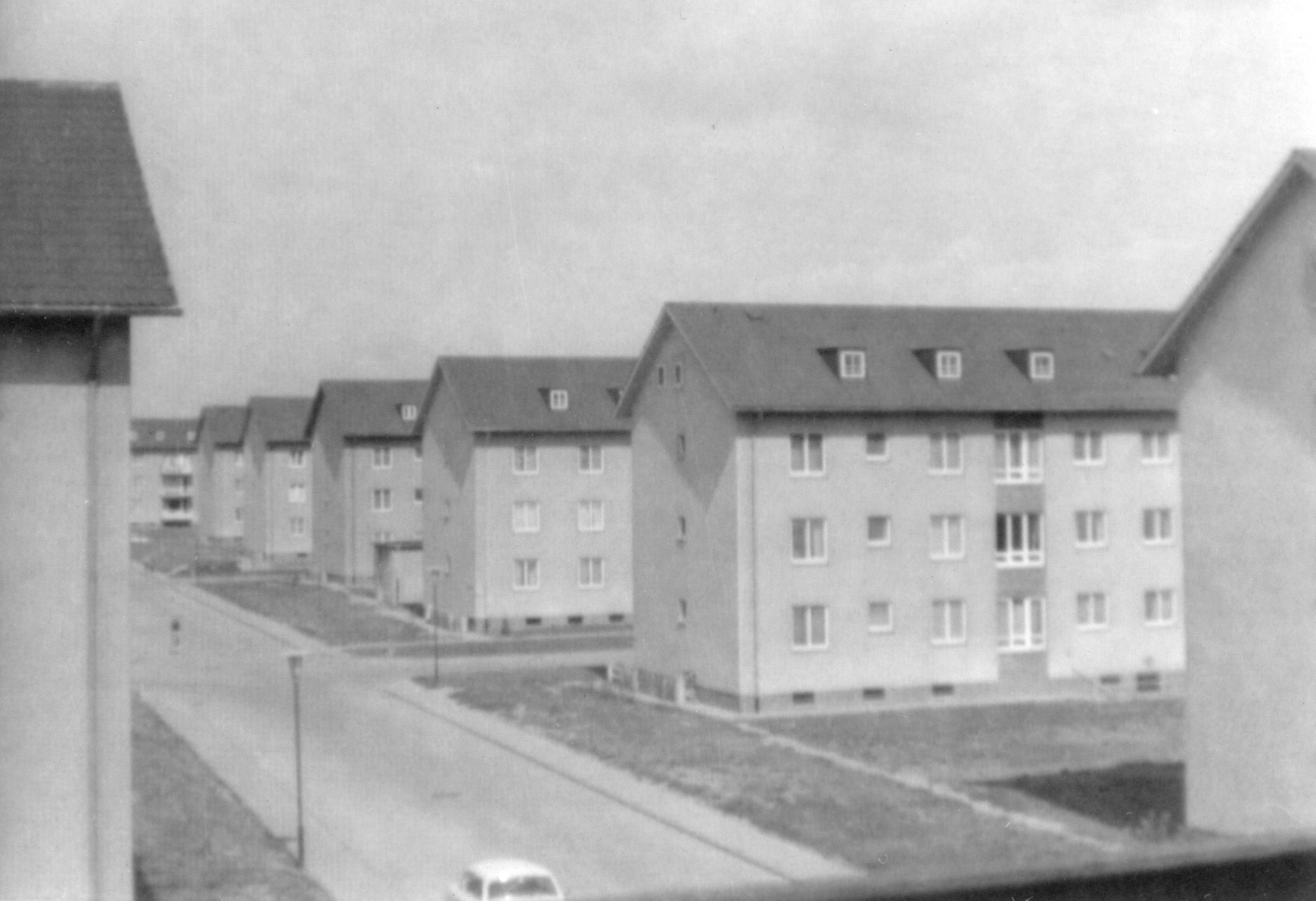
|
| Platenstraße buildings 1960
|
The Platenstraße apartment was palatial by NYC standards: two
or three bedrooms, one or two baths, big living room, nice kitchen with a
cutout onto the dining room so you could eat at the bar or at the table.
Fully furnished, picture windows on both sides with ample views of the other
buildings and a balcony, plenty of closets (which were virtually unknown in
Germany, where they use a piece of furniture called a Schrank the way we use
closets). The windows of all the buildings were lined up so perfectly that
if everybody had their curtains open you could see through them all at once.
The buildings were arranged face-to-face and back-to-back. Our apartment
was directly opposite the apartment of a friend of mine; we used to have
balcony-to-balcony snowball fights in the winter. I don't know what the
rent was, or even if there was any at all! (Apparently
not,
see below).
The attic of each building was a huge empty room, 250 feet long, that could
be used for parties or playing; usually they had at least ping-pong tables.
And in the basement there was not only a common laundry room but also
private storage rooms for each apartment. Every building had its own
parking area, free of course. Almost all the American families had American
cars, but there were also a few small cars (mainly VWs) and one guy, a
sergeant and father of the pianist in our
band, had a 16-cylinder 1937
Cord* in perfect condition; it would be worth millions now. I saw it
every day, wish I had taken a picture of it. Obviously it was a horrendous
gas-guzzler, but since we Amis paid only 10 cents a gallon for gas, so what?
Germans paid ten or twenty times that, and had 10 or 20 times less money.
Another Platenstraße resident had
a Nash Healy
("America's first postwar sports car"), a combination Nash Rambler and
Austin-Healey.
History:
Restricted areas and requisitioned German housing 1945-55
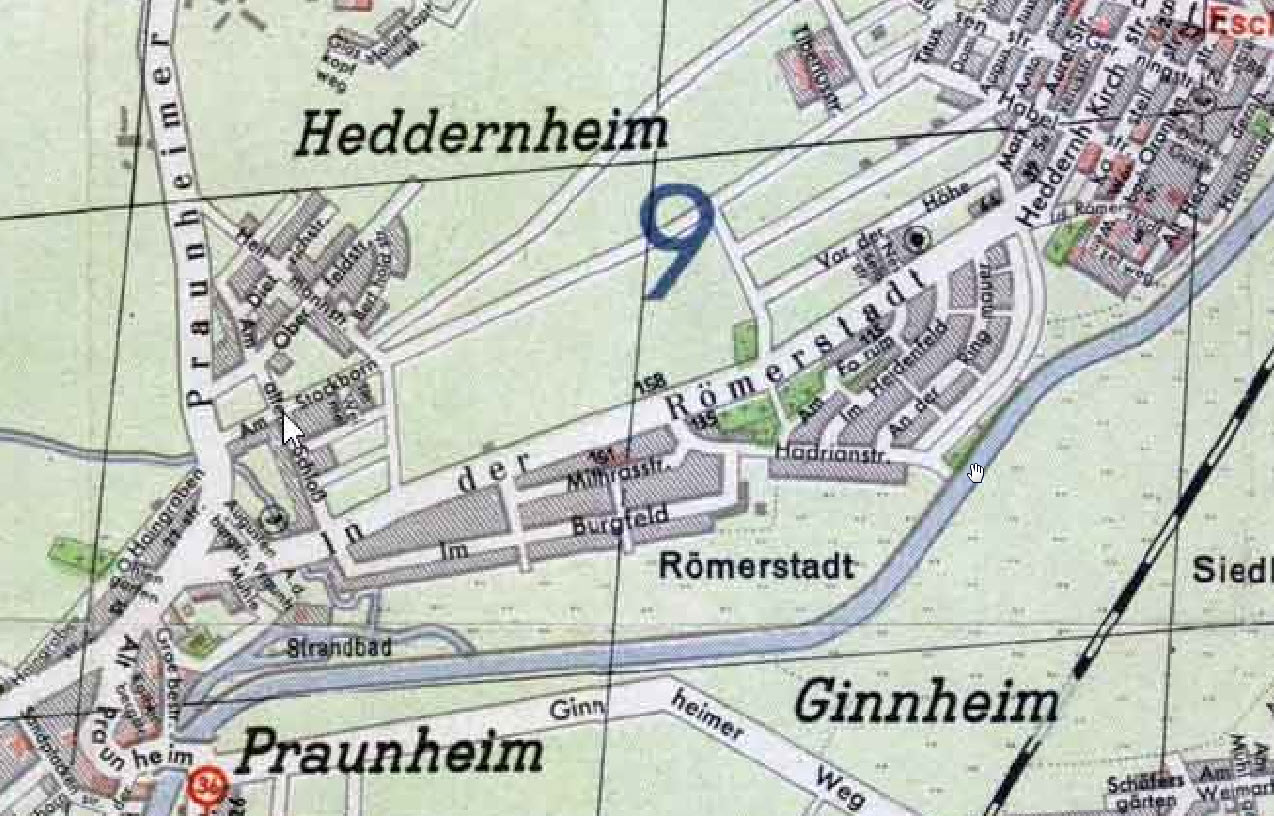
|
| Römerstadt on 1946 map[19]
|
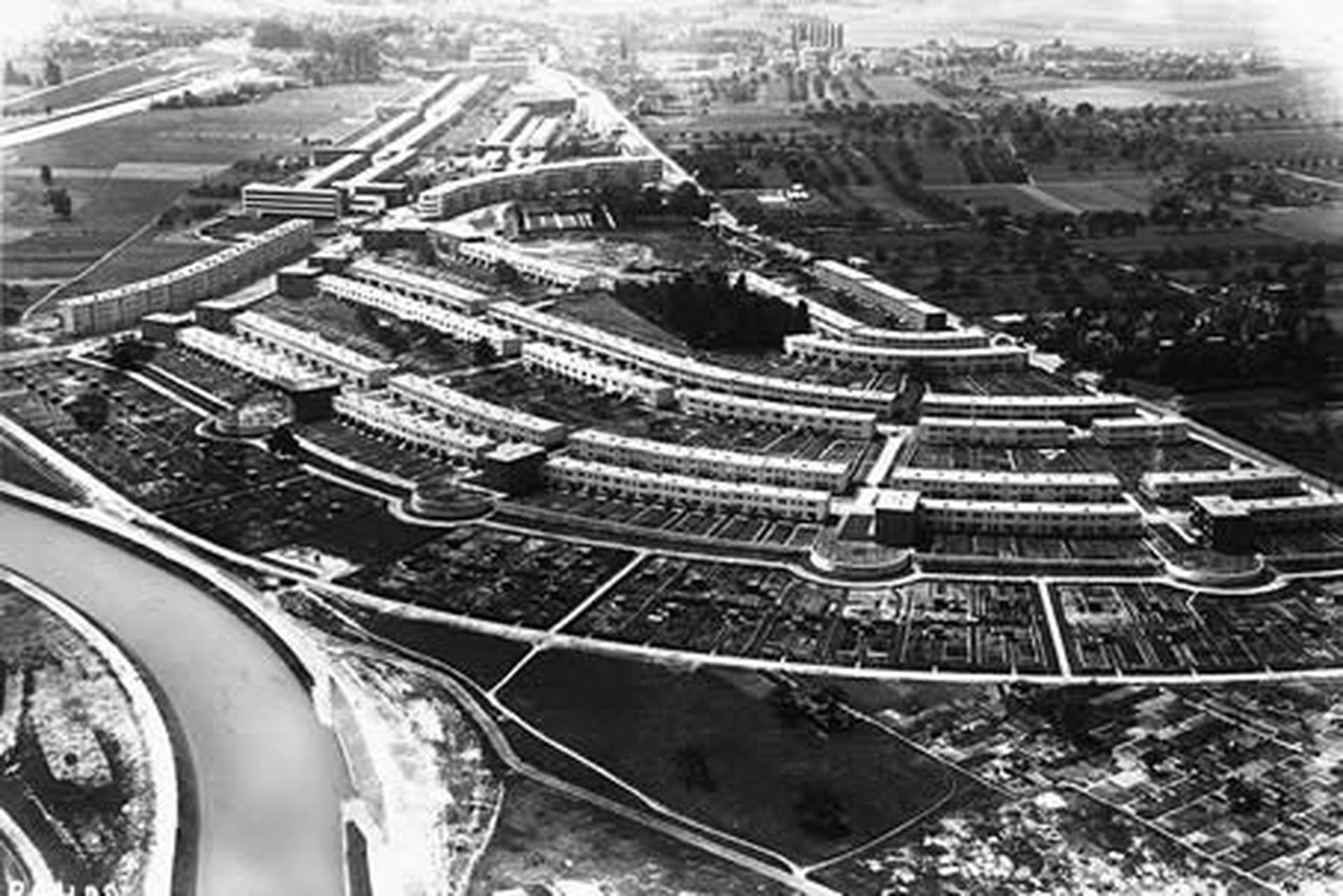
|
| Aerial view of Römerstadt about 1930
|
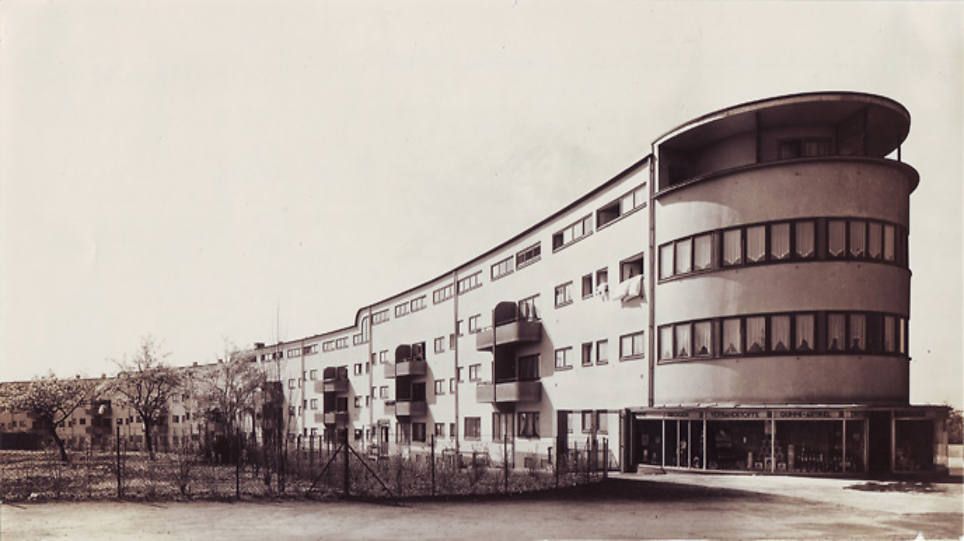
|
| One of many Römerstadt buildings 1928
|
Soon after the US Army took charge of its sector of Germany in 1945, it
encountered a lot of discipline and morale problems among the troops, not to
mention a low reenlistment rate (and a high VD
rate)[
12]. To address the situation, the
authorities decided to allow married soldiers to have their families join them
in Germany. The first dependents arrived in April 1946 via troopship with
no place to put them, so they were housed in requisitioned German homes. In
Frankfurt, the American occupation requisitioned about 3700 apartments in
Ernst May's
historic and un-bombed 1920s Weimar-vintage
Bauhaus-style "socialist"
Römerstadt complex on the north bank of the Nidda river about 4km NNW of
the Farben building, between Heddernheim and Praunheim: at first to
temporarily house freed Polish slave laborers, then American paratroopers,
and then until the mid-1950s it was home to American military families
complete with snack bar, PX, fire house, chapel, movie theater, and parade
ground: a fenced-in and guarded area for about the first five
years[
14,15,16]. Displaced tenants were paid
monthly rent for their apartments, which came out of German war reparation
funds[
20,p.481]. Americans started starting
moving out of the Römerstadt and other requisitioned German apartments in Fall
1950 with the opening of the 420-unit HiCoG housing
area[
1], but it would be five more years before
enough American housing was available to free (almost) all the requisitioned
units.
History: The big Sperrgebiet
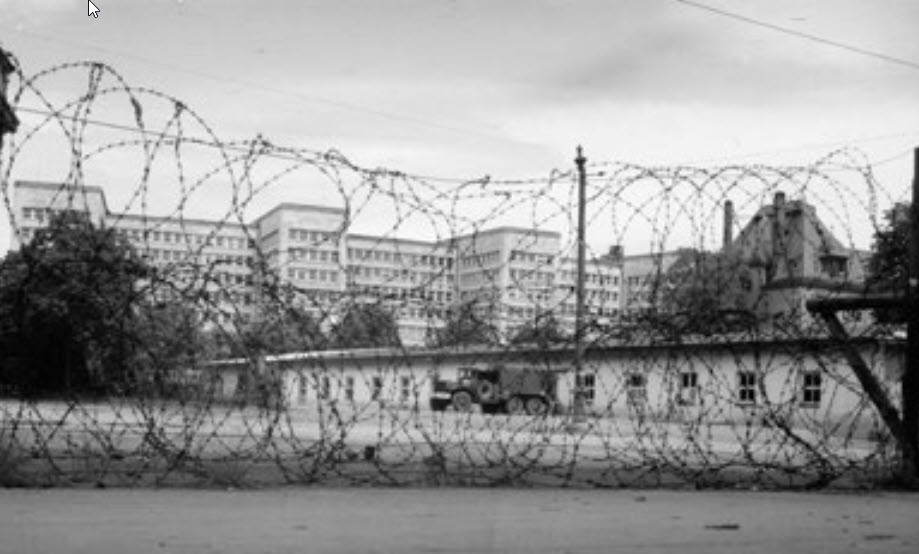
|
| IG Farben building with barbed wire fence
|
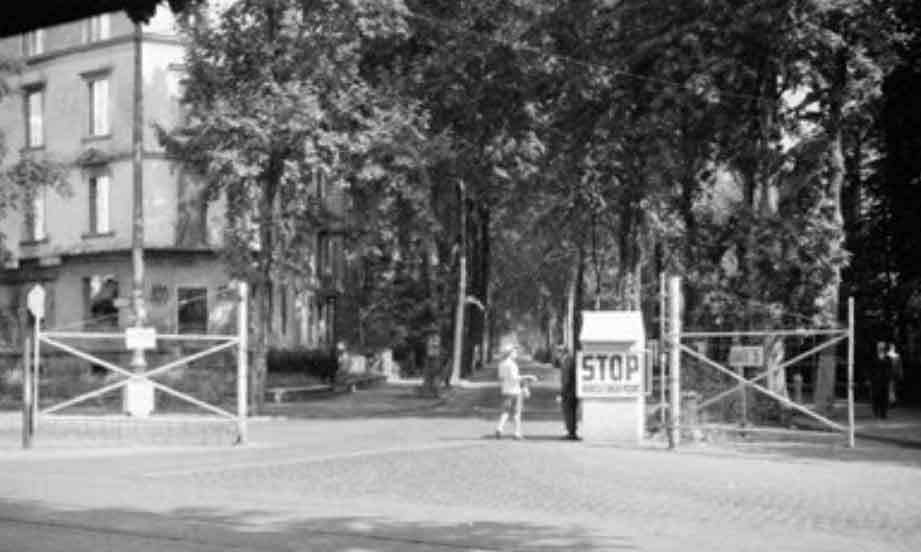
|
| Guarded compound entrance
|
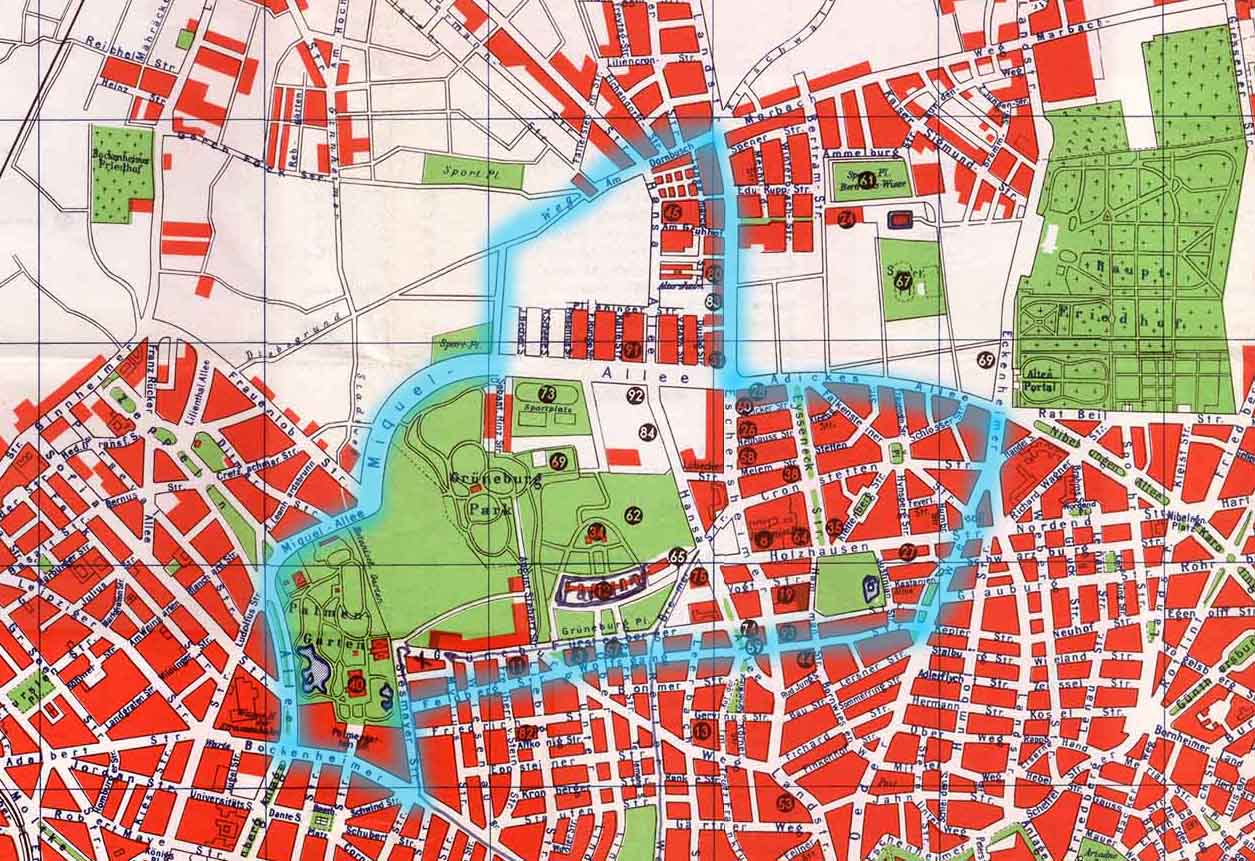
|
| Das Große Sperrgebiet
|
A much larger fenced-off zone, das Große Sperrgebiet (the Big Restricted
Area)[
18], was created in April 1945 for American
use and lasted until June 1948: 2.4 square kilometers enclosed
in barbed wire and protected by armed guards. Germans were not allowed to
enter except with an Army-issued permit. It went from a block south of the
IG Farben building, north to Am Dornbusch, west to incorporate Grüneburg
Park and the Palmengarten, and east to Oeder Weg. The western part included
the IG Farben complex; the eastern part included a lot of apartment
buildings, from which the tenants were evicted, allowed to take only their
clothing, sheets, blankets, pillows, and cookware, and were not allowed back
in until 21 June 1948, when the barbed wire was taken down. But they
weren't able to move back into their apartments until Platenstraße and the
other American housing areas were ready about 1955.
The
first American elementary school opened
in the Sperrgebiet in Fall 1946.
History: Newly-built American housing 1955-1995
Between 1950 and 1955 as US occupation forces expanded due to heightened
Cold War tensions, the demand for American housing was growing at the
same time that German political and public opposition to requisitions was
reaching a boiling point. The occupation had little choice but to construct
its own housing and return the requisitioned units to their renters
or owners[
20].
HiCoG, which opened in 1950, was the first purpose-built American housing in
Frankfurt; it was constructed from bombing
rubble[
20].
In May 1954, the
Stars and Stripes announced the aquisition of land
near the Farben building and other locations in Frankfurt for the
construction of housing[
17]. By 1958 about
20,000 housing units had been created[
11,12]
including Platenstraße, Hügel, and Von Steuben in the IG Farben area.
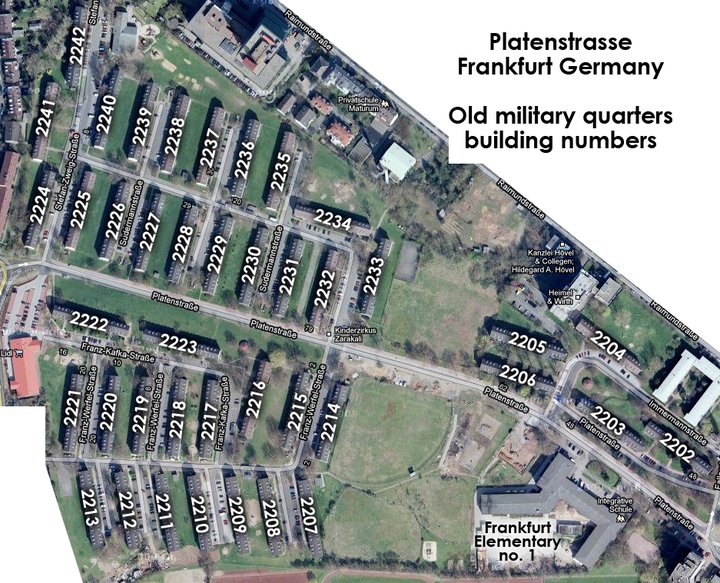
|
| Platenstraße building numbers
|
Platenstraße housing did not exist yet, as can be seen in the 1946 Große
Sperrgebiet map above and the 1954 aerial photo at right. But by the end of
1956 both the street and the housing were fully
realized[5]. The apartments were constructed to
American specifications (bathrooms, closets, kitchens) by German contractors
and — like all American housing in Germany built before 1957,
including HiCoG — it was paid for out of German War Reparation
funds[11]. Platenstraße housing comprised 41
buildings with a total of 777 apartments, making it the largest US Forces
housing area in Frankfurt[4], and the same design
was used all over West Germany. The units ranged in size from 80 to 115
square meters (861 to 1238 square feet). Traditional construction, not
prefab, because had it been prefab it would have been called
Plattenstraße :-) (in German, Platte is a prefab panel and
Plattenbau is prefab construction). The housing area is named after the
street that runs through it, which, in turn, is named after poet and
playwright
August von Platen-Hallermünde.
When Platenstraße housing (along with Hügel, Von Steuben, and others in
Frankfurt) opened about 1955, the Römerstadt, Sperrgebiet, and other
requisitioned apartments were turned over to the City of Frankfurt and
displaced former tenants were free to move back into their old apartments,
and some did[16,17].
History: What was the rent?
Numerous references discuss postwar dependent housing, and all state that it
was "subsidized". But to what degree? What did an Army family pay for rent
in Platenstraße or HiCoG? I don't remember ever hearing any talk of rent
when I lived there as a teenager, neither does anyone else I know. Nothing
shows up in Google or any of the books or articles in the
References section below. Maybe rent was never
discussed because there was nothing to discuss! Greg
Cagle[
5], who (like me) lived there in the 1950s
and 60s as a dependent, found the following entry in his father's diary from
January 1964:
... I’d have to pay for shipment of my car, there was no way out of that. I
would have to wait my turn for family quarters. The quarters were
rent free.
Robert Paul says, "I can confirm that
we consulate families paid no rent for the housing in Frankfurt. I recall
my parents' discussing how they could save money by being posted abroad."
History: Elvis at Platenstraße
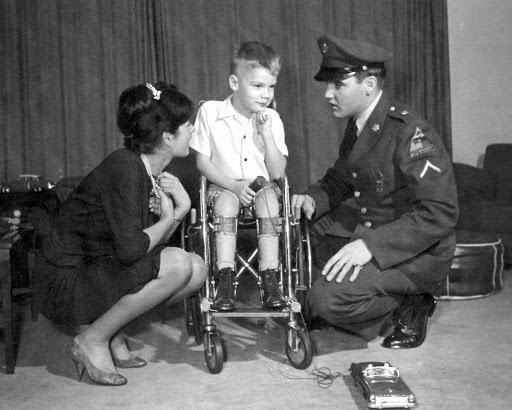
|
| Elvis at 2238A Platenstraße 1959
|
On another historical note, on January 18, 1959, PFC Elvis Presley of the
1st Medium Tank Battalion, 32nd Armored Regiment, 3rd Armored Division in
nearby Friedberg paid a visit to the Marquette family at 2238A Platenstraße
and their six-year-old son Robert, March Of Dimes poster child for the
1958-1959 campaign against polio, arthritis, and birth
defects.[
4]
This was the second of three visits he made to Robert; on this one he is
accompanied by Czech/German actress
Vera Tschechowa
(at left in the photo), only a few weeks before I arrived in Frankfurt.
Platenstraße and HiCoG today
Thanks to Ruth Schlögl and Joseph Röder von Diersburg of
the
Frankfurt University of
Applied Sciences, who were working on an Audio Guide to
Platensiedlung[
9] in July 2021, for sending the
photos and information in this section.

|
| Aerial view 2021
|
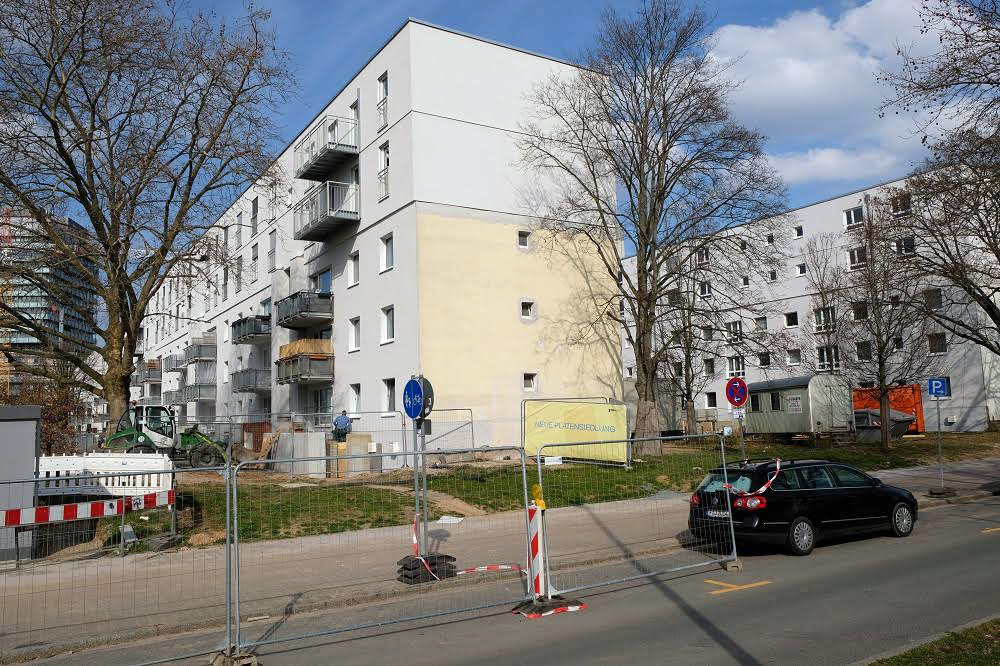
|
| Redensified north buildings in 2021
|
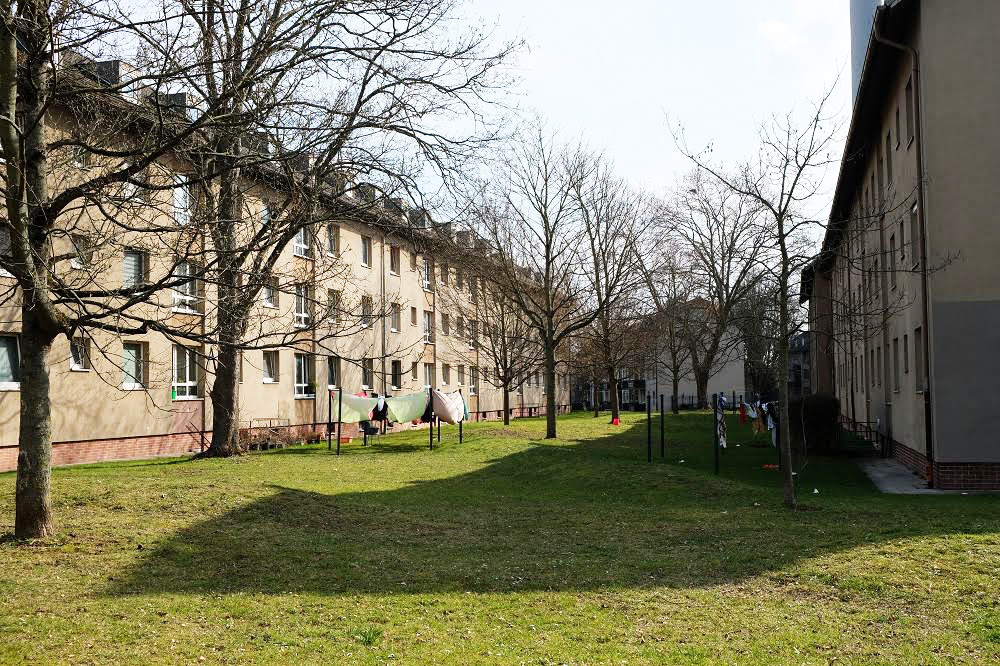
|
| Platenstraße-South buildings in 2021
|
Shortly after the American base in Frankfurt was vacated in 1995, most of
the American housing in Frankfurt was transferred to the City of
Frankfurt, which manages it and rents the apartments as good-quality
affordable housing through management companies such as
ABG[
2] and Bundesimmobilienagentur BIMA. The
Platenstraße housing area is now called Platensiedlung (Platen Village).
Rents are subsidized, normally set at 35% of net income. Some of the
apartments are designated "social housing" for people with low incomes.
Others are for employees of the Federal Government of Germany. A typical
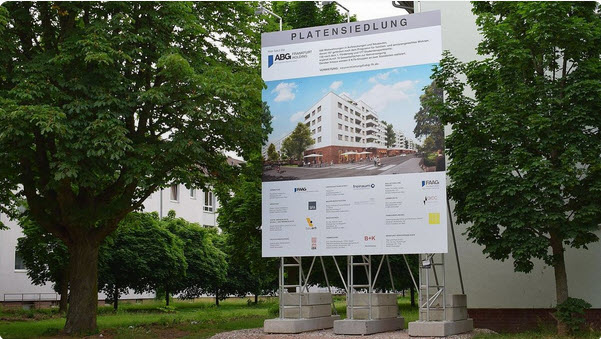
|
| Platensiedlung
|
rent might be 9 Euros/square meter, significantly lower than market rate
(and less than half what I pay in the Bronx, which is the lowest-rent
district in NYC). In many of the former U.S. housing areas the average age
is comparatively young since there was a complete change of tenants in 1996
and many young families moved in. Nevertheless, there are also a lot of old
people. A large number of people with foreign roots live together at
Platenstraße and in Frankfurt as whole, where the proportion of foreigners
is about 17%. Buildings south of Platenstraße (the street itself; see old
map at
C-12) remain as they were in the 1950s
and 60s; in the northern part a "redensification" project has added
two stories to each building[
2,6,7,8,9].
HiCoG is now now known by its traditional name, Carl-Schurz-Siedlung;
Americans still live and work there, this time those attached to the US
Consulate, and the buildings are being renovated
too[3]. Reputedly the new American acronym
for the former HiCoG buildings is AMCONGEN.
References...
(American housing in postwar Frankfurt)
- Chadbourn, Dorothy, "HICOG Houses Its
Employees", HICOG Information Bulletin No.187, February 1951,
pp.19-23, unearthed by FHS veteran Dennis Healey in 2018
(see
Information Bulletin index 1945-1953).
-
Modernisierung der Platensiedlung, Wohnungsbaugesellschaft ABG Frankfurt
Holding website, accessed 14 July 2021. So far 650 new apartments have been
created.
- Germany,
eDiplomat website, accessed 14 July 2021: "The Carl Schurz Siedlung is a
combined housing and office complex, conveniently located in Frankfurt and
within walking distance of both the Consulate Office Building and the RSC
[Regional Support Center]. Transportation to and from Consulate facilities
is not provided. The Siedlung has over 300 apartments in 25 three-story,
walk-up buildings. Each building has two stairwells with six apartments
sharing each stairwell ... Frankfurt is renovating and upgrading its
apartment buildings to improve facilities and institute energy-saving
measures. This project is ongoing and while in progress, the flexibility of
housing assignments will be limited, as entire buildings need to be reserved
for renovation."
-
Platenstraße (Frankfurt am Main), Wikipedia.de, accessed 18 July 2021.
- Gregory A. Cagle,
Scenes
from an Automotive Wonderland: Remarkable Cars Spotted in Postwar
Europe, McFarland & Company (2018): "...it's parked in front of
our apartment building in the Platenstrasse American housing area in
Frankfurt on December 9, 1956." Later I found evidence that Platenstraße
opened in 1955: "Die Housing Area Platenstraße war die Größte Wohnsiedlung
der Amerikanner in Frankfurt. 1955, zehn Jahre nach Kriegsende, zogen
die ersten US-Bürger dort ein..." (Inga Schulze, Warum
Frank aus N.Y. nicht von Frankfurt lassen kann, Frankfurter Neue
Presse, 22 June 2006).
- Video: Frankfurter
Projekt baut alten Häusern Zusatz-Stockwerke, n-tv Nachrichten,
26 Juni 2019 (accessed 18 July 2021). Early stages of redensification
of "Platenstraße North". It looks there is a lot of prefabrication
involved so now maybe it's Plattenstraße after all!
- Video: Platensiedlung
aktuell, November 2020, ABG Frankfurt Holding,
Youtube (accessed 18 July 2021), shows
Platenstraße Nord" (where I lived) with new upper stories, construction in
progess.
- Video: Platensiedlung
aktuell April 2021, ABG Frankfurt Holding,
Youtube (accessed 18 July 2021), same thing five
months later.
- HALLO
Platensiedlung!, Ruth Schlögl, Natalie Heger, Thyra Jones;
Forschungslabor Nachkriegsmoderne,
Architekturstudiengänge der Frankfurt University of Applied Sciences,
23 July 2021.
[Facebook]
[Instagram]
[Map]
CLICK HERE to hear the Audio Walk (37 minutes,
in German)
- Donald A. Carter, Forging
the Shield: The U.S. Army in Europe 1951-1962, U.S. Army Center for
Military History (2015), section "Settling in for the Long Haul", pp.127-137:
the story of behind dependent housing. Briefly, it was for both the morale
of the soldiers and to convince the Soviets that the US occupation was not
a prelude to invasion.
- Robert P. Grathwol and Donita
M. Moorhus, Building
for Peace: U.S. Army Engineers in Europe 1945-1991, Center of Military
History and Corps of Engineers, United States Army Washington, D.C. (2005),
pp.96-100.
- Brian McAllister Linn,
Elvis's
Army, Harvard University Press (2016), pp.45-46.
- Dewey Arthur Browder, The
Impact of the American Presence on Germans and German-American Grass
Roots Relations in Germany, 1950-1960, Louisiana State University and
Agricultural and Mechanical College PhD dissertation (1987), pp.74-79.
- Klaus Gülden, Die
Beschlagnahme der Römerstadt-Siedlung durch US-Truppen Ende März 1945,
heddernheim.de (accessed 28 August 2021).
- Von Clemens Dörrenberg,
Plötzlich mussten sie das Haus verlassen, Frankfurter Rundschau,
14 March 2016 (accessed 28 August 2021).
- Heidi Laird, The
Frankfurt Kitchen: Forty-One Stories of Growing Up in Post World War II West
Germany, Fulton Books (2021), pp.92-93. The author, a German born
in Heidelberg in 1941, lived in a Römerstadt apartment for several years
starting in 1949, when it was full of American families; she notes that the
Americans gradually started moving out that same year. "Frankfurt Kitchen"
(Frankfurter Küche) refers to
the unique Bauhaus
design of the Römerberg's kitchens. Laird eventually emigrated to the
US and became a clinical psychologist in San Benardino, California.
Read an interview with her
here.
- James Quigley, "Land acquired for
1,834 New NACom Billets", European Stars and Stripes, 19 May
1954, p.2: "Northern Area Command recently completed the acquisition of land
in the Frankfurt area that will be used for housing construction projects
scheduled to begin soon. The land is located in the Gibbs, Drake, Edwards,
and IG Farben Complex areas, as well as adjacent to the HICOG housing
development and the Hoechst cemetery. Plans call for the construction of
103 buildings which will include 1,854 housing units. The acquisition of
suitable land for housing construction will now allow the US Army to release
sooner German housing currently under requisition."
- Andrea Janssen, Das
große amerikanische Sperrgebiet in Frankfurt April 1945 bis Juni 1948,
Stiftung Polytechnische Gesellschaft (sptg.de, accessed 4 September 2021).
-
Stadtplan S8 1/498 Frankfurt/Main
in Hyperboloid-Projektion mit Kilometernetz, Falk-Verlag (1946).
- Adam
R. Seipp, "This
Land Remains German": Requisitioning, Society, and the US Army,
1945–1956, Central European History 52, Issue 3 (September 2019),
pp.476-495 (restricted access): A detailed account of requisitioning of
German dwellings and other property by the American occupation.
-
1945 in Frankfurt: Wie Frankfurter das Kriegsende erlebten,
Frankfurter Rundschau, 10 April 2015.
-
Ernst May,
Wikipedia (accessed 24 November 2021).
Frankfurt High School
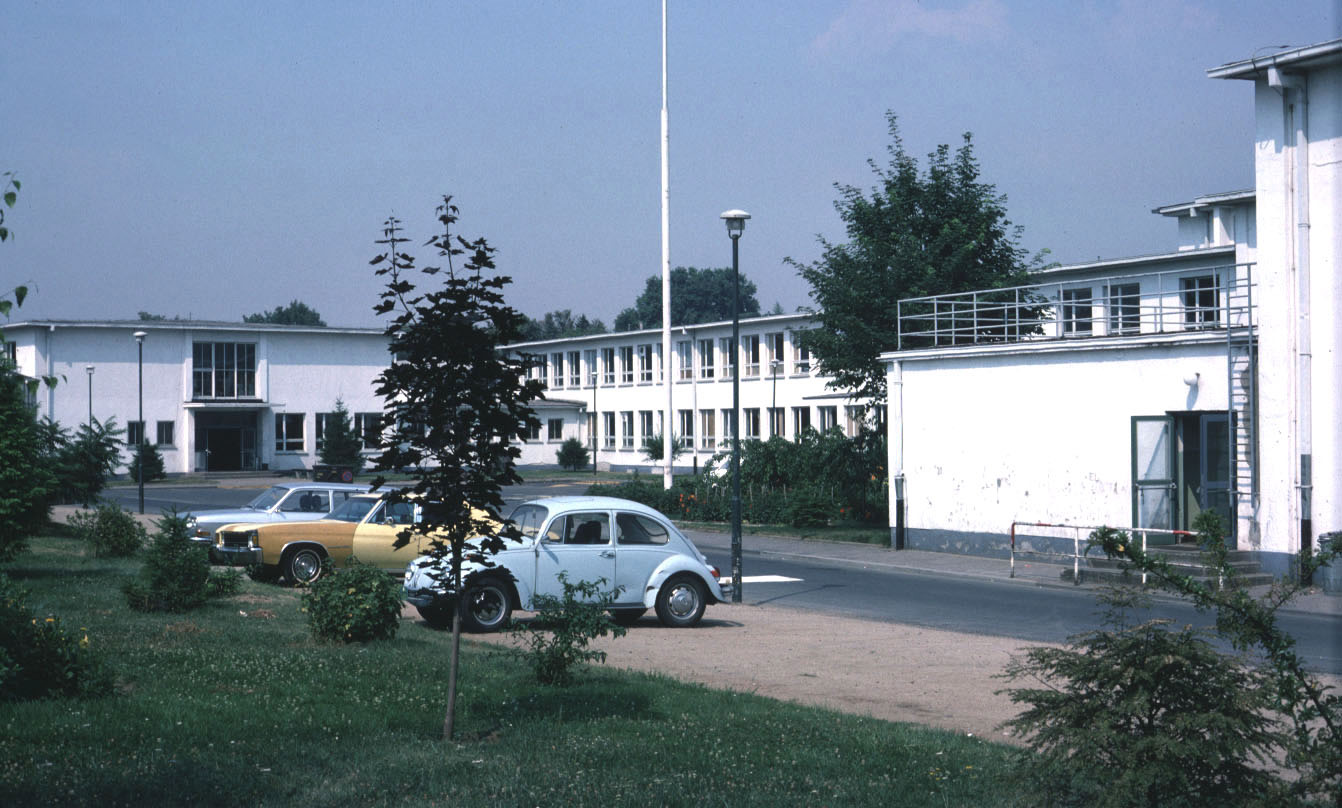
|
| Frankfurt High School
|
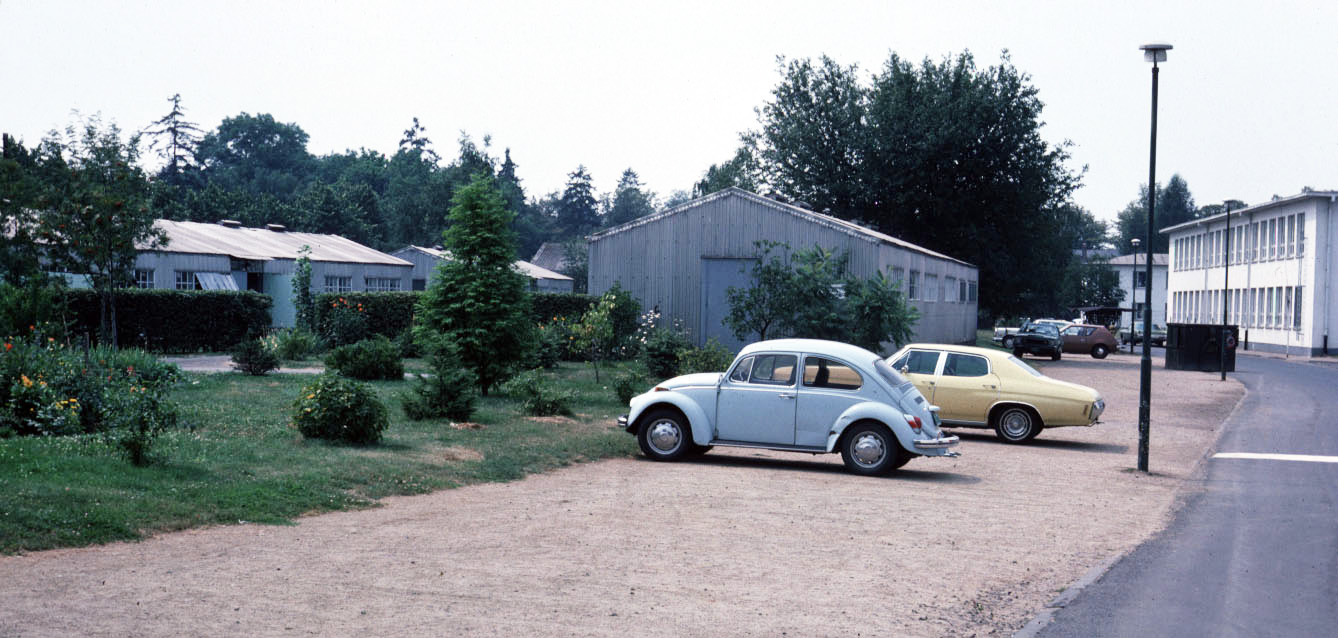
|
| FHS dorms (right) and "Quonset" huts (Silver City)
|
My brother and I went to the American Army schools —
9th-11th grade for me, Frankfurt High School; elementary school
for Dennis. The FHS student body was 900 and included kids like me who
walked to school, kids from farther away (the Drake-Edwards or Gibbs or
Atterberry Kaserne, or neighboring towns and cities like Aschaffenburg,
Babenhausen, Bad Homburg, Bad Nauheim, Bad Vilbel, Bonames, Butzbach,
Büdingen, Darmstadt, Friedburg, Gelnhausen, Hanau, Höchst, Langen,
Mörfelden, Oberursel... or the Rhein-Main air base near Wiesbaden) who
arrived in 25 big olive-drab Army buses each day; kids from even farther
(e.g. Bad Godesberg, Gießen, Fulda, Kassel, Wildflecken) [apparently, at
least Fulda and Gießen got their own American high schools in later years]
who lived in the dorms all week but went home on weekends, and kids from
REALLY far away like Moscow, Damascus, Warsaw, Helsinki, Lisbon,
Tunis... (children of diplomats or attachés in places where there were no
American schools); they stayed in the dorm all semester and ate three meals
a day in the cafeteria. Although 900 sounds small to a New Yorker, it was
far too many for the original 1954 building so we also had some "Quonset
huts" for the overflow (strictly speaking these were Butler Buildings; real
Quonset huts are half-cylinders, but it's the same idea: prefab temporary
buildings made of corrugated metal that can be erected in a few
hours)[
9].
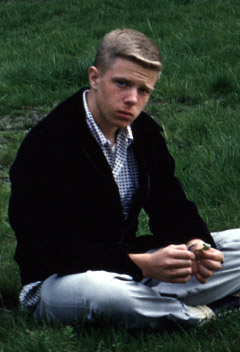
|
| Me in 1959
|
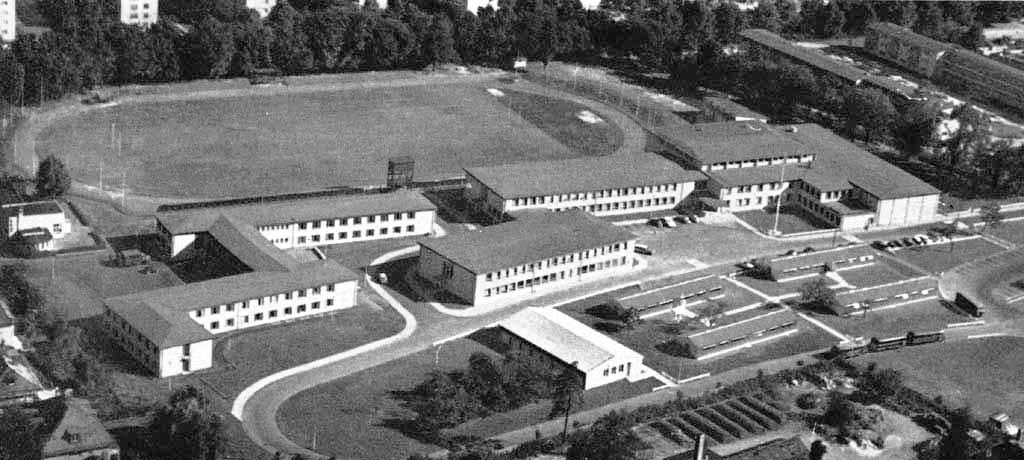
|
| Frankfurt High School aerial view 1960
|
When I started school in the middle of the 9th grade, it was quite shock.
Instead of all white suburban kids like in Virginia, there were Black kids,
Puerto Ricans, Hawaiians, Mexicans, Filipinos… and even the white
kids were from all over, with every kind of background and accent. Plus
people were from all social classes from aristocracy (children of
ambassadors or generals) to dirt-poor. It was the complete opposite of my
junior high school in Arlington, where everybody was exactly the same:
white, middle class, and Virginian.
Some of the FHS kids in 9th grade were hoodlums like in Blackboard Jungle,
with leather jackets and collars turned up and ducktails and
switchblades but there was never actually any fighting. My friend Joe
Caranci always spent Geography period carving things into his desk with his
switchblade and one day when the teacher said something about it, he cut off
the teacher's necktie and threw his briefcase out the window (that was my
only Blackboard Jungle class). And yes, there was a Geography class; in
those times everybody learned what all the countries in the world were, and
something about them.
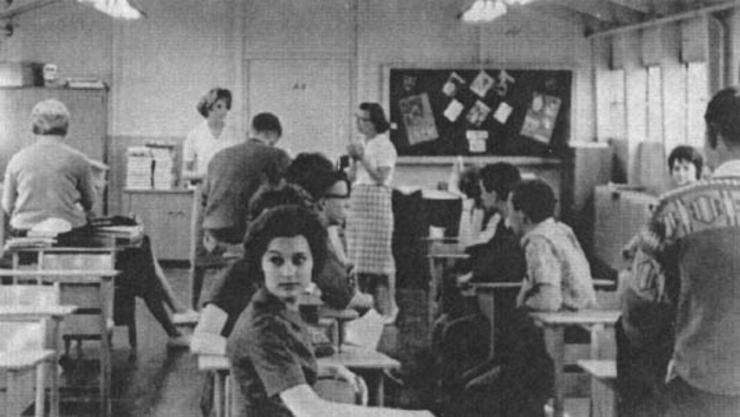
|
| Miss Costello's Latin Class in Silver City
|
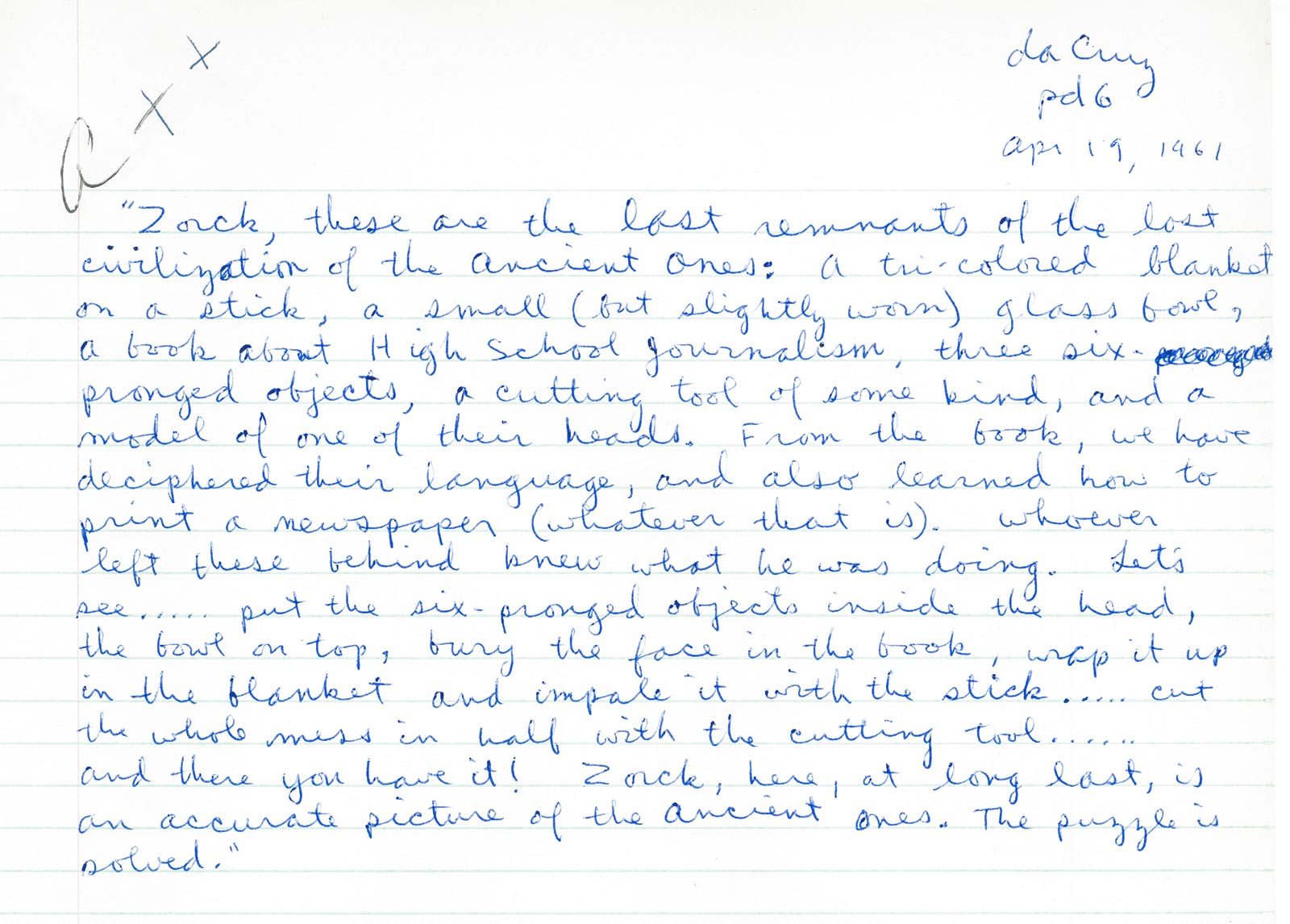
|
| Creative writing story 1961
|
In reality, it was an excellent school, and the best thing about it was that
if you did well in class, there was no social stigma as there was in
Virginia. Consequently I got high grades the whole time I was there and had
good relationships with many of my teachers, for example Miss Costello, my
Latin teacher for two years who ran the class like a Marine drill sergeant
but in reality was a sweetie. Or Miss Rotter who taught AP English and
encouraged me to write down any crazy thing that came into my head. I could
do that and still be a cool guy. She was also
the
Radio Club adviser in 1960-61. Or
Mr. Thompson (more about him
below).
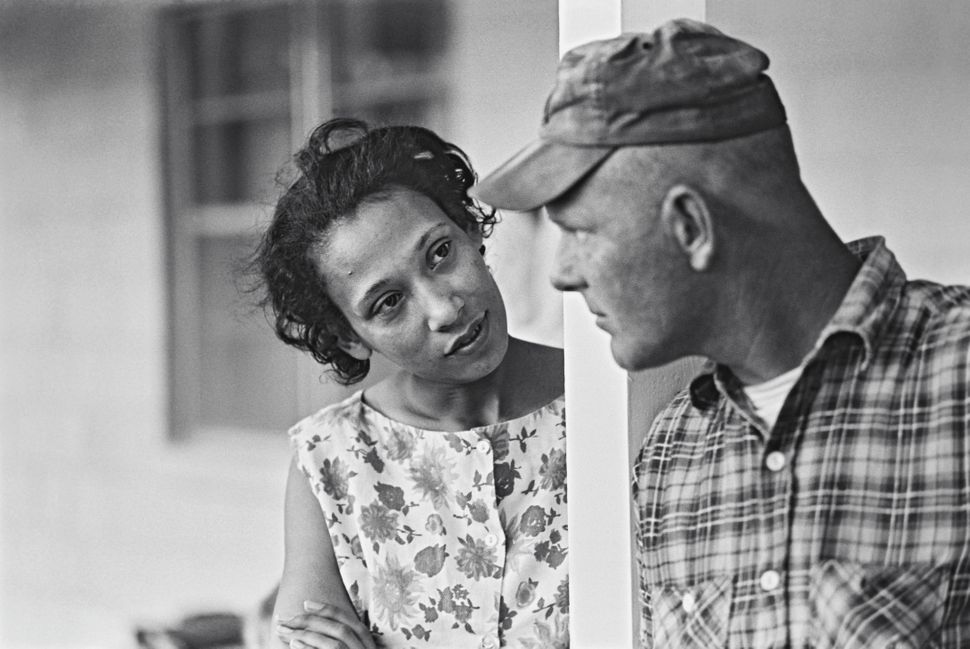
|
| The Lovings of Virginia
|
To top off the differences from "back home", there were interracial
couples… This was at the exact same time as the huge uproar in
Virginia — in Central Point, not far from where I had lived —
about
the
Lovings[
11] (a white man and black woman who
married and were prosecuted for it), that went all the way to the Supreme
Court. Honestly, we all felt so lucky not to have to worry about any of
that... Imagine, living in a diverse community with no racial barriers in
the late 1950s and early 60s. We knew how precious a gift this was; we
lived in a virtual paradise safe from all the ugliness and brutality of our
own country.
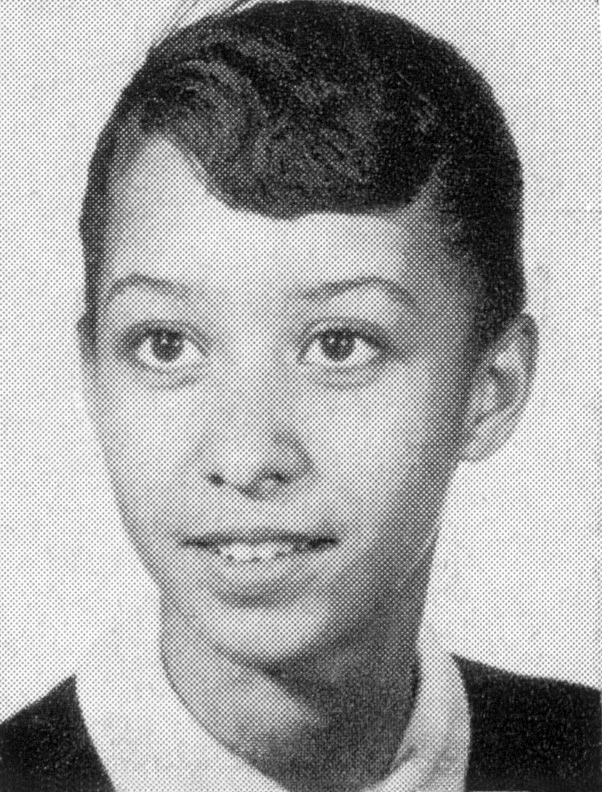
|
In 9th and 10th grade I was friends with a girl named Carolyn Parker. We
sat next to each other in class; I helped her with her homework (she didn't
really need help, it was like a game). We just enjoyed each other's
company; she was very sweet and soft spoken. I guess I had a crush on her.
But that was 1959-1960 and it simply didn't occur to us to see each other
outside of school, or if it did, we were probably both thinking about how
our parents (or in my case, just the one) would react. Plus we were both
pretty shy. She "rotated" before my junior year which was when I started to
have a social life. But I still remember her.
Speaking of rotating,
I quickly realized that another big difference between a military base and
everywhere else I had ever lived is how easy it is to make friends. Because
kids are so diverse, there wasn't the kind of cliquishness I recall from my
junior high school in suburban Virgina. And because nobody stayed in the
same place more than two or three years, military brats grew up learning how
to make friends rapidly and how to be openminded and honest and not play
games. I never felt more comfortable with people in my life than I did
there, and never had so many friends, not before, not since.
Another facet of life as a kid on a military base is how the
parents are so conscious of rank: who's more important than who, who can
socialize with who, who can go to which club (Officers, NCO, EM)...
whereas the kids instinctively rebelled against all that and we all
developed a healthy antiauthoritarian streak. For example if a General
found out his daughter was dating a Sergeant's son he would almost certainly
order her to break it off and that would only make the relationship stronger.
Frankfurt Base Facilities
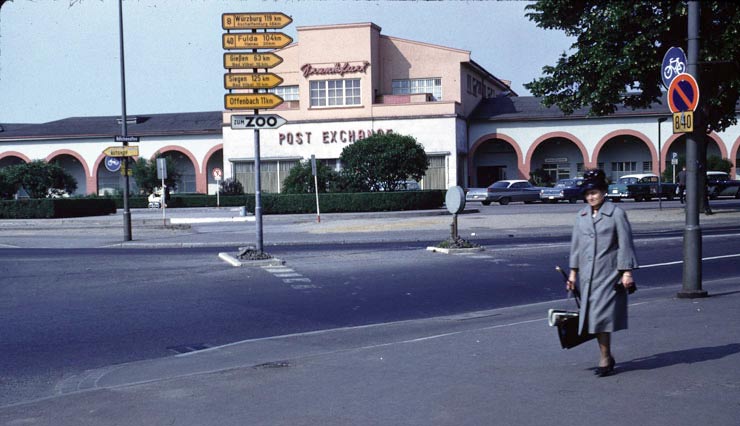
|
| WAC Circle: Frankfurt PX, Commissary, and Snack Bar, 1960
|
Meanwhile, there were endless facilities on the base for service members and
their families. The Post Exchange (PX, center in the photo) was like a
department store that sold clothing, records, books, pots and pans, etc,
(and of course, transformers) at no markup or even subsidized, in
recognition of the low military salaries. The Commissary (right of the PX
in the photo) was like an American supermarket for food shopping, also
nonprofit and subsidized. The Snack bar (left) was a huge cafeteria
featuring approximately the same fare as a Burger King or IHOP. There was
also a "Class VI store" somewhere, that's Army-speak for a liquor
store. Behind these buildings was a gas station where gas was 10 cents a
gallon. Scattered all over the base (after 1948 it wasn't a fenced-in
base[6], just buildings and neighborhoods all over the city) were countless
smaller snack bars, field houses, clinics, athletic fields, running tracks,
dispensaries, clubs, and so on[7]. Barracks for soldiers were fenced in,
however; they were called Kaserne since many of them were old Wehrmacht
barracks (Kaserne) with swastikas chiseled off the gates (♪♫
Vor der
Kaserne, vor der großen Tor... ♪♫).
Medical care was free and universal, school was free and excellent, and
housing was free or heavily subsidized. Ordinary working people of all
ranks could live modest, comfortable, and relatively secure and stress-free
lives without being millionaires and billionaires or working 100 hours a
week. Our parents (or more often than not, just our fathers) did their
40-hour-a-week jobs (and we did our jobs by going to school), and the
government took care of us. No wonder we liked it so much over there, it
was Socialism! [1]
In January 2024 Pam Ives came across a two-page
1960 Army Times article[2]
clipped by her parents that describes the Frankfurt base facilities in great
detail. If you think it sounds like Paradise on Earth, you're not
far wrong!
References...
- Strictly
speaking socialism
includes public ownership of the means of production; the Frankfurt
Army base experience was more like "market socialism" where private
companies exist, but the essentials of life such as housing, health care,
education, and secure retirment are provided by the government at no or
low charge. This was the dominant form of government in postwar Europe
and Scandinavia and, to some extent, other countries like Canada and
New Zealand, but lately is eroding due to the wave of right-wing backlash
sweeping the whole planet. US military bases sometimes crossed the line
into true socialism, like when the Army set up factories in Germany
(and elsewhere) to produce
ice cream for base residents.
- Guild, Hazel,
"Frankfurt: Chicago on the Main, Army Times, 14 June 1960,
pp.36-37.
Bob Engs
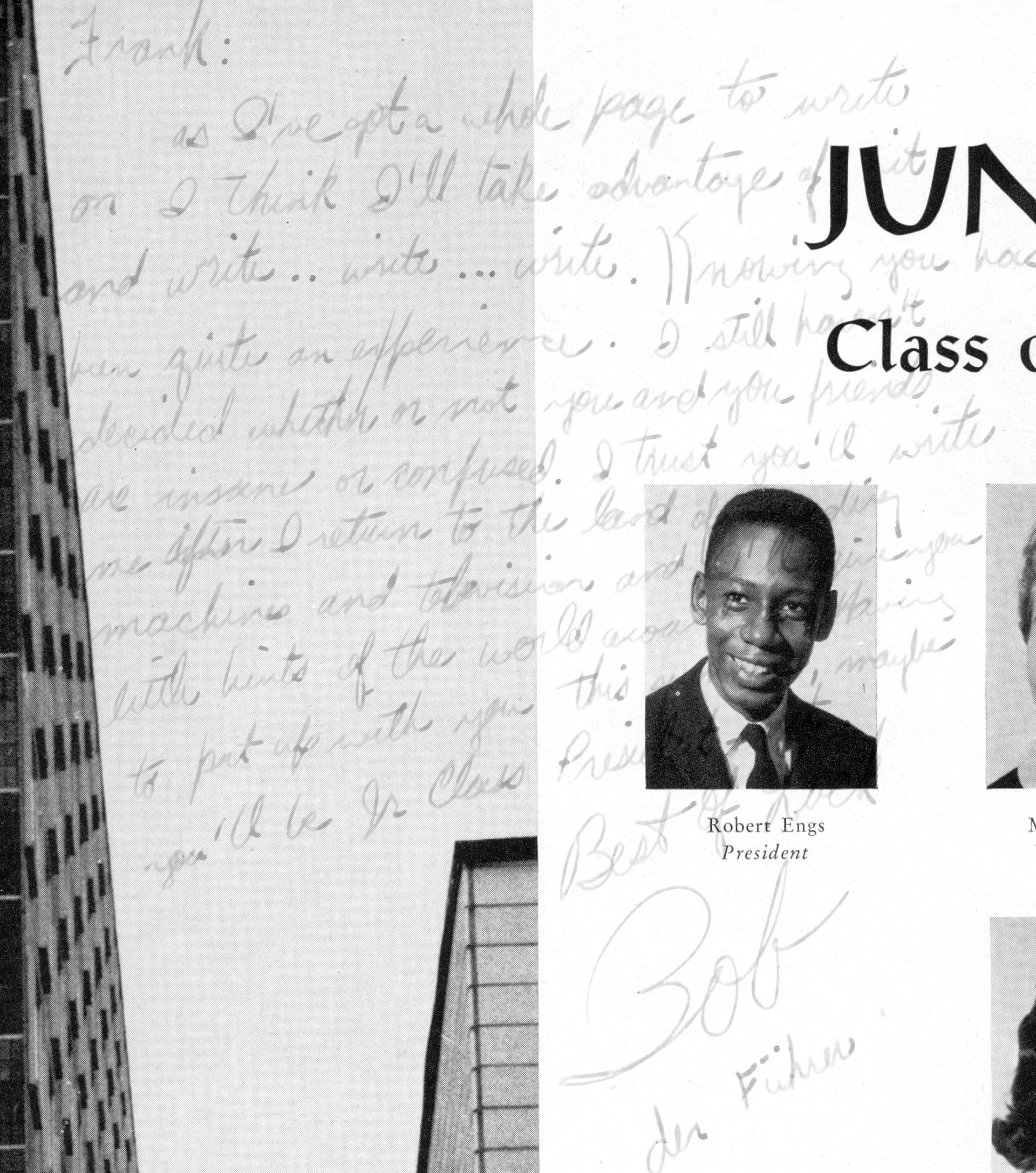
|
| Bob Engs (yearbook)
|
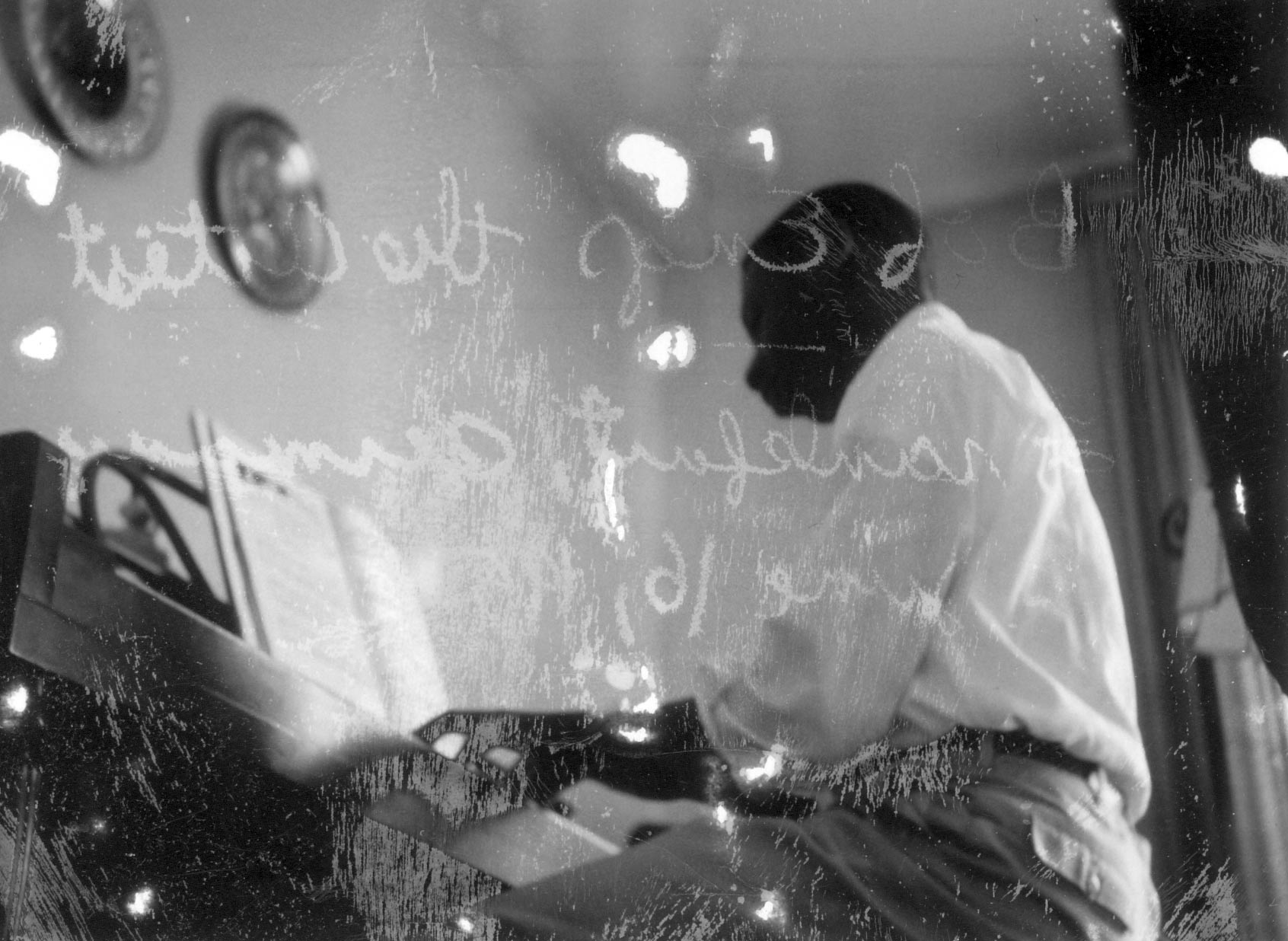
|
| Bob Engs at home 1959
|
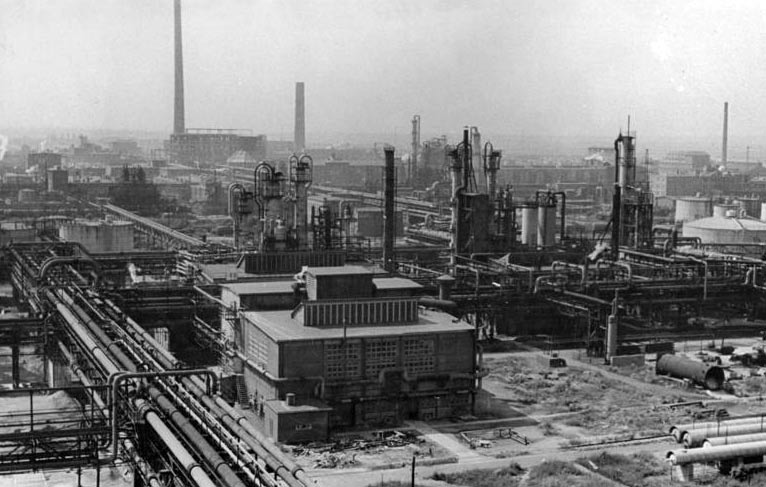
|
| Chemical plant
|
I don't remember much about 9th grade, it was only a few months. In 10th
grade, Bob Engs was pretty much my main outside-of-school friend. Bob was a
year older but we had the same birthday. He was also a year ahead of me in
school and president of his class, a super-achiever. He lived far away in
the industrial city of Höchst, about two hours away by trolley*,
dominated by the huge Höchst AG chemical plant that spewed out toxic black
smoke, the air was always thick with it; in those days if you took a color
picture of Höchst it would still come out grey. The chemical plants
employed thousands of Turkish "Gastarbeiter" under horrible conditions, we
never saw them because they weren't allowed to go into town. My dad was
scandalized about Bob, but said it was OK for me to have black friends as
long as we were in Frankfurt, but not in Virginia. My brother's best friend
was also black. My parents were pretty impressed I could navigate the
trolley system from city to city, negotiating the hair-raising transfer from
the #17 to the #11 at the free-kill zone in front of the Hauptbahnhof.
The Engs family returned to the USA at the end of the 1959-60 school year,
ending up in Fort Eustis VA, near Newport News; I visited them there in
1962. Bob had a long and distinguished academic career and died in
2013 at age 69[12].
References...
- Frankfurt
American High School, Wikipedia (accessed 31 March 2019).
- Wertsch, Mary
Edwards, Military Brats,
Harmony Books and/or Brightwell Publishing (1991, 1996, 2006).
- Curtis, Marc, Growing
Up Military, CreateSpace (2009).
- Willis, William, Base
Jumping, William Willis Books (2013).
- Tuscott, Mary R., Brats,
Dutton (1989).
- "'Little
America' Fence in Frankfurt Seen Doomed", George Bria, Schenectady
Gazette, 9 February 1948 (via usarmygermany.com).
Apparently the fence was up for only a bit more than a year (1947-48).
- Army
& Air Force Exchange Service, Europe, Walter Elkins'
U.S. Army in Germany website,
accessed 7 July 2020: The European Exchange System: "The mission of EES is
service to the troops in Europe. Basically, this means providing services
and goods at minimum costs and in the most pleasant, courteous, and
efficient manner possible."—Col. Charles L. Redman, QMC, EES
Chief. EES was responsible for PX's, commissaries, liquor stores,
snack bars, delis, laundries, dry cleaners, barber and beauty shops, photo
processing; watch, radio, and shoe repair; florists, tailor shops, photo
studios, gas stations, car repair garages, libraries, athletic fields,
service clubs, teen clubs, service shows, as well as central butchers,
bakeries, dairies, and ice cream plants (such as
the massive one in Grünstadt)
that supplied the commissaries and
snack bars. There were also EES service stations and snack bars on the
Autobahns. Also there were mobile PXs and snack bars for troops in the
field. In Germany the large majority of employees at EES establishments was
German.
- The
Bald Eagles Echo, Fall 1995:
26 pages devoted to the closing of Frankfurt High School and
the whole American base in Frankfurt.
- Julie Decker and Chris Chiel, Quonset
Hut, Princeton Architectural Press (2005).
- Memories from
Germany, American Overseas Schools
Historical Society. I particularly enjoyed the story
of an American teacher, Nancy Siler, who went to Germany on a troopship
in 1949.
-
The
Loving Story, 1960s documentary about the Lovings.
-
Dr Robert Francis "Bob" Engs Jr,
1943-2013, Find A Grave memorial by Allen Monasmith, 11 May 2014.
History: American schools in postwar Frankfurt
"A somewhat unprecedented byproduct of the USAREUR dependents’ school system
was the 'melting-pot' role it assumed far beyond the borders of the United
States. Both staff and student body were composed of persons from all 48
states, and the territories, as well. People from all walks of life, all
races and creeds, and representing the full range of sectional backgrounds
and interests, met in the classrooms, bringing with them the uniqueness that
was theirs and taking away, certainly, a fuller knowledge and deeper
understanding of the totality that is the American
people." —[10,p.113]

Starting in 1946, the US Department of Defense Dependents Schools (DoDDS)
made schooling available to children of military, consular, and other
American families in Germany and other occupied
countries[
7]. So the correct way to refer to
these schools is DOD or DoDDS schools, but we always called them Army
schools. Why? Because (1) there was no Navy, Air Force, Marines, or Coast
guard in Frankfurt, it was all Army; and (2) the sign on our school said
"U.S. ARMY FRANKFURT HIGH SCHOOL" as seen on the inset, that comes from the
far right of
this photo. Other
American school signs in Germany also said U.S. Army, such as
this one in Kaiserslautern.
An interesting facet of the American elementary and junior high schools was
that German language instruction was given to all
students[16,17] in a required daily class. My
younger brother Dennis took German at Frankfurt Elementary #1, as did
Robert Paul
(see report card), Greg Cagle, and other
slightly younger informants who were in Frankfurt the same time I was.
Similarly for American schools in France, but French instead of German.
German language was taught by Germans; one of my informants
has an autograph from "Ruth Geise, Deine Deutschlehrer). The same is true
for American elementary schools in elsewhere in Germany such as the one
in Kaiserslautern, confirmed by another informant who was there in the
late 1950s.
At Frankfurt high school when I was there in 1959-61, Latin, German, French,
and (from Fall 1960) Russian were offered as
electives. Checking the 1977-78
yearbook I see that Russian had been removed and Spanish added.
High School...

|
| Friedrich-Ebert-Reformschule, which would become
the first Frankfurt High School in 1946.
Photo: frankfurt1933-1945.de.
|
The first Frankfurt High School (FHS) was at Am Bornheimer Hang 46 in
Bornheim, about 2.5 miles (3.8km) east of the Farben building. It
was built in 1929-30 as the Friedrich-Ebert-Reformschule[1,2] and designed by
Ernst May, who was
also responsible for the revolutionary Römerstadt apartment
buildings described above. This school building
was the first of its kind in Europe and drew visitors from many countries.
During the war it served as a military hospital, an officer's school, and
temporary housing for bombed-out families. From May 1945 to September 1946
it was billets for American occupation troops. It became Frankfurt's
American high school in Fall 1946 and served in that capacity through Spring
1954.[3] A protected landmark, it's still
there as
the Charles-Hallgarten
Schule[4,13,14] for special-needs students,
grades 1-10.
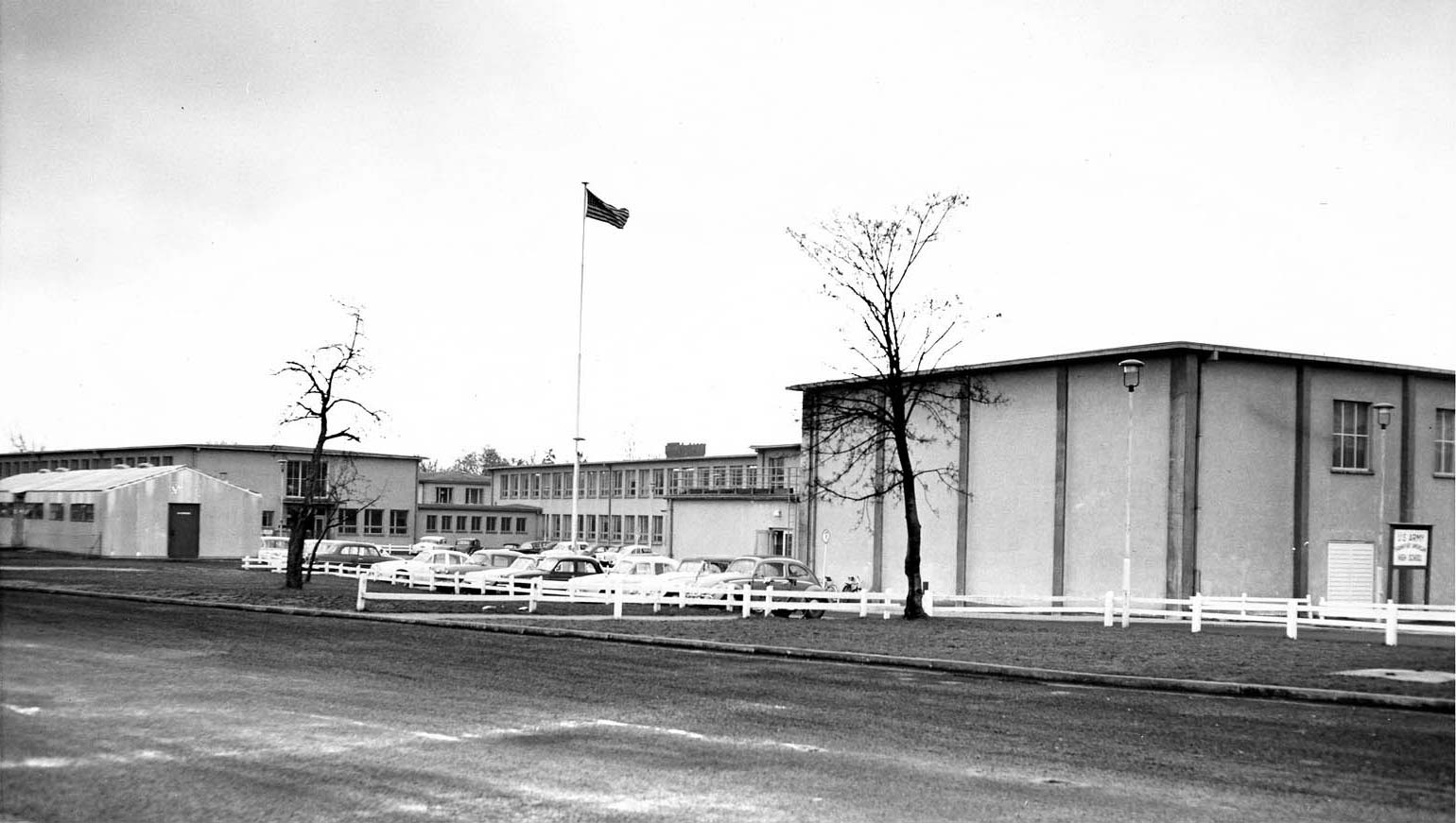
|
| Frankfurt High School Siolistraße 1959
|
In Fall 1954, Frankfurt High School moved to its newly constructed home at
Siolostraße 41, just north of the IG Farben building. It was in operation
from Spring 1954 through Fall 1995 when US forces left Frankfurt
after 50 years. It was one of few American high schools with dormitories
(Nürnberg, Kaiserslautern, and Munich also had them but I believe they were
5-day only, whereas Frankfurt was both 5-day and full-term). It went from
9th grade through 12th grade through
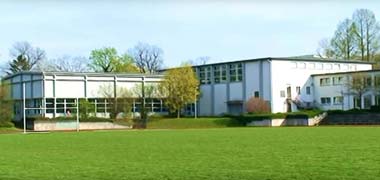
|
| Phillip-Holzman-Schule and athletic field
2014[15]
|
1959-60, then 10th-12th until it closed in 1995. The school's name was
changed to Frankfurt
American High School (FAHS) only in 1961-62, the
year after I left. When closed it was returned to the City of Frankfurt and
became the Philipp-Holzmann-Schule; it has since been considerably
remodeled, expanded, and improved. In April 2014 a former FAHS student
(Otis Pate, class of 1985) visited the Holzmann campus and posted a
rhapsodic
7-minute
video of it on Youtube (screen shot at left). By 2020, however, the
at-least-80-year-old
athletic field was sacrified to make way for another new school, the
Adorno Gymnasium (academic
high school), address: Miquelallee 160.
Junior High School...
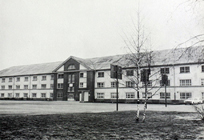
|
| Frankfurt Junior High School
|
Frankfurt (American) Junior High School opened in Fall 1959 at 381 Homburger
Landstraße at Drake Kaserne[
5,17] to relieve
crowded conditions at the high school and the elementary schools, taking
over 9th grade from the high school and 8th and 7th grades from the
elementary schools. It was convenient to residents in the Drake-Edwards,
Gibbs, and Betts areas but students who lived in the Farben building area
(Platenstraße, Hügel, Von Steuben) and elsewhere had to ride big olive-drab
Army buses every day. The junior high school closed in 1995, along with all
the other American military schools in Frankfurt. The building still exists
as of November 2021 and houses the
IKS Interkulturelle Schule
Rhein-Main, a state-recognized private vocational and preparatory
school.
Elementary Schools...
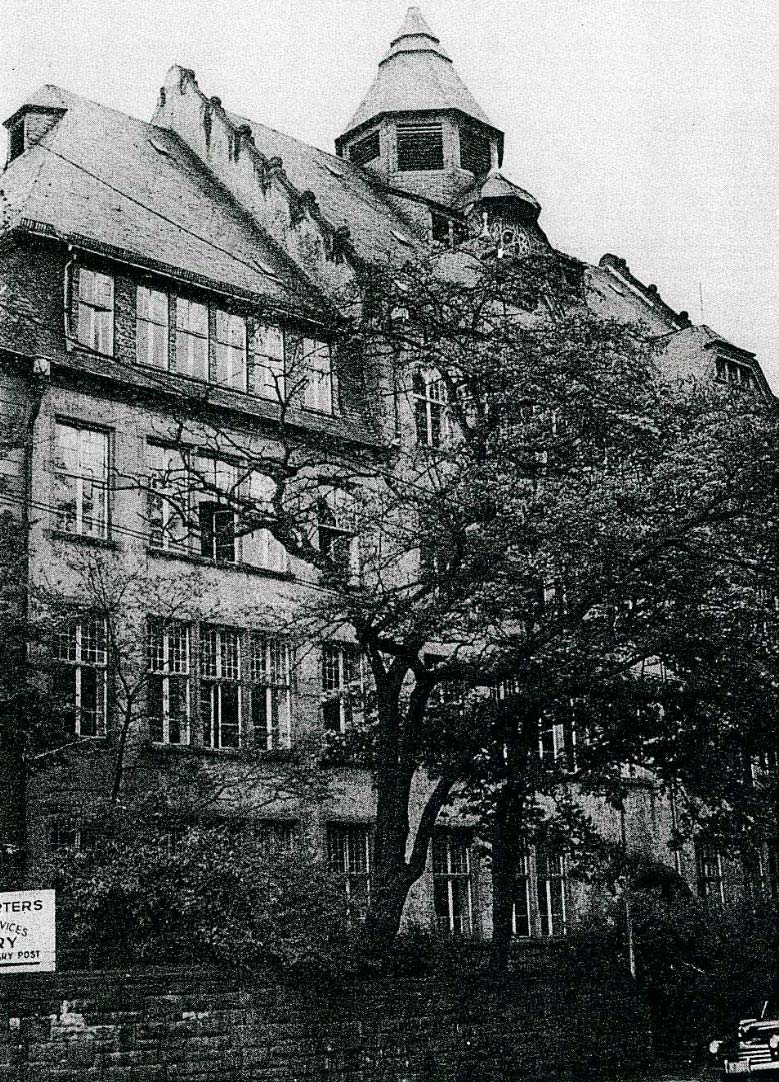
|
| Elizabethan School
|
The original Frankfurt Elementary School, the Elizabethan
School[
9,10] — in German
Elisabethanischschule — at Vogtstraße 35-37, was about half a
mile east of the Farben building. Founded in 1876 as a high school for
girls in another part of the city, it moved to Vogtstraße in 1908. In 1942
it was converted into a German military hospital. In 1945 it was
confiscated by American forces and opened in 1946 as a school for grades
K-8[
6,11]. It was in the Sperrgebiet, the
fenced-in American restricted area around the Farben building 1945-48
described
above. The school was returned to the
City of Frankfurt in 1954 and lives on today as the
Gymnasium
Elisabethenschule, a co-ed academic high school.
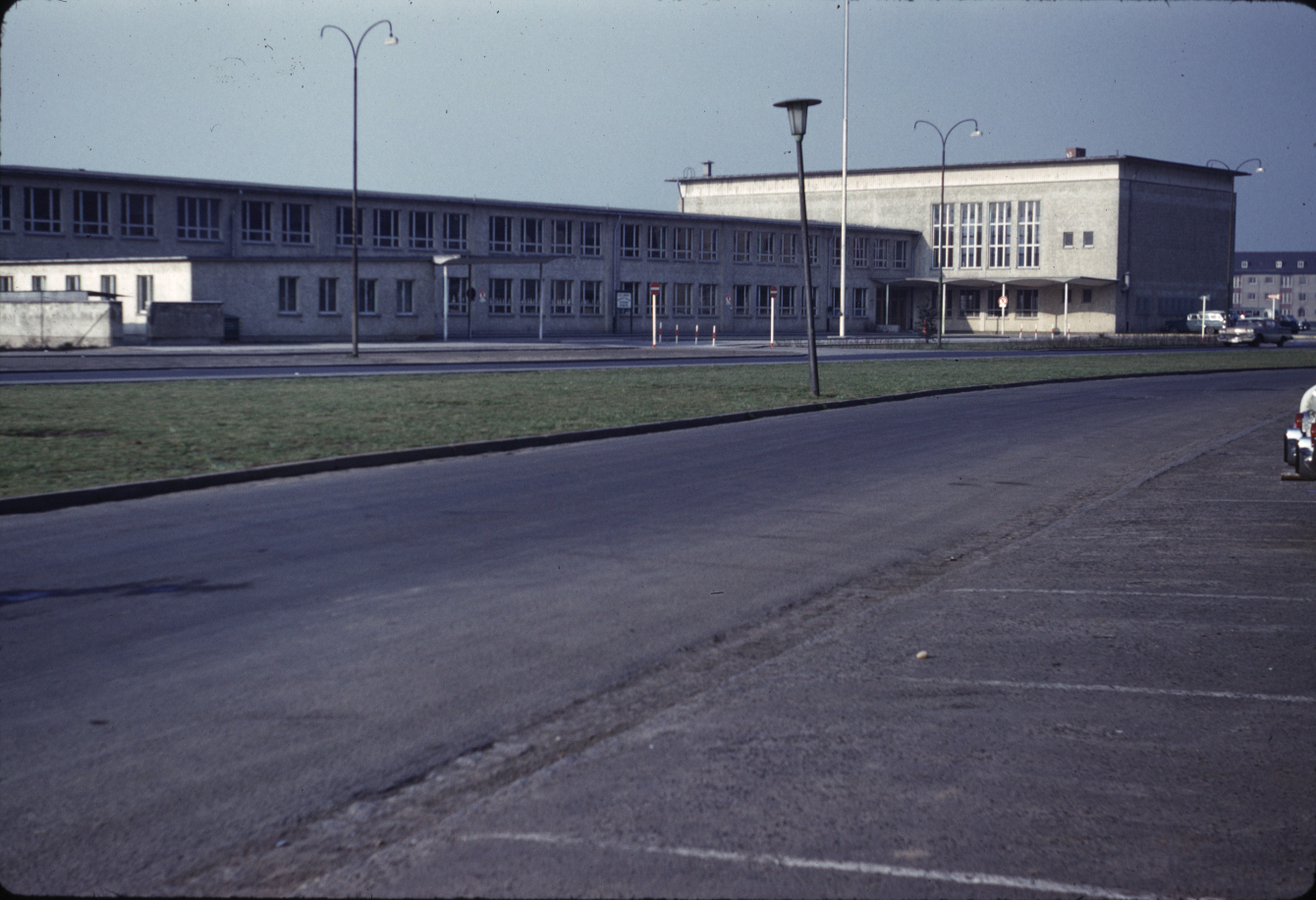
|
| Frankfurt Elementary School #1 in 1960
|
Frankfurt Elementary School #1 at 2201
Platenstraße[
5] (photo by my father) opened in
1953, as part of the same project that created the high school and the
Platenstraße, Hügel, and Von Steuben housing areas, serving grades
K-8[
6]. Students from areas such as Oberursel,
Bad Homburg, Höchst, Fischstein and Rödelheim were bused in daily.
Frankfurt Elementary School #2 (a.k.a. the Atterberry School) at 358
Friedberger Landstraße[
5] in the Betts housing
area near Atterberry Kaserne also opened in 1953[
6].
The city of Frankfurt was located in the US Army Northern Area Command
(NACOM), one of six Cold War commands in 1952-1965, covering a large part of
the American zone of Germany (which by then had also subsumed the French
Zone). In addition to its military role, NACOM "also act[ed] as landlord
and corner grocer, city administrator and recreation supervisor for the
complete community of servicemen, wives, children and civilians. Along this
line there are [as of 1963] 82 chapels, 51 service clubs, 71 libraries, 74
theaters, 69 bowling lanes, 70 gymnasiums and 602 other sports
facilities. In addition there are 72 education centers for the American
community plus 45 elementary and high schools with an enrollment of 33,000.
There are 72 housing areas and 100,000 troop barracks spaces to maintain
plus providing utilities for more than 200 separate installations. The 12
main posts directly under NACom are: Giessen, Frankfurt, Heidelberg,
Wuerzburg, Bamberg, Fulda, Hanau, Bad Kreuznach, Baumholder, Pirmasens,
Kaiserslautern and Karlsruhe. The 12 sub-posts are Mainz, Schweinfurt,
Darmstadt, Bad Hersfeld, Bad Kissingen, Wildflecken, Kassel, Gelnhausen,
Worms, Aschaffenburg, Kitzingen and Wertheim."[8]
References...
-
Der Frankfurter Reformschulversuch 1921–1930, Institut für Stadtgeschichte,
frankfurt1933-1945.de (accessed 23 November 2021).
-
Der Frankfurter Reformschulversuch 1930–1937, Institut für Stadtgeschichte,
frankfurt1933-1945.de (accessed 23 November 2021).
- Frankfurt
American High School, wikipedia.com (accessed 23 November 2021).
- Charles-Hallgarten
School Am Bornheimer Hang, architecture.eu (accessed 23 November 2021).
- Federal
Republic of Germany Post Report, US Department of State, U.S. Government
Printing Office, 0-281-540-2013, April 1979. Frankfurt am Main section:
pp.33-37. This is written for consular personel and their families, where
housing, school, and other policies might differ from those for military
families.
- Memories
of Frankfurt Elementary #1, compilation 1946-1995, American Overseas
Schools Historical Society, entry by Erika and Kurt Rothe
(aoshs.com, accessed 25 November 2021).
- DODEA's 75 Year
History, dodea.edu (accessed 25 November 2021).
- Ralph Bennington, "NACOM to Celebrate 11th Anniversary", Stars
& Stripes, 30 November 1963.
-
History of the Dependents School Service (DSS), Germany:
Those First Six Years (1946-1952), Department of Defense Education
Activity, dodea.edu (accessed 26 November 2021).
- The Dependents'
School Program of the U.S. Army, Europe, 1946–1956,
Headquarters, United States Army, Europe, Historical Division (1958),
118 pages (non-searchable PDF). Page 9 has the photo of the Elizabethan
School captioned "The Elizabethan School—first American elementary
school in Frankfurt and headquarters of the Dependents' School Service".
-
Elisabethenschule (Frankfurt am Main), second.wiki
(accessed 26 November 2021).
- Elisabethenschule website
(accessed 26 November 2021).
- Charles Hallgarten
Schule website (accessed 26 November 2021).
- Charles
Hallgarten Schule: Schulhaus (school building's history with photos,
accessed 26 November 2021).
- Video: Behind
Frankfurt American High School 2014, Otis Pate, Youtube, April 2014.
-
Host Nation Studies: An International Language and Culture Program for U.S.
Elementary Students in Overseas Schools, International Journal for the
Historiography of Education (IJHE) Jahrgang 4 Ausgabe 5, October 2014
(abstract). "In 1946, the first U.S. schools for military dependents opened
their doors in post-war Germany to provide education for children of
American personnel on foreign soil. The school system, originally known as
the 'Dependents School Service' (DSS), offered a special subject within
its curriculum: Native German teachers were hired to teach the language
and culture of the current host nation to U.S. elementary and
middle-school students."
- Yearbooks,
Frankfurt MS (formerly JHS) Archives, American Overseas Schools
Historical Society archives. Not a complete set, but they reveal that the
school had several Germans teaching German, and no other languages were
taught. The 1988 yearbook identifies the school as "Frankfurt American
Junior High School which is a Department of Defense, Dependent School
located on Drake Kaserne, Homburger Landstrasse 381, 6 Frankfurt/Main or APO
New York 09039-0005".
- "Who
Runs the Best U.S. Schools? It May Be the Defense Department —
Schools for children of military members achieve results rarely seen in
public education", New York Times, 10 October 2023.
The 1960 Artillery Accident at Grafenwöhr
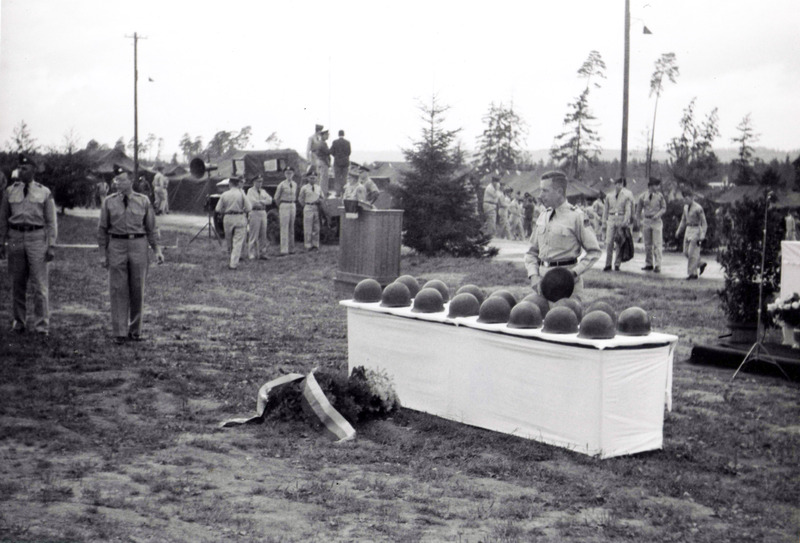
|
| Memorial Service 4 September 1960
|
The morning of Friday, September 2, 1960, an 8-inch Howitzer round crashed into
a 3rd Armored Division encampment at the Grafenwöhr tank range, killing 15
soldiers and wounding another 28, one of whom died later.
We were in school that day and it was announced over the PA system. The
fathers of many of the students were at Graf at the time, and when the
announcement was made the details were still not known. Everyone was
worried, scared, upset. I remember big silent crowds in the halls, I think
they must have let us out early so we could be with our families. Nine of
the dead were PFCs and probably not old enough to have kids in high school.
Three were sergeants (two of them SFCs) and could have been old enough but
their surnames don't match anyone in
the
1960-61 FHS directory. The rest
were SP4s and SP5s, and only one of them, Earl Johnson (an SP4, therefore
probably pretty young), had a surname also found in the directory (seven
times). In any case I don't remember that any FHS parents died, but there
were also 27 wounded (later I checked the list of wounded against the FHS
directory too, and no matches there either). Anyway there was deep anxiety
throughout the school for at least the whole day. The photo was taken by
SSG Lowell Fox of the 3rd AD, one of six sent in by his son Farley in
2008 (
see gallery)
(
decode Army ranks here).
References...
- Howitzer Overshot Kills 15, Injures 27 at Grafenwoehr,
Stars and Stripes vol.19 no.138, Saturday, 3 September 1960, page 1:
"Fifteen 3rd Armd Div soldiers were killed early Friday [September 2],
and 27 injured when an 8-inch howitzer shell with an incorrect powder
charge overshot its mark and landed in a camp area after a morning roll call
... The shell smashed into three tents occupied by soldiers. It tore
through one tent, exploded in the second, and sent fragments hurtling into
the third."
- Little-known
Grafenwoehr accident remains vivid to those who lived it, nearly 60 years
later, Martin Egnash, Stars and Stripes, 1 September 2018: "the
memory of that day lives on in the soldiers who were there. Retired
Gen. Colin Powell ... was one of them."
-
Tragedy at Grafenwoehr in September, 1960, 3rd Armored Division History
Foundation. Includes list of fatalities.
-
Artillery Accident of 1960:
The deadliest event in the history of the Grafenwoehr Training Area,
Johanna Pschierer, USAG Bavaria Public Affairs, 23 August 2018.
- 3rd
Armored Division, Cold War, Wikipedia (accessed 6 March 2021):
"Throughout the Cold War, the division headquarters company, the 503rd
Administrative Company, 503rd Adjutant General Company, and 503rd MP Company
were based at Drake Kaserne, with 143rd Signal Battalion and other support
units stationed across the street at Edwards Kaserne in Frankfurt
... subunits were based in other Kasernes [in Kirch-Goens, Butzbach,
Gelnhausen, Friedberg, and Hanau]", which are all places where FHS students
lived (see
directory).
For more information,
use this
Google search.
11th grade at Frankfurt High School and Pam Ives 1960-61
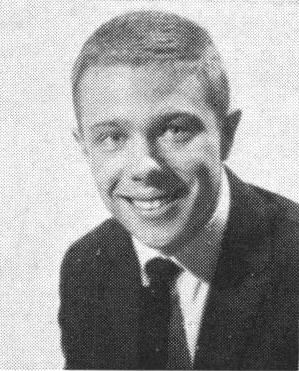
|
| 1961 yearbook photo
|
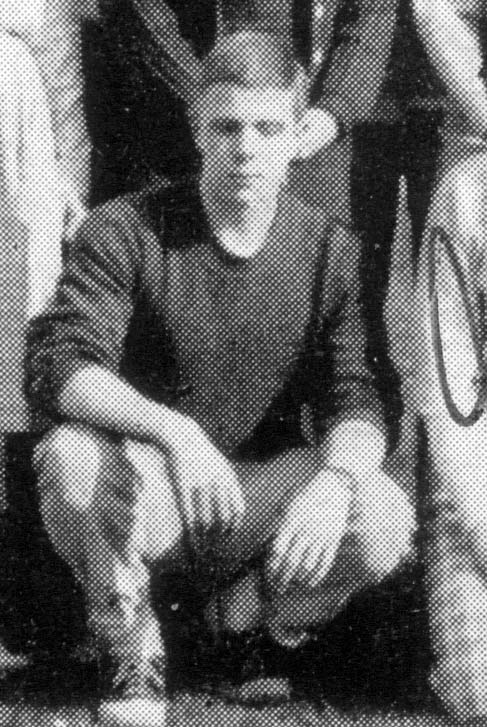
|
| Look: saddle shoes!
|
In 11th grade I made tons of new friends, started going out
on the town and drinking beer (and anything else I could get my hands on -
cognac, Schnapps, Jägermeister...), having all kinds of fun. Maybe too much
fun because now I recognize that, for the two full years 1961 and 1962 I
drank to excess almost every day. At first it was some combination of
dulling the stress and oppression of "life with father" and the fact that
drinking in Germany was easy, cheap, legal, fun, and everybody else was
doing it. Later, back in Virginia, where it was not legal, I still did it.
The compulsion faded after I left home.
I often felt that my time in high school in Germany was the best time of my
life. It was such an adventure to be in postwar Germany, still pockmarked
with the scars of war, still relatively poor, still full of people who had
been Nazis, and with Elvis stationed just down the street. And on the base,
to be among people of all races, nationalities and social classes after
living in racial and economic segregation up until then. And my first love,
Pam Ives.
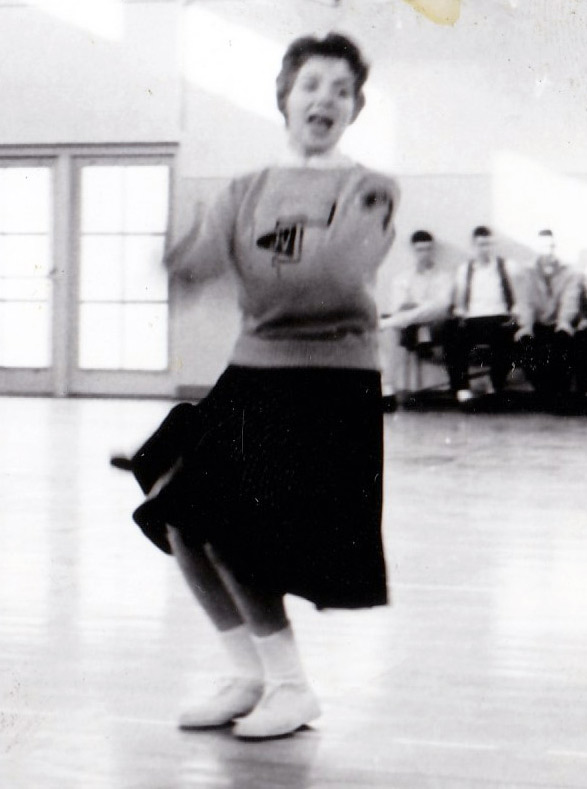
|
| Pam 1961 in FHS gym
|
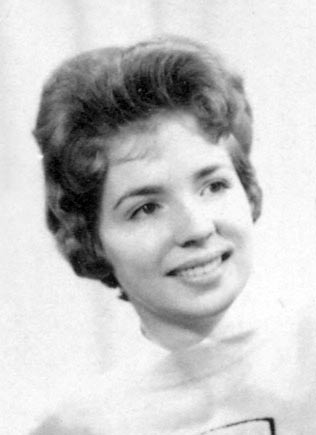
|
| Pam 1961
|
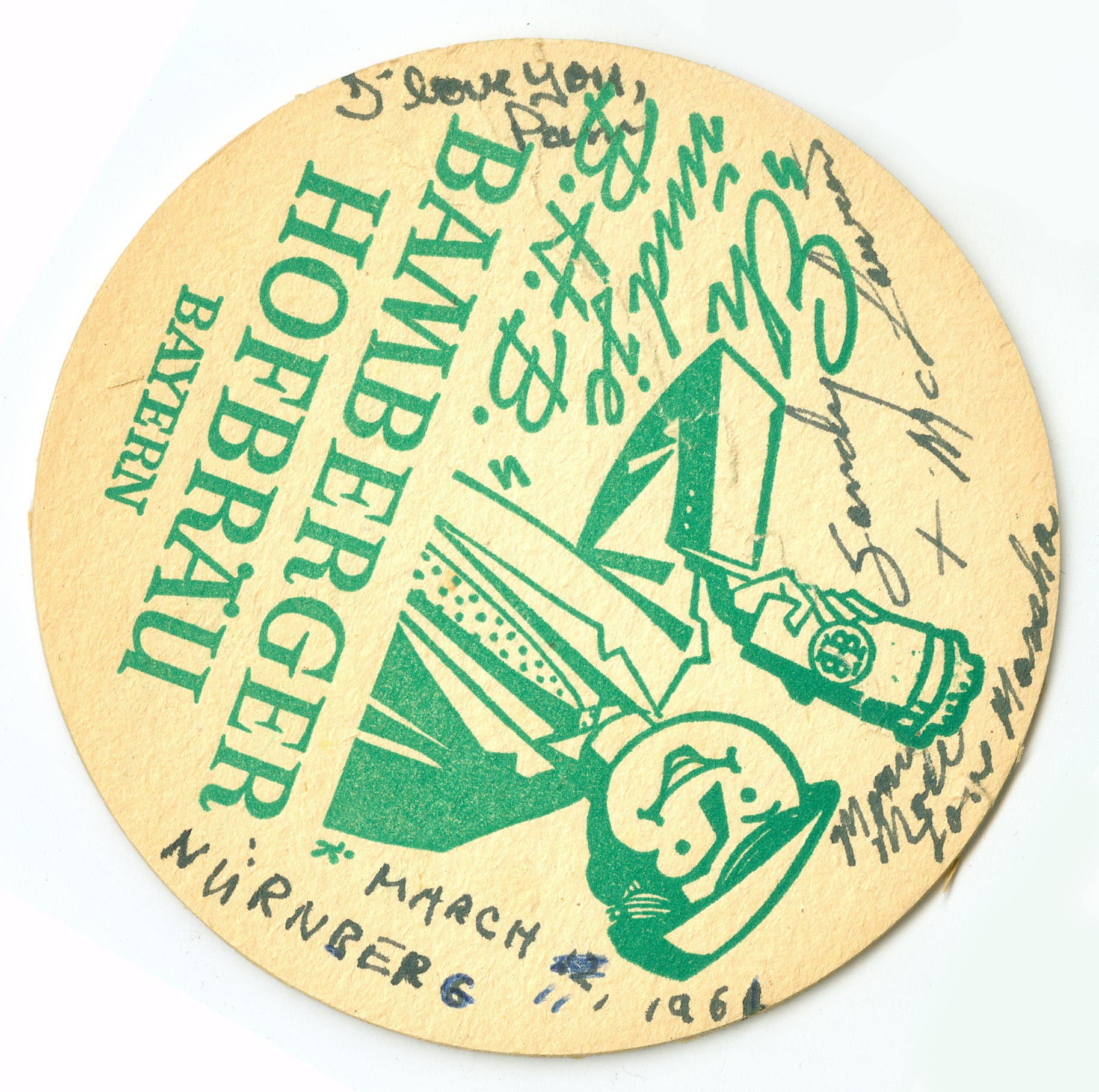
|
| Nürnberg souvenir
|
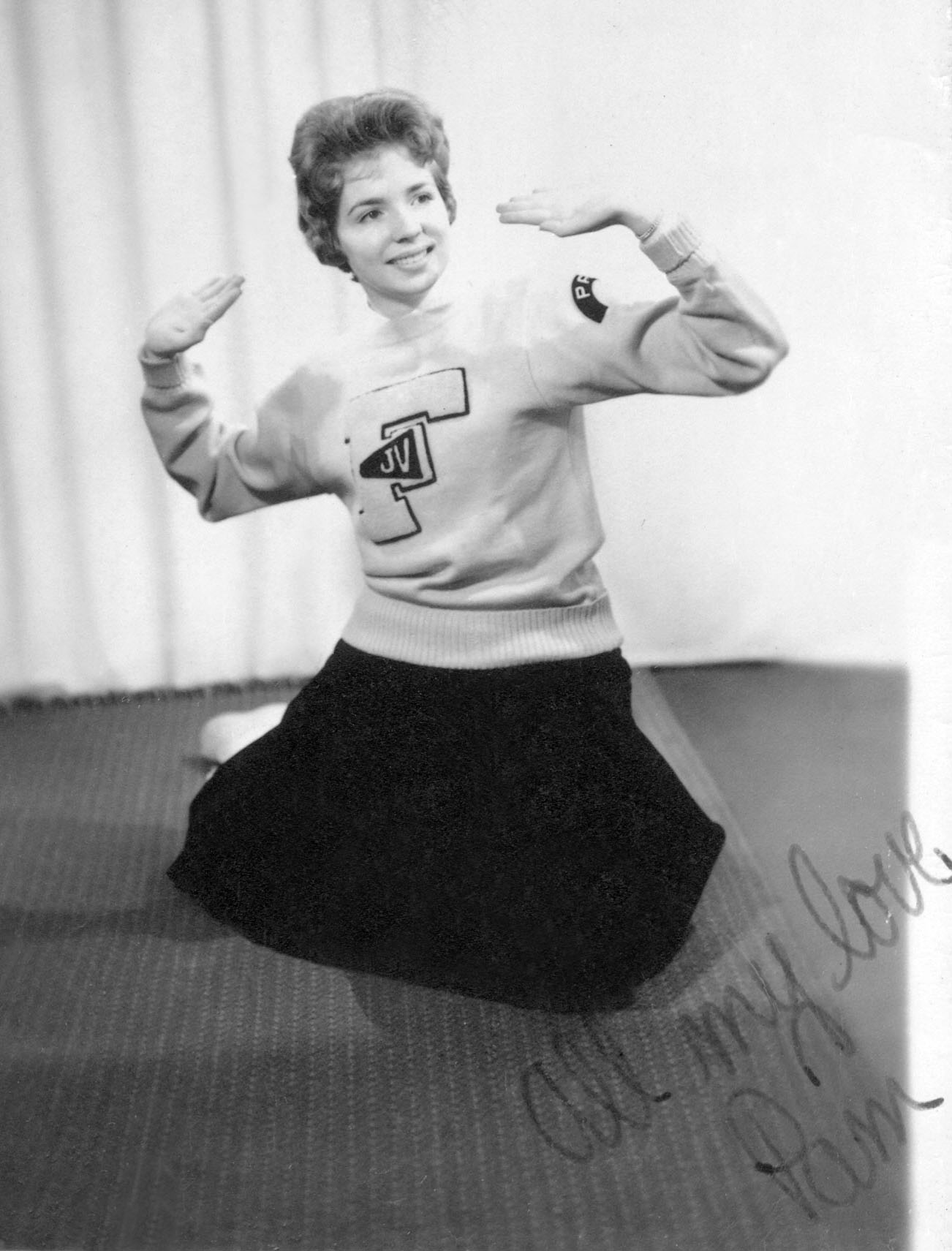
|
| Cheerleader portrait
|
Even in 11th grade I was still shy around girls and had only been on a
couple awkward dates. Pam was in 10th grade and a junior varsity
cheerleader. We clicked instantly, we were inseparable; we did everything
together, she was funny and she was fearless. And (as she says herself)
kind of smart-ass. We always enjoyed each other, never argued, no egos, no
drama, just romance, affection, and tons of fun. Everything was hilarious
to us. We went on long trips in Army buses to away-games in places like
Mannheim and Nürnberg (and then didn't bother going to the games), we went
up in the Taunus mountains and drank ourselves silly with no idea how
we would get back. I would go to basketball games just because she was
cheerleading. She came to the
radio station
with me on Tuesday nights sometimes. I'd meet her
in
HiCoG every morning, where
she lived, to walk to school together.
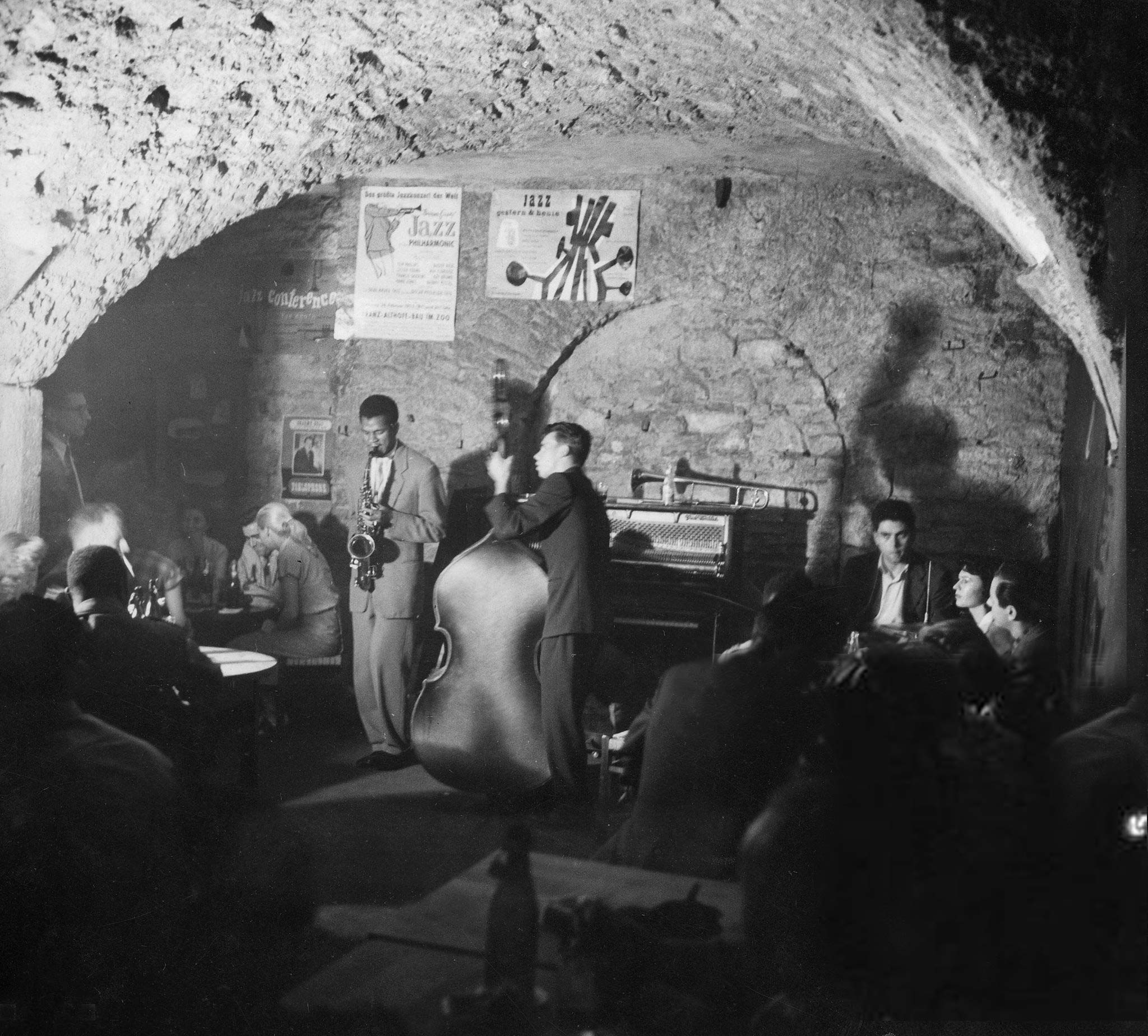
|
| Jazz Keller
|
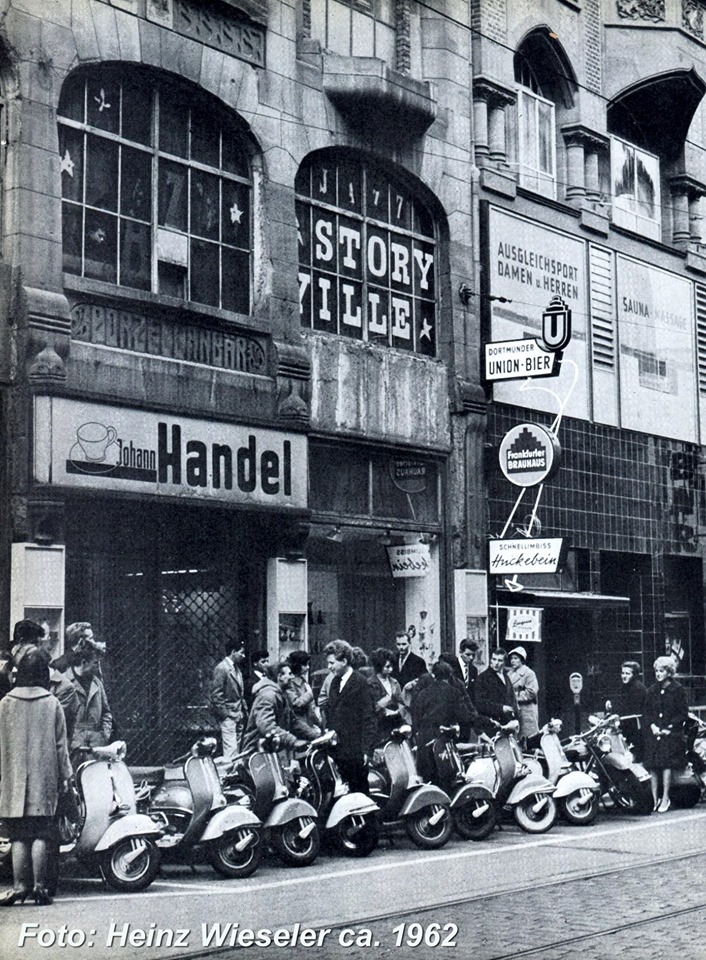
|
| Storyville
|
We wrote notes and slipped them into each other's hall lockers. We went to
the
Teen Club after school and then again after
dinner at home, when it became like a night club: lights low, dancing to the
jukebox or
a band... and everybody forming
little groups for sorties into the neighborhood or downtown —
restaurants, bars,
Storyville,
the
Jazzkeller — then coming
back to the Teen Club to share our adventures. Typical corny teenage stuff
but I was never so happy before or since (until recently).
About the Jazz Keller...
Heidi
Laird (author of Frankfurt
Kitchen) recalls "being able to sit up close to famous Jazz musicians
who had just given a concert at the Festhalle and were showing up at the
Jazz Keller to unwind and relax in an informal setting among friends. I
remember seeing Coleman Hawkins up close, and the Modern Jazz Quartet and
Ella Fitzgerald and Jerry Mulligan, all legendary, almost mythical. And
there were the
Mangelsdorff
brothers ... There was a wonderful bass player
named Oscar Pettiford who died within a year or two of my meeting him..."
The time we went to Nürnberg we wandered around the city and stumbled onto
the Luitpoldhain, which is where big annual Nazi rallies were staged from
1933 to 1938. Spooky!
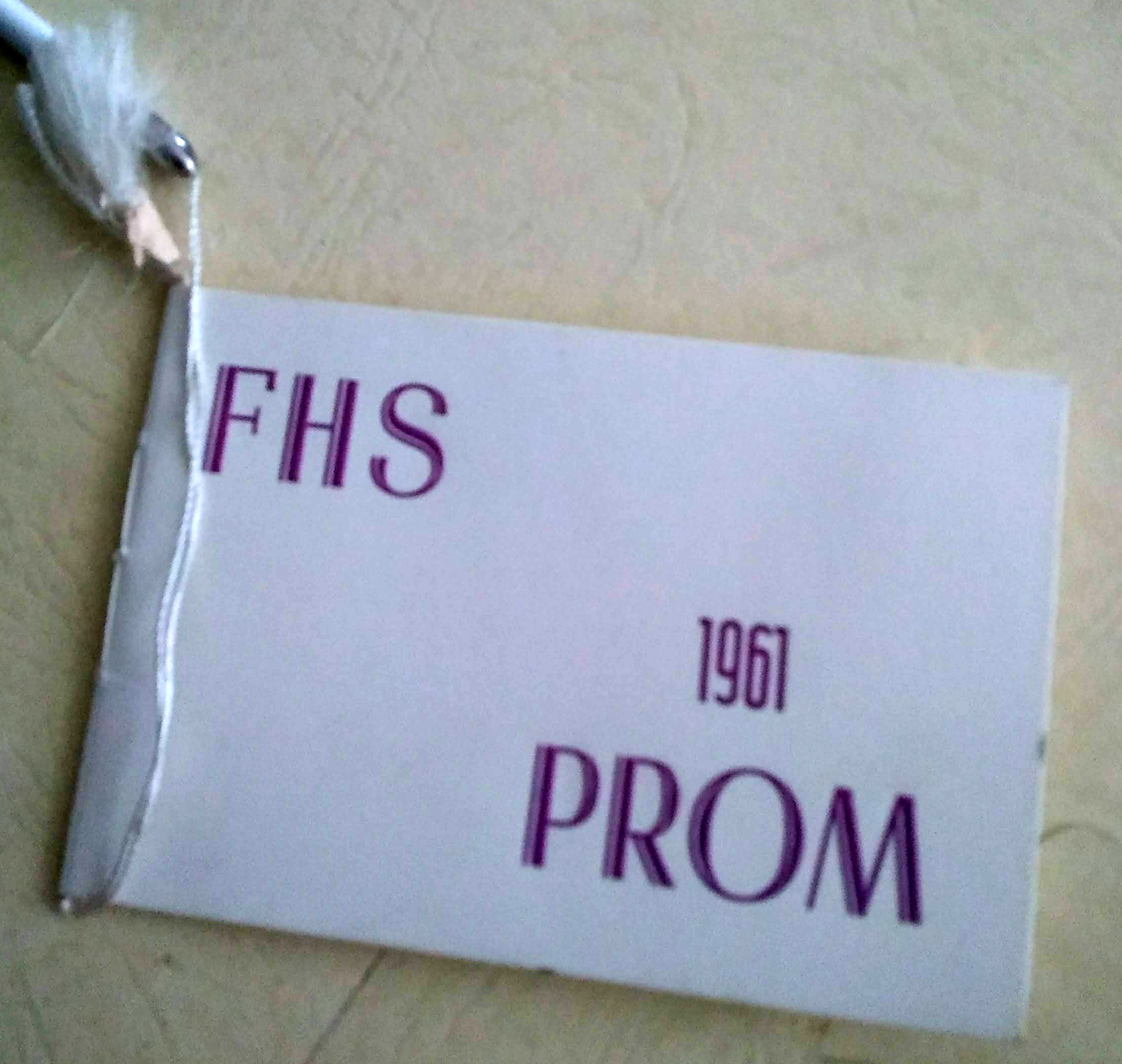
|
| Pam's Prom book 1961
|
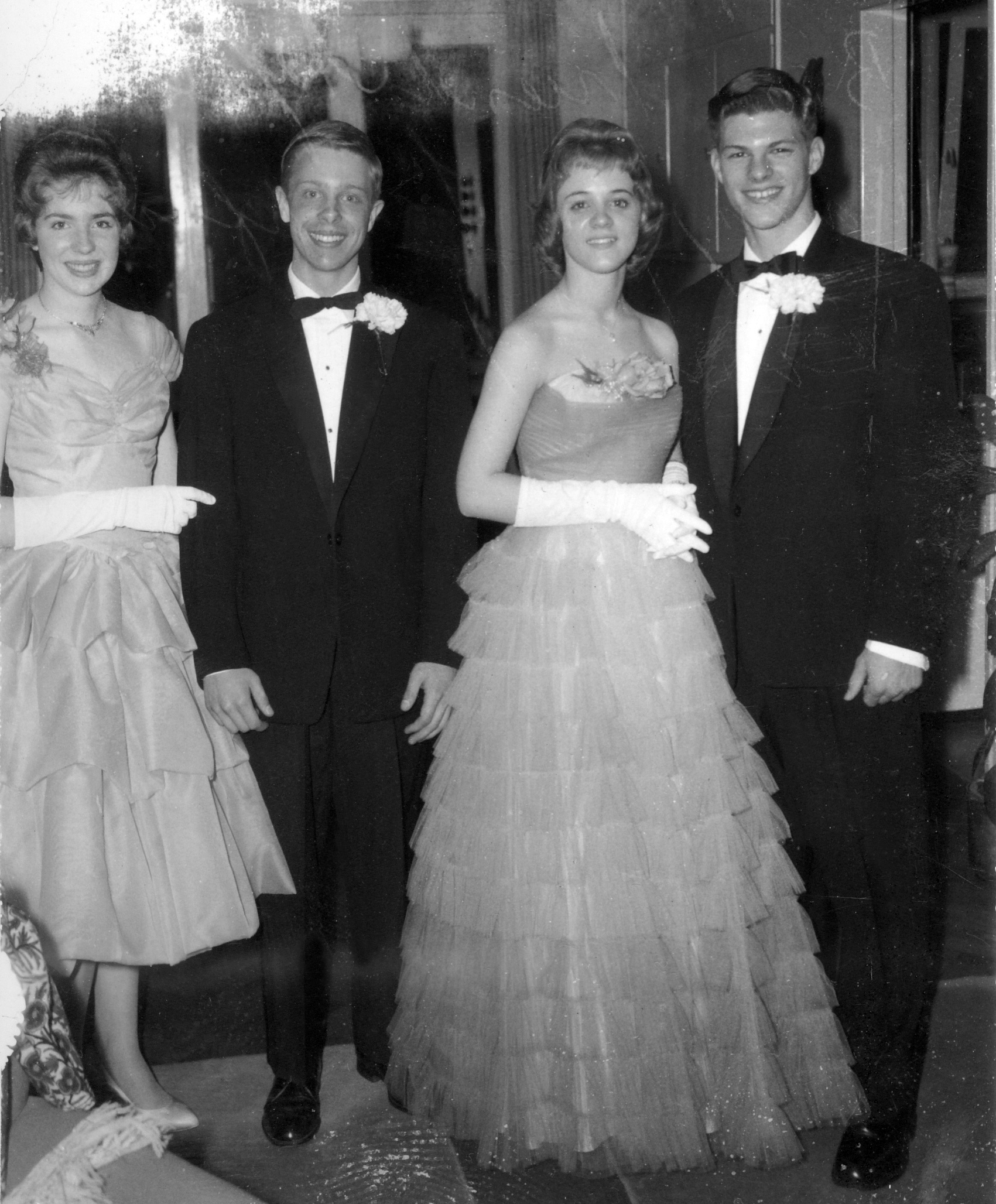
|
| Prom night April 1961
|
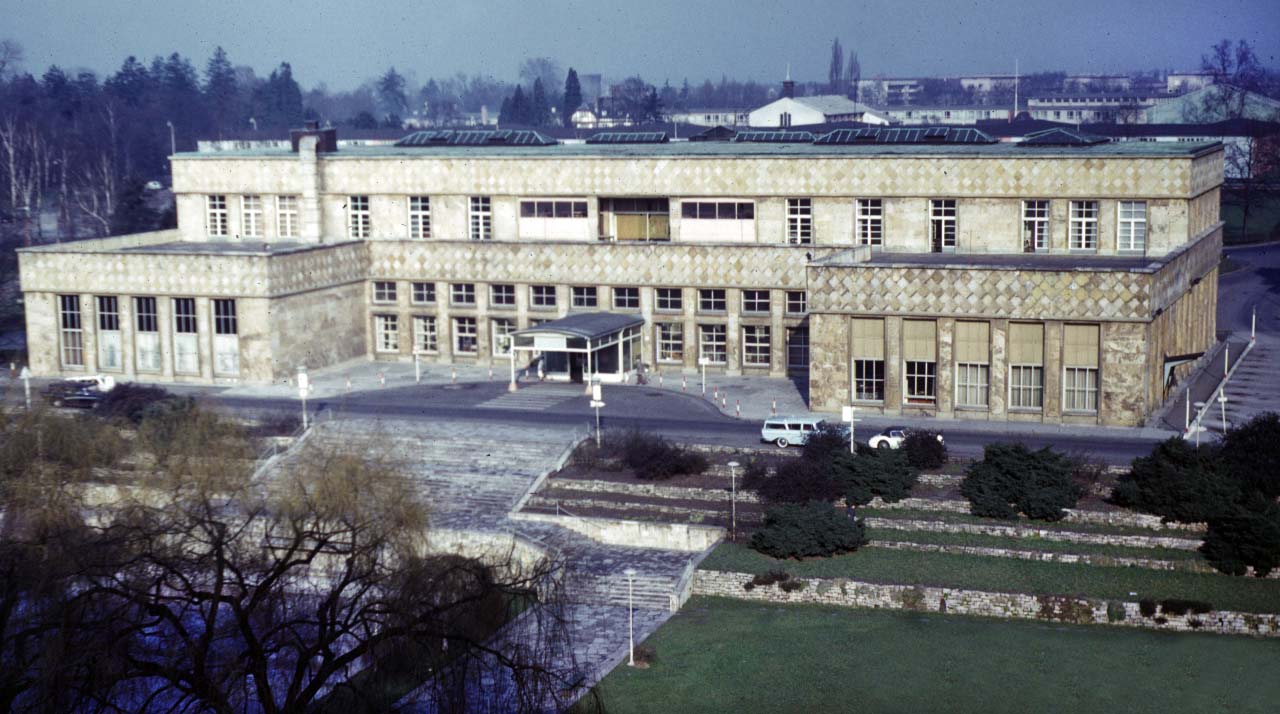
|
| The Casino Officers Club seen from I.G. Farben
|
You can see how ridiculously happy I was in the pre-Prom photo, in
which the other two are our friends Joe Martin and Genell Roberson, and in
which Pam is wearing the dress her Mom made for the occasion. Joe had his
dad's car that night.
The Prom was a very big
deal, held not in a crepe-paper-decorated school gym like most proms but
in the Officers' Club, the "Casino" part of
the
I.G. Farben
complex and probably a major "venue" for the Nazi elite during the war.
It was in the Casino's enormous, elegant ballroom. Honestly I don't
remember much about it (was there an orchestra? Was there food?) but Pam
and I danced and danced. And then as the Prom wound down we
drove to
a classy nightclub downtown with a stage show and had fizzy mixed drinks
with umbrellas instead of beer steins. We stayed out very late, culminating
in a Prom breakfast at 3:00 or 4:00am in the main Snack Bar, which they kept
open for us. It was a night like in a 1940s Hollywood movie. Pam is the
only one I ever danced with.
A Prom-related incident resulted in a bump in our relationship (my fault)
and before it could be fixed the school year ended and Pam's family rotated
back to the States, Pan Am Flight 73, Frankfurt to NYC, July 2, 1961 (just
after her 16th birthday). I would have been devastated by this if it were
not for the fact that we were being rotated too! A year prematurely, due to
a f**kup by my dad. I was devastated anyway; back in
Virginia I missed her like crazy. We stayed in touch by mail. A year
later she was thinking about college, wanted to major in psychology, wanted
to come to the east coast somewhere but said her grades weren't good and
probably she would wind up at Iowa State ("Anything! Anyplace! Just to
leave home!"), wished we could talk about it and do the things we used to
do, and closed by telling me not to do anything crazy like getting married
or... Joining the Army! But then her
father was transferred to Fort Leavenworth and I left
for UVA at the same time, and then the Army,
and then my Mom left my Dad and my Dad lost the house — the
address Pam was writing to — so we literally lost touch.
Forever. Or so it seemed!
Maps of Our Frankfurt
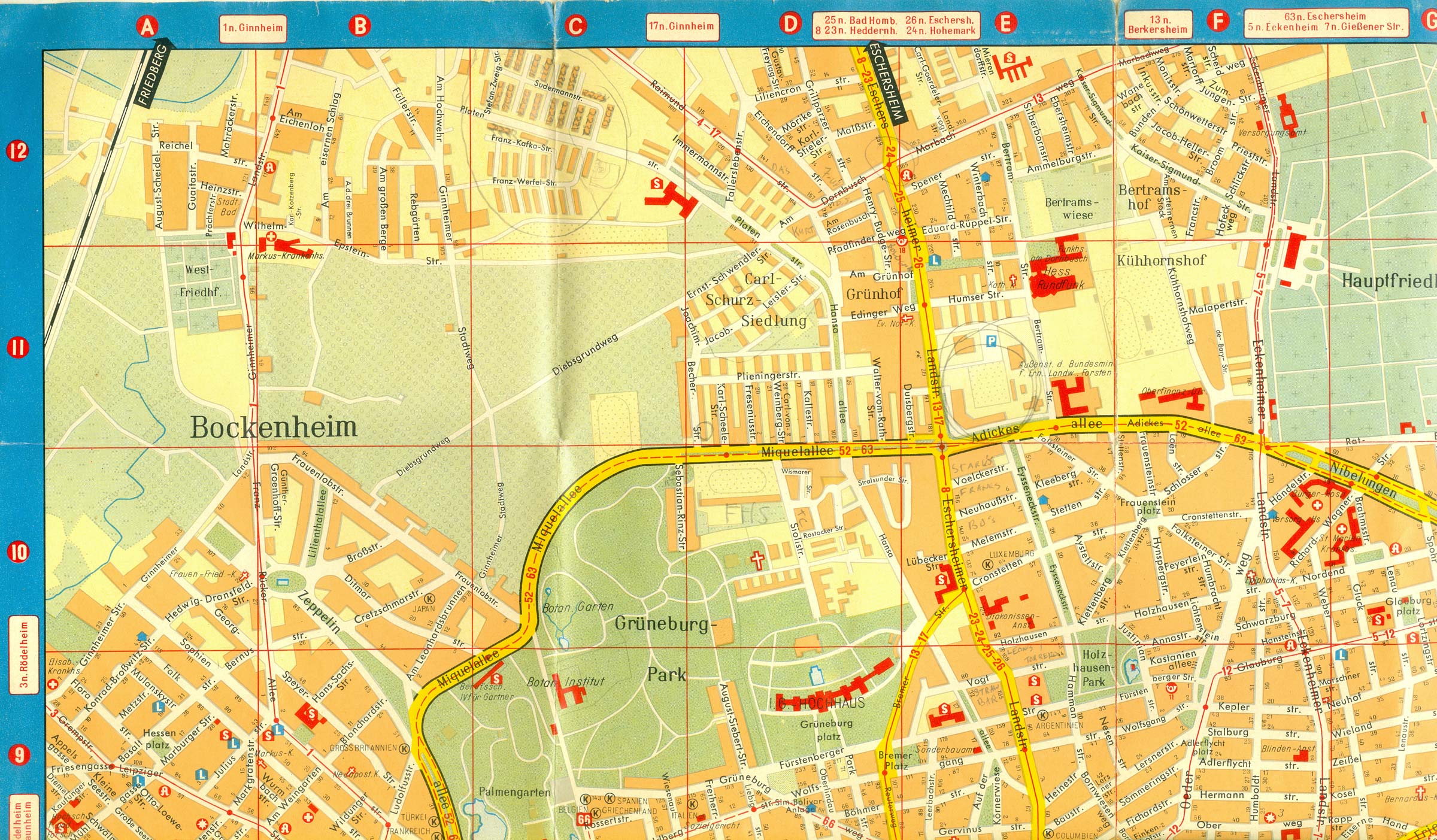
|
| Our part of Frankfurt in 1961:
Falk-Plan No.119, Falk-Verlag-Hamburg (undated but purchased in 1961)
- Click to enlarge
|
This is a piece of a German map from 1961 showing the part of Frankfurt we
inhabited. Click on it to see a full size version with notations in pencil
that I made at the time. At C-12 I have the Platenstraße housing area
circled and building numbers penciled in, plus I drew in the baseball field.
A line is coming out of 2231 showing the shortcut I used to take to school,
which is in the upper left of D-10 marked FHS, north-northwest of the IG
Hochhaus (I.G. Farben building, shown in red). The Teen Club (TC) is on
Siolistraße right across from the school. In E-11, WAC Circle at Adickes
Allee and Eschersheimer Landstraße is circled: the PX, Commissary, and big
Snack Bar. Pam lived in Carl Schurz Siedlung, a.k.a. HiCoG; her house is
circled by the lower left corner of D-11. Our hangouts are also indicated:
D'Angelo's is on Raimundstraße near Am Dornbusch indicated as DA's in D-12.
Kurt's (with the jukebox that
played Milord) is
at bottom center of D-12. Some other places I don't recall are indicated
there too: D.S. and 7-Up, then just below the lower right corner of the same
quadrant, the eat-in family Italian restaurant, Bologna. Then going south
on Eschersheimer Landstraße (E-10 and E-9) was bar country: Stark's,
Frank's, Bodega's (indicated as BO's), Leon's, Torrero, and finally the
Straw Bar. These were the places we could walk to.
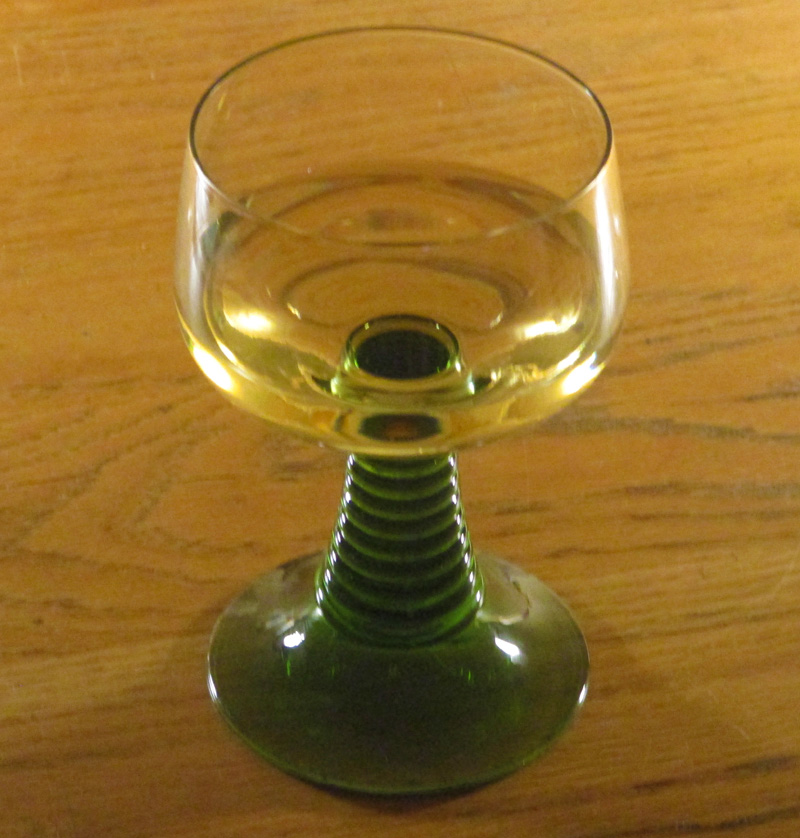 The Straw Bar, unlike the other rowdy dives just listed, was sedate and
civilized, owned by a nice lady. Nobody knows why we called it the Straw
Bar; it wasn't labeled that way. A bunch of us guys and girls would go
there and sit around a large round table playing Hearts all night, drinking
white Mosel Wein out of Römers (photo at left) rather than the customary
Bier in Steins, in deference to the ladies, much more refined and
sophisticated.
The Straw Bar, unlike the other rowdy dives just listed, was sedate and
civilized, owned by a nice lady. Nobody knows why we called it the Straw
Bar; it wasn't labeled that way. A bunch of us guys and girls would go
there and sit around a large round table playing Hearts all night, drinking
white Mosel Wein out of Römers (photo at left) rather than the customary
Bier in Steins, in deference to the ladies, much more refined and
sophisticated.
We also frequented some other places not on the map, e.g. in Ginnheim. The
next map shows the hangouts we went to by trolley.
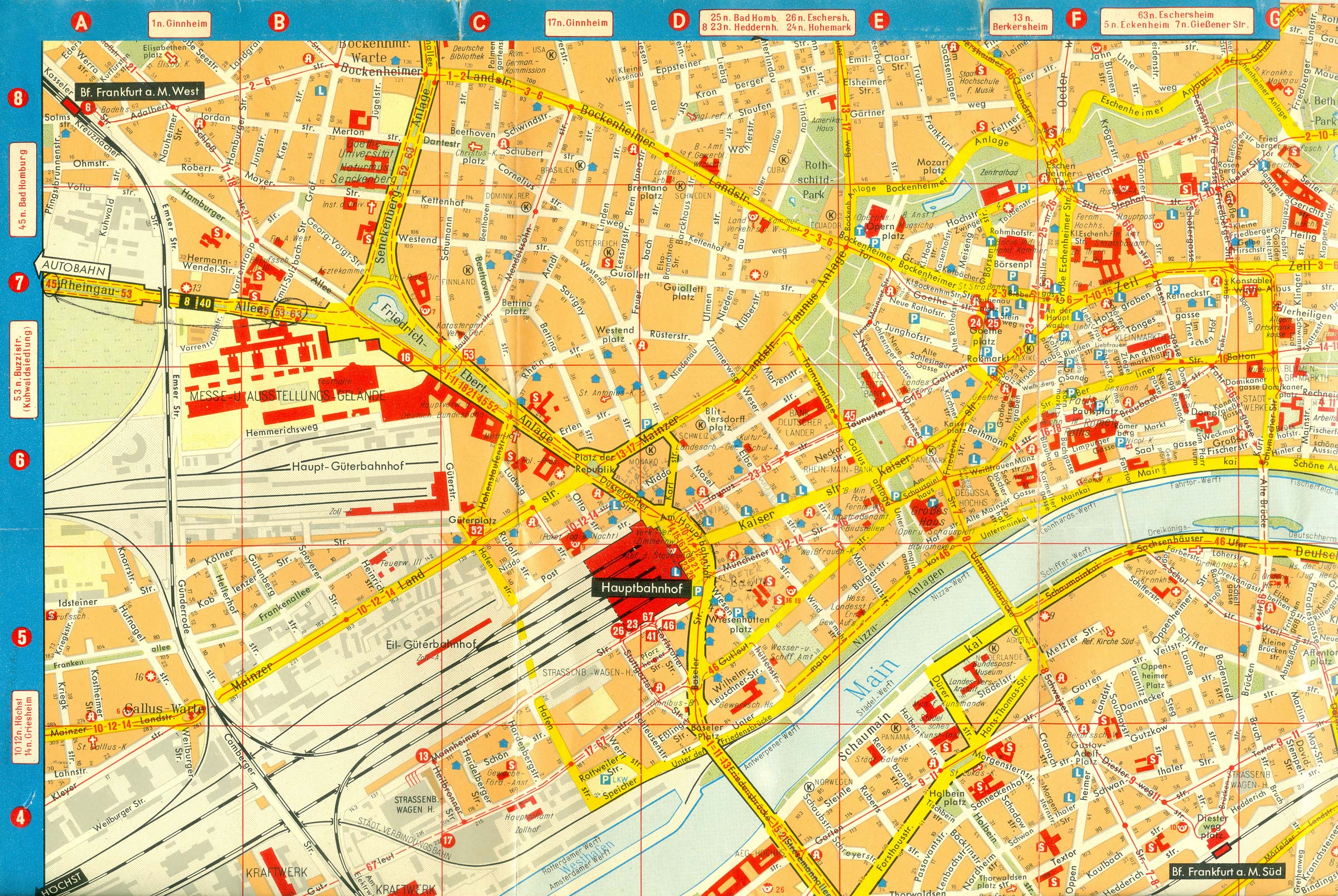
|
| Frankfurt Bahnhof
area in 1961 - Click to enlarge or
CLICK HERE
to see the whole map (big).
|

|
| Ristorante Santa Lucia 1961
|
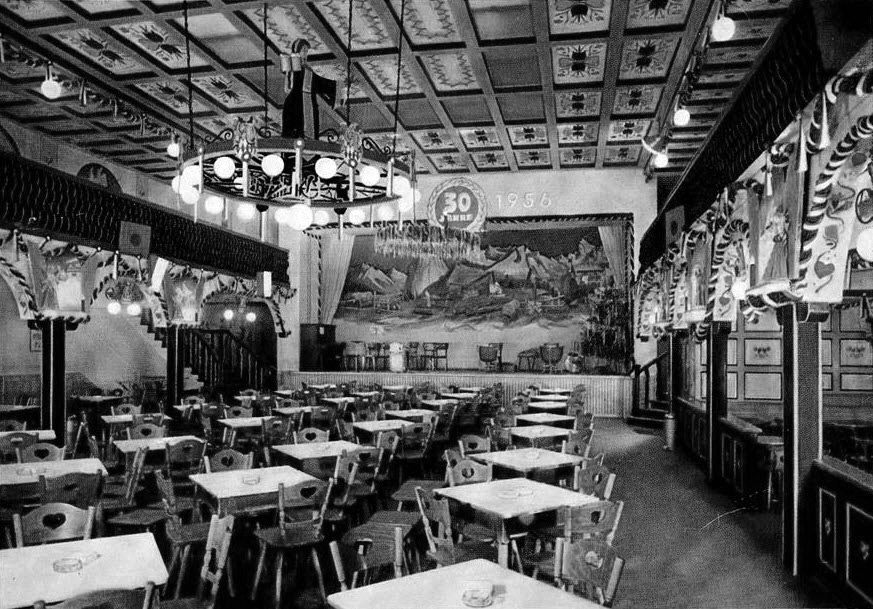
|
| Maier Gustl's 1956
|
This is another part of the same map that shows the Hauptbahnof area,
directly accessible by Straßenbahn Nº17. Various hangouts are indicated
near the Bahnhof (C-D 5-6):
Maier Gustl's on
Münchener Straße (a huge and rowdy Bavarian beer hall complete with Oompah
band), and next to it
Santa Lucia (Italian
grotto restaurant up a flight of stairs), Maxim's (which I don't remember).
"Little Maier Gustl's" was as quiet and sedate as the big one was loud and
chaotic and it had the best Ochsenschwanzsuppe.
The yellow area in front of the red Hauptbahnhof was the
free-kill zone
where all the trolley lines met up in a huge chaos and you could transfer
from one line to another if you were lucky.
Other things to do in Germany
Besides drinking in bars? On base, there was every conceivable kind of
recreation for us, either free or very cheap — a movie theater
(25
¢), game rooms, a roller rink, the
post library, craft shops, music rooms (where you could check out any
musical instrument and practice on it), libraries, athletic fields, judo
classes, bowling alleys, a baseball team (the Vikings), the Teen Club, plus
a huge selection of after-school activites... No end of fun. And to top it
off, we were in Germany! So there was even more fun to be had off base...
We could go to nearby Grüneburg Park or ride all over the city on the
trolley, all the way to the Taunus mountains for pocket change, go swimming
at the German pool in Oberursel (swimming was the only amenity
not found on base).
The Platenstraße area in Frankfurt was like Smurf Village; everybody lived
in one place and it was just a couple blocks from the high school and main
PX. When you walked to school in the morning you'd bump into all your
friends. You could go outside any time, around the corner to the ball field
bleachers (a popular hangout) or a couple more blocks to the Teen Club and
all your friends would be in one of those places or the other. We'd just
hang out or decide to go somewhere together, there was no end of escapades
we could have in postwar Germany.
Plus there were part-time jobs for teenagers, bagging groceries in the
Commissary for tips, setting pins in the base bowling alley for 10 cents a
frame, and working the concession stand at the movie theater. In those days
bowling alleys and pool halls were everywhere. I never bowled much, but I
played pool quite well, starting in the Teen Club up through Army discharge,
six years of solid pool playing. After that I think I played pool 3 times
total, once with Granpa who used to be a pool hustler (I did pretty well,
but he won of course — this was at the marina
in Kinapic).
The Teen Club
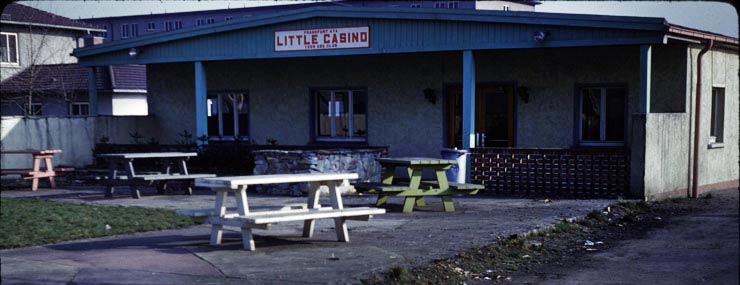
|
| Frankfurt Teen Club 1960 looks like a dump but inside it was magic
|
At the
Teen Club, one room had a grill with
hamburgers and french fries and a soda fountain, with tables and chairs and
a nickel jukebox with good music in it. At night the lights were turned
down low for dancing. The songs that take me right back there
(mid-1961):
Blue
Moon by the Marcels,
Mother In Law by
Ernie K. Doe,
Chain Gang
by Sam Cooke,
This is Dedicated to the One I Love by the Shirelles,
Gee Whiz by Carla
Thomas,
Who's Loving You by
the Miracles, and
Suddenly There's A
Valley by The Drifters.
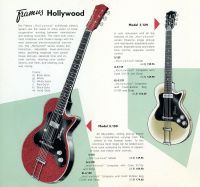
|
| Framus Hollywood 1958
|
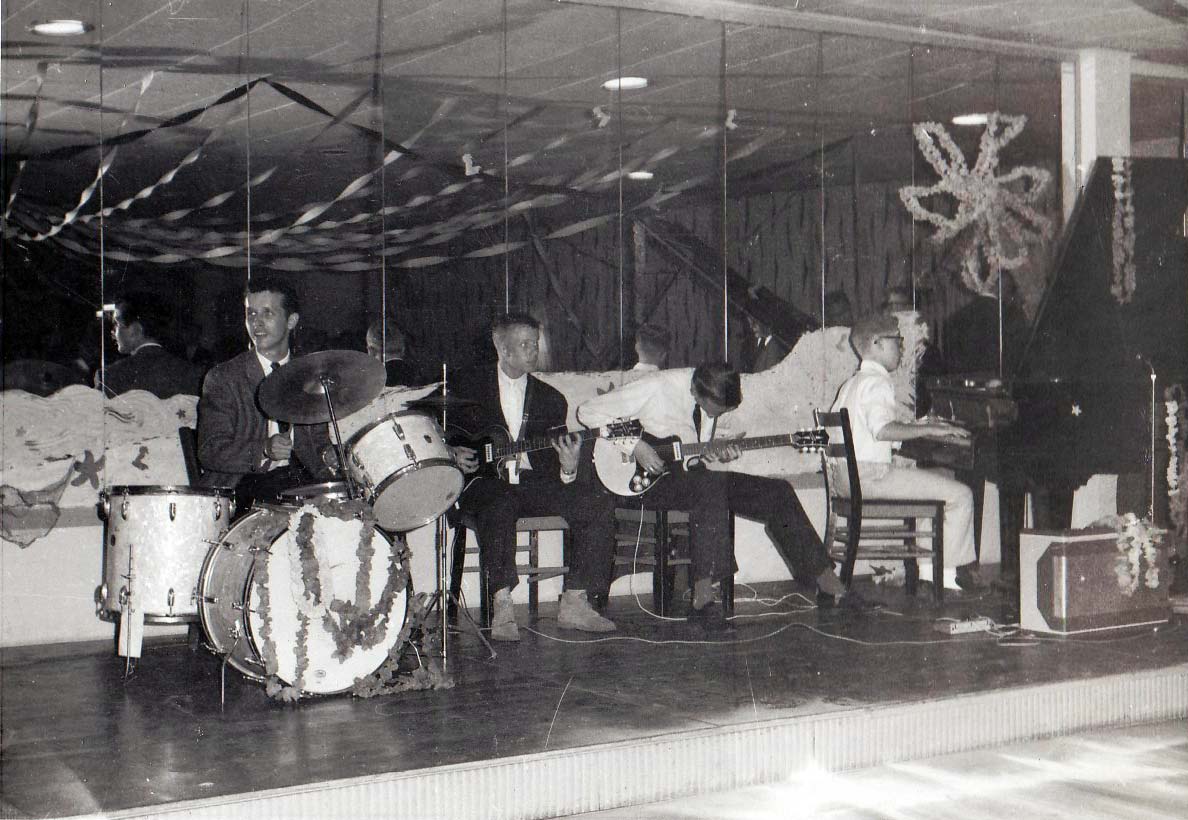
|
| Teen Club band 1961
|
Meanwhile, back in the Teen Club there was also a stage
where
my first rock band used to play for
evening dance parties. I played a German electric guitar, a red 1958 Framus
Hollywood (the one on the left in the color picture) that I got at
Musik-Hruby on Marbachweg in Dornbusch, the same street where Anne Frank was
born in 1929 and lived as a little girl... In 1961 the Teen Club was
totally unsupervised, the only adults there were the German ladies who ran
the soda fountain and grill. We'd go out drinking in bars, come back to the
Teen Club, go out again, come back... The way I remember it, this was just
about every night. For the record, everybody's favorite local spot for
drinking and eating was D'Angelo's, a tiny hole-in-the-wall pizza place on
Raimundstraße (just on the edge of the American housing complex), run by
Marco and patronized exclusively by Frankfurt High students (as opposed to,
say, GIs or Germans). Marco's pizza was the best I ever had in my life (Pam
says it was strange). It cost one Mark per slice, and he'd also make a
custom pie in any size at all... decades before anyone had heard of a
"personal pizza".
Elvis at the Teen Club?
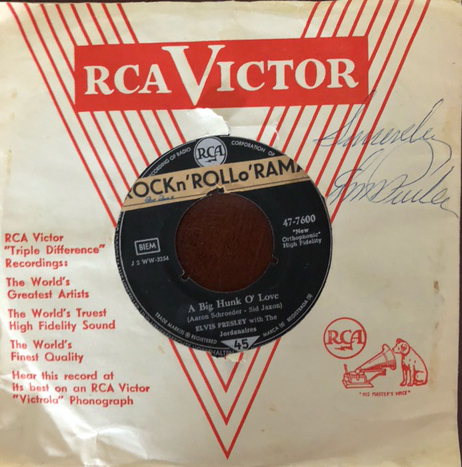
|
| Autographed Elvis record
|
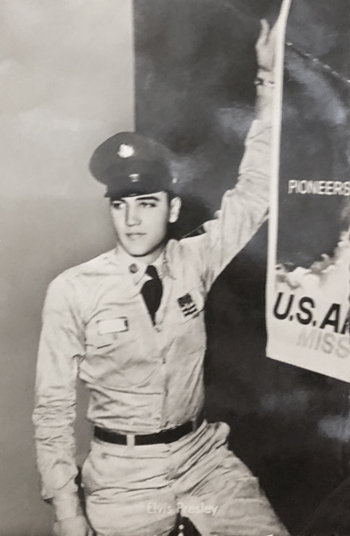
|
| Postcard front
|
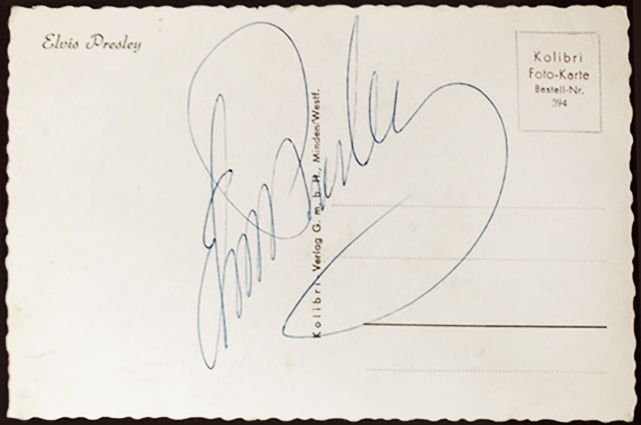
|
| Autographed postcard back
|
In November 2021 I had email from a person who was in Frankfurt 1958-1961,
about the time as me; she said "I was particularly interested in your
memories of the teen club. Although I never actually got to go there, I had
an older sister in high school (graduated in 1959 I think) who spent a lot
of time there. In fact, my stepfather was a volunteer there. I have in my
possession a 45 RPM record in its jacket, and a post card photograph of
Elvis, both signed by him. My recollection is that he actually visited the
teen club at least once, which is where she obtained his autographs. My
sister is deceased, so I can’t ask her. Do you have any memory of one or
more visits by Elvis? Although I liked some of his music and movies as a
teen, I was never really a fan." I don't remember but if any readers do,
please let me know! The record, "A Big Hunk 'O Love", was released in 1959,
about a year before my Teen Club days. The postcard photo was taken before
November 27, 1958, when Elvis was promoted to PFC. He made SP4 on June 1,
1959, and Sergeant E5 February 11, 1960, and was one of those ranks when he
recorded the record. He was discharged March 5, 1960.
Armed Forces Network
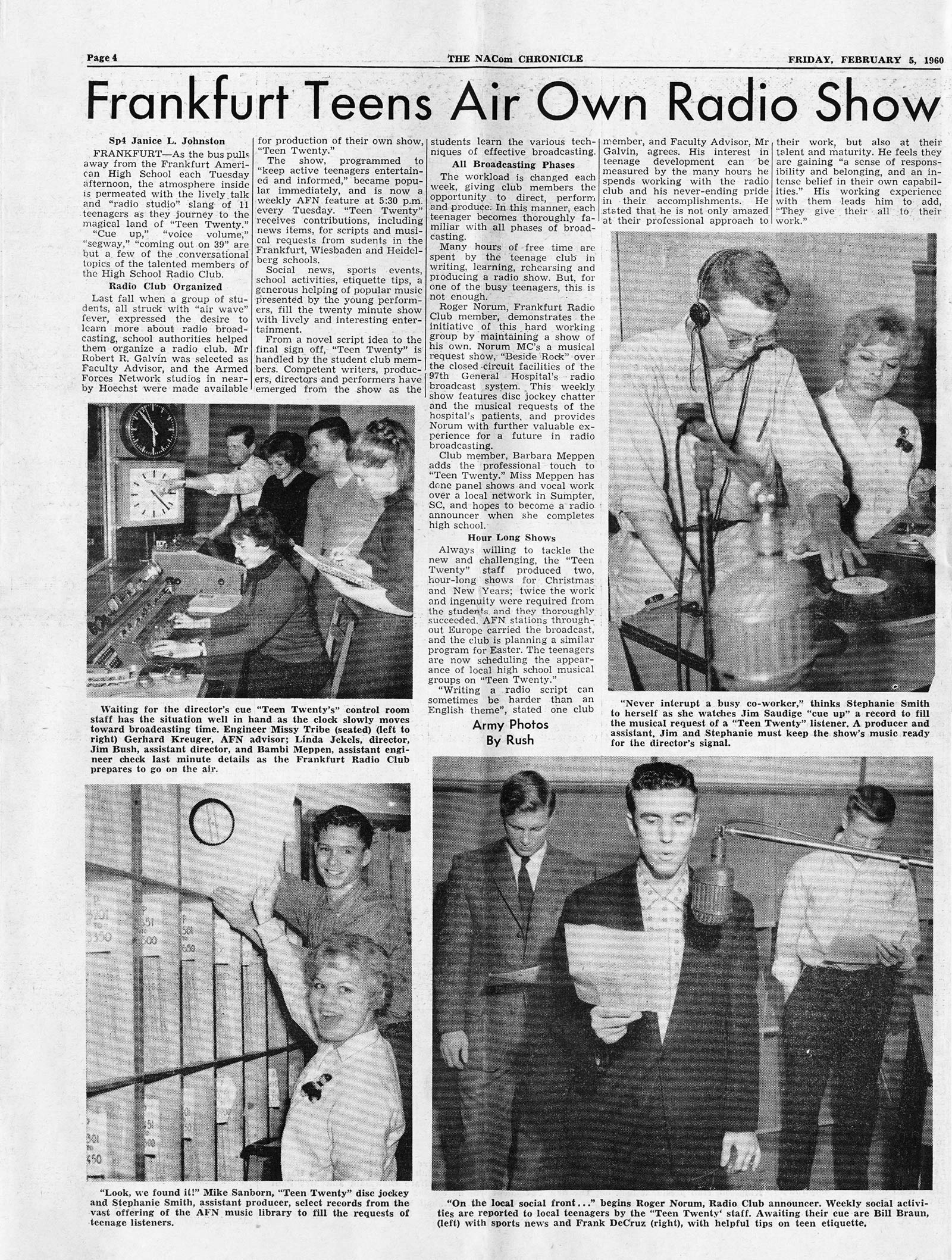
|
| NACOM Chronicle 1960
|
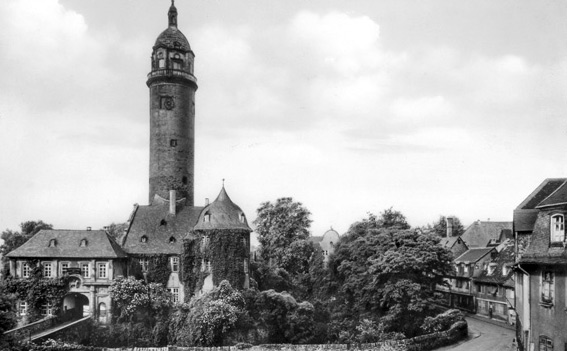
|
| Höchst Castle - home of AFN Frankfurt
|
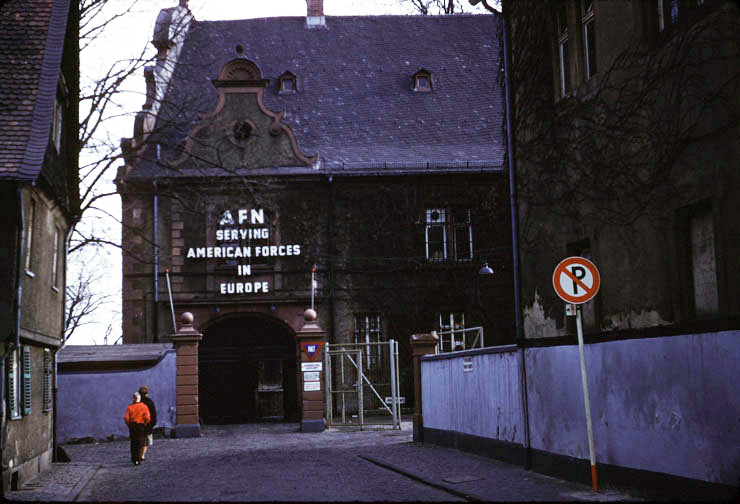
|
| AFN entrance with Dennis and Mom
|
Bob Engs
was in the Radio Club at school (and also the president of it
of course) and convinced me to join in 10th grade (1959-60). We had a
weekly show, "Teen 20", on AFN Frankfurt, at the time the most powerful
radio transmitter on earth at 150,000 Watts. It was kind of a silly show
but the experience was magical. The station was in an actual 12th-century
castle in Höchst
(
Schloß Von
Brüning); every Tuesday after school we'd ride in a big olive-drab Army
bus, about 12 of us. Everybody would take turns in each job: engineer,
director, announcer, writer, sports news, DJ... So, for example if I was
the sports reporter I'd have to go to the games and take notes, even away
games in Heidelberg, Karlsruhe, Mannheim, Wiesbaden... If I was DJ I had to
know how to cue records and segué from one to another while talking, watch
the sound levels, making sure there was never any "dead air", and finish
exactly on time, cuing the closing
theme:
Sleep
Walk by Santo and Johnny. The real AFN staff, merry-prankster
enlisted men who had worked in radio before they were drafted, taught us
everything. We had sound-proof studios with director's booth,
super-expensive Telefunken microphones, control consoles, and 16-inch
turntables, it was unbelievable amounts of fun.
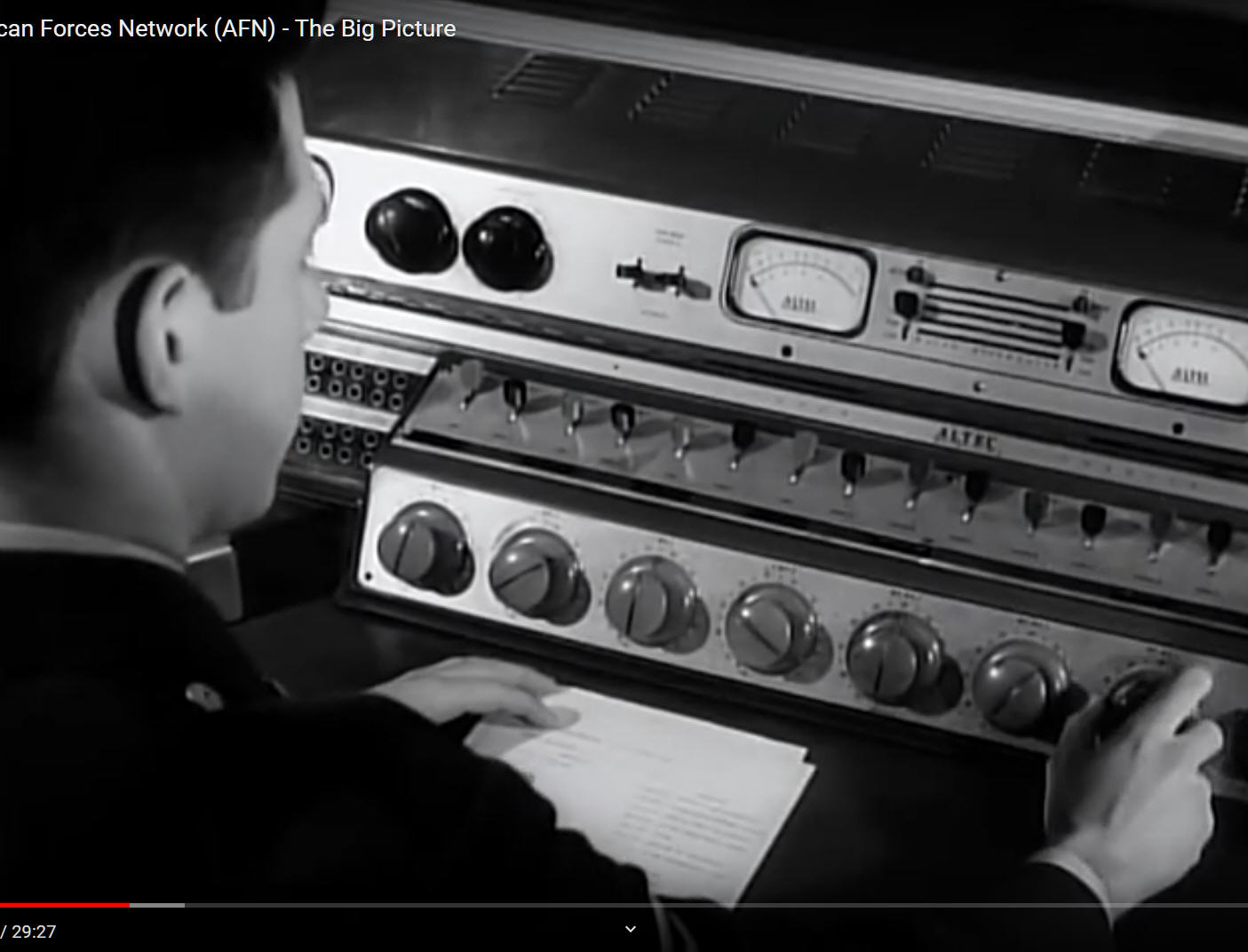
|
| AFN console
|
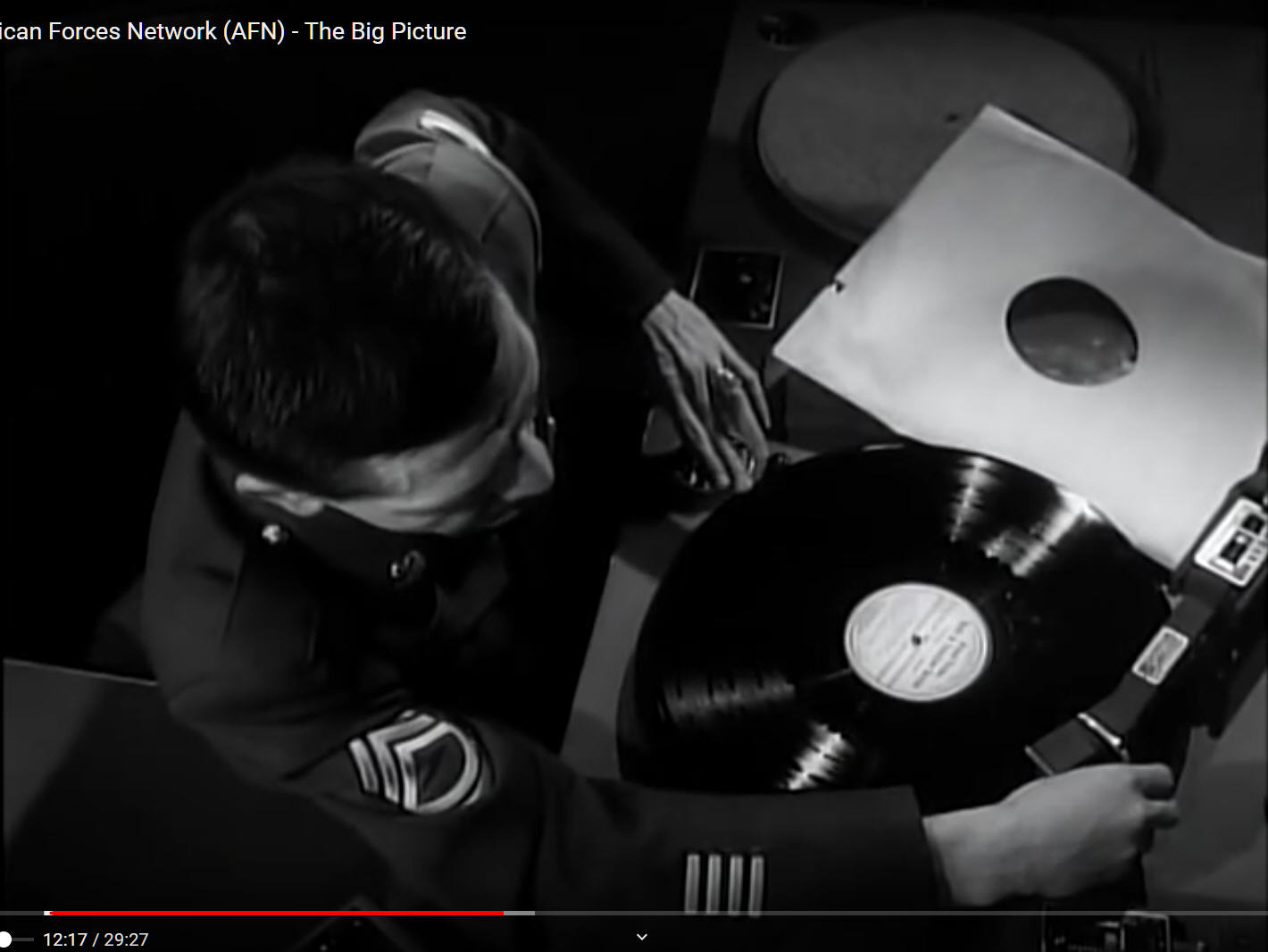
|
| AFN 16-inch record
|
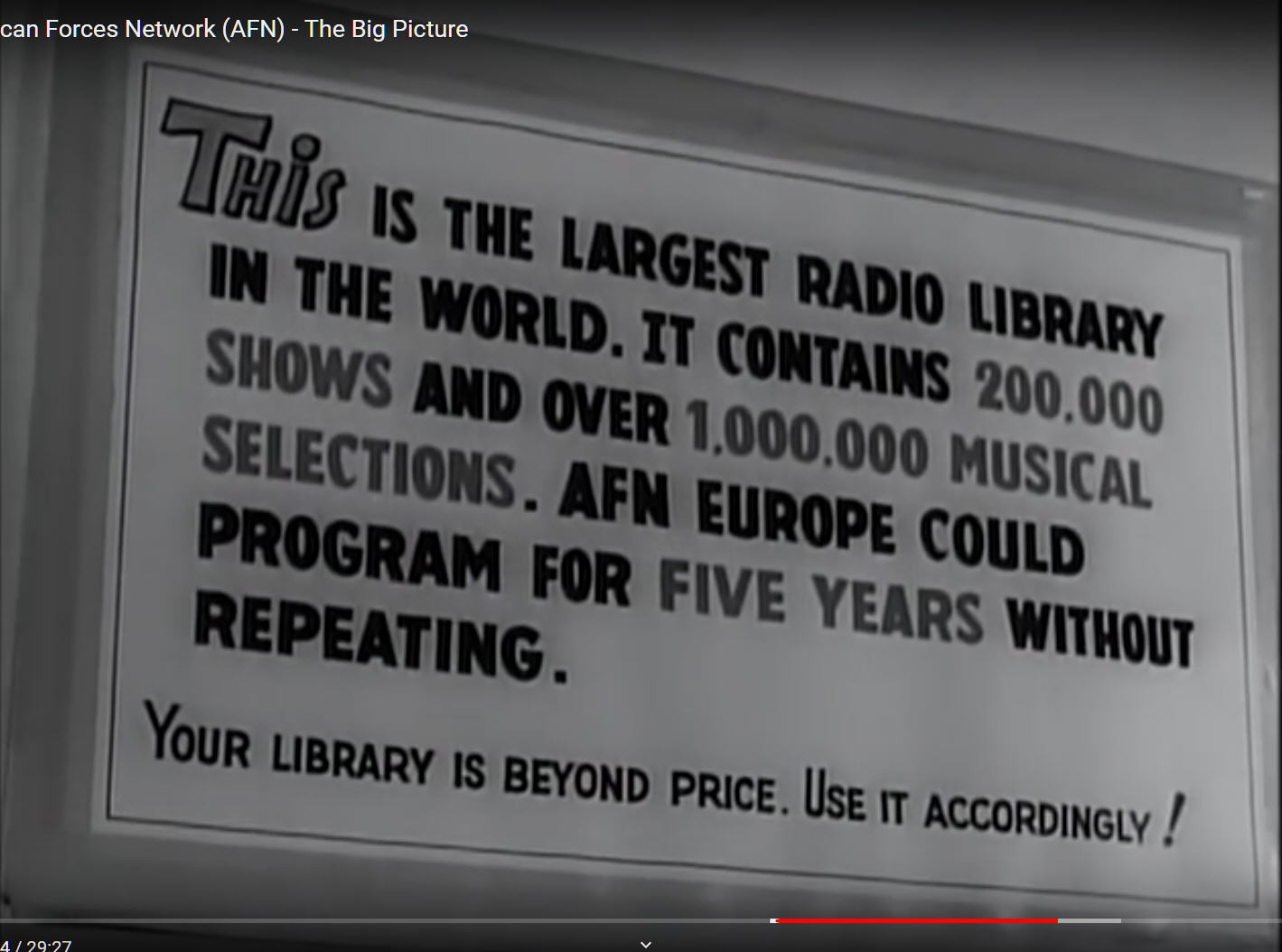
|
| AFN Library sign
|
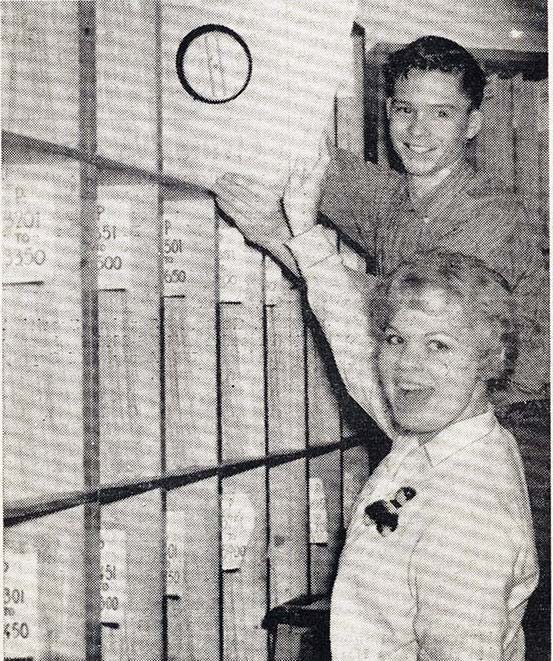
|
| Frankfurt library
|
The "Frankfurt library" photo shows my Teen-20 friends Mike Sanborn
and Stephanie Smith retrieving a 16-inch vinyl record for a show in 1960
(
another photo shows the card catalog
used for finding records).
AFN had the largest music library on earth, all on 16-inch vinyl records.
Not just music but also radio shows (dramas, comedies, soap operas, variety
shows) from 1942 to 1980.
I don't know if it has been preserved, but it
would be an incredible resource for music historians and archaeologists.
Later I found out that when AFN converted from vinyl to casette tape in 1980,
all the vinyl records were supposed to be destroyed. There were about
25,000 distinct records, each holding about 30 songs (or other types of
audio), of which apparently about 20,000 have been found and archived
(see
References).
The selection was comprehensive; there was never even one single obscure
R&B song from the 1940s or 50s that I couldn't find.
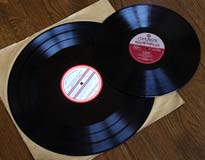
|
| An AFN record and a 12-inch LP
|
The black-and-white "AFN 16-inch record" photo above doesn't quite do
justice. 16 inches is like a large pizza! I happen to have a 16-inch AFN
disc from 1945 (no, I didn't walk home with it from AFN, I found it recently
in EBay) and took some photos. The one at right shows it alongside a
standard 12-inch LP that I bought at the Frankfurt PX in 1959. Click the
image for more views. It may come as a surprise that AFN was using
33⅓rpm records during World War II, especially if you read the
Wikipedia page[
11] that says LPs weren't
invented until 1948. But it was the LP (long-playing record) — not
33⅓rpm — that was invented in 1948; the early AFN 16-inchers
are NOT long-playing except in comparison to the 10-inch records. As you
can see, the 16-inch record shown here has only three songs on the side that
is showing (Jo Stafford); the other side (Red Norvo Quartet) has
four cuts; a typical music LP has six or seven. When I was at AFN in
1959-61, the 16-inch pop music disks had about 12 cuts per side. See and
read more in the accompanying
photo
gallery.
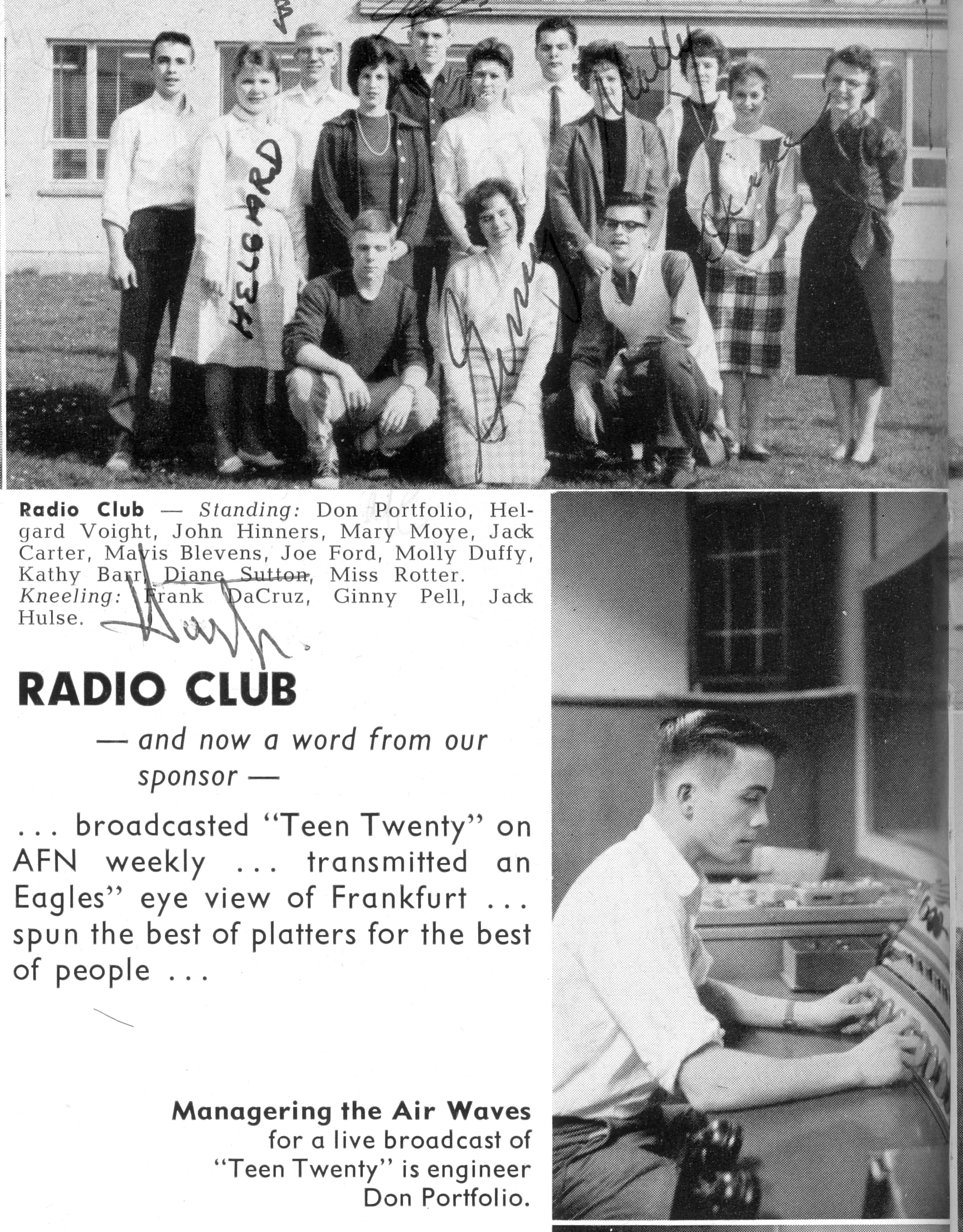
|
| 1960-61 Radio Club
|
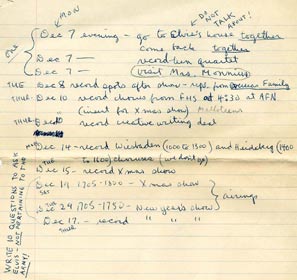
|
| Elvis interview schedule
|
In 11th grade I was president of the Radio Club. We were a close group
and enjoyed ourselves immensely. Aside from playing music (not only
teenager music but also recordings we made of school choirs and orchestras),
doing high-school sports news, and so on, we sometimes interviewed
celebrities who happened to be on the base, like the singer Joni James (I
still have a vinyl Christmas album of hers). I'm pretty sure we interviewed
Elke Sommer ("America's Sweetheart") and we almost interviewed Bridgitte
Bardot; it fell through at the last minute. But the biggest interview
we
almost had was...
Elvis. It was scheduled for December 7,
1959, at his house in Bad Nauheim (click the second image to see proof).
But Colonel Parker wound up nixing it so we did all the other stuff on the
list instead.
Before leaving the topic of Elvis, he was filming parts
of GI Blues while I was there; there was some location shooting
near me. This was kind of a joint Hollywood-Army production, and the Army
did things the Army way. For example, painting the tires of Army Jeeps and
trucks black and painting the grass in front of Army buildings green. I saw
this. Just two years later I'd be doing it.
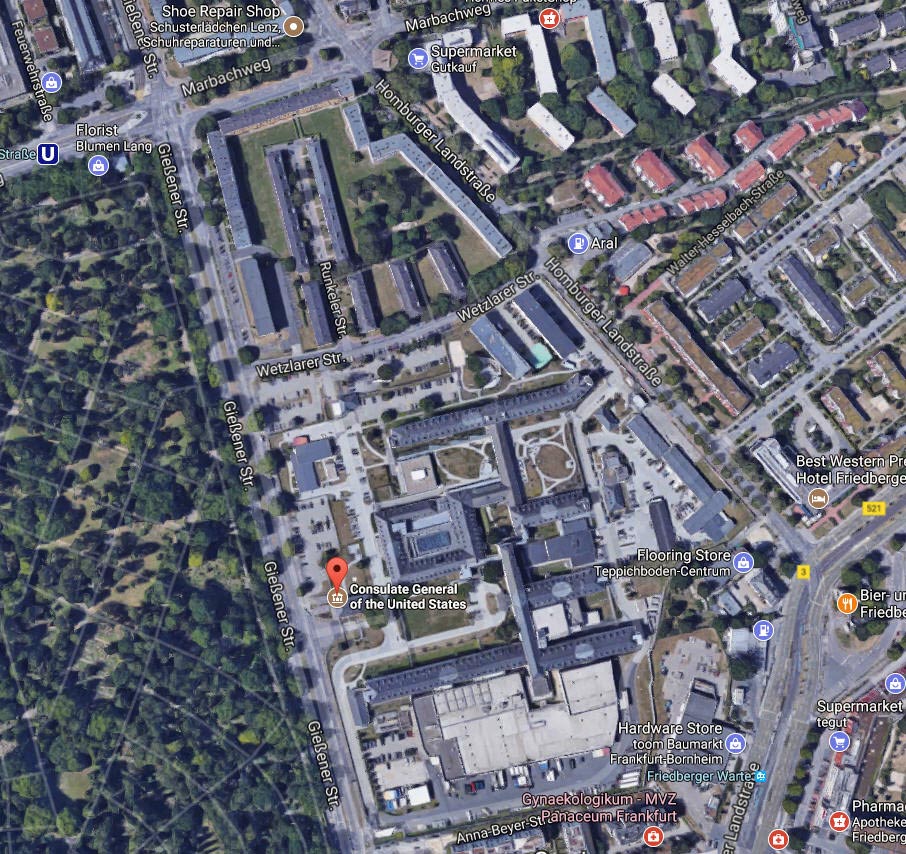
|
| Consulate General 2017
|
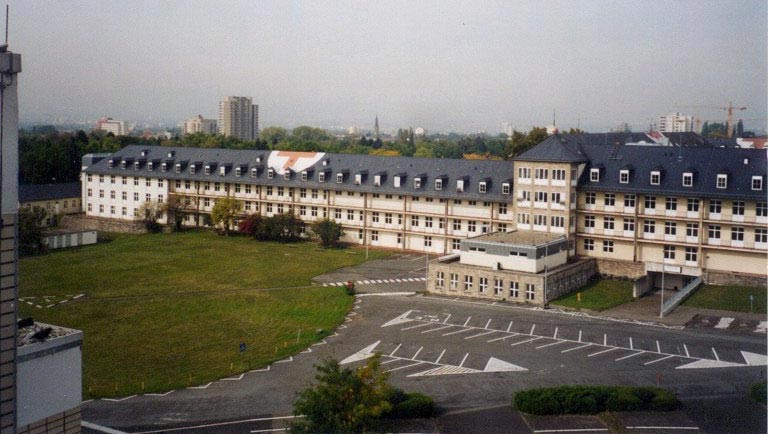
|
| 97th General Hospital 1960s
|
Anyway since I was now well-known at AFN, they asked me to take over a show,
"Bedside Rock", previously hosted by Roger Norum (also of the FHS Radio
Club, who had just graduated) at the
97th General
Hospital, a US Army hospital originally built for the Luftwaffe in 1941;
it was almost solid swastikas inside and it was enormous; the photo shows
only a tiny part of it (click the image to see more views). After the US
Army pulled out of Germany in 1995, they kept the hospital to serve
casualties in all the wars they'd be having in the mideast but later that
role was taken over by the hospital in Landstuhl and the 97th is now the
American Consulate; the red crosses on the roof to ward off bombing attacks
dated from the Luftwaffe days and were still there until the early 2000s,
when they were painted over with light grey paint so you can still see where
they were (second image, from Google Maps).
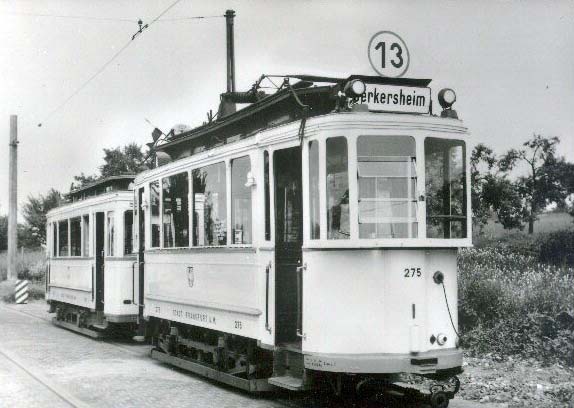
|
| Strassenbahn No.13
|
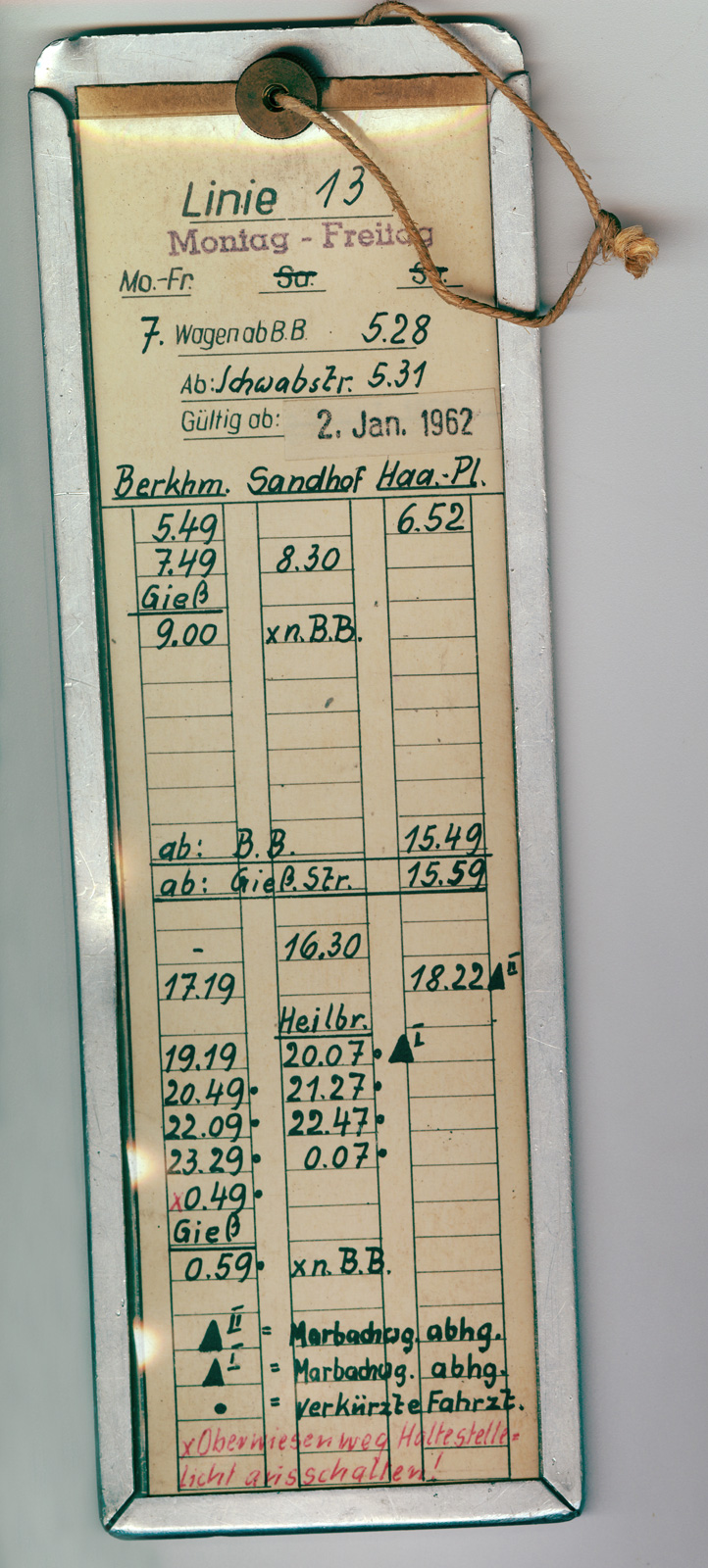
|
| Nº13 schedule
|
Owing to its vastness, the hospital had its own internal
closed-circuit AFN "Bedside Network" station and I had the whole studio and
record library all to myself every Thursday evening; this was the highlight
of my radio career. I'd take the No.13 trolley after school to the hospital
— Raimundstraße to Marbachweg, last stop at the far end of the
Hauptfriedhof — eat dinner in the hospital snack bar, and then go up
to the studio. I played rhythm and blues from
late 1940s and early 50s plus a lot of jazz, and I also talked about
whatever I felt like and invited anybody who might want to stop by and chat
on the air. Since hospital workers were on duty and most patients were
bedridden, I mainly got mental patients which made for lively discussions!
I had no bosses, no supervisors, no reports to make, nothing. It was great
fun with no pay.
Before leaving the topic of the Armed Forces Network, it should be noted
that AFN Frankfurt played music of interest to teenagers only scant hours of
the day; there was also "grown-up" pop music, country music, religious
programming, "music in the air", Don McNeill's Breakfast Club, and so on.
The other alternative for rock & roll and rhythm & blues
was Radio
Luxembourg, which broadcast our kind of music about five days a week,
only in the evening. We thought it was a pirate station broadcasting from a
ship in international waters, and in fact sometimes it was. Meanwhile,
there was a pretty serious jazz scene in Frankfurt,
as noted above; in addition to the Jazz Keller and
Storyville, there was excellent jazz programming on the radio (Hessischer
Rundfunk, Jazz Intermezzo with Joachim L. Spieren) featuring highly regarded
Frankfurt cool-jazz groups like
the Jutta Hipp
Quintet and various Mangelsdorff groupings[9]
(Albert
Mangelsdorff wrote Jazz Intermezzo's theme song "Simone I").
References...
- Armed
Forced Network, Europe, at Walter Elkin's monumental
U.S. Army in Germany website.
- The Story Of
American Forces Network (AFN) (video), The Big Picture, Army Pictorial
Center. A 30-minute film from 1963 about the history of AFN in Europe; it
includes footage of the studio and record library where I worked in the
Höchst castle just outside of Frankfurt.
- On The Air Over There, AFN Europe:
Part 2 The Castle Years, 29-minute video about AFN Frankfurt at the
Höchst castle... End of the War, Nürnburg trials, Berlin Airlift, Elvis,
Beatles, Berlin Wall, JFK (there are three other parts to this series).
- Meria Petrich,
Lost
vinyl collection returned to AFN home, Northwest Guardian,
9 December 2011.
- American
Forces Network, Wikipedia, accessed 10 December 2018.
- American
Forces Network, German Wikipedia, accessed 10 December 2018.
- AFN Frankfurt,
Wikipedia, accessed 13 December 2022.
- GI
Blues, a very silly Elvis movie made while he was in the Army and
partially filmed on base. He sings a song in German (Muß i denn).
- Heidi Laird, The
Frankfurt Kitchen: Forty-One Stories of Growing Up in Post World War II
West Germany, Fulton Books (2021), Chapter "The Höchst Palace",
pp.245-262: Her experiences as a German girl listening to AFN Frankfurt in
postwar years and visiting the AFN studios.
- Michael J. Budds, ed., Jazz
and the Germans, Pendragon Press (2002).
- Dennis
M. Spragg, The
Armed Forces Radio Service, Glenn Miller Archive, University of Colorado
at Boulder, September 2013.
- LP record,
Wikipedia (accessed 12 December 2021).
Interlude: "The Warriors" Frankfurt style
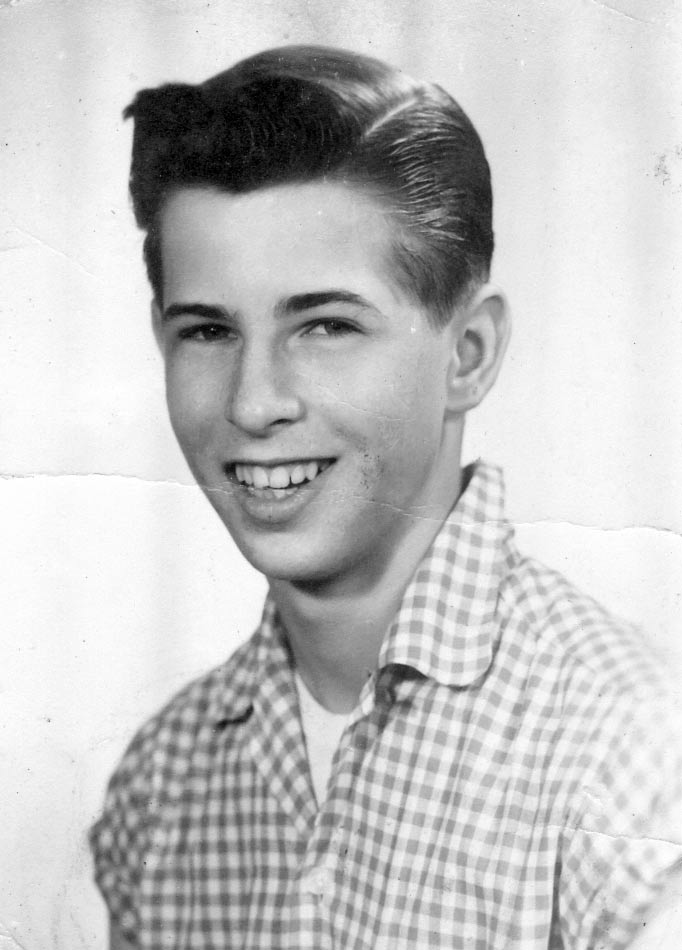
|
| Tom McCaffrey
|
Peter and I were watching one of his favorite movies recently (summer
2015),
The Warriors (1979), in which one gang is chasing the members
of another gang all over the NYC in the middle of the night. I told Peter,
"you know, I had a night like that once", and described it to him. Peter
said I had to put the story in here so here it is… When I was in high
school in Frankfurt we used to go out drinking almost every night (not just
the guys, the girls too, but this night was just the guys, about four of
us). We went to random places, bars, Gasthauses… So we went in a bar
on a dark side street that was very dark inside, sat at the bar and were
drinking. One of us, Tom, goes to the bathroom. A bit later he comes out
and says, "Let's get outa here", and hurries us out. We're walking (maybe
staggering) down the block and suddenly a whole swarm of guys busts out of
the bar and runs at us, like maybe 20 guys. So we we start running too, and
they chase us through all the dark streets, yelling and cursing. Eventually
they catch us and they restrain me and the other guys except Tom, and they
beat the crap out of him, I mean REALLY… One ear was half torn off,
teeth missing, eyes swollen shut, face unrecognizable, blood everywhere…
(at least that's how I remember it). Then they leave. We take Tom in a
taxi to the dispensary (Army word for small clinic on the base). They sewed
him up, put bandages all over. Very painfully he explains what happened.
When he went in the bathroom, the guy at the next urinal made a play for his
parts so Tom clobbered him and left him on the floor. The place turned out
to be a gay bar, but we barely even knew what "gay" was!
Food and drink
Most of the German places we went to for drinking also served food,
sometimes just Butterbrot (chewy German black bread with unsalted butter or
cheese), or soups… Bouillon mit Ei (chicken broth with a raw egg in
it) or my favorite, Ochsenschwanzsuppe: thick, dark, and rich oxtail soup
served with chewy Brötchen — white bread rolls but much tastier and
crustier and chewier than American ones. And for a whole meal there was
Wienerschnitzel, Jägerschnitzel (which is Wienerschnitzel with mushrooms and
gravy), Zigeunerschitzel (spicy "Gypsy" Schnitzel), Leberknödel (liver
dumplings), Rouladin (flank steak rolls with stuffing), roast
chicken... these would be served with a delicious kind of subtle marinated
"soft" salad that I've never seen anywhere else, and potatoes (or in
Schwaben, Spätzle, where also in the Weinstuben, Westfälischer or
Schwarzwälder ham would be served with the wine). Also in some places you
could get a charcouterie that was an assortment of meats and sausages on a
bed of Sauerkraut soaked in champagne (Mommie had that once at the Goldener
Hecht in Heidelberg and it made her very silly).
On the street there were Bratwurst vendors, flame-grilled Bratwurst with
Brötchen and German mustard, and later on (when I was in
Army) there were a lot of Yugoslavian food stands and the things they
sold were called Ćevapčići
(phonetically chee-WOP-chi-chi) (Wikipedia)
and (phonetically) DZHI-vich, which were both super-spicy, I think this was
the first fiery-hot food I ever ate. And then besides these, there were
Chinese and Italian restaurants that were uniformly excellent. A sit-down
meal in a German restaurant never cost more than 4 Marks (one dollar) when I
lived there.
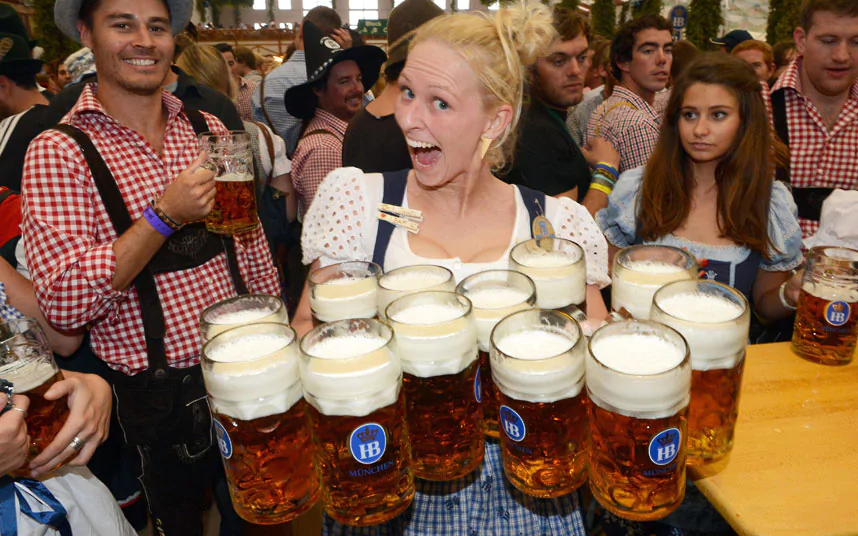
|
| Waitress with twelve big beer steins
|
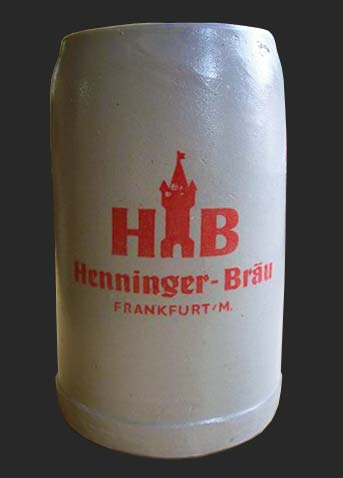
|
| Henninger Bier Stein
|
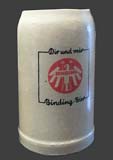
|
| Binding Bier Stein
|
German Gasthauses (Gasthäuser) served beer in half-liter and liter steins,
and serious beerhalls like
Maier Gustl's
in Frankfurt and the much larger Hofbräuhaus in Munich also had
five and even ten liter steins. The waitresses could carry five or six
one-liter steins in each hand and they did this all night; it was pretty
amazing (
see
video). At the Hofbräuhaus in Munich you could earn a 5-liter
or 10-liter pin if you drank that much in one sitting (I could have done
that, but only went there once, very briefly, and it was kind of a zoo).
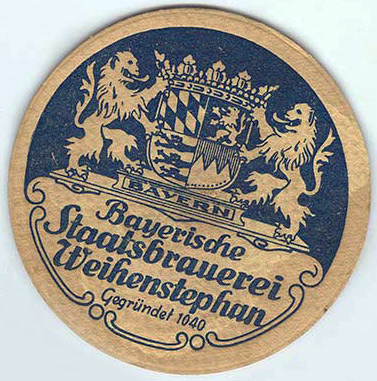
|
| Founded 1040 AD
|
Beer culture in Germany was unique. Each town or area made its own lager
beer with a distinct taste, following the Reinheitsgebot (Purity Law) that
dates from the early 1500s and says that beer may contain only water,
barley, and hops. Note: no preservatives, no chemicals, no flavorings. Of
course big cities might make several brands. There weren't nationwide
brands because the beer was unpasteurized and it might spoil before it
reached some distant destination by truck. Many German brewing companies
have been in business for hundreds of years, in some cases
a
thousand years. When I lived
there, each bar, restaurant, and Gasthaus served only one kind of beer.
Besides lager, by the way, there was also a completely different thing
called Weizenbier, or wheat beer, served with lemon and usually found only
in Gasthauses frequented by old men; it was famous for causing fart storms
so Weizenbier establishments were not for the squeamish. The main Frankfurt
beers were Henninger, Binding, and Frankfurter Brauhaus, but others were to
be found, both native and imported from different parts of Germany.
Mr. Thompson
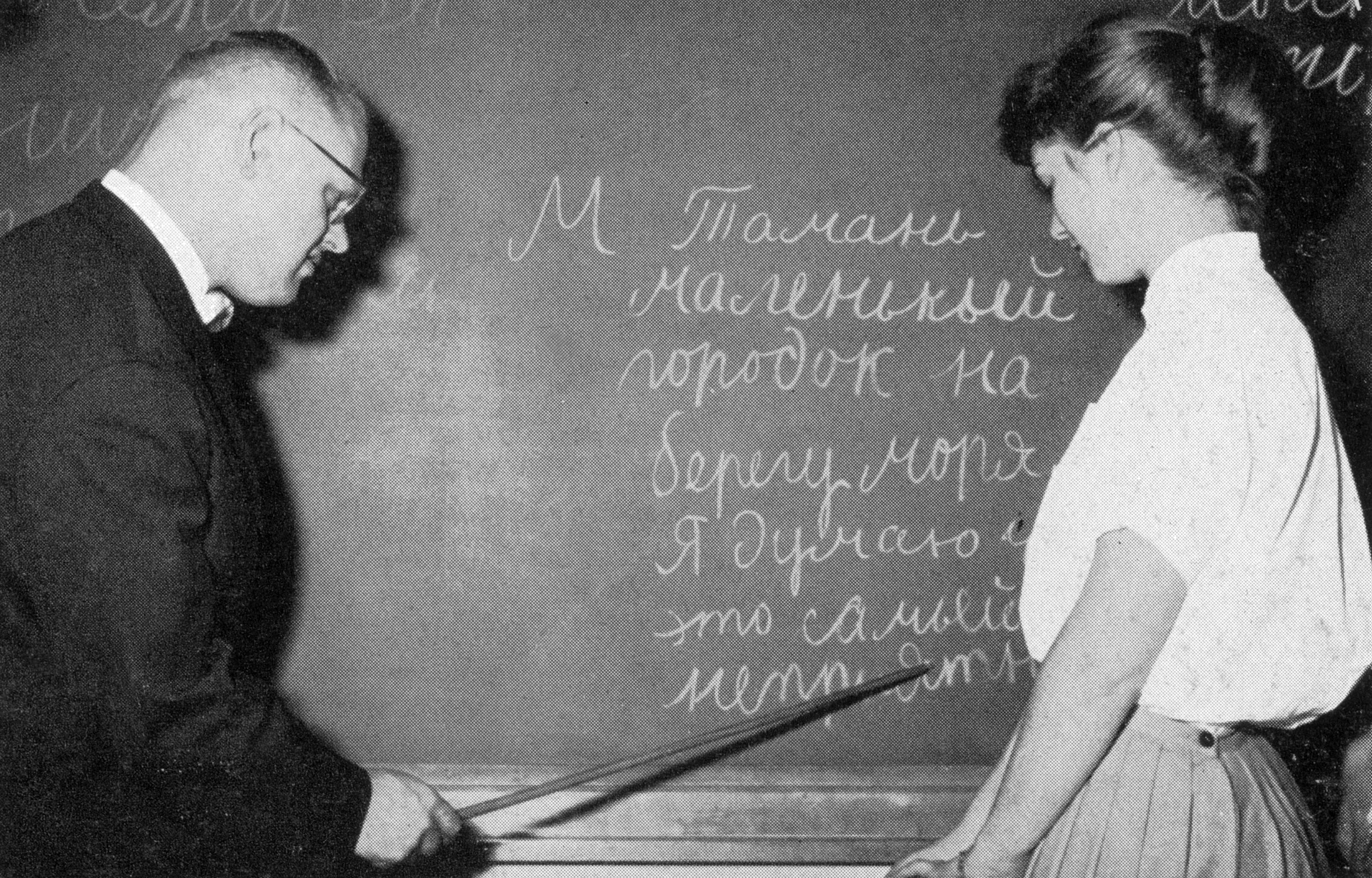
|
| Mr. Thompson teaching Russian
|
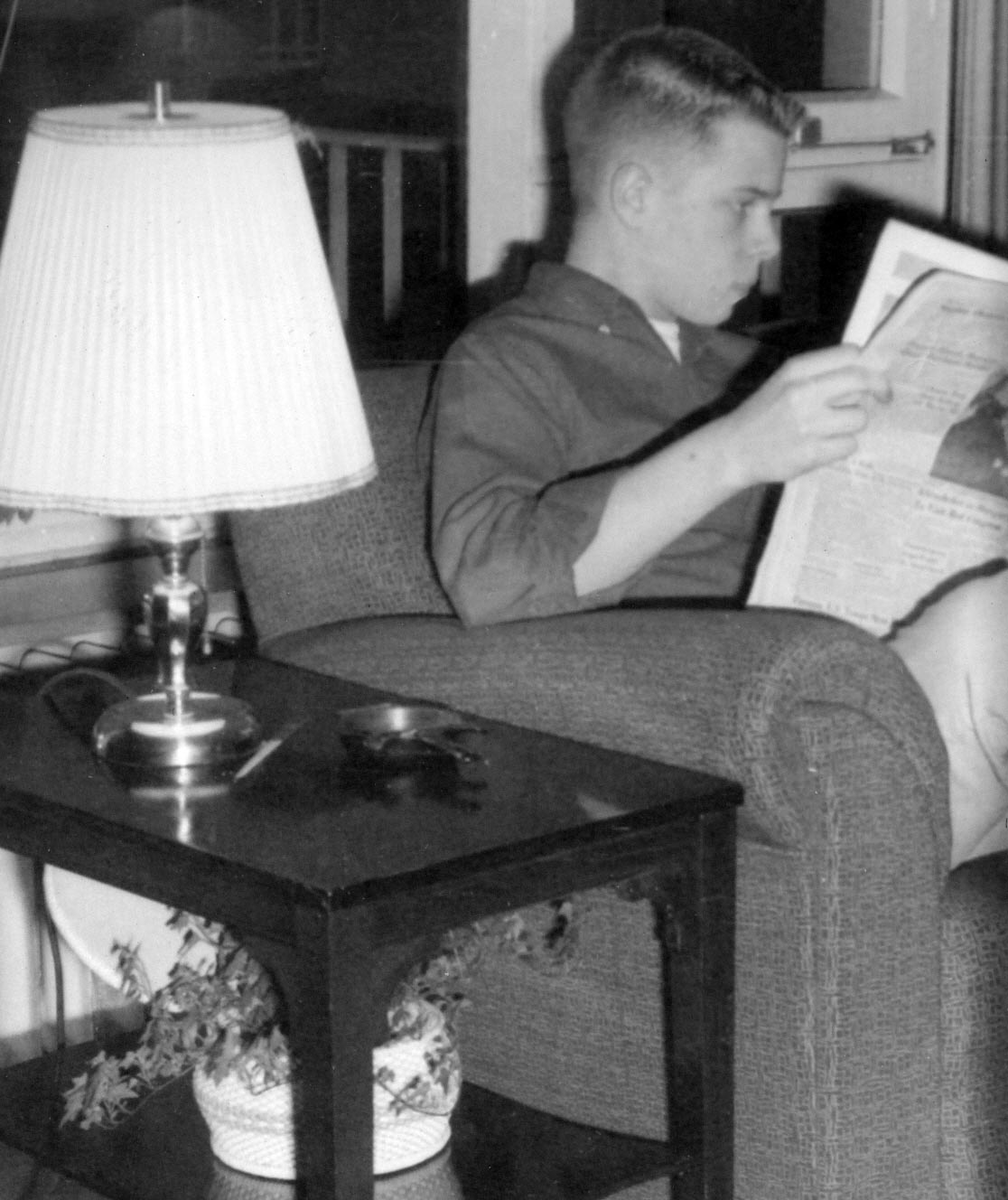
|
| Reading Pravda
|
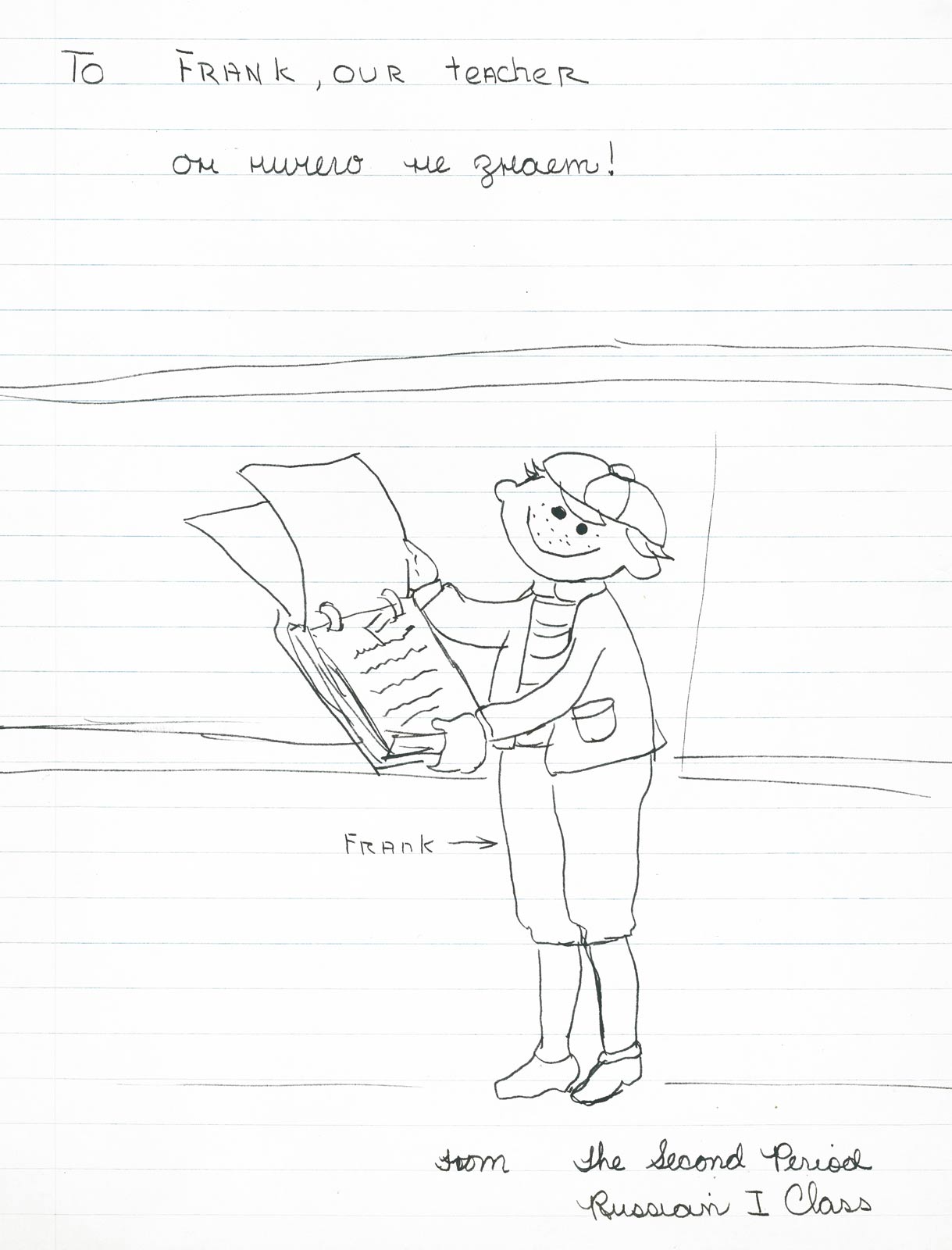
|
| Gift from the class
|
When I was in 11th grade, a math and science teacher offered a brand-new new
Russian class, which I signed up for as soon as I heard about it. He had
taught himself Russian, I don't know how. It was the best class I ever had
in any school. His name was John Thompson, he was a WWII and D-Day Normandy
Beach veteran, Battle of the Bulge, etc, something he never mentioned and I
found out only 50 years later. He had a great fondness for the Soviet
Union, probably owing to their part in the victory over Germany and he had
us learn and sing Soviet songs, listen to Radio Moscow, and read Pravda
(and, for fun, Krokodil). Bear in mind, this was in a US Army school! We
had no textbook; he typed out the lessons on Russian and English typewriters
and mimeographed them, even painstakingly adding two-part harmony sheet
music in the case of the songs, such as
Полюшке
поле: the marching song of the Red Army.... by
hand, with the aid of only a ruler. He liked to
talk about the USSR… One day he said, "In the USA we have a lot
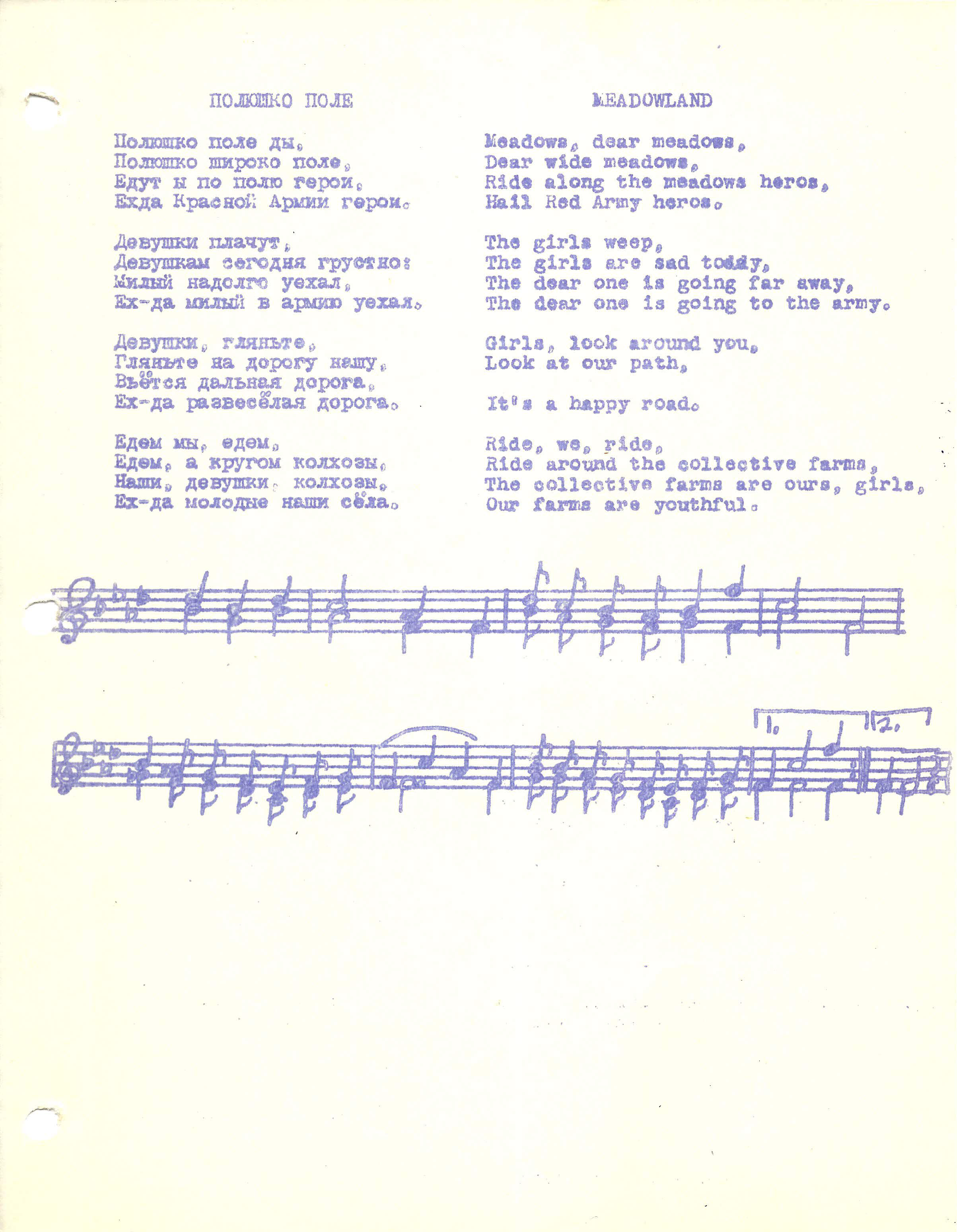
|
|
Полюшке
поле
|
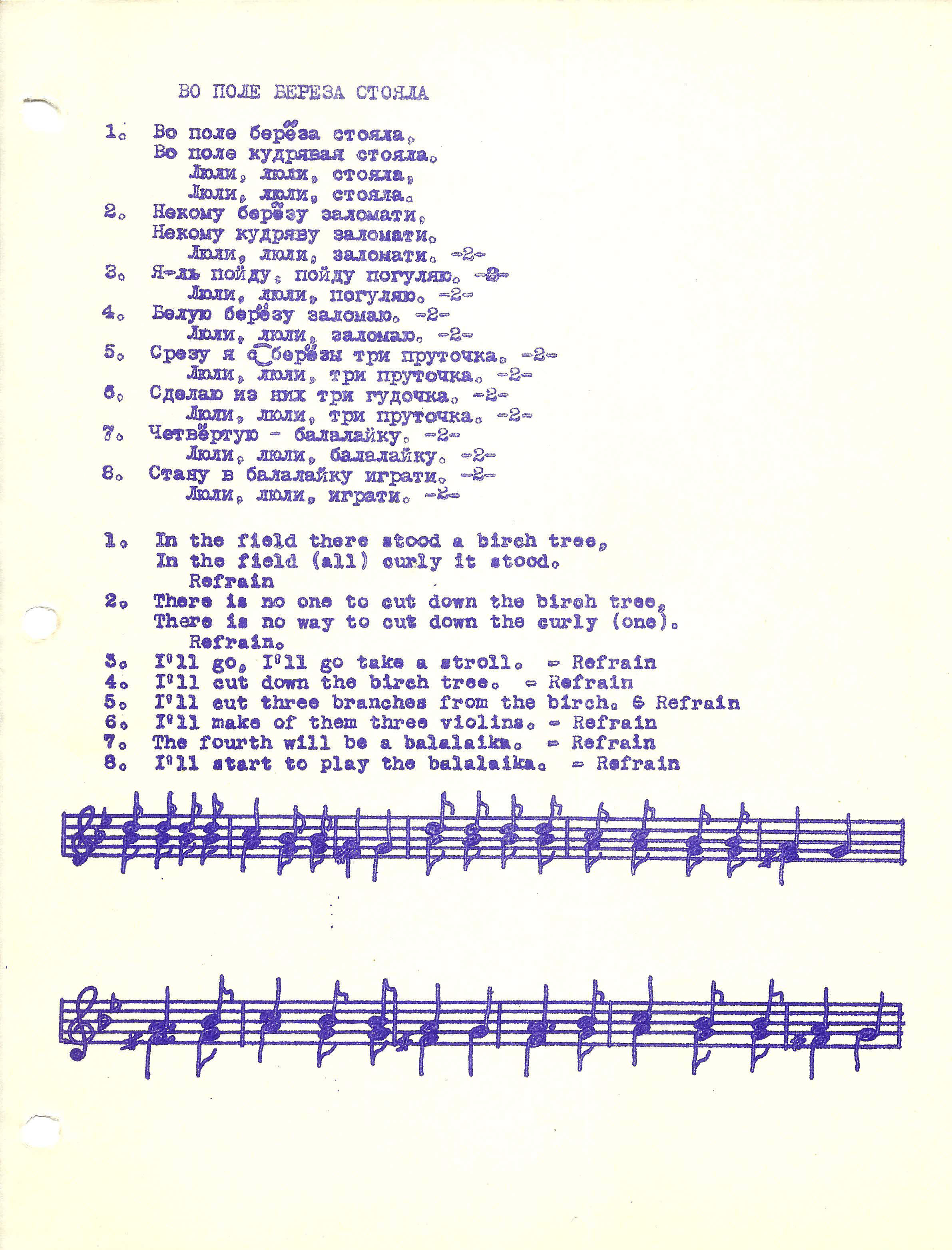
|
|
Берёза
|
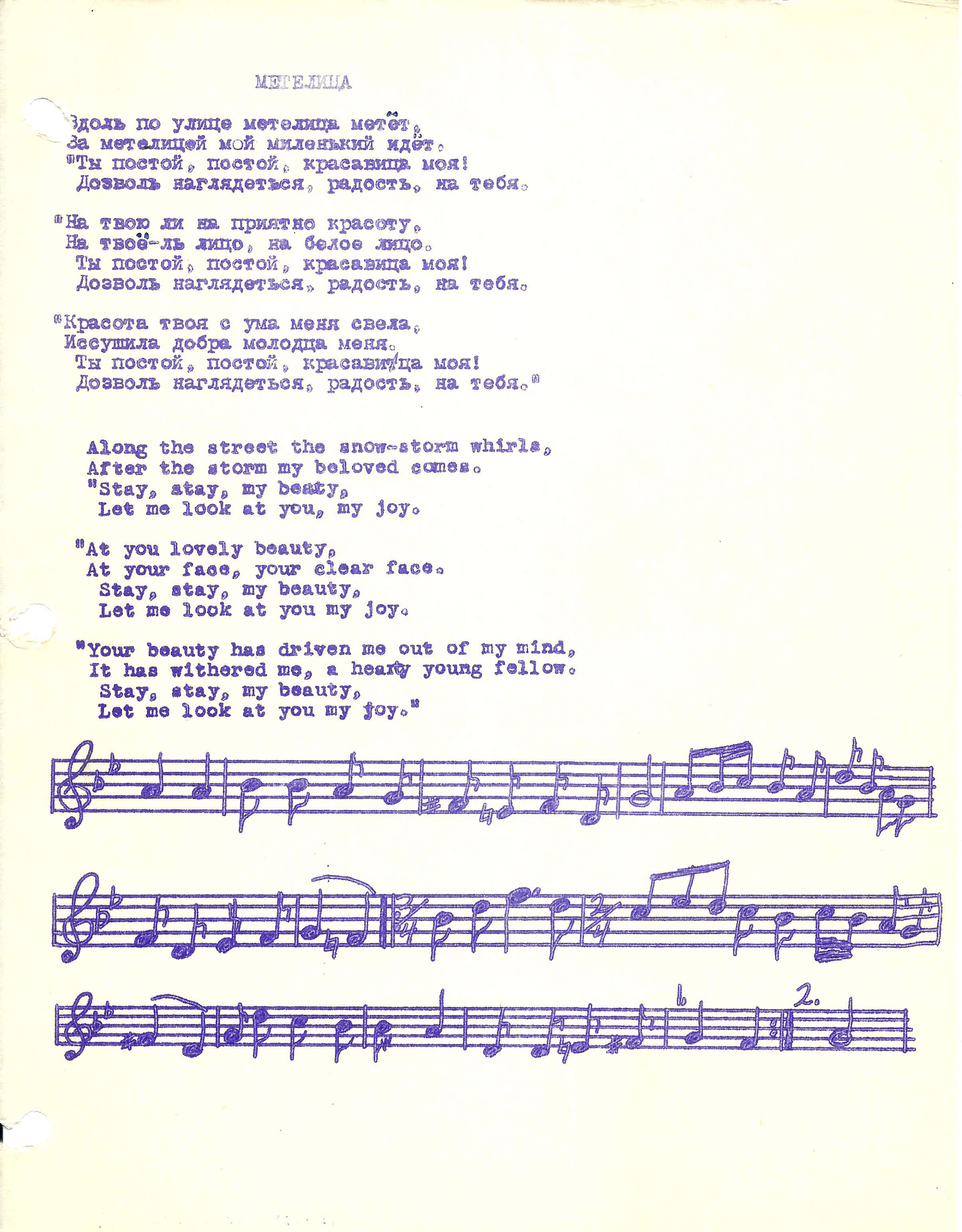
|
|
Метелица
|
rights, but the Soviet Union has one right that we have never had: the right
to work!" I had to think about that for 30-40 years before I got it. Bill
Fedor ('62) tells me that the next year (1961-62) "Russian II at FAHS
ushered in Nina Potopova's Russian I and II textbooks that Mr Thompson
purchased in Düsseldorf for DM4.20 each." Thanks to Bill for the song
scans!
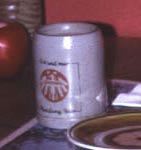
|
| Jerry's mug
|
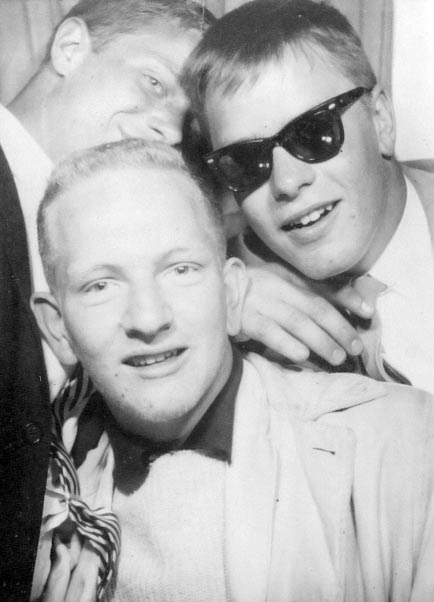
|
| Jerry Jacobs (front)
|
John Thompson was so enthusiastic and he worked so hard; he loved what he
was doing. Besides Russian he also taught physics, math, biology, and
photography. True, he was kind of a hardass (and he looked the part, like a
Prussian)... He didn't appreciate kids fooling around in class; he could
throw chalk at anybody in the room and hit them square in the forehead. One
night my friend Jerry Jacobs and I stumbled out of a bar, literally
falling-down drunk. Mr. Thompson happened to be walking by just then and he
helped us get home like he was our best friend. The people in the picture
are Jerry, Johnny Johnston (alias DJ, "Drunkard Johnston", a self-bestowed
nickname), and me in the photo booth at the PX. The color picture shows the
Binding Bier mug from Little Maier Gustl's that Jerry sent me for old times'
sake shortly after I rotated but after 60-some years of washing now it's
just a dull gray mug, no logo.
Mr. Thompson left FHS in 1962 and died in 2009, about ten years
before he could have seen
these Youtube videos, which I know he'd have
enjoyed as much as I do!
Family Trips while living in Frankfurt
One good thing my Dad did while we were in Germany was to take us on lots of
trips. As a teenager in high school I was kind of embarrassed to be
traveling around with my parents, but in retrospect I'm glad we did.
Berlin
[
See gallery ]
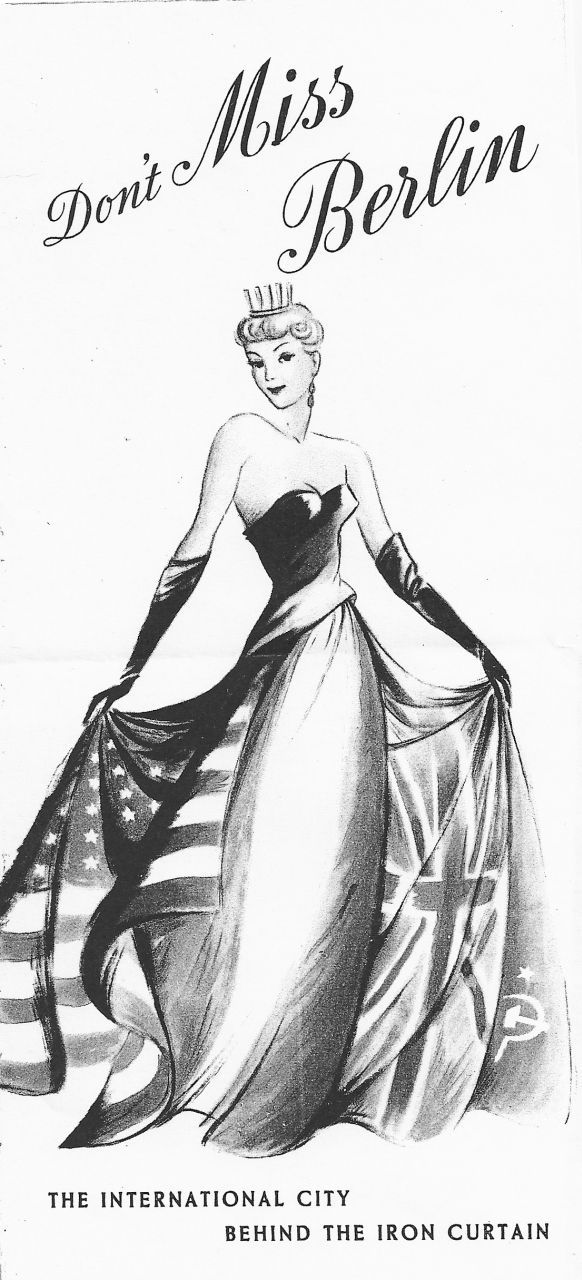
|
| Don't Miss Berlin!
|
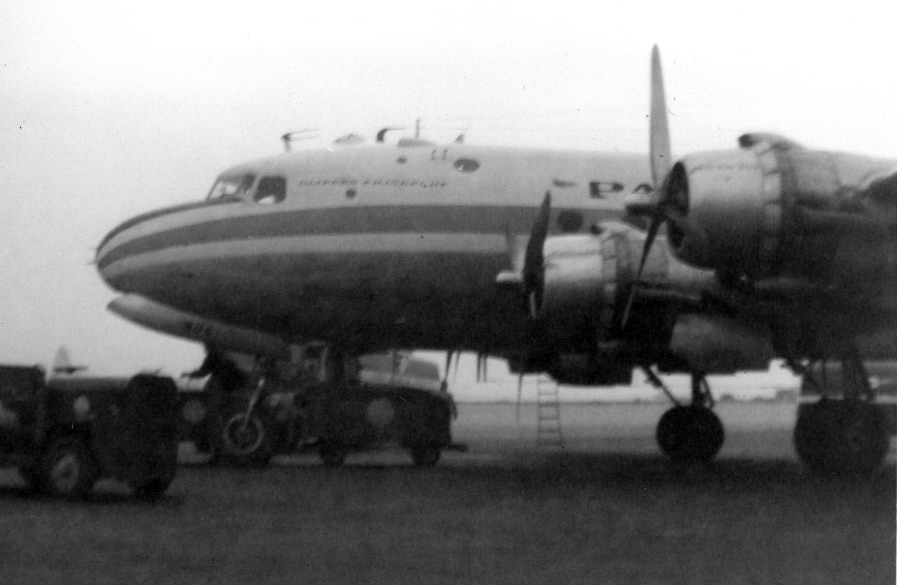
|
| The DC-4 that took us to Berlin 1959
|
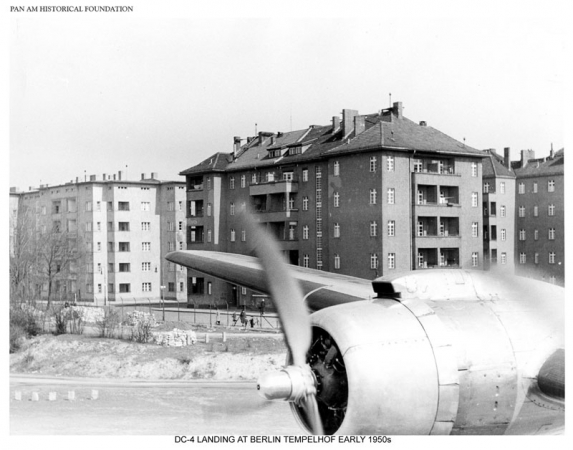
|
| Landing at Tempelhof Airport
|
Our first trip was to Berlin in early 1959 which was in part still in ruins,
like you can see in movies
like
The
Big Lift and
One
Two Three. The flight to Berlin was on a Douglas DC-4
(
4-engine propeller driven airliner, the
civilian version of the C54 cargo plane used in WWII and in the airlift).
This was my first plane ride. I remember looking out the window and
thinking East Germany looks the same as West Germany, just a lot of farms and
little towns. But traveling across or over East Germany was a tricky
business, there could be no deviation from the approved route. So…
At some point the pilot came back into the passenger cabin and saw Dennis,
who was a cute little 9-year-old, and asked him if he would like to fly the
plane. Dennis said OK, my Dad said OK, so the pilot took him into the
cabin. Next thing we knew this huge aircraft was peeling off to the
right and in a steep dive. Then it recovered and the pilot, his face
drained of blood, brought Dennis back to his seat without a word.
Landing at Tempelhof airport in Berlin was an adventure in itself. The
airport was in the middle of the city and as the plane makes its descent
there are apartment buildings on both sides, sometimes so close you can
see in the windows. Tempelhof (which dated from 1927 and claimed to be the
world's oldest operating commercial airport) lasted until 2008, when it was
closed and converted to a "green space".
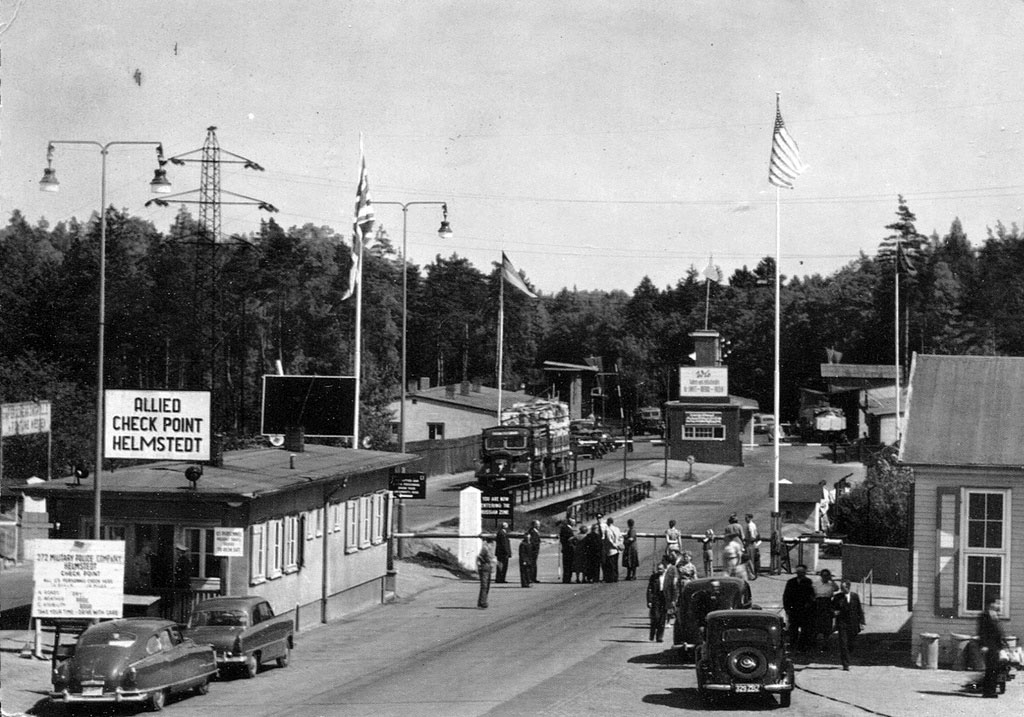
|
| Helmstedt checkpoint 1963
|
For the record, it was also possible to go to Berlin by auto. You could
cross into East Germany at Helmstedt/Marienborn (the
nearest to Frankfurt of several crossing sites) and take a special route
that was totally unmarked; if you lost your way you'd be detained. Another
way to go was by a sealed train like the one Lenin rode in. Anyway while in
Berlin I took some pictures with my Brownie Hawkeye that are now famous from
having been published in several books, including a photo similar to the first
one below left but no family (obviously I didn't take that one because I'm
in it).
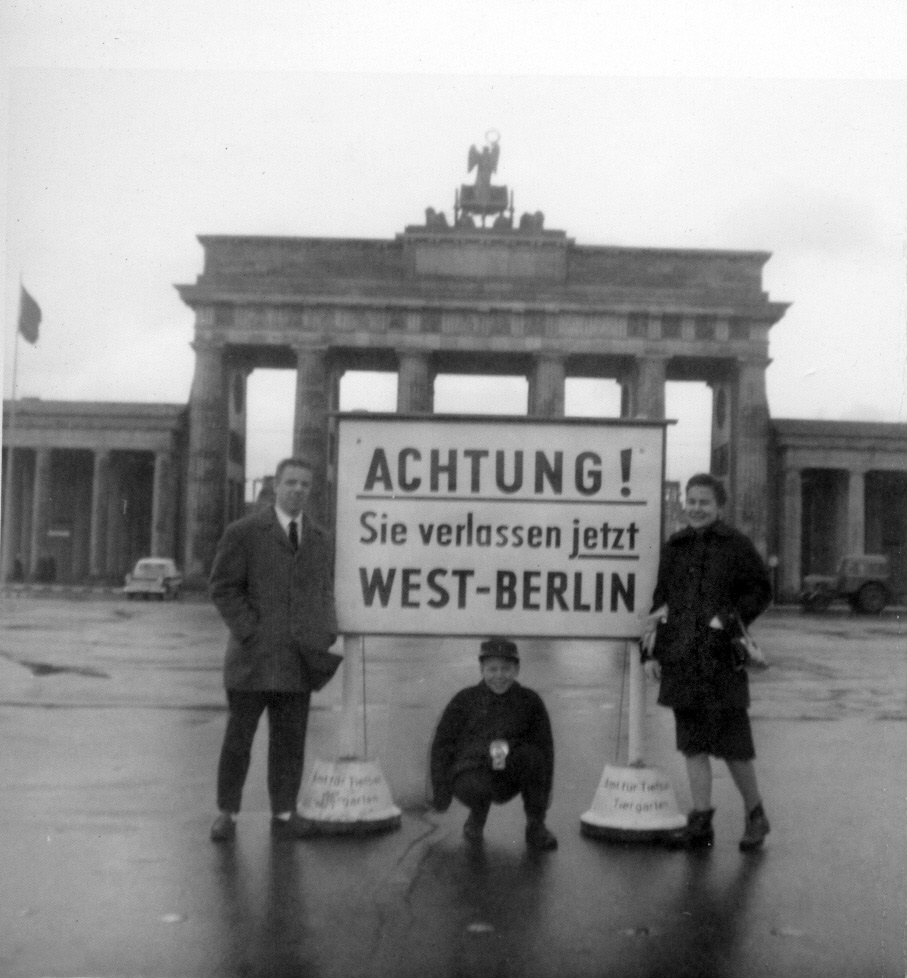
|
| Brandenburg Gate 1959
|
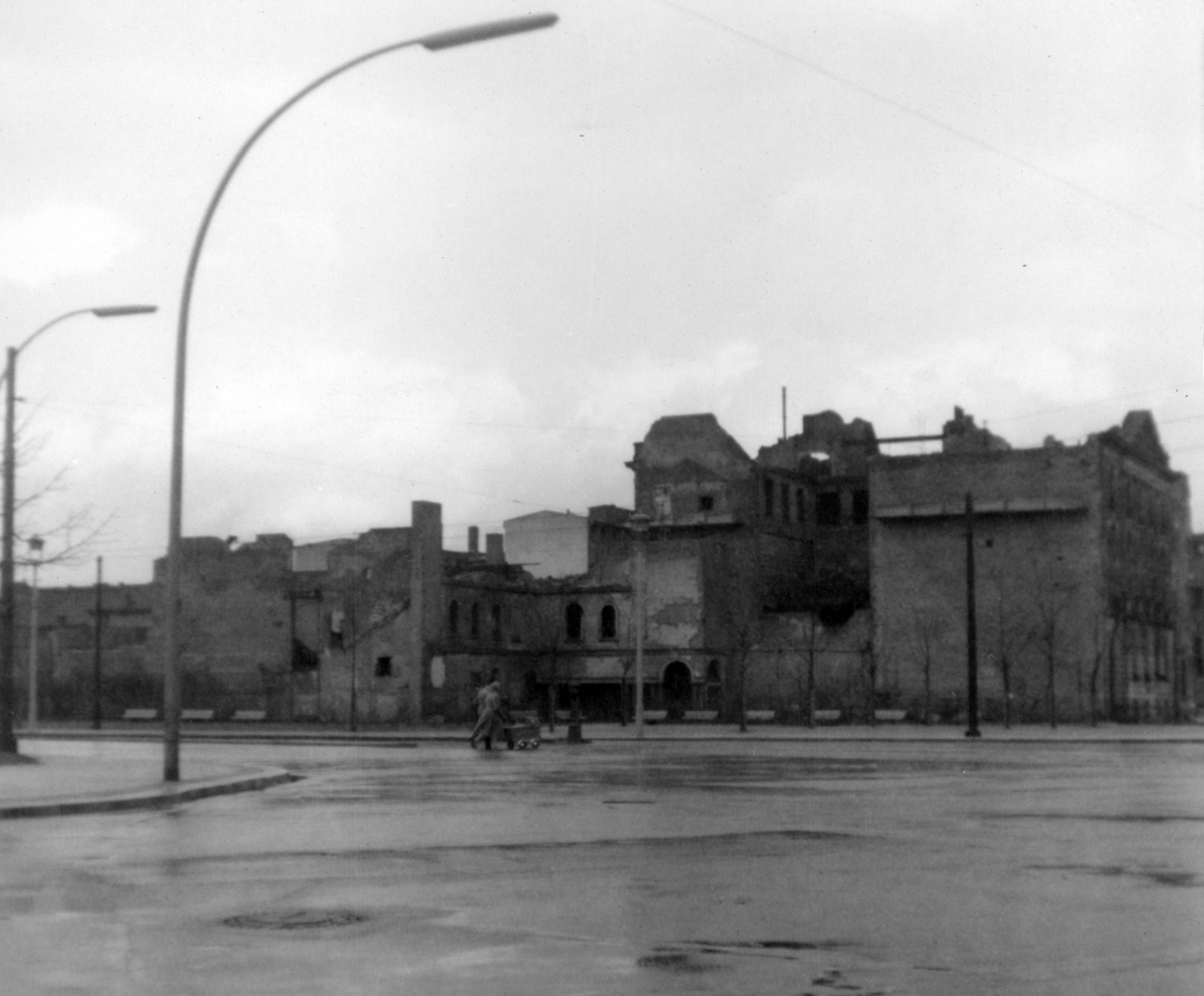
|
| East Berlin 1959 (pre-Wall)
|
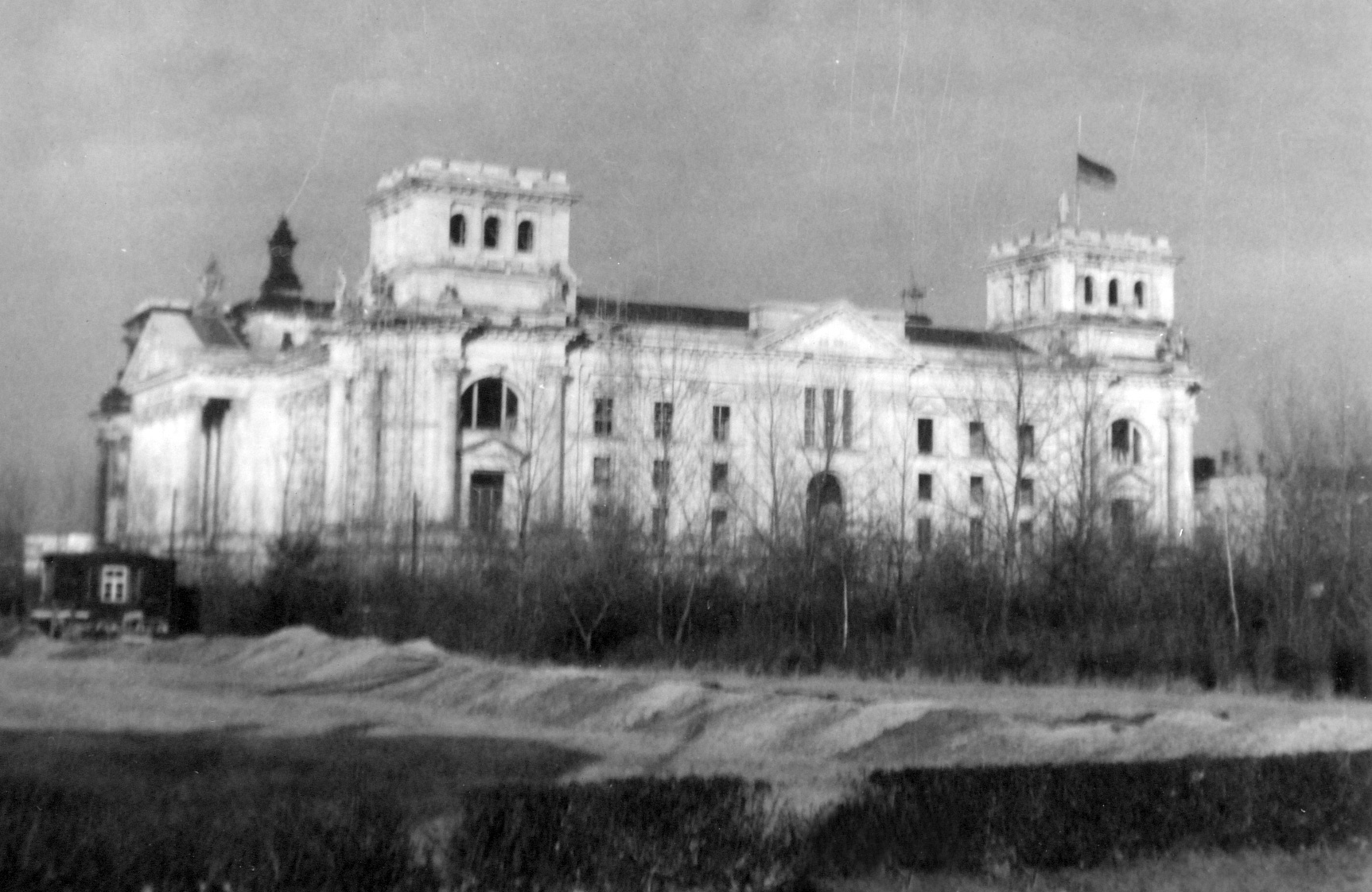
|
| Reichstag 1959 (burned out since 1933)
|
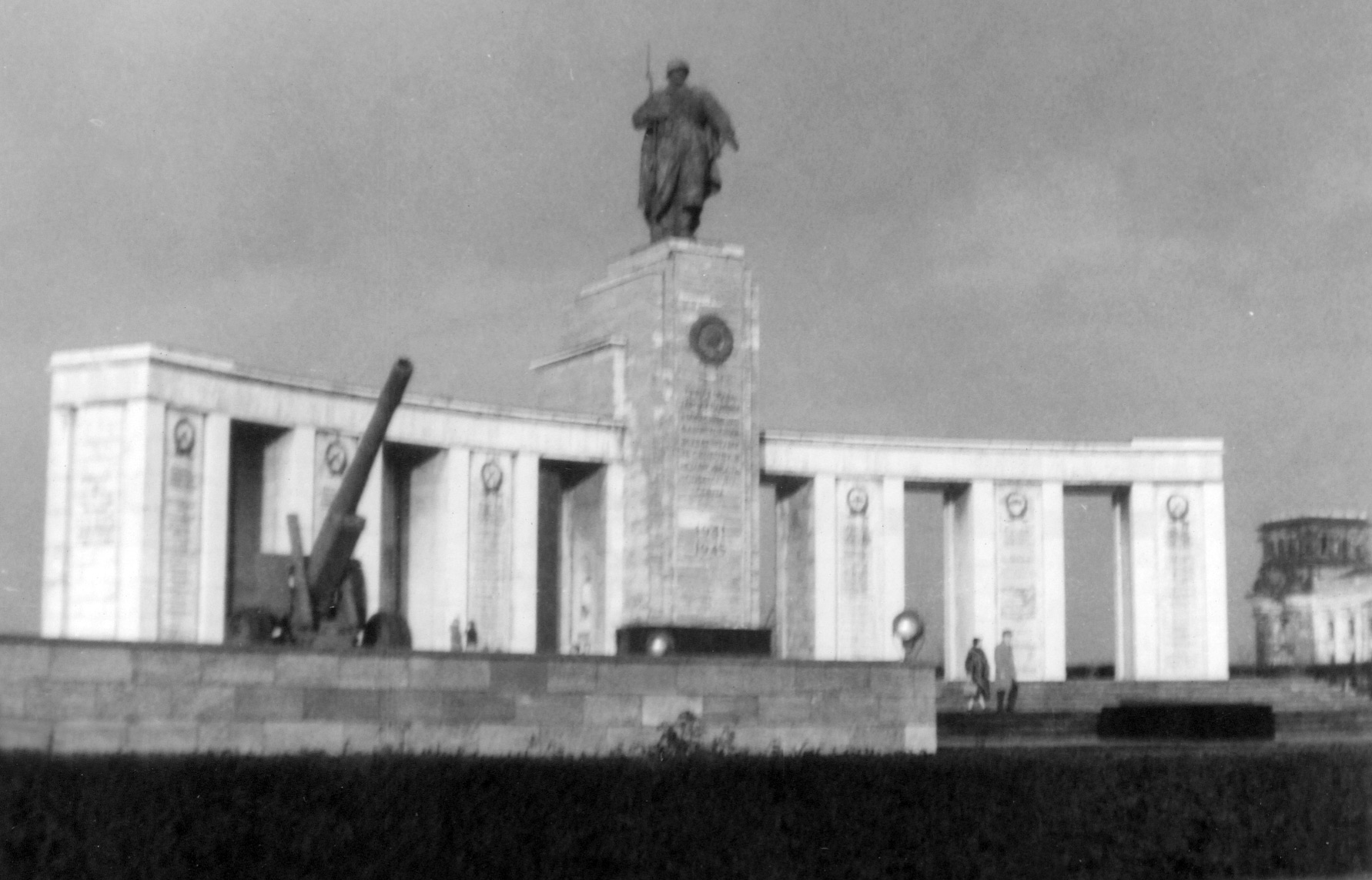
|
| Soviet War Memorial
|
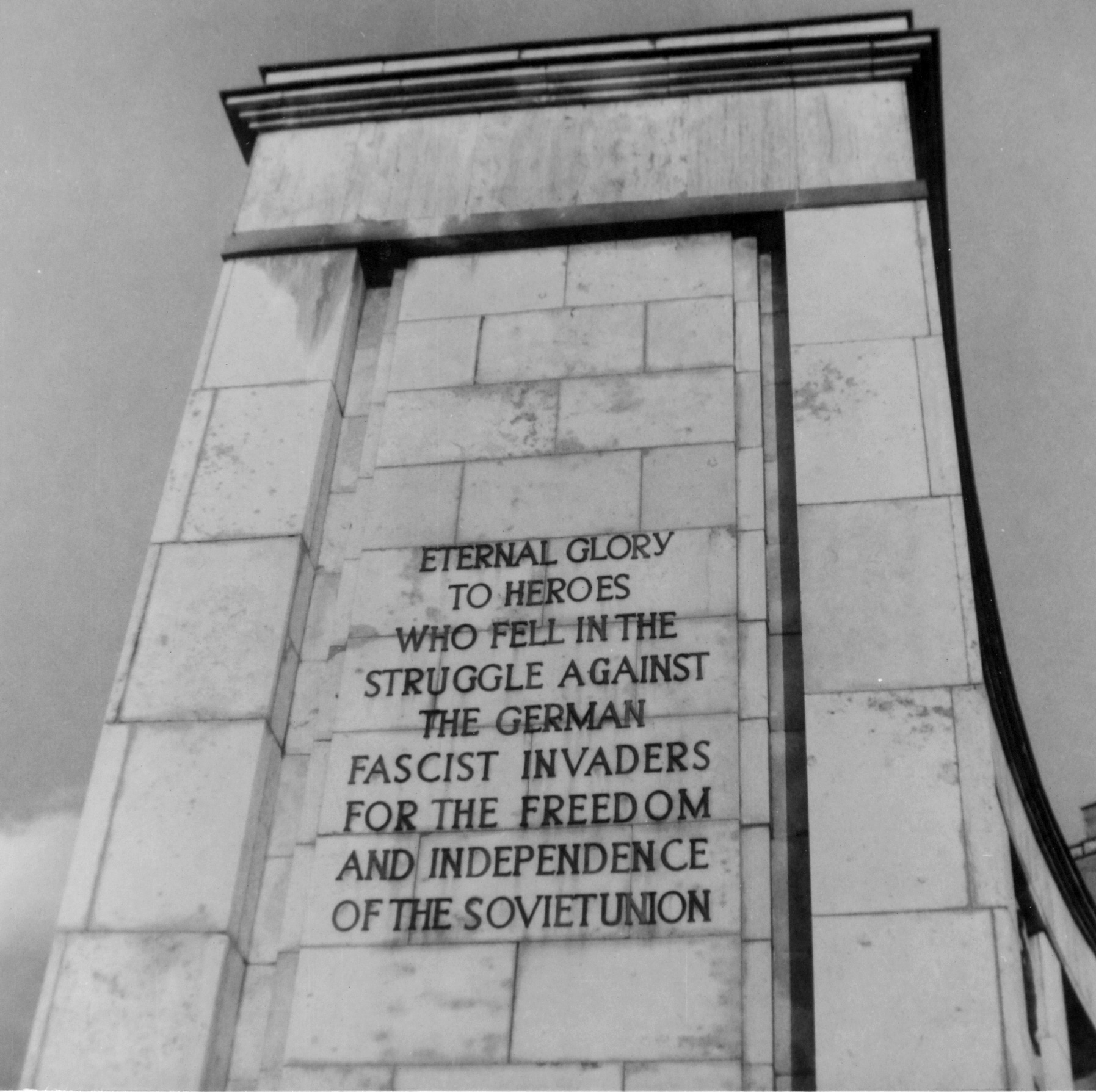
|
| Memorial inscription
|
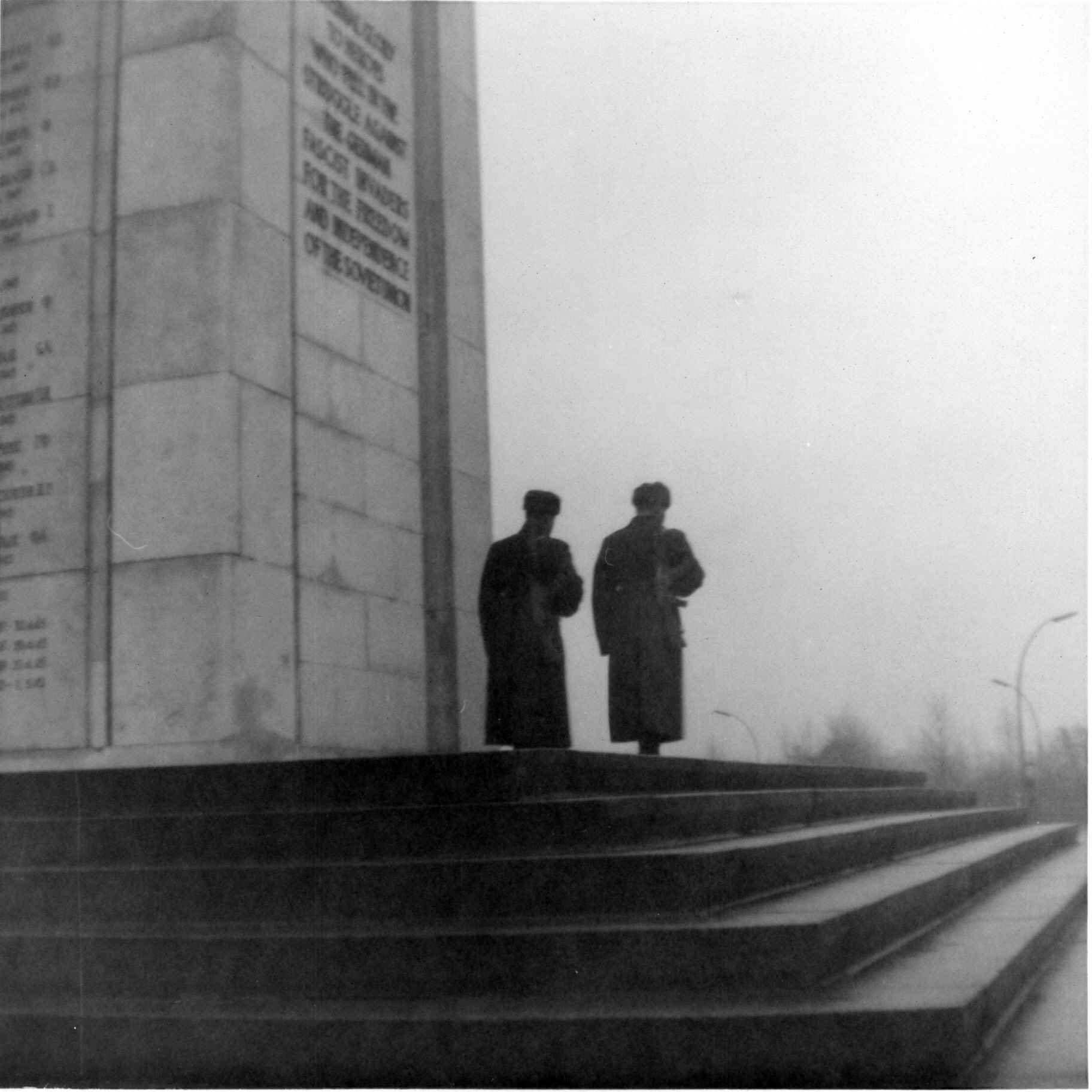
|
| Red Army soldiers
|
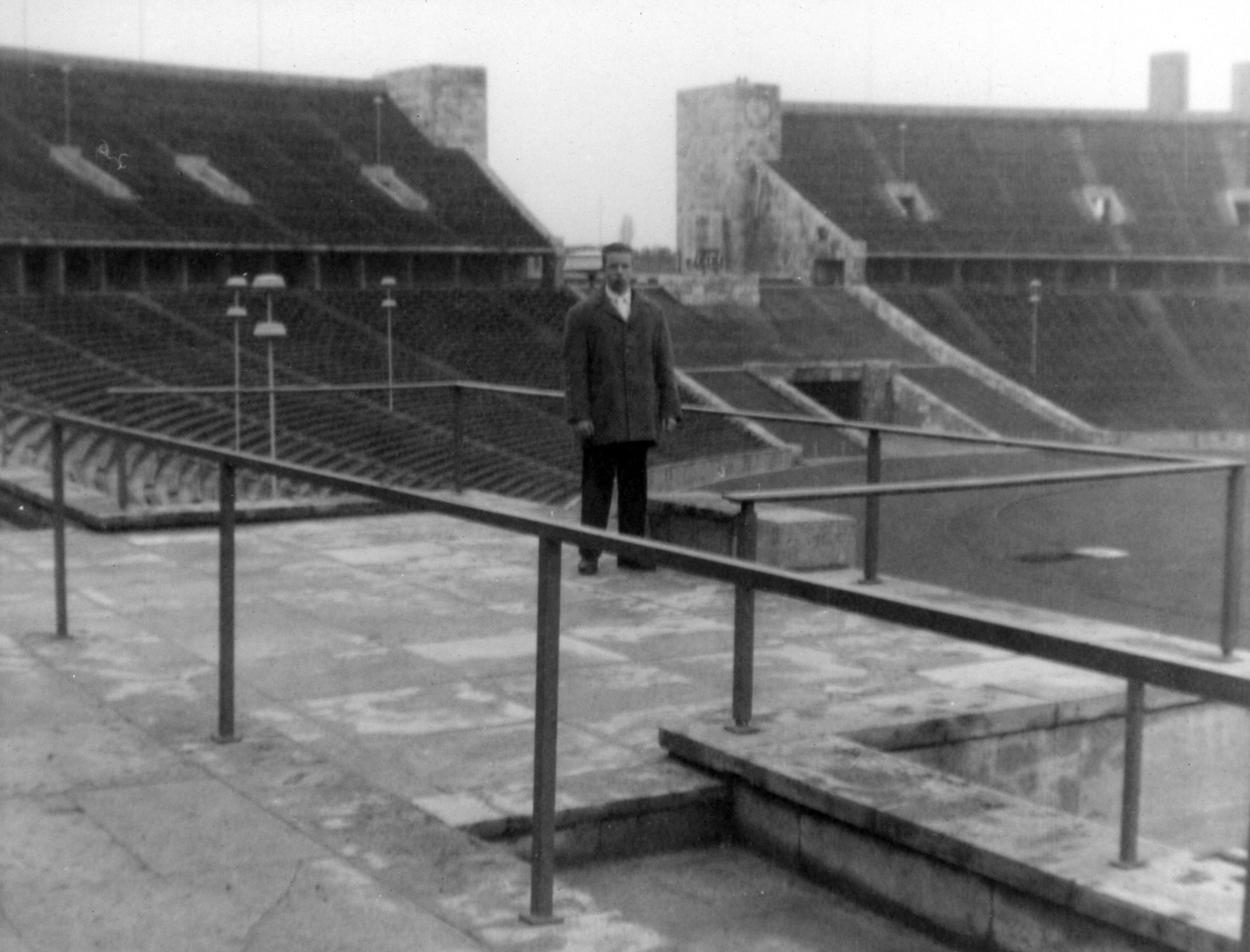
|
| 1936 Olympic Stadium
|
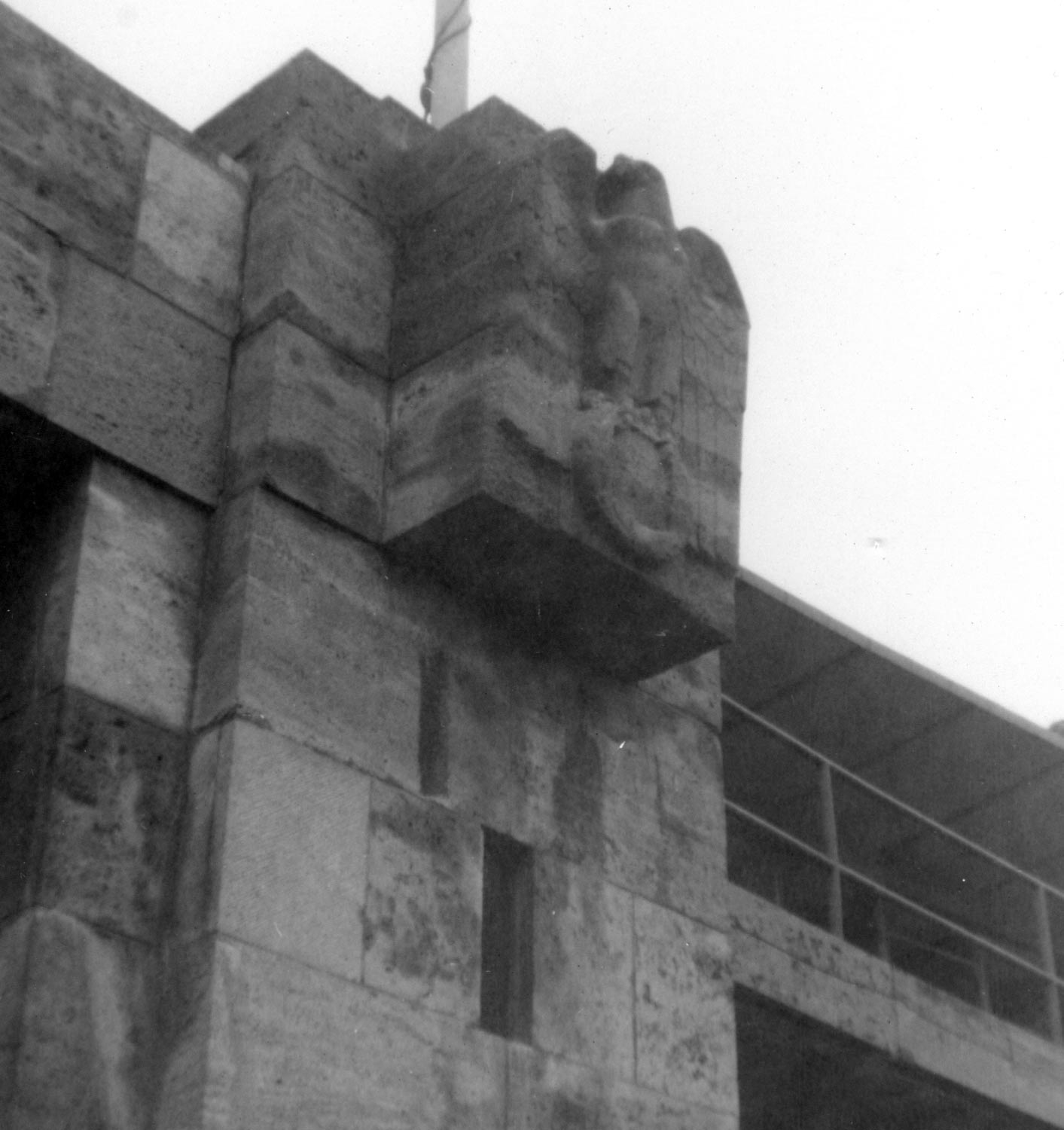
|
| Olympic Stadium Eagle
|
In Berlin I saw the not-yet-walled-off
Brandenburg Gate, the burnt-out Reichstag, the 1936 Olympic Stadium (where the
swastikas had been chiseled out from under the eagles), the Soviet War
Memorial, and Spandau Prison where Rudolf Hess, Albert Speer, and Baldur von
Schirach were serving their Nürnberg sentences (Karl Dönitz had been
released several years before; Speer was released in 1966 and published
"Inside the Third Reich"; after Hess died in 1987, the prison was demolished
to prevent it becoming a shrine). I saw the bust of Nefertiti at the Berlin
museum. I crossed into East Berlin by myself because my father couldn't go
there and bought some snacks at a Trinkhalle. I paid with Deutschmarks
and got change in Ostmarks made of
aluminum. In the Stadium photo I'm standing where Hitler stamped his
feet when Jesse Owens won the 100 meters.
Also see...
- Video:
Berlin 1945 in
color, Youtube (7 minutes, silent).
- Berlin
1961-62, photos from Robert Paul, a Frankfurt Elementary schoolmate
of my brother Dennis, who visited Berlin in
1961 and again in 1962 with his family.
- Stunde Null
(Zero Hour), early postwar Germany and Berlin, Wikipedia, accessed 25
February 2020.
- Book: Robert Grathwol and Donita Moorhus,
Berlin
and the American Military: A Cold War Chronicle,
New York University Press, Second Edition (1999).
- Book: Hildegard
Knef, The
Gift Horse, McGraw-Hill (1971). Life in Berlin in the Nazizeit and
the early postwar: an intense, fascinating, and unique narrative. Out of
print; used copies can be found at Amazon, Alibris, and EBay. It's better
in the original German, if you can read it (and find it),
as Der
Geschenkte Gaul.
- Hildegard Knef,
brief biography at the DEFA Film
Library at the University of Massachusetts.
- Book: Horst Bosetzky, Der
Kalte Engel – dokumentarischer
Kriminalroman aus dem Nachkriegs-Berlin, Berlin, Jaron Verlag
(2002). Highly detailed descriptions of 1949-50 East and West Berlin.
Also available in English as
Cold
Angel: Murder in Berlin 1949.
- Victor Grossman, The Wall 30 Years Later, November 2019. Was
East Germany really as bad as all that?
- Victor Grossman books,
a review by me of two books about East Germany by Victor Grossman.
- Trümmerfilm
(Rubble films), Wikipedia, accessed 25 February 2020.
- Film: Die
Die Mörder sind unter uns (1946), the first postwar German film and
the first Trümmerfilm (rubble film), shot in the Soviet Zone of Berlin and
starring Hildegard Knef and Ernst Wilhelm Borchert.
- Film: The
Big Lift with Montgomery Clift and Cornell Borchers, about the Berlin
Airlift, filmed in the rubble of West and East Berlin in 1950. It was
originally going to star Hildegard Knef, but Borchers was substituted at
the last moment for reasons Knef relates in her book.
- Film: The
Man Between, a British rubble film starring James Mason, Claire Bloom,
and Hildegard Knef. Filmed mainly on location in East Berlin in 1953
and directed by Carol Reed (who also directed The
Third Man),
- Film: One,
Two, Three with James Cagney and Horst Buchholz, filmed in
West and East Berlin in 1961, just before the Wall.
- Berlin's
battle scars remain 75 years after end of WWII – in pictures,
The Guardian, 8 May 2020.
- Joseph Kanon, The
Good German, Picador / Henry Holt and Company, 2001: 482 pages of total
immersion in Berlin just after the European war ended in 1945; see the New
York Times review. It was made into a film of
the same name in 2006 that looks like it was filmed on location in 1945
but that twists the plot and characters beyond recognition.
Bavaria and Austria
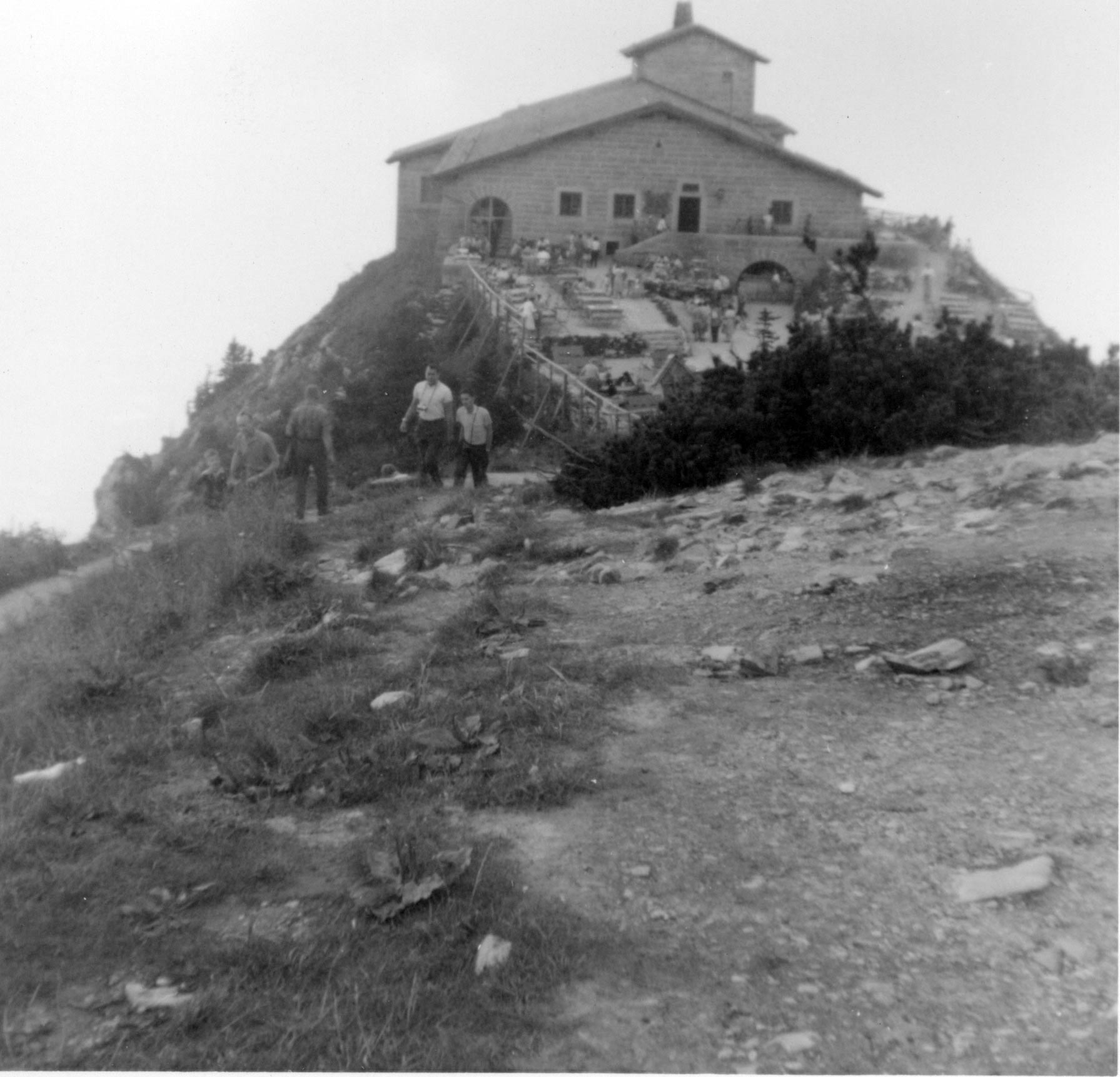
|
| Kehlsteinhaus 1959
|
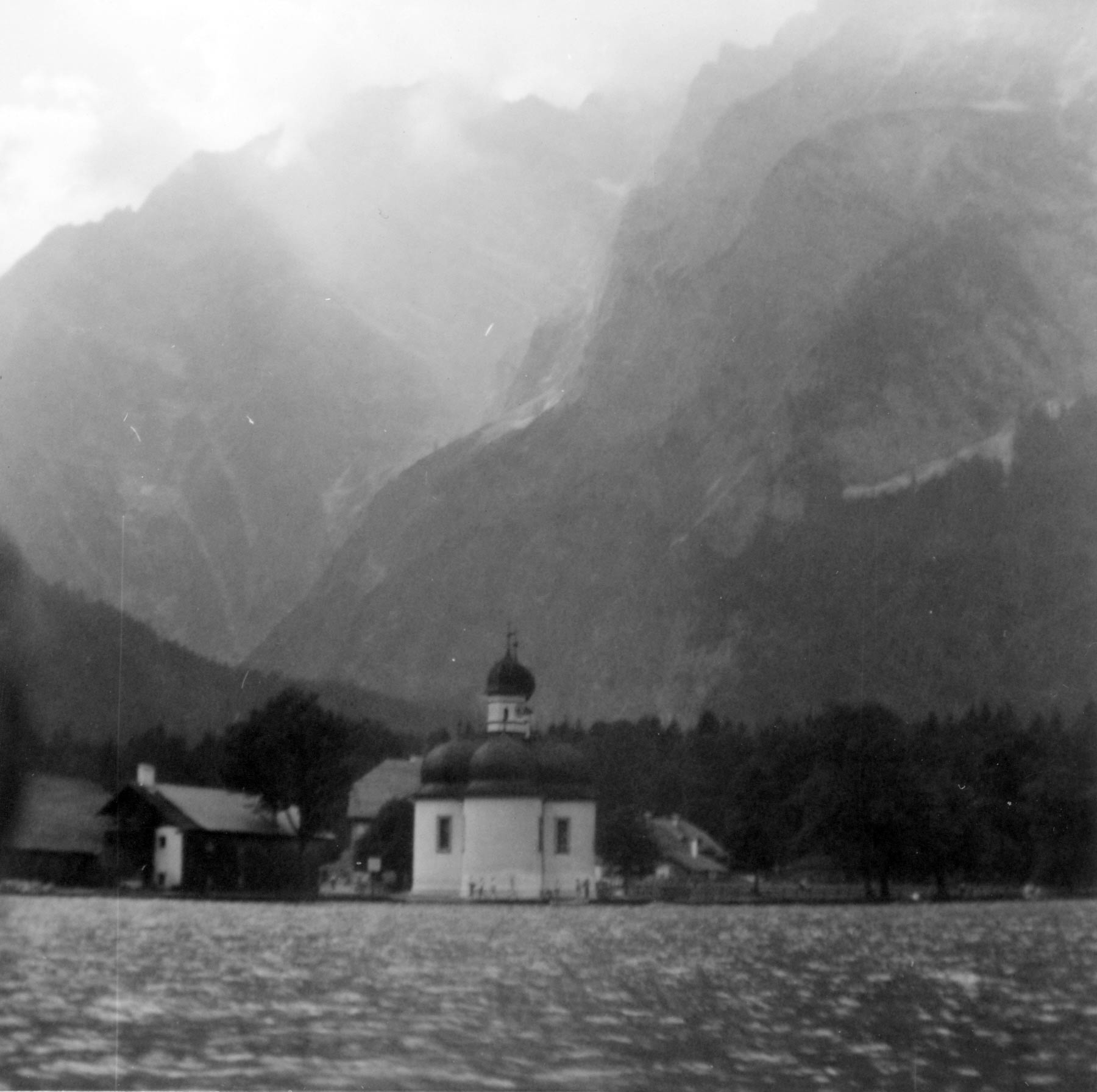
|
| Koenigsee St. Bartholmä
|
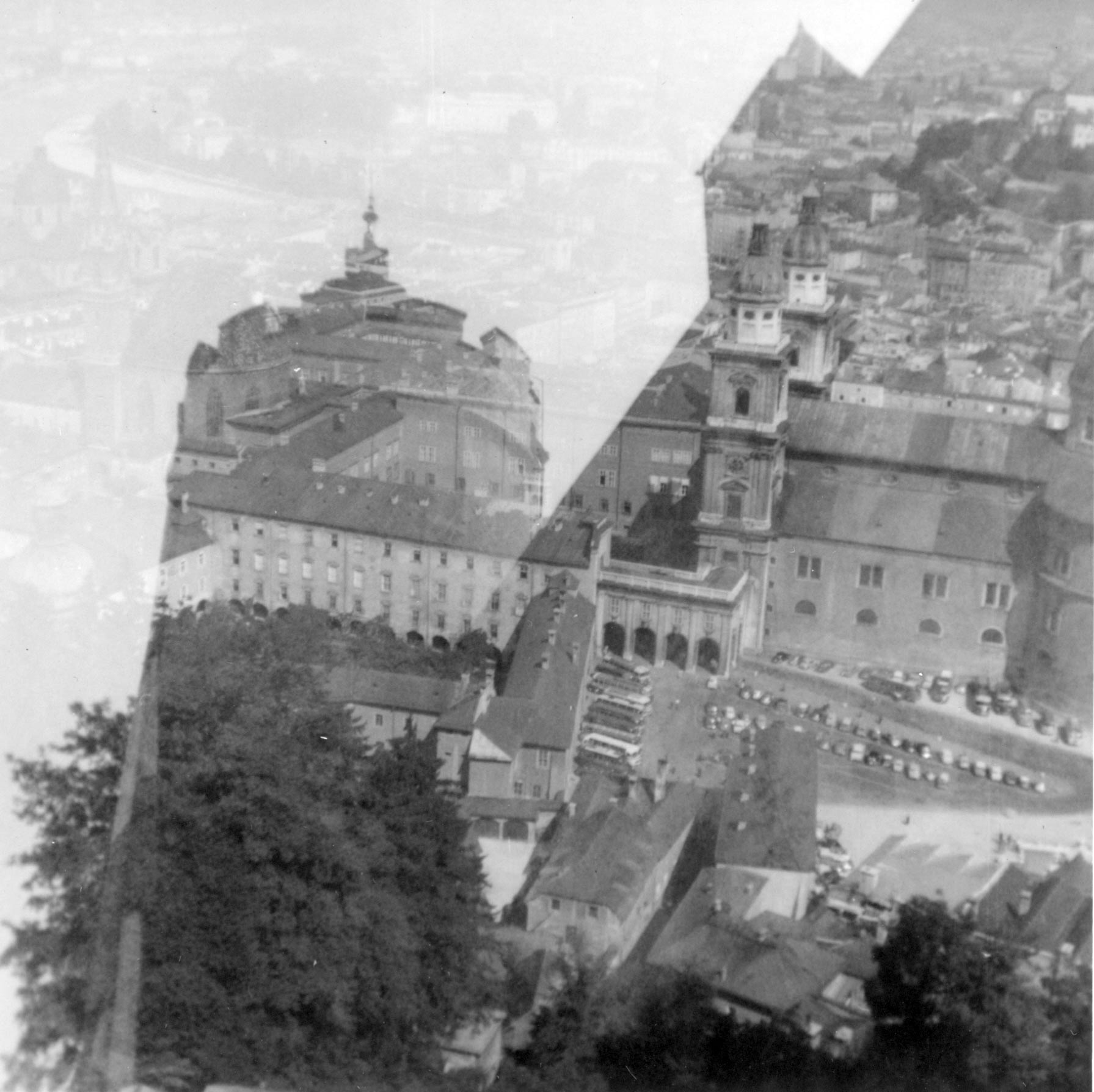
|
| Salzburg double exposure
|
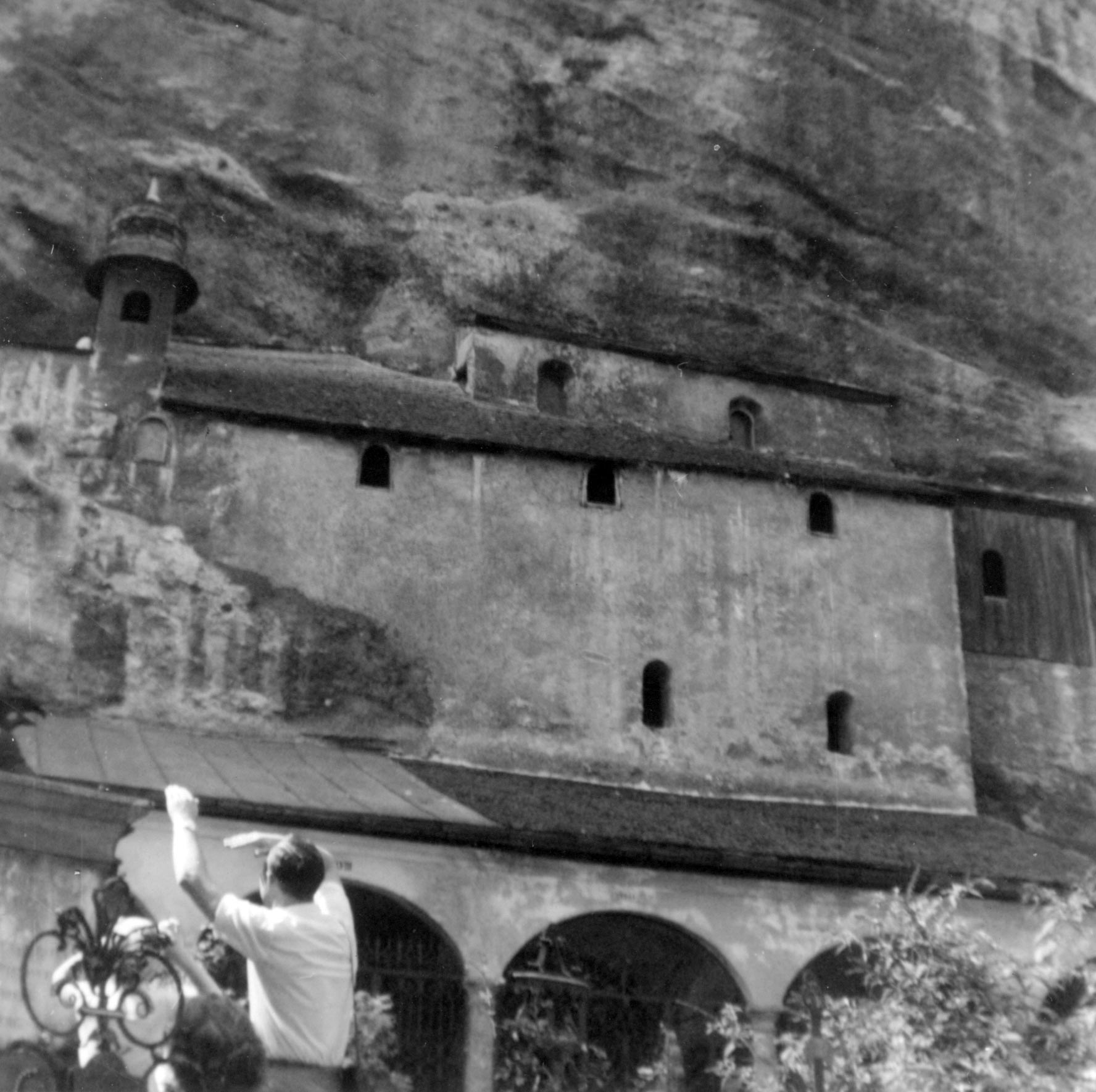
|
| 1200-year-old church
|
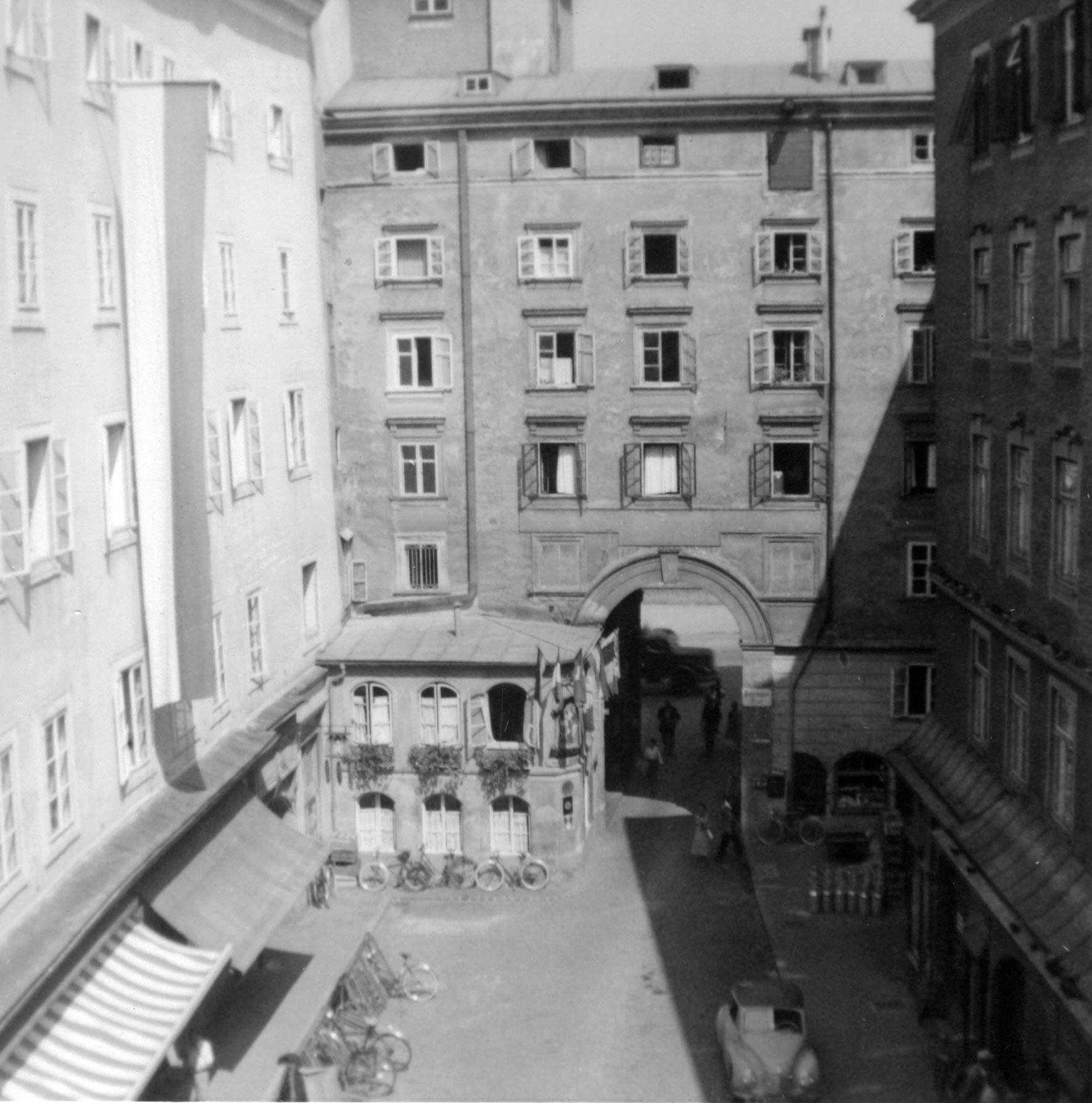
|
| Out Mozart's window
|
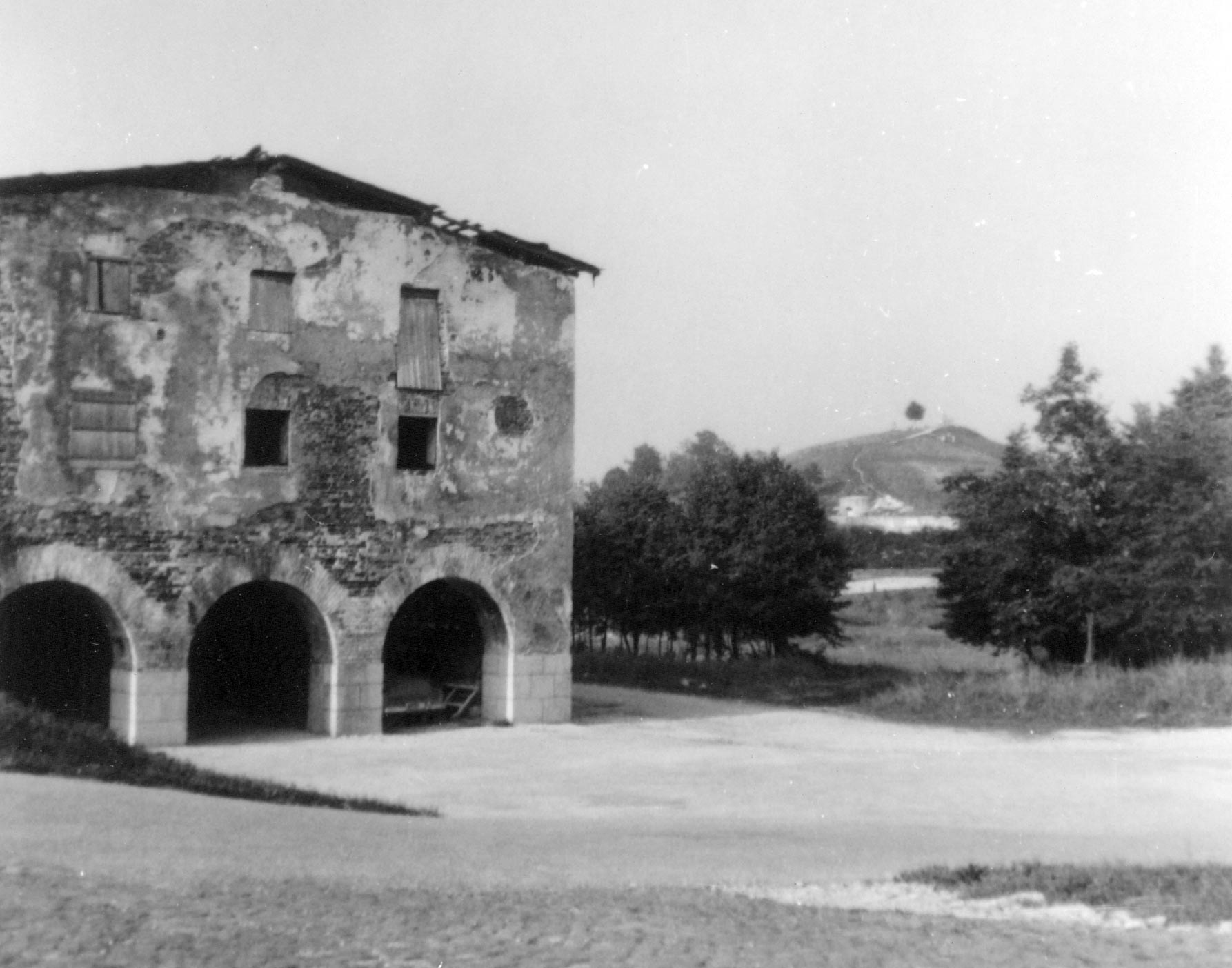
|
| Nazi ruin Berchtesgaden
|
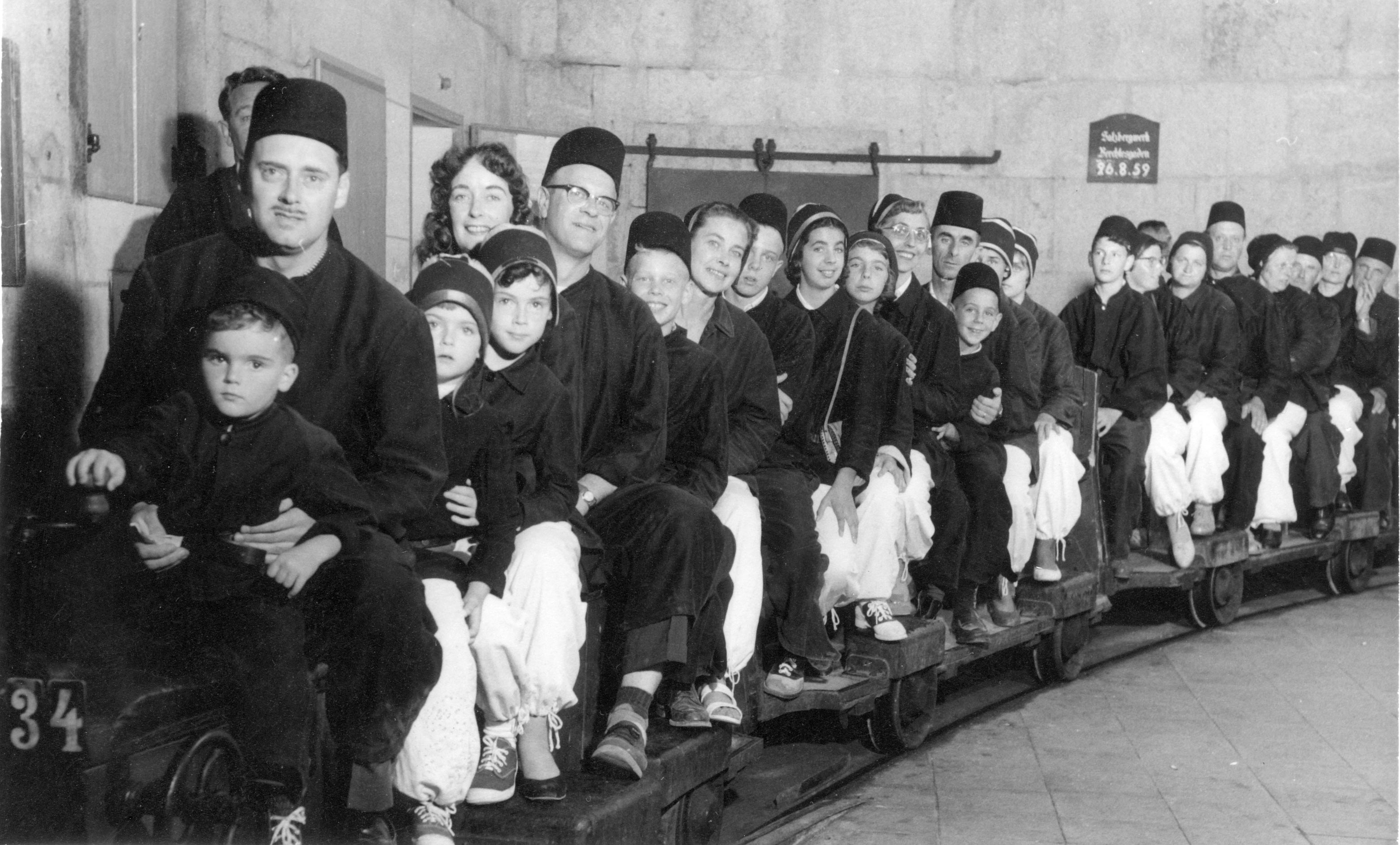
|
| Us at the Obersalzberg salt mines
|
High in the Bavarian Alps, Berchtesgaden and
Obersalzberg where we saw the ruins of recently blown-up houses of
Hitler, Goering, and Bormann, along with their secret bunkers and tunnels,
Hitler's Kehlsteinhaus (Eagle's Nest), from there to Salzburg in Austria to
see Mozart's birthplace, with a stop in the salt mines that you enter by
sliding down a wooden ramp about a mile long.
Holland
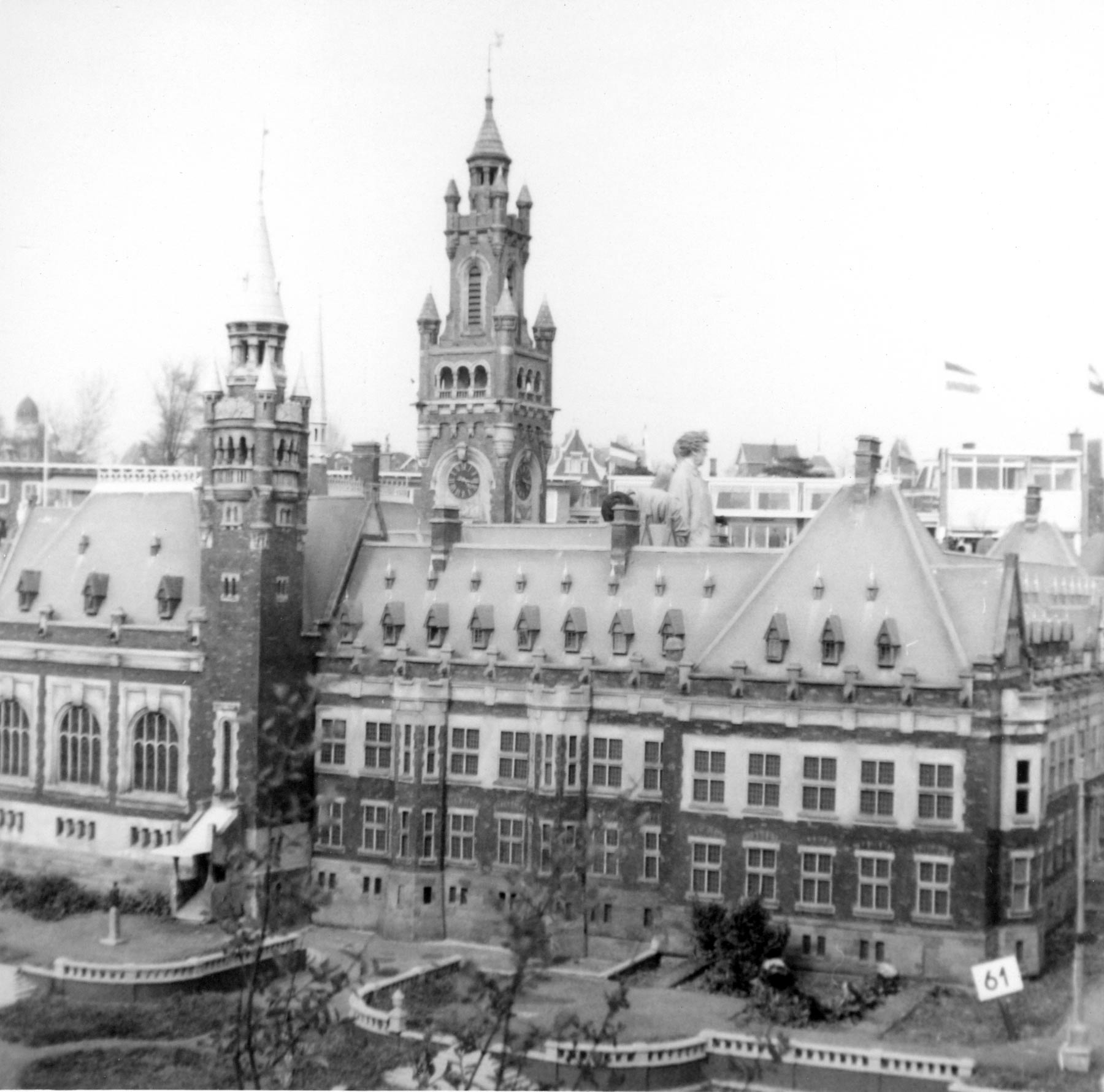
|
| Madurodam
|
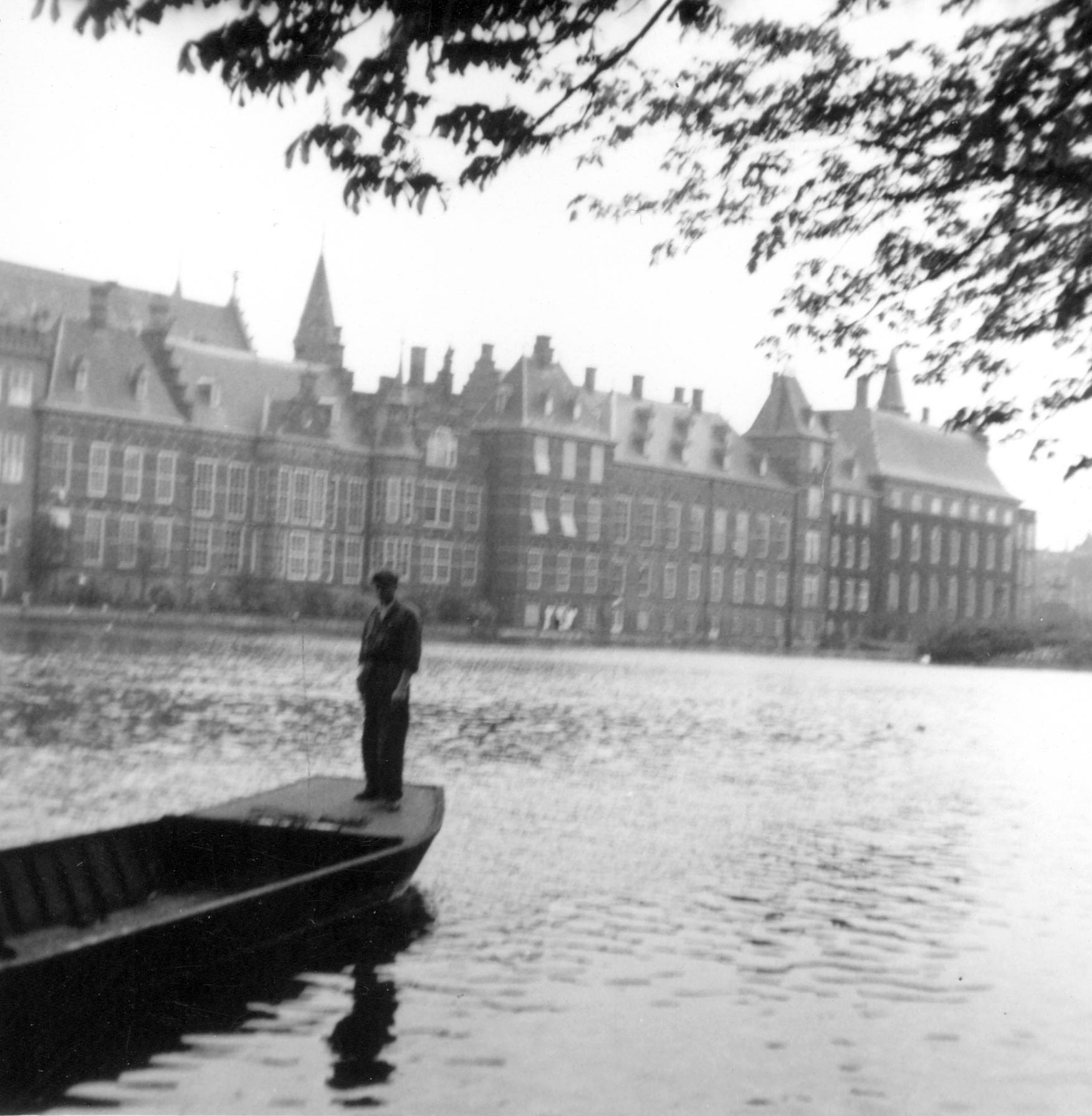
|
| The Venice of the North
|
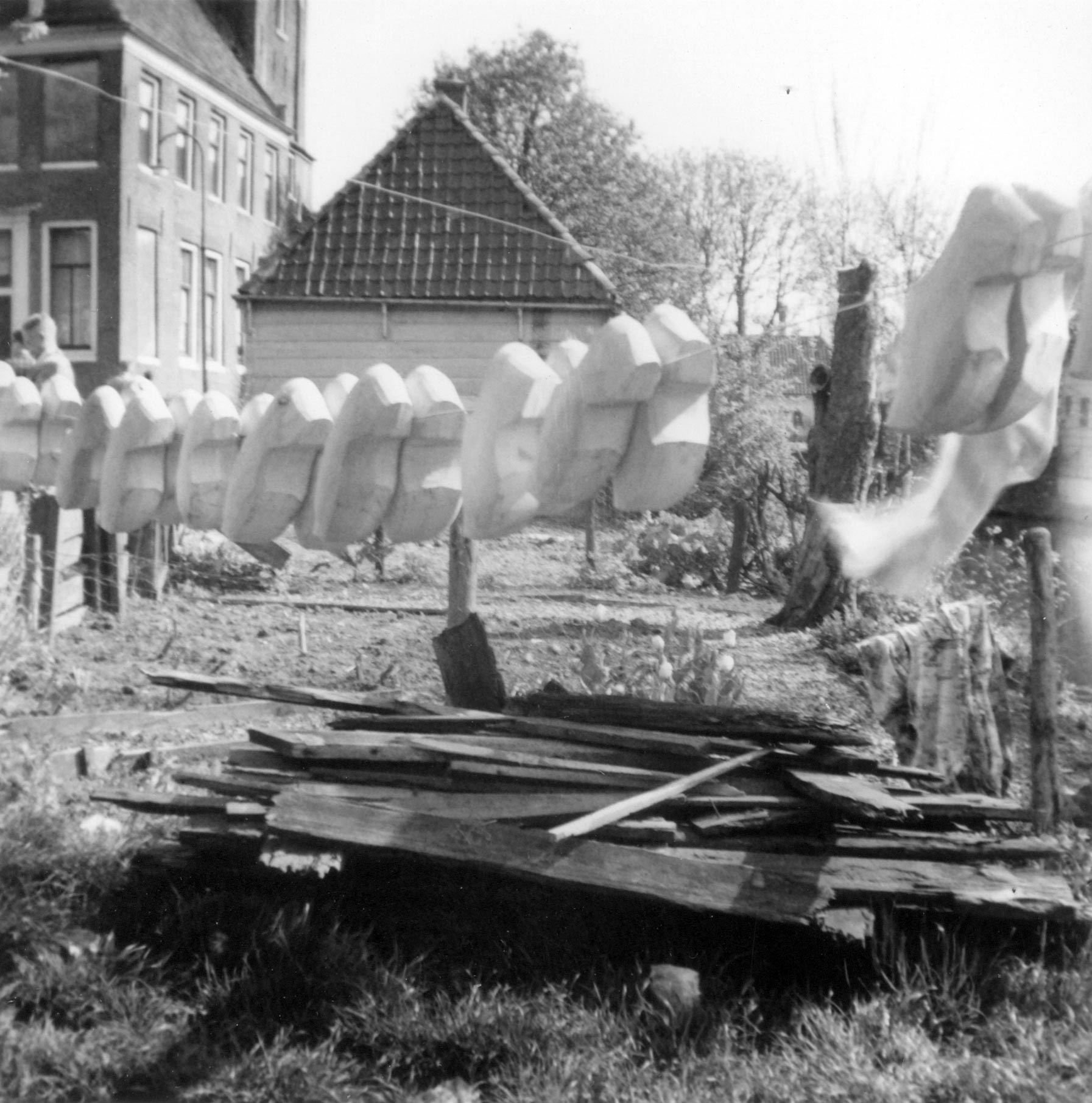
|
| Wooden shoes
|
Once my Mom took me and Dennis to Holland on a bus tour, that was the only
time she ever did anything like that, being in charge on her own. Aside
from that, Bonn (to see the birthplace of Beethoven, my dad's idol), plus
countless castles and museums all over Germany. Neverending castle visits
are pretty boring for teenagers. The Holland trip was kind of cool though;
click on the Madurodam picture to enlarge it and look at it until you notice
something odd.
About Holland… It was the first place I ever saw besides Army bases
that was totally diverse. The parks were full of children of all races
playing together, everybody intermarried, etc. I thought it must be the
most progressive, enlightened place on earth, and maybe it was. Until it
became the first capital of Islamophobia in the 2000s.
Evacuation Dry Run
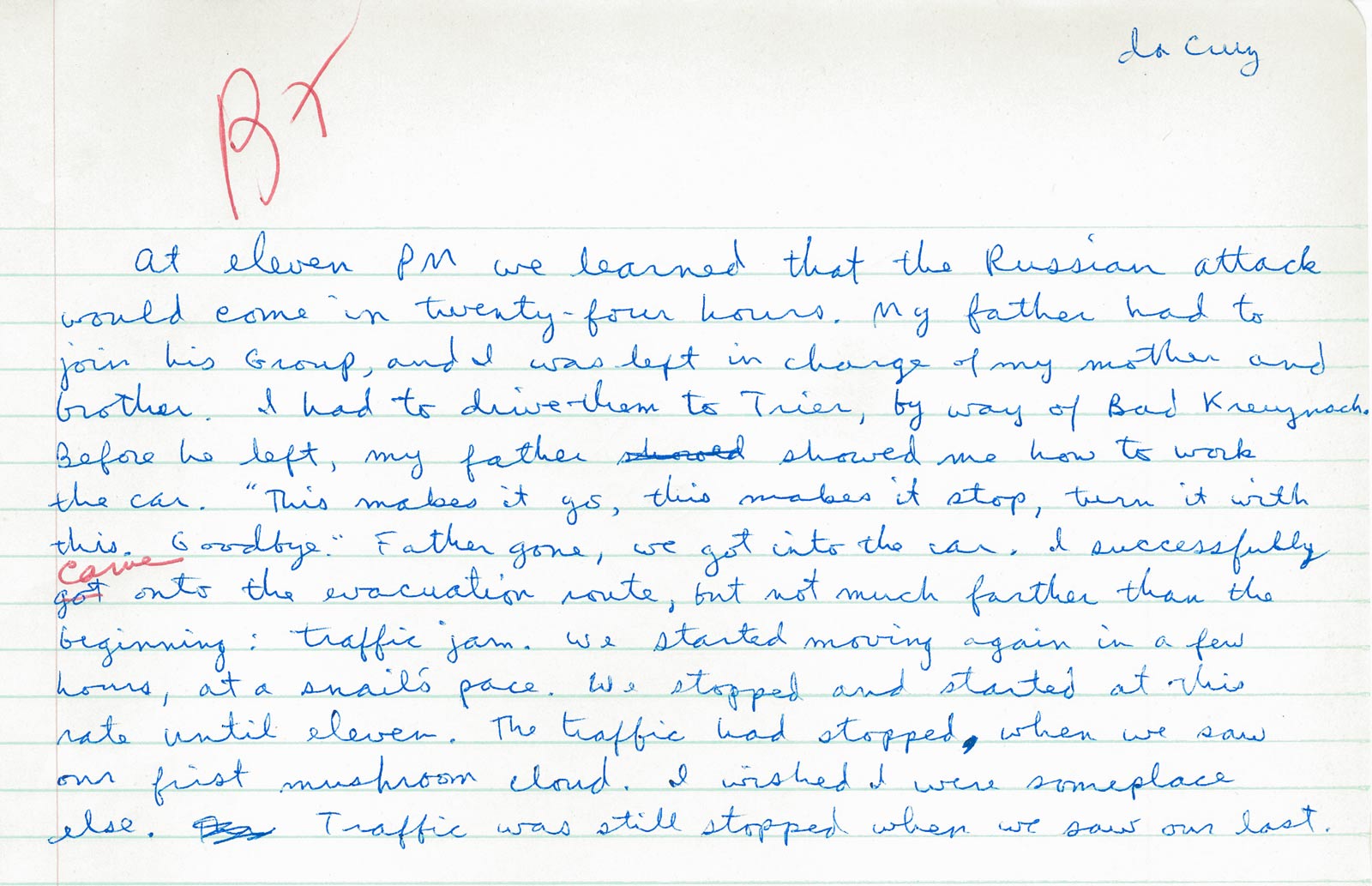
|
| Evacuation story 1960
|
Another trip we took was a mandatory one for every Army family: a practice
run for evacuating from Germany in case of a Soviet attack. You have to
leave at an appointed time and only then do you find out the route and
destination. It was on back roads, not the Autobahn, so it's hard to
imagine all the 100s of thousands of American families trying to get out at
once. Anyway we drove almost all the way to France on picturesque two-lane
country roads. Still, this was 1960 and we were always expecting to be
vaporized at any moment, hence my little Creative Writing story at right.
Hamburg...
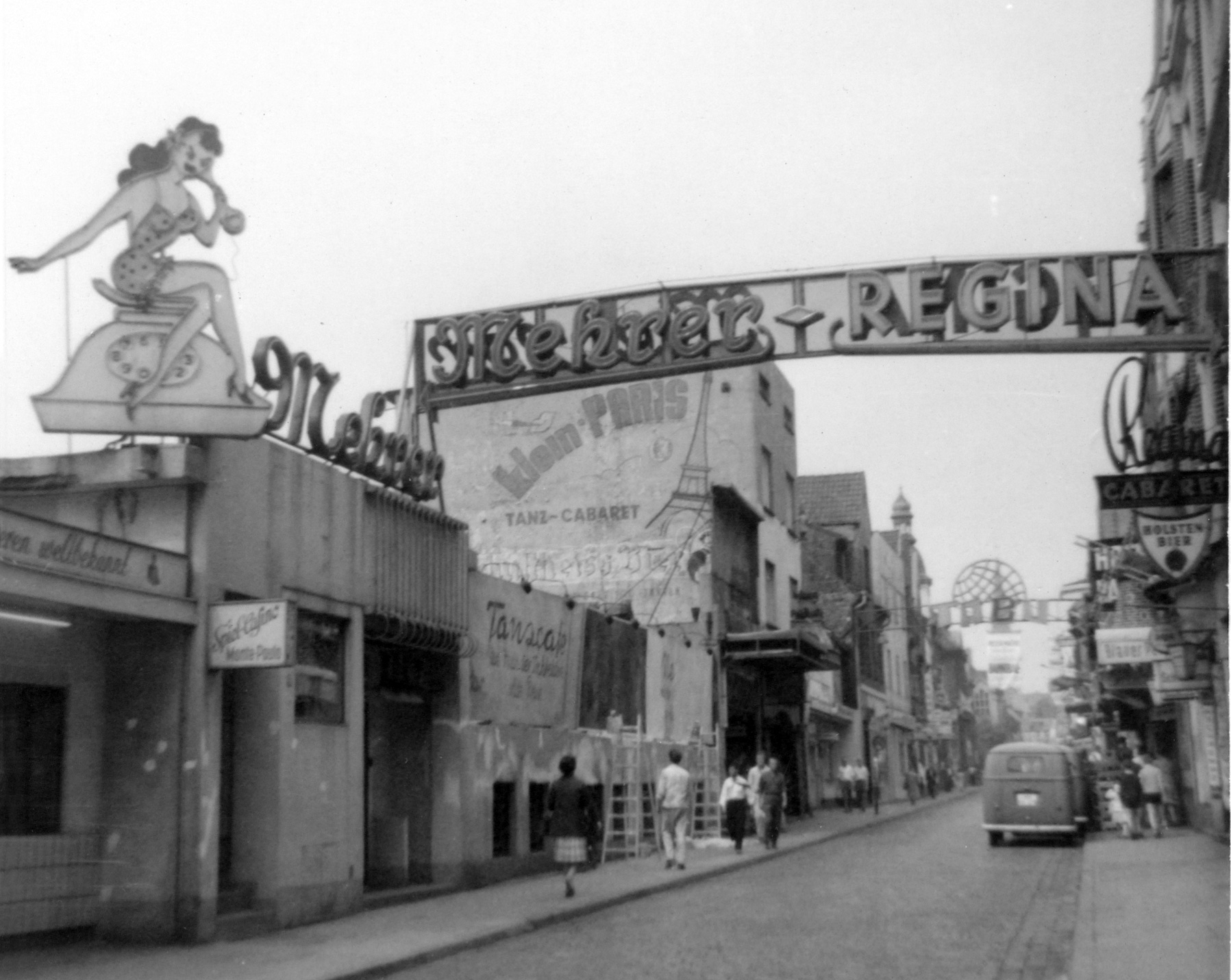
|
| Die Große Freiheit, Hamburg 1960
|
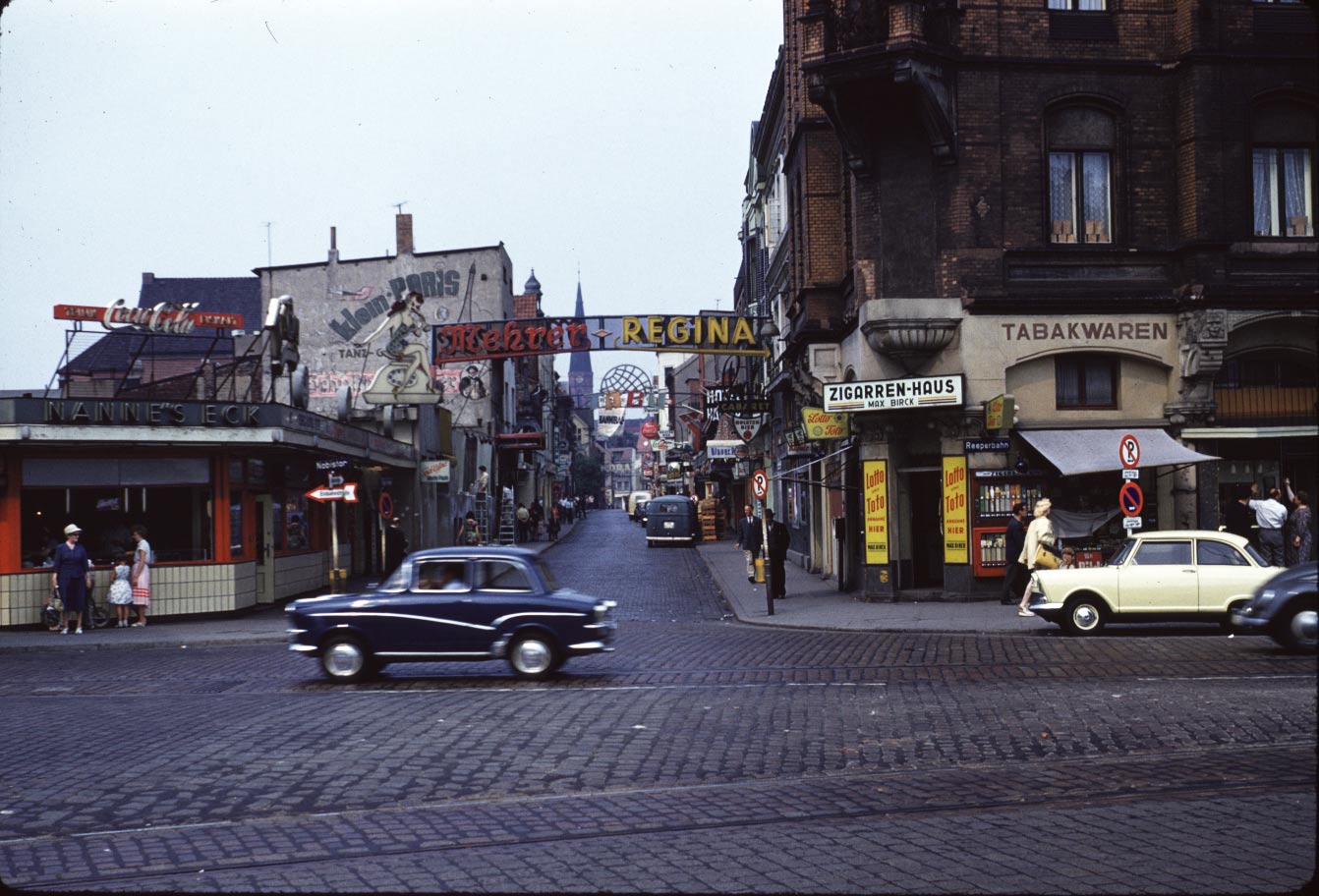
|
| Another view of "Beatles Street"
|
But our most epic trip — 2000 miles driving! — started with
Hamburg (300 miles from Frankfurt), where I took a famous picture (left) of
the street where the Beatles were playing before I had even heard of them
(the photo has since been used in some books*); this was in the
Reeperbahn district of Hamburg on the street called Die Große Freiheit. The
color photo was taken by my dad at the same time; I include not only because
it's clearer and higher resolution, but it's taken from an angle where the
sign for the Beatles' first Hamburg spot, the Indra Club*, is visible
towards the end of the street (click on the photo to enlarge it). They had
only started playing there a few days before. He took us to the Reeperbahn
not because of the Beatles, obviously, but because this is one of the places
he came for sex while in the Navy.
...and Scandinavia
[
See Norway gallery ]
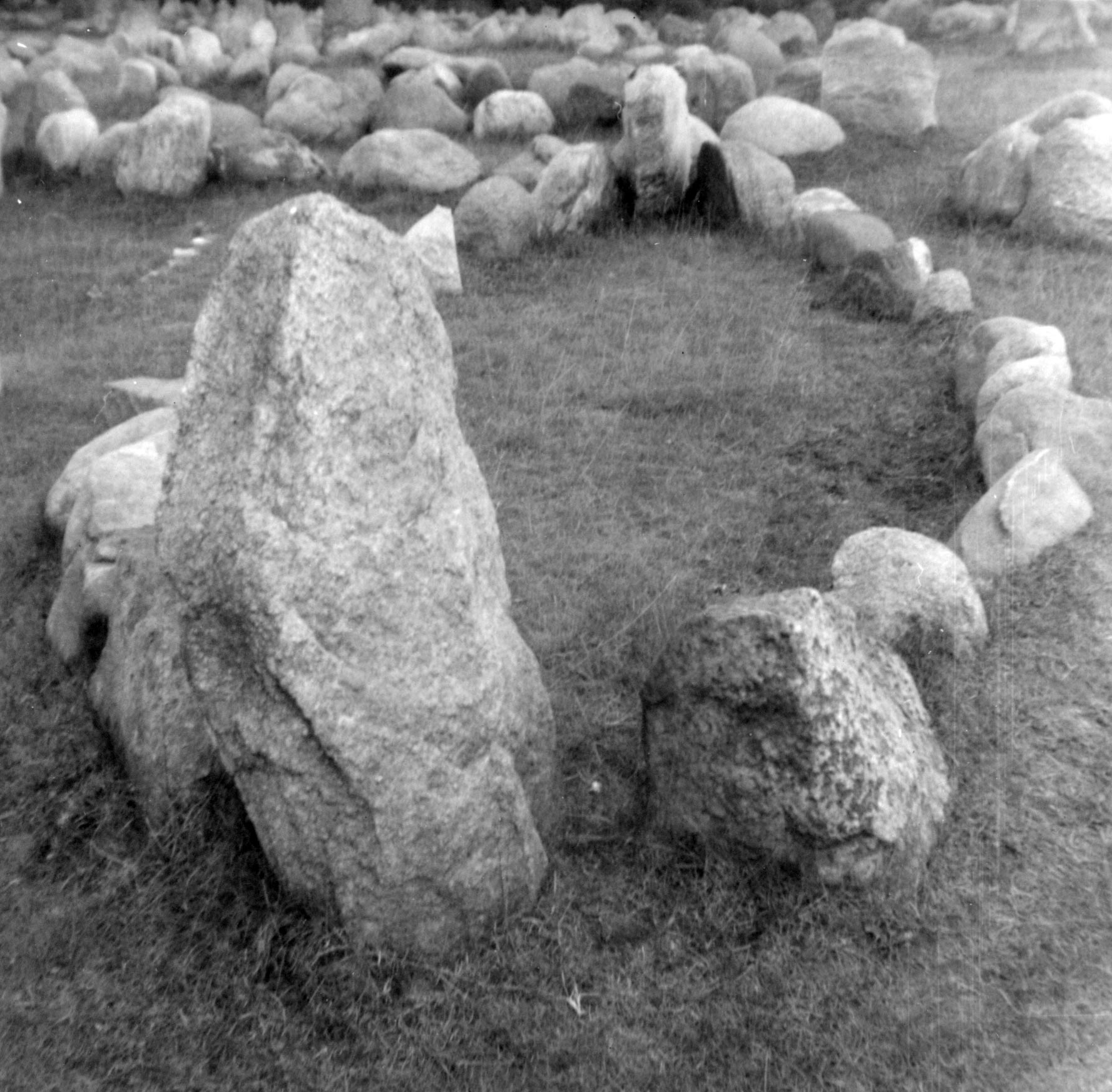
|
| Aalborg Viking rocks
|
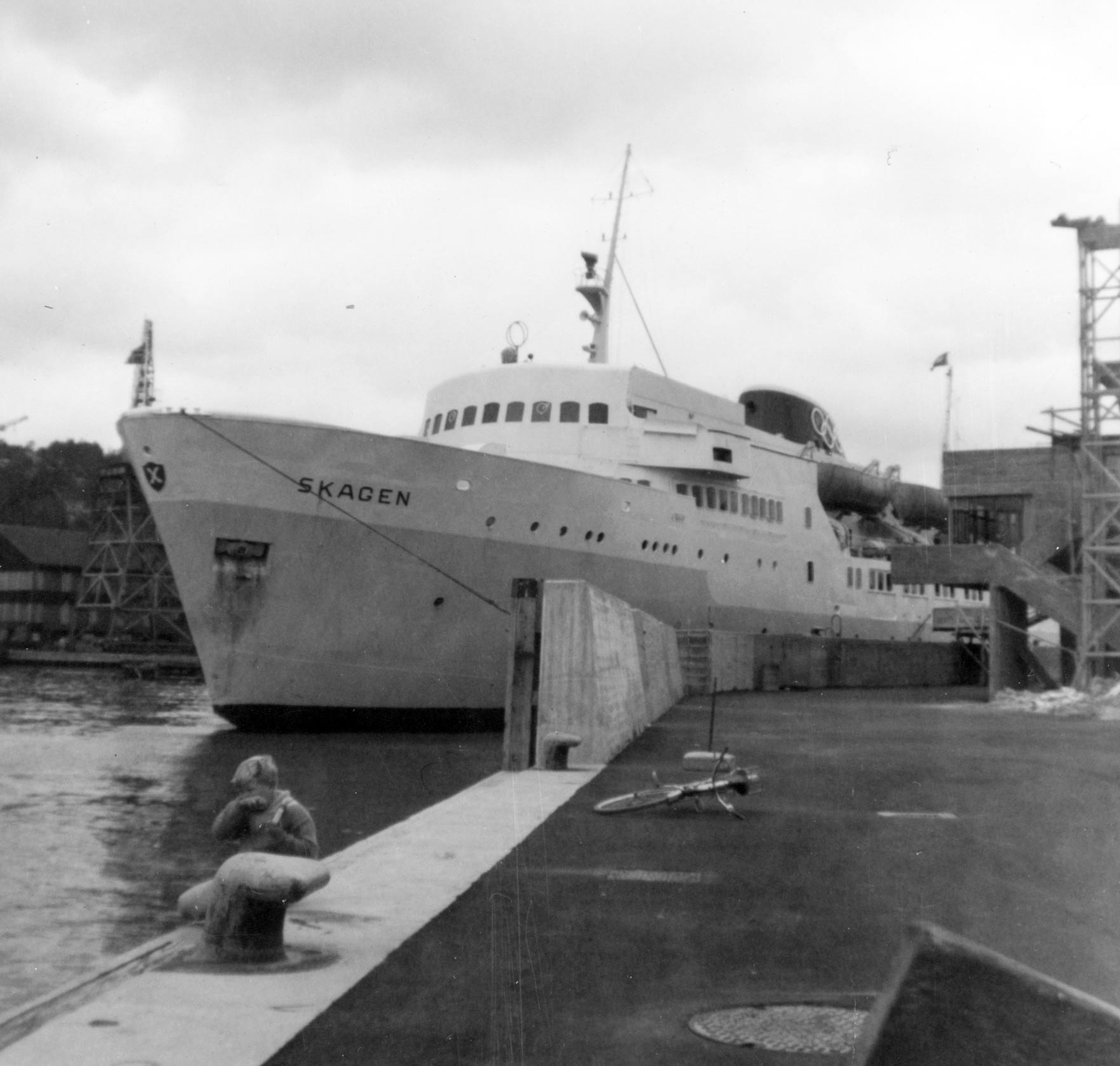
|
| Hirtshals, the ferry Skagen
|
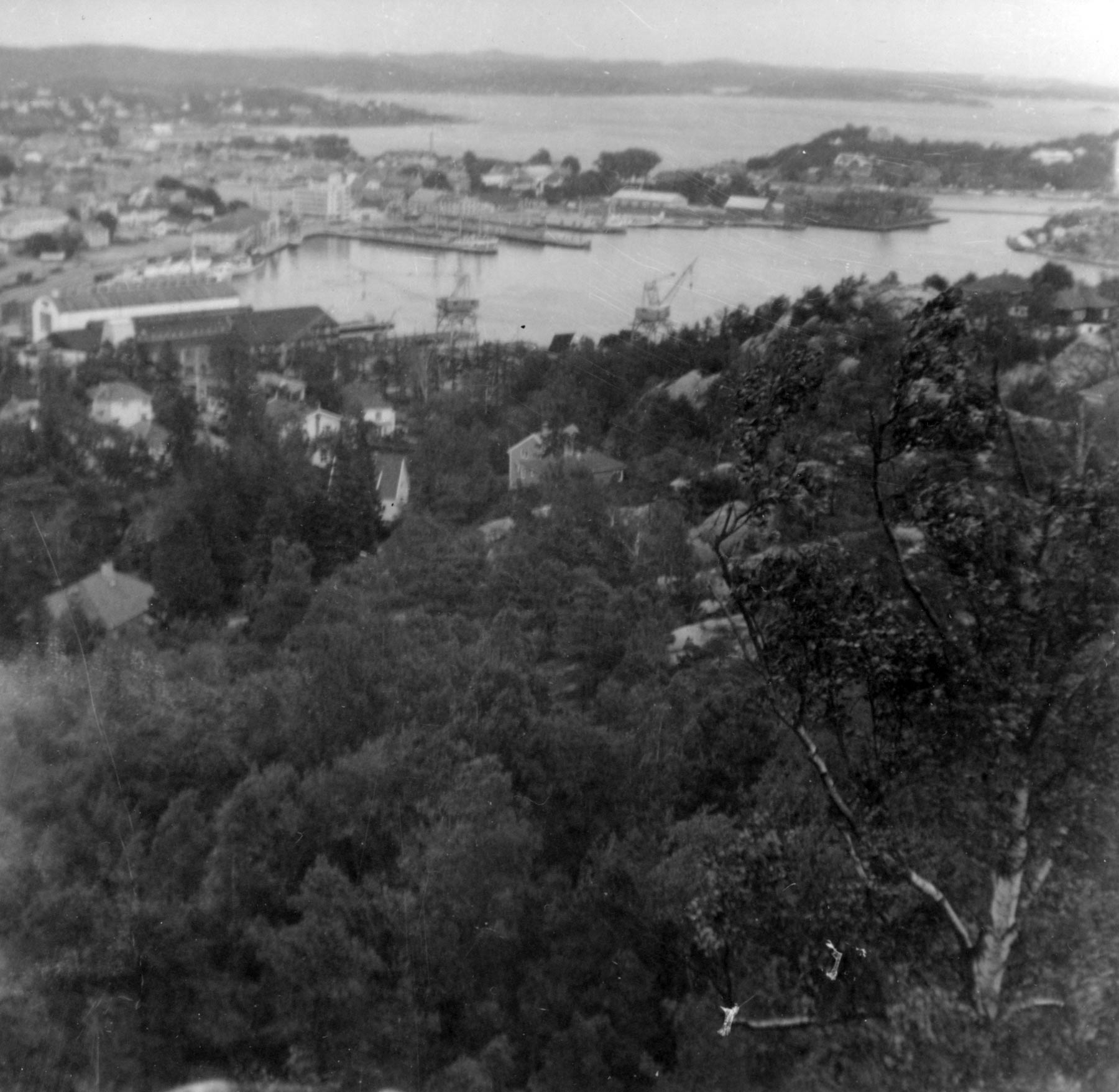
|
| Kristiansand Norway
|
Then up through Denmark — Aarhus, Aalborg... In one of these
"Aa" towns we stayed at a small family hotel where my father told the owner
that I played the guitar which prompted him to give me a huge pile of
classical sheet music (with swastikas on every page).
From
Hirtshals — the very
tippy-top of continental Western Europe — a four-hour ferry ride to
Kristiansand, Norway... It was dark and cold and foggy so my family stayed
inside but I was on deck at the rail, there was a girl there about my age
and we tried finding a common language for communicating... Not Danish, not
German, not English... Russian! A fleeting moment in life. We landed in
Kristiansand about 8:00pm on a Saturday night and the place was totally
dark, everybody was asleep, not even the street lights were on. No signs on
anything either. We had to bang on doors until somebody told us where to
find an inn, Mom remembered her Norwegian a little bit, then we banged on
the inn door and the grumpy inkeeper came down carrying a candle and wearing
one of of those sleeping costumes like in Dickens movies.
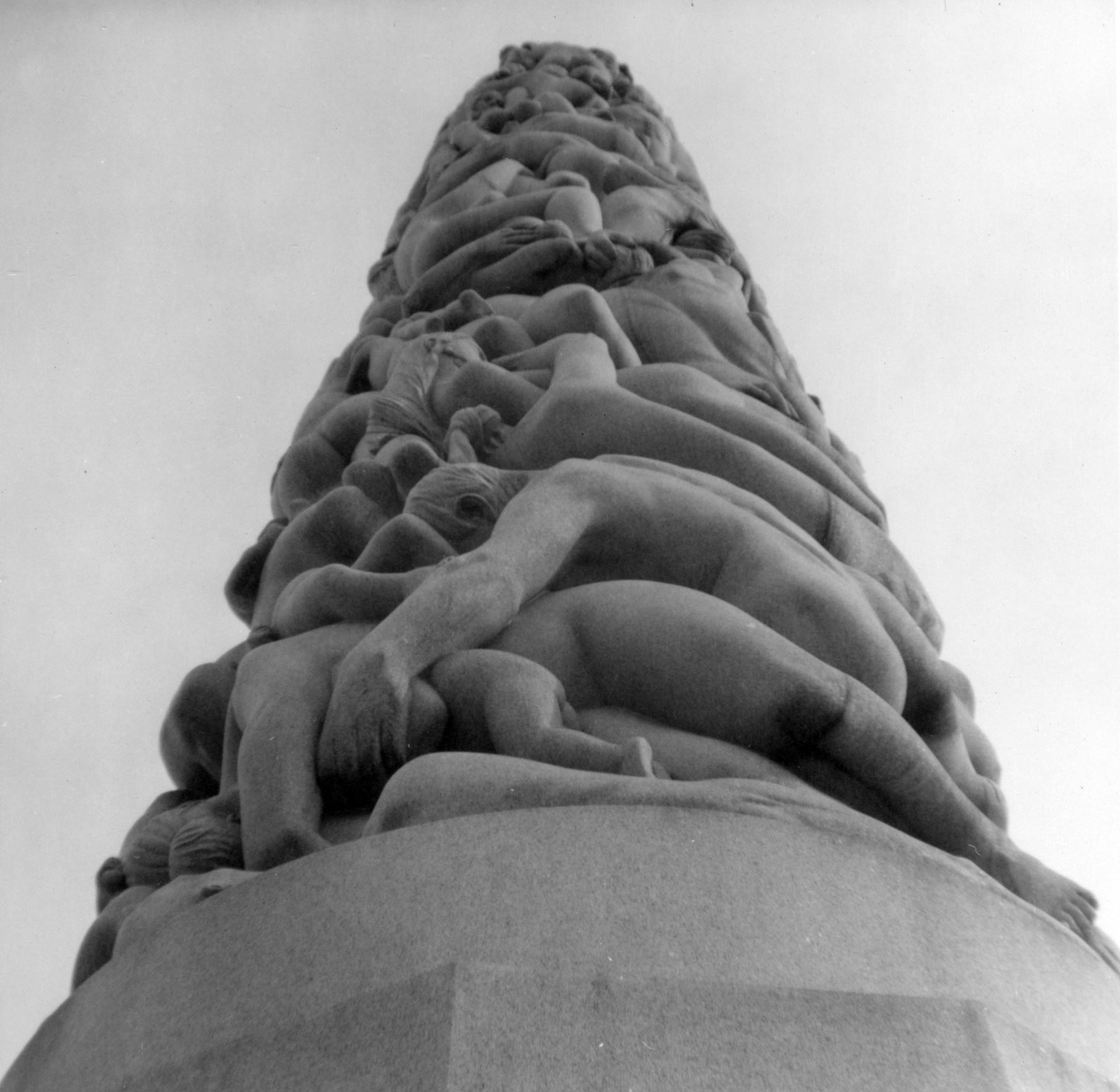
|
| Frogner Park, Oslo
|
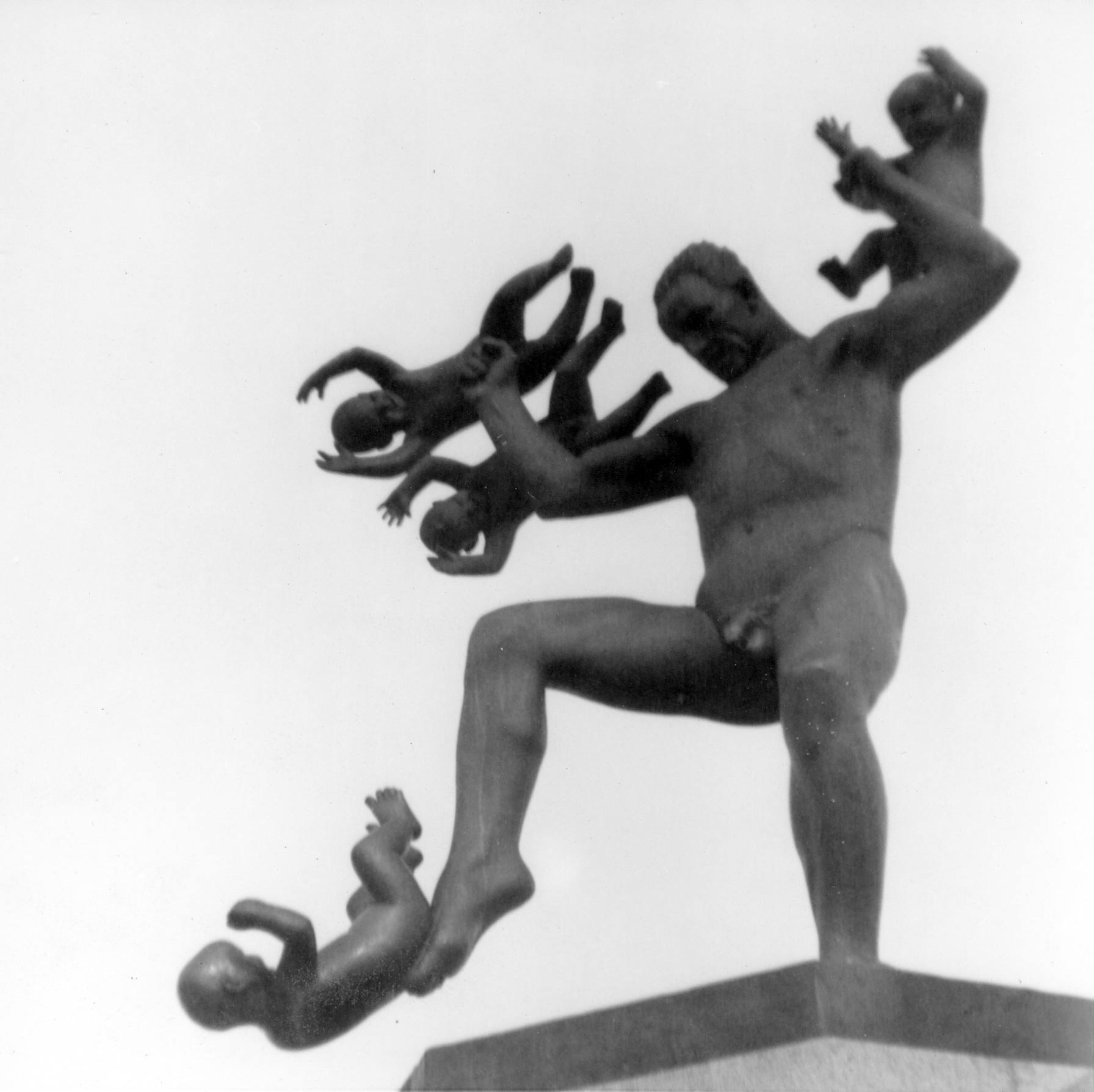
|
| Frogner Park
|
We visited lots of spots in the countryside... Arendal, Brevik, Larvik,
Drammen... as well as Oslo, spent almost a whole day in Frogner Park
with the surreal statuary of
Gustav Vigeland.
From Oslo to Sweden on the
only connecting road at the time, a one-lane dirt road through the mountains
and forests (at one point we met a car coming in the opposite direction, and
as there was no shoulder we had to back up several miles before it could
squeeze past us). In Sweden we visited Jönköping, Linköping, Örebrö,
Stockholm, and Nyköping (in that order I think) and spent a lot of Kroner
and Øre, and learned that if we got into an accident and were lying in the
ditch we had to holler "Hjeyelp, Hjeeyelp!", which Dennis and I did at every
road stop. In those days hotels in Europe were mostly pensions, family-run
small establishments and the rooms did not have baths; normally one bathroom
was shared by all the rooms on each floor, or even the whole building.
Furthermore, the shared bathroom didn't have a shower so bathing meant,
literally, taking a bath. Inevitably, other guests would be pounding on the
door the whole time.
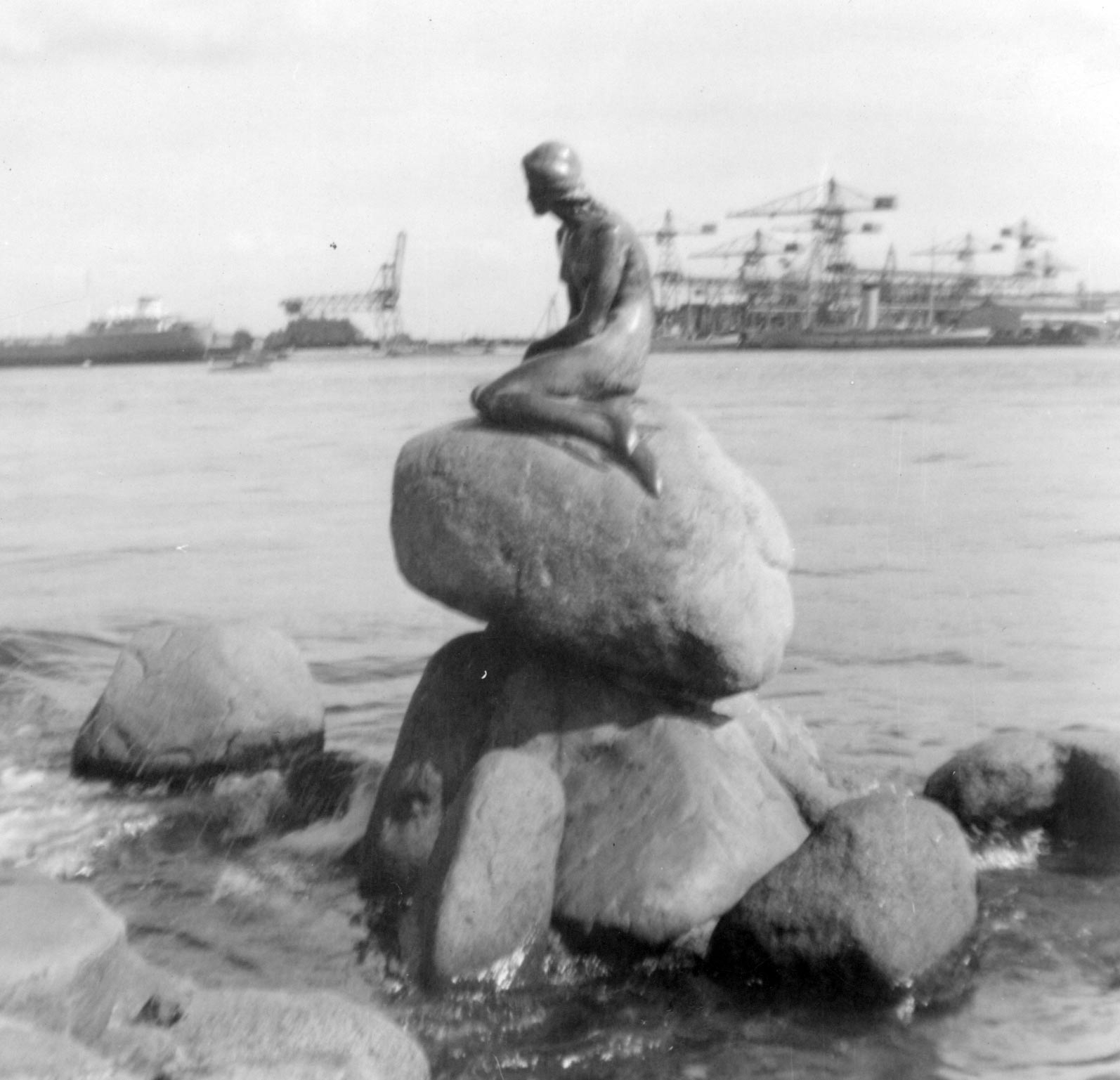
|
| Little Mermaid Copenhagen
|
The Scandinavia trip was an adventure… it was the first time I ate
yogurt, or even heard of it. Besides that the only good thing I had to eat
was big bowls of berries with milk — blackcurrants, lingonberries,
bright-orange cloudberries… One restaurant we went to, what they
brought to eat when we asked for a "sandwich" (the only word we could say
that they understood) was a slab of black bread with a raw whole fish on it,
with a raw egg over the fish and whole peppercorns embedded in the egg
slime. I couldn't imagine taking even one bite. My mom ate it though,
scales, bones, teeth, eyeballs, and all. It's how she grew up; she never
wasted food. Anyway, she liked it.
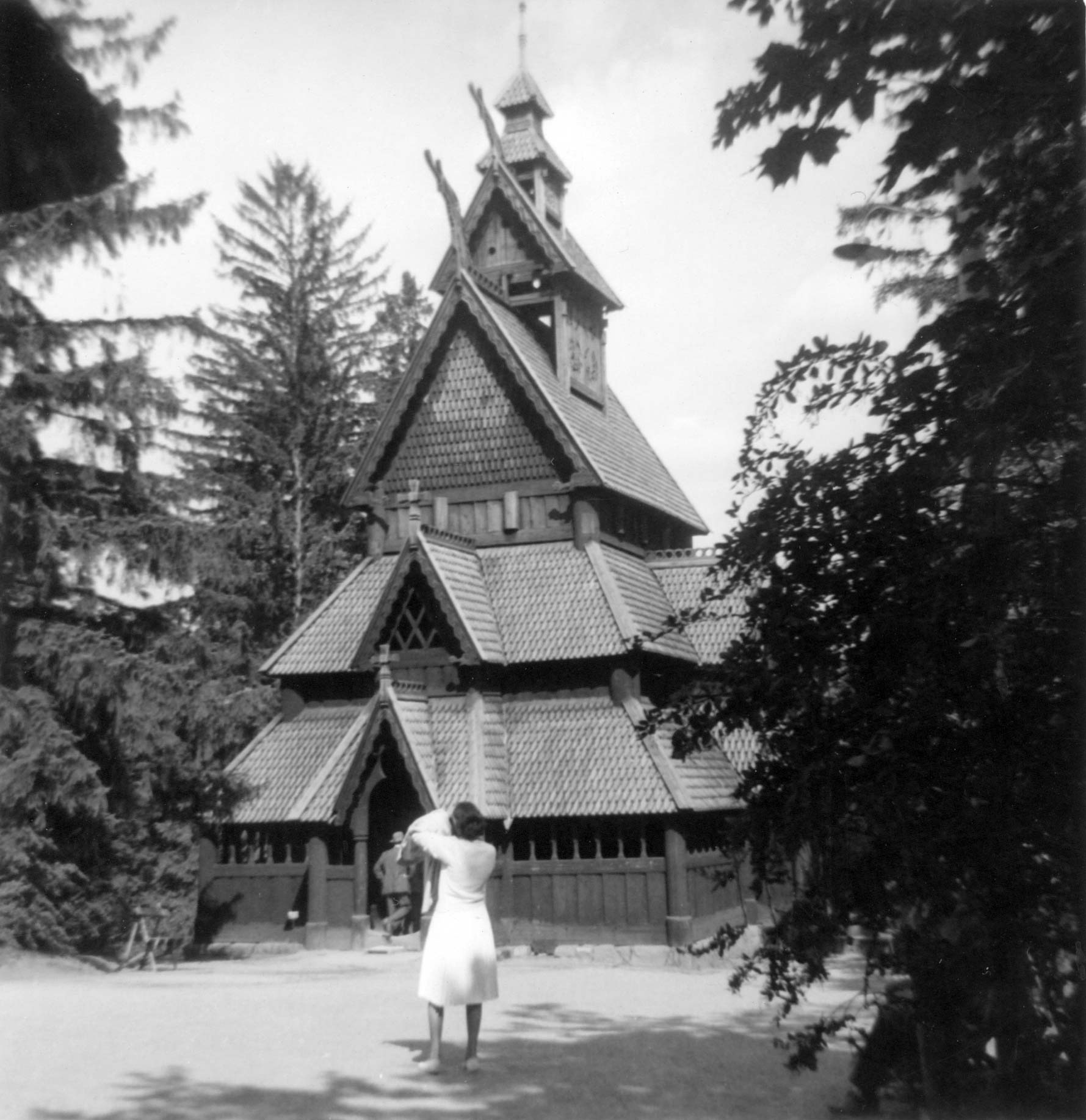
|
| Stave Church
|
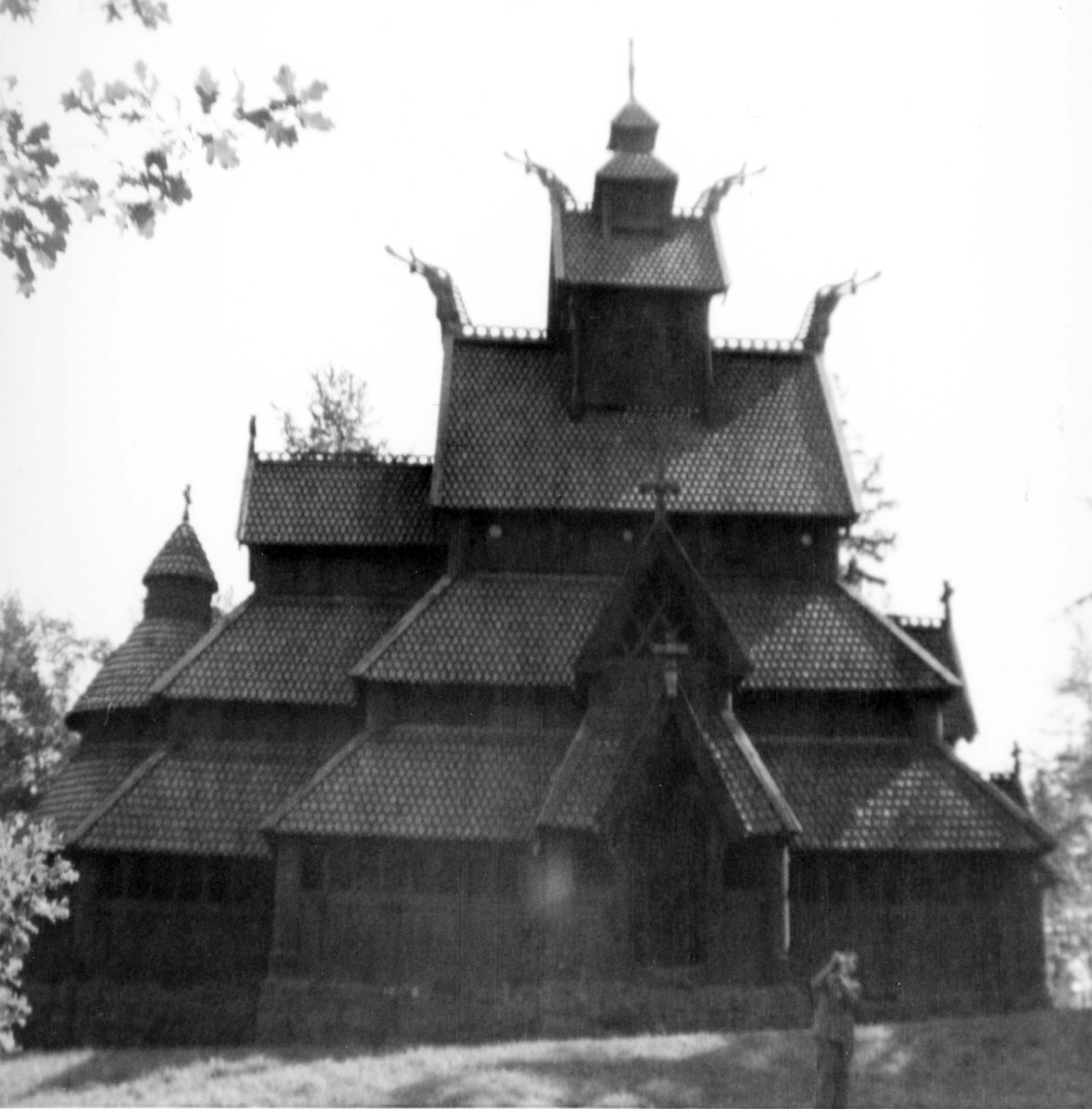
|
| Stave Church side view
|
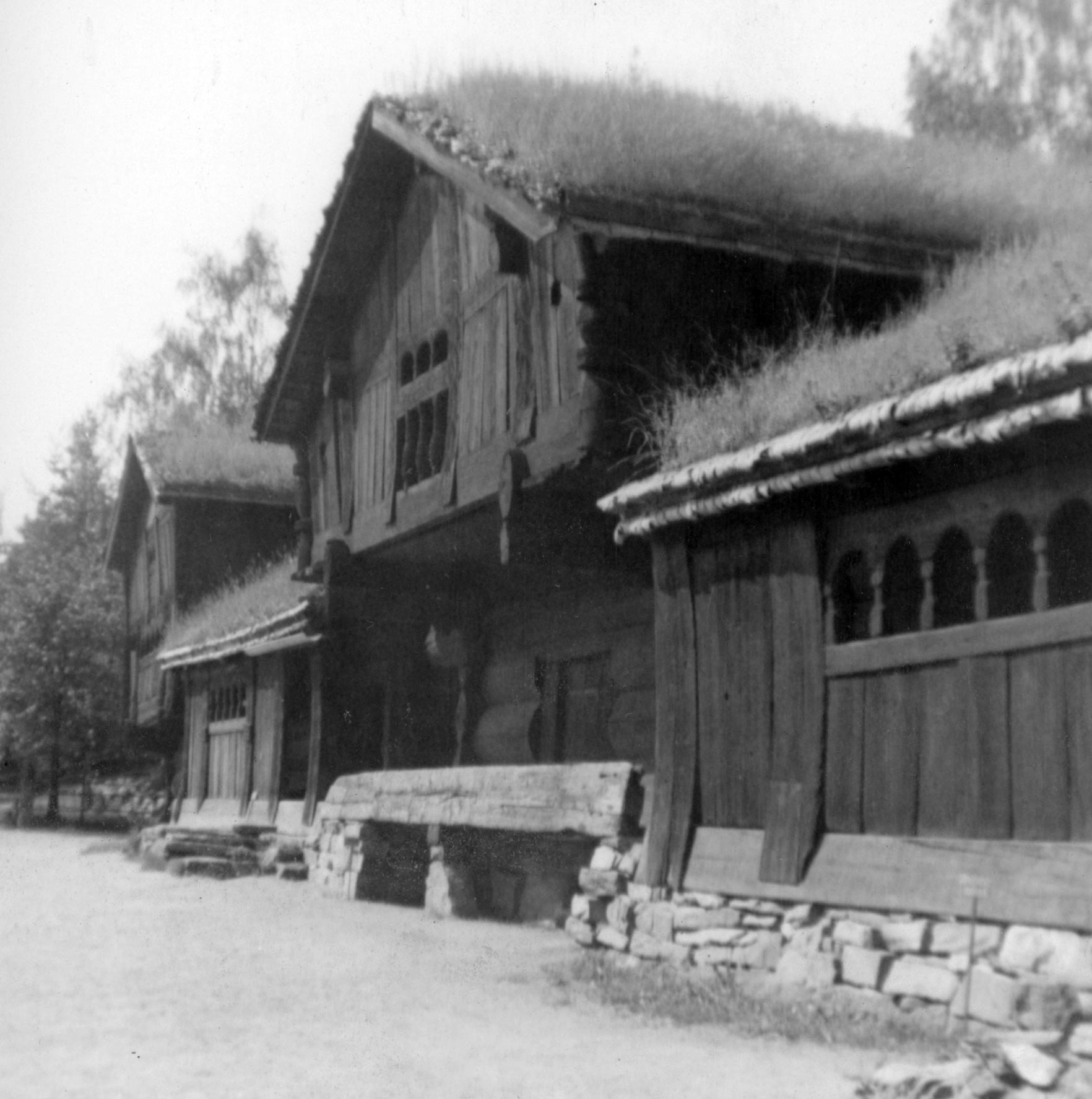
|
| Houses with sod roofs
|
In Norway Mom mostly wanted to see the countryside because her family
were peasants and she heard lots of stories passed down from her
grandparents. We saw the wooden Gol stave church (stavkirke), built
about 1200; it impressed me a lot, it looks like cross between a Chinese
pagoda and huge Viking ship and it was amazing to me that wood can last so
long. Perhaps because stave churches are built without nails. Elsewhere we
saw houses with sod roofs (pictured), but not the ones with flowers and
shrubs growing on top and goats up there grazing, like she had always told me
about.

|
| Oslo Olympic ski jump
|
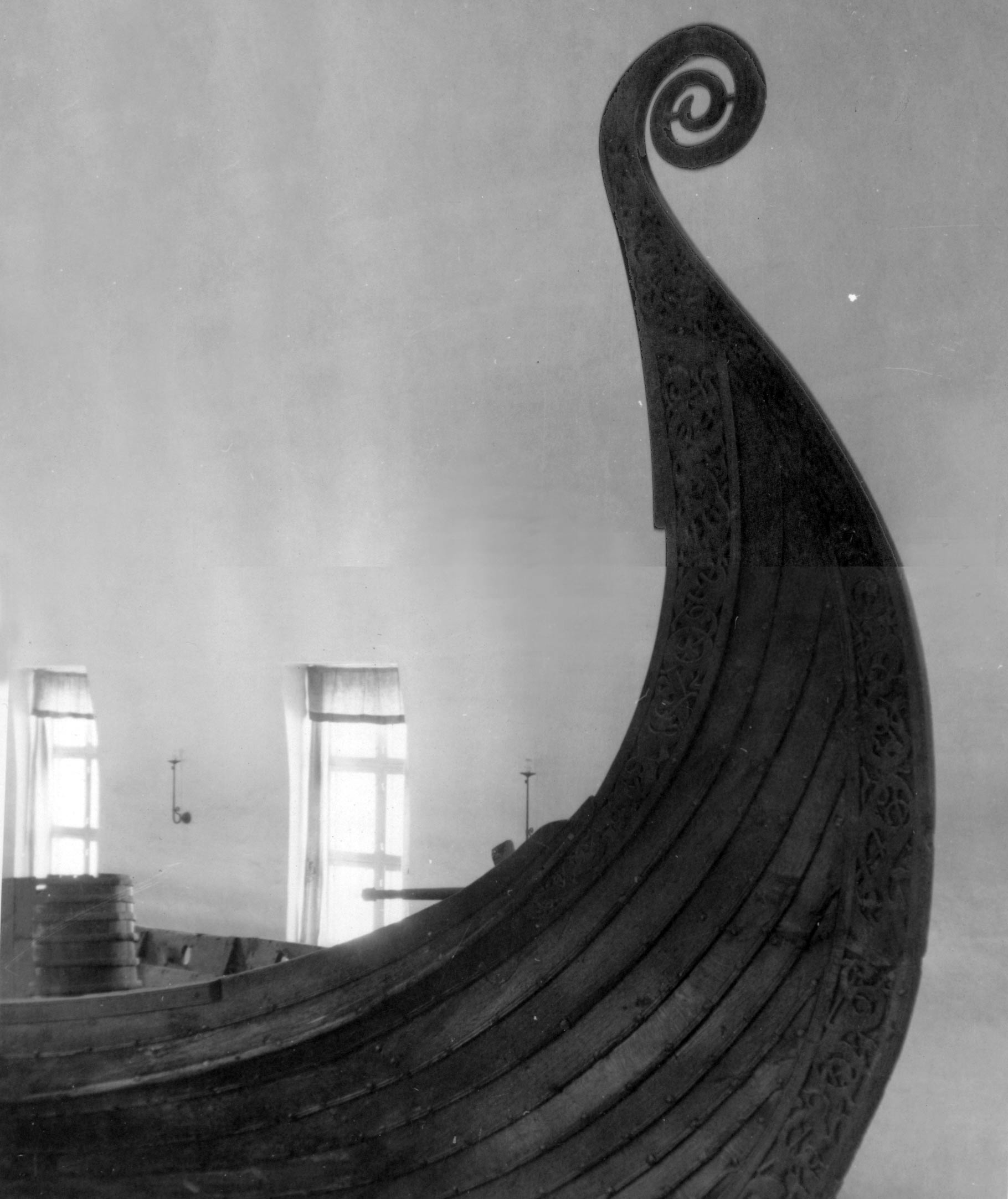
|
| Viking ship prow
|
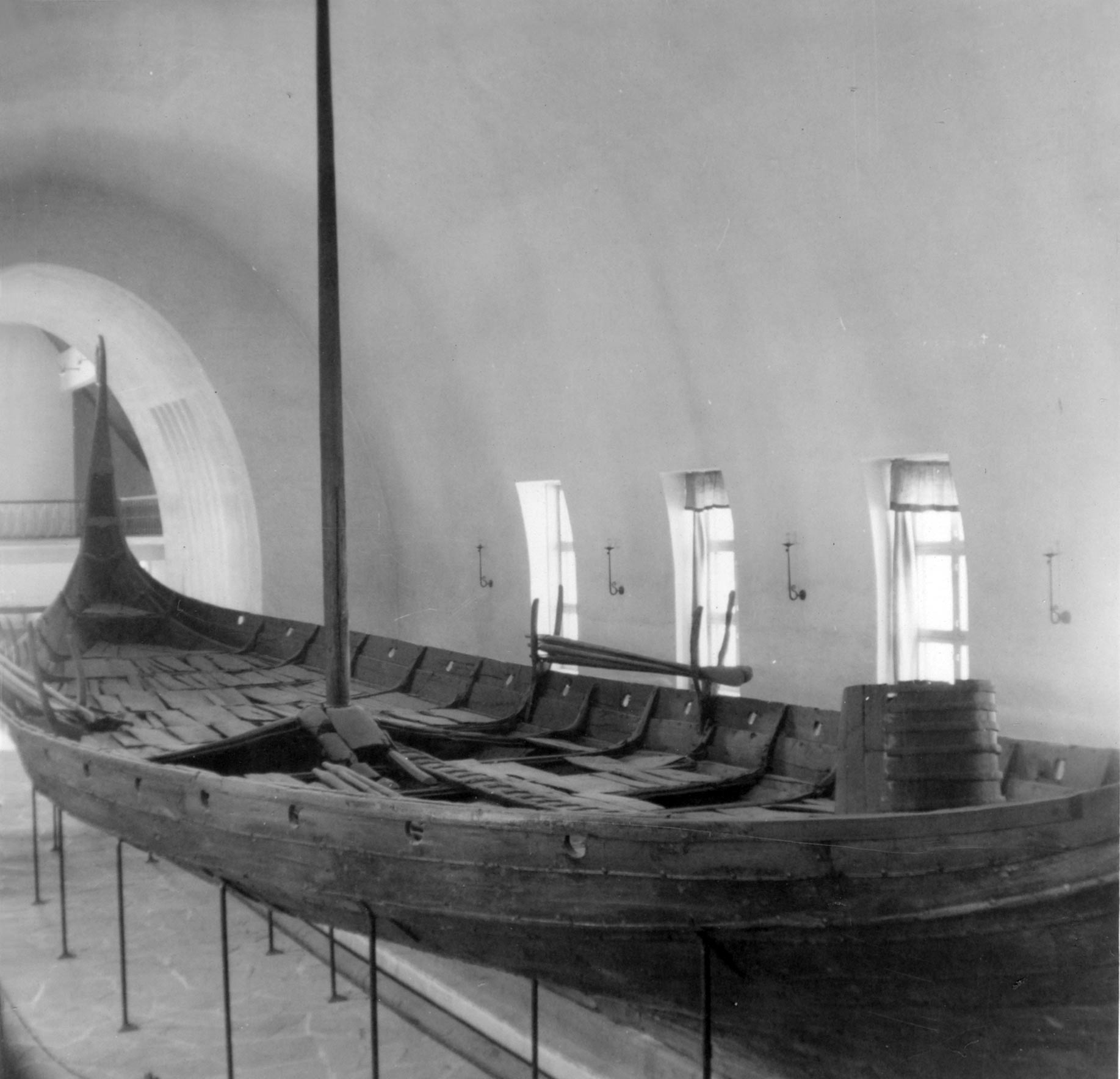
|
| Viking ship in Oslo
|
In Oslo we went to the Viking museum that had a perfectly preserved
Viking ship that had been found in the water just outside. And the 1952
Winter Olympic stadium where we went up to the top of the ski jump. On the
way back we stopped in Copenhagen for a few days, the only part I remember
is the Tivoli Gardens one night where I wandered around on my own and saw
the Delta Rhythm Boys performing in a tent. Speaking of vocal groups from
the 1930s and 40s, once I also saw the Ink Spots at the Frankfurt Officers
Club.
Reference...
- Gustav Vigeland,
Wikipedia (accessed 4 December 2023).
- Ragna Thiis Stang, The Art of Gustav Vigeland in 48 Pictures,
The Vigeland Museum Series Number 1, Johan Grund Tanum,
Oslo (1957).
Other trips
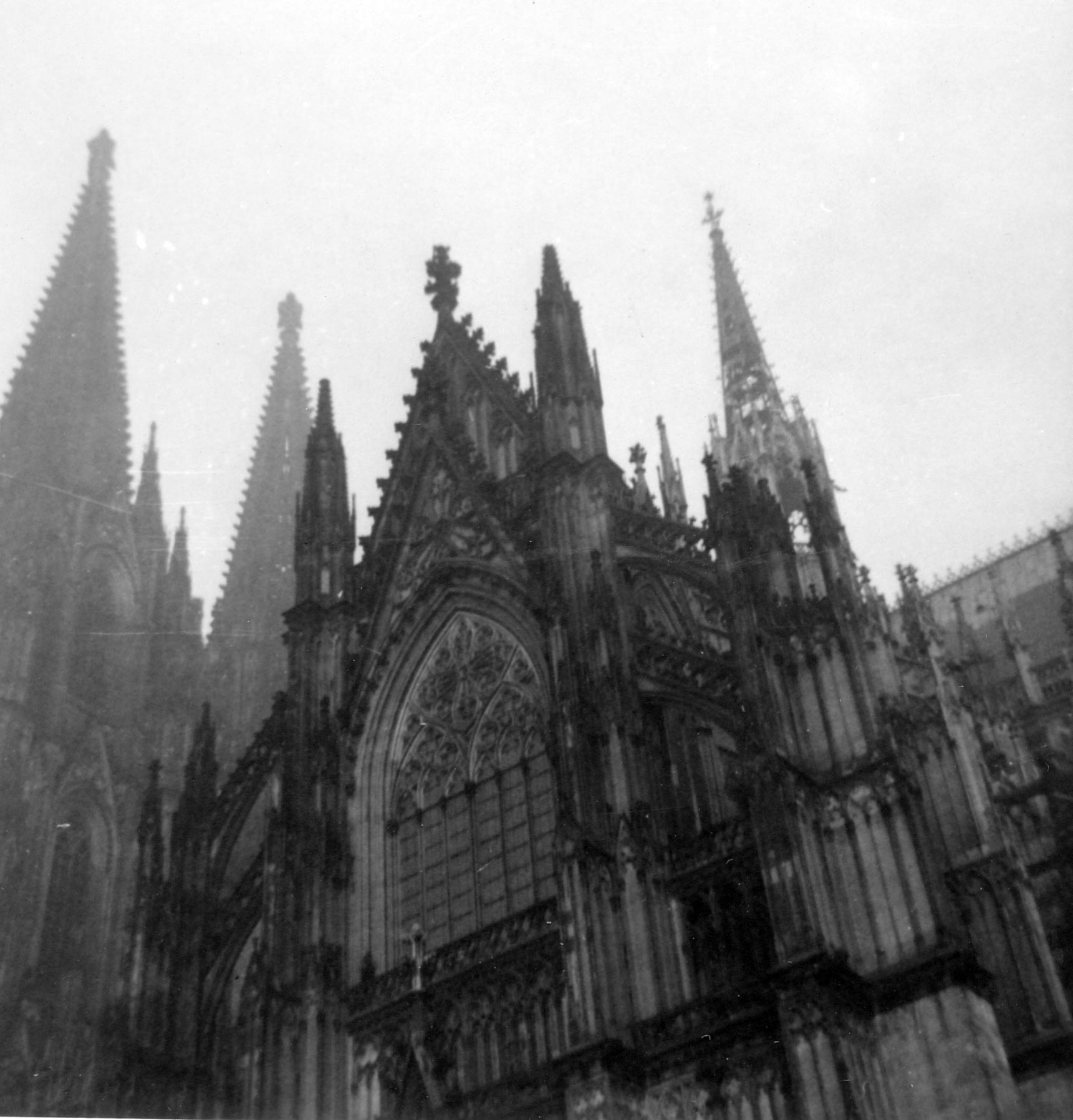
|
| Köln cathedral
|
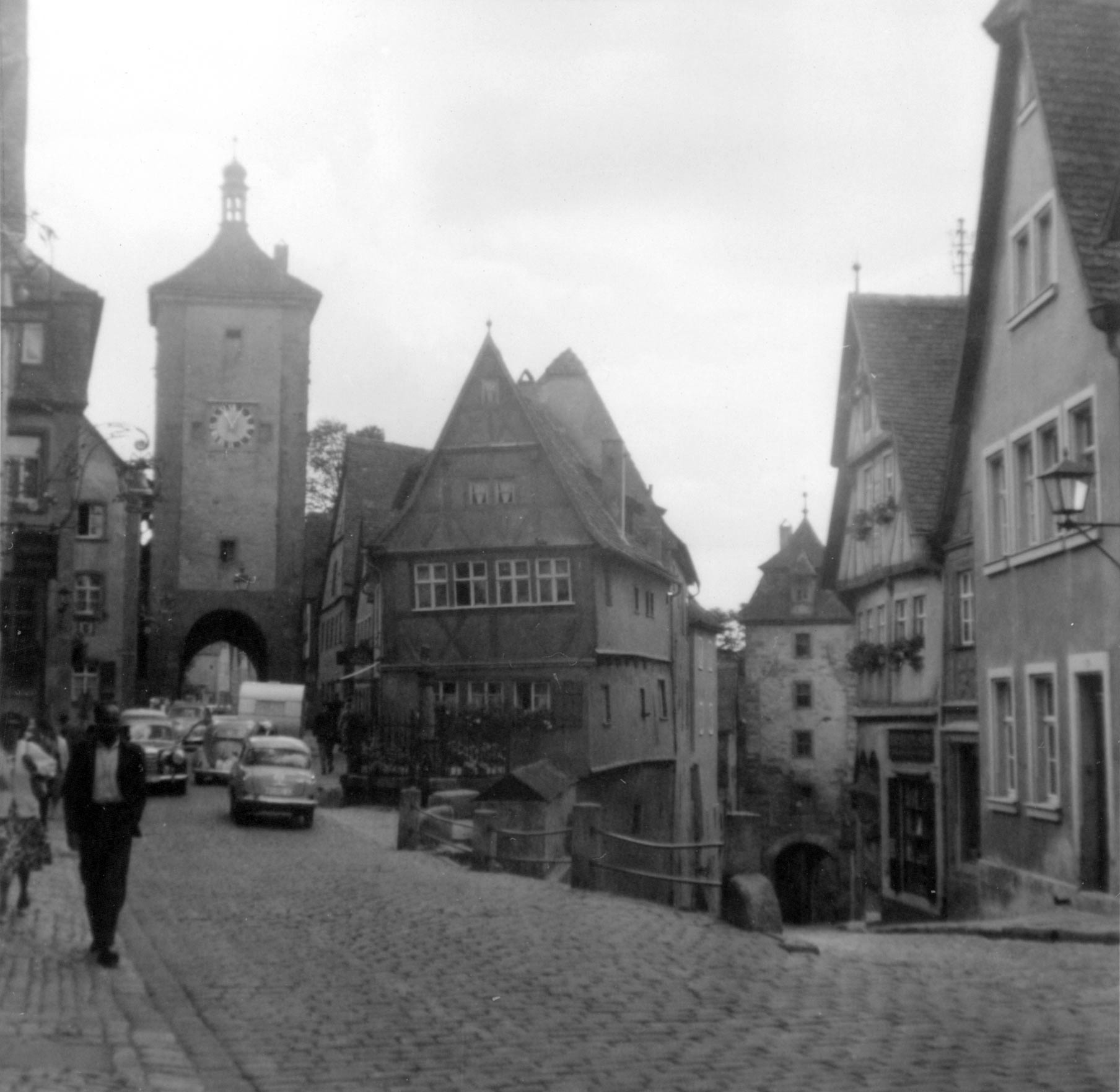
|
| Rothenburg
|
I have to hand it to my dad, he spared no expense nor effort to
take us everywhere. When I sat with him at his deathbed, it was the main
pride he had in his life. I had to agree with him. I can't even remember
all the other trips... Heidelberg, Köln (Cologne), Rothenburg (an ancient
walled city that people still live in)... Rothenburg was untouched by the
war, but Köln was flattened, all but the
cathedral,
like Frankfurt. Of
course every cathedral we visited, we climbed up to the top on ancient stone
steps worn down smooth and contoured over the centuries. The photo of
Rothenburg is probably the most-photographed spot in all of Germany. There
was also a barely remembered trip to Switzerland, where there was some kind
of expo going on in Luzern.
A trip we did NOT take, my Dad's idea of "bonding"… He wanted to take
me to Villefranche to the brothel he frequented when he was a sailor in the
1930s. No thanks.
Leaving Germany
We were supposed to stay in Germany until I graduated from high school in
1962. But my dad was caught having an affair with a woman in his office and
we were sent back a year early, in June 1961. This was a terrible blow to
me, I loved living there, I had never been happier anywhere else. I really
did not like Arlington and knew I would like it even less after finding out
how much better life could be. I tried to convince him to leave me behind,
I could be a dorm student, but no dice.
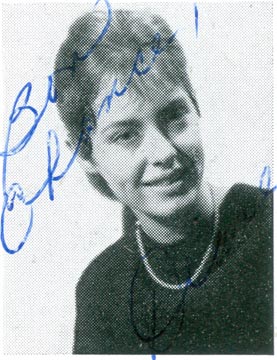
|
| Diane Sutton
|
I had to give up the Radio Club and my radio show at the hospital; I turned
it over to a friend, fellow FHS-er and Radio Club member Diane Sutton.
She was surprised and a little apprehensive but I took her along a few times
and showed her how to do everything, and she did it and she was fine.
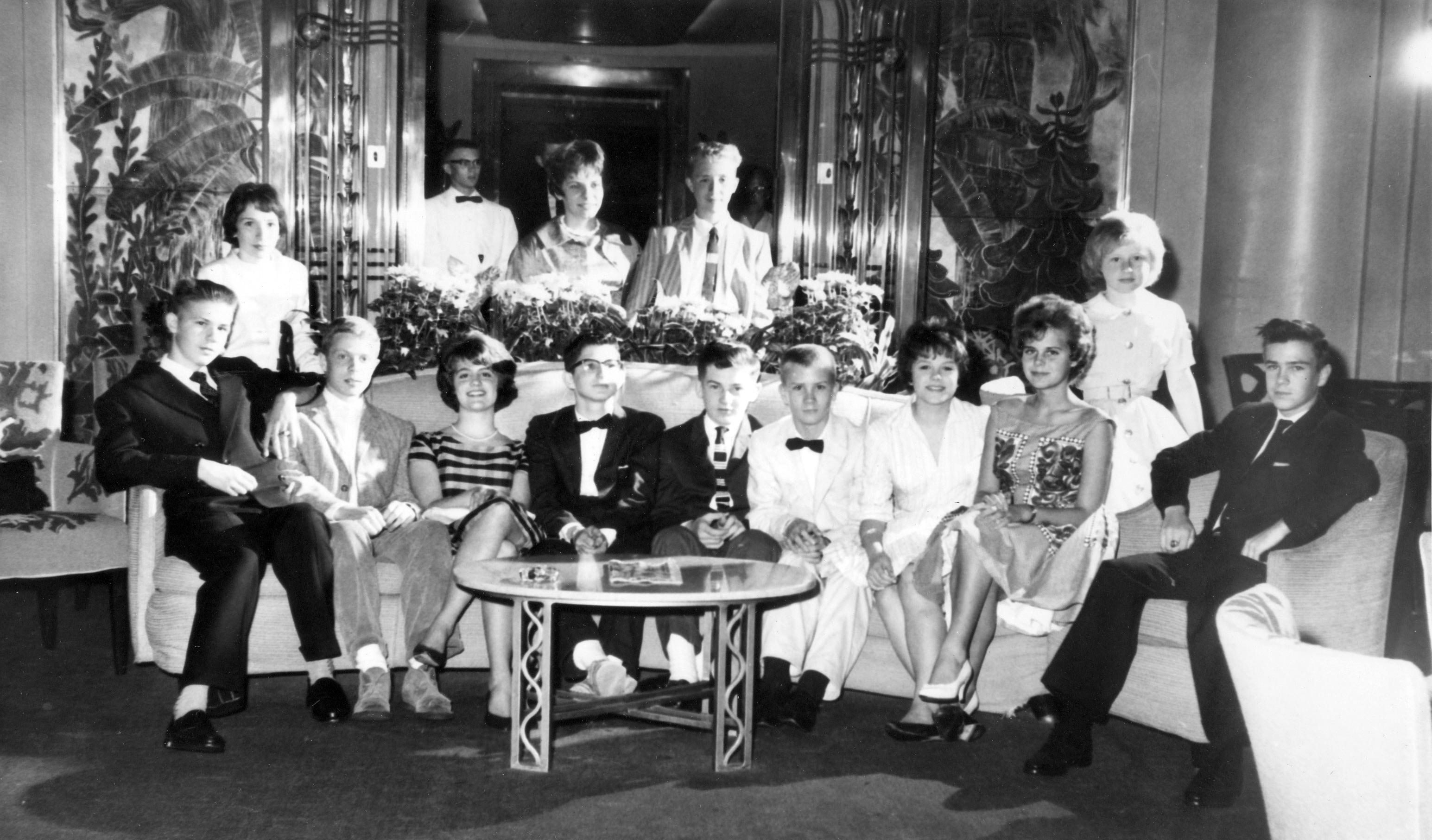
|
| On the SS America 1961
|
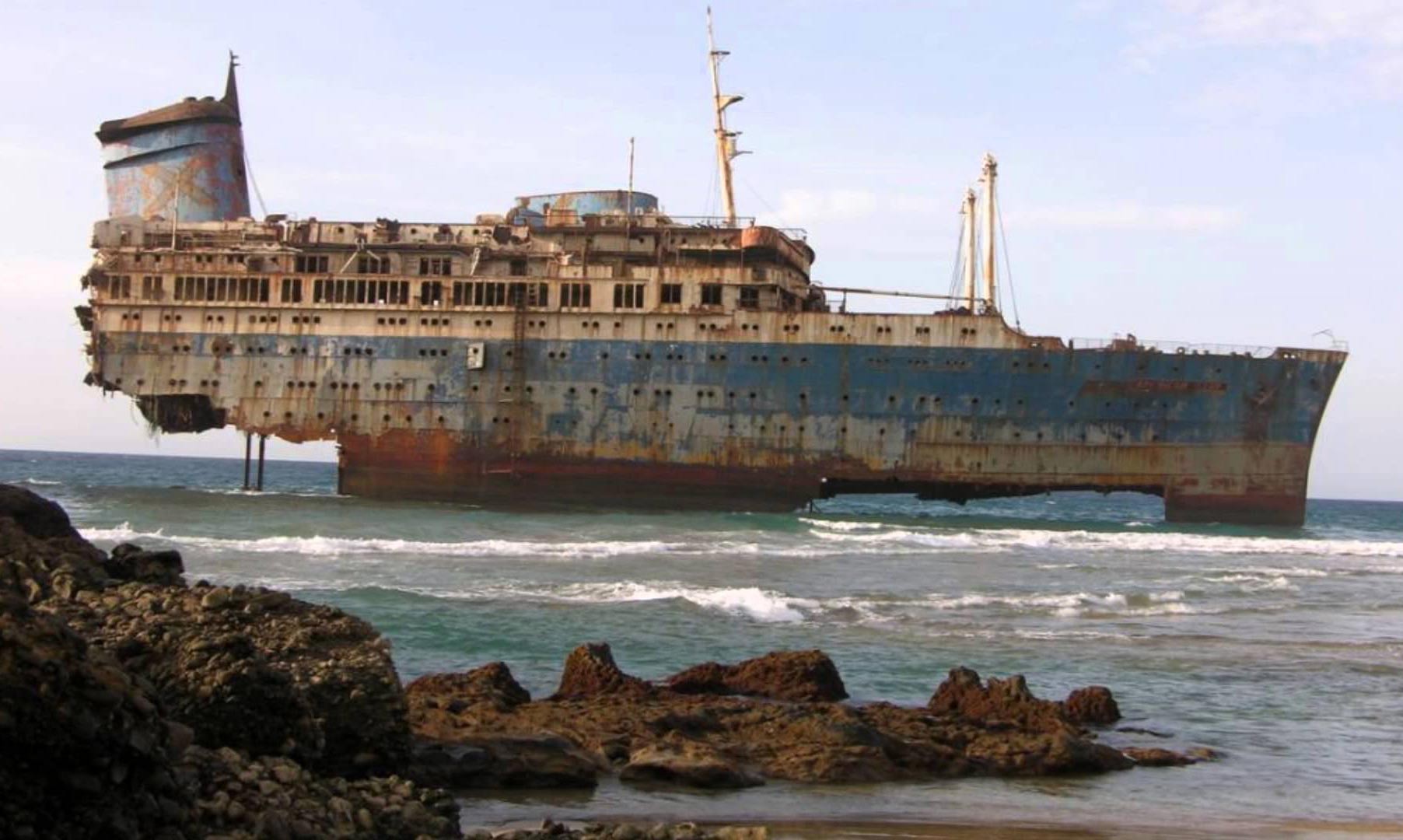
|
| SS America today
|
Now it was our turn to rotate. We traveled back the same way we came,
on the SS America, but from Le Havre (France) this time instead of
Bremerhaven. We drove there, of course, from Frankfurt, stopping in Verdun
for lunch where I was surprised to find out my dad spoke French!
I don't think he ever studied it in school; he just picked it up from
prostitutes when his Navy ship's home port was in Villefranche in the 1930s.
Anyway, some of my Frankfurt friends were on the same ship and we got our
old band together and played in the
ballroom and people danced. The voyage was from July 14 to July 21, 1961.
Later years
I visited Frankfurt High in 1963 when I was in the Army stationed in
Kaiserslautern; nothing had changed and there were still people there I knew
(story in
Army chapter).
Then again on a Sunday in 1975 with Judy on our belated honeymoon. The
school was open but nobody was there. We went in and wandered around;
everything was exactly the same except there was now a glassed-in computer
lab with
Teletypes connected to an
Interdata 7/16
minicomputer. The neighborhood was unchanged too, except the
Platenstraße buildings, once painted a variety of pastel colors, were all
white.
FHS lasted until 1995, five years after the collapse of the Soviet Union and
the end of Cold War, when the US Army pulled out of the area and gave it all
back to Germany. The buildings at WAC Circle (PX, Commissary, snack bar,
etc) were torn down and the space is now occupied by the new Hessisches
Polizeipräsidium. The IG Hochhaus is now a campus of Goethe University.
Frankfurt High School is now the Phillipp-Holzmann Schule; its athletic
field survived until about 2020 when it became the site of the new Adorno
Gymnasium. The American housing areas except HiCoG are now occupied by
Germans, Turks, Greeks, Syrians, and other residents of Germany; the 3-story
buildings are pastel colors again but the
"redensified" ones are white. HiCoG houses
the American consular families.
References...
- Farewell to Frankfurt,
Karl Weisel, Soldiers, The Official U.S. Army Magazine,
Volume 50, Number 1 (January 1995), pp.22-23.
- Frankfurt High's Final Bell,
Helke Hasenauer, Soldiers, op.cit., pp.24-25.
- The
Abrams Building and the American Experience in Frankfurt 1945-1995,
V Corps 30-minute video (1995).
- Report 4:
Restructuring the US Bases in Germany, Internationales Konversionszentrum
Bonn (June 1995).
 Other galleries:
Other galleries:




















































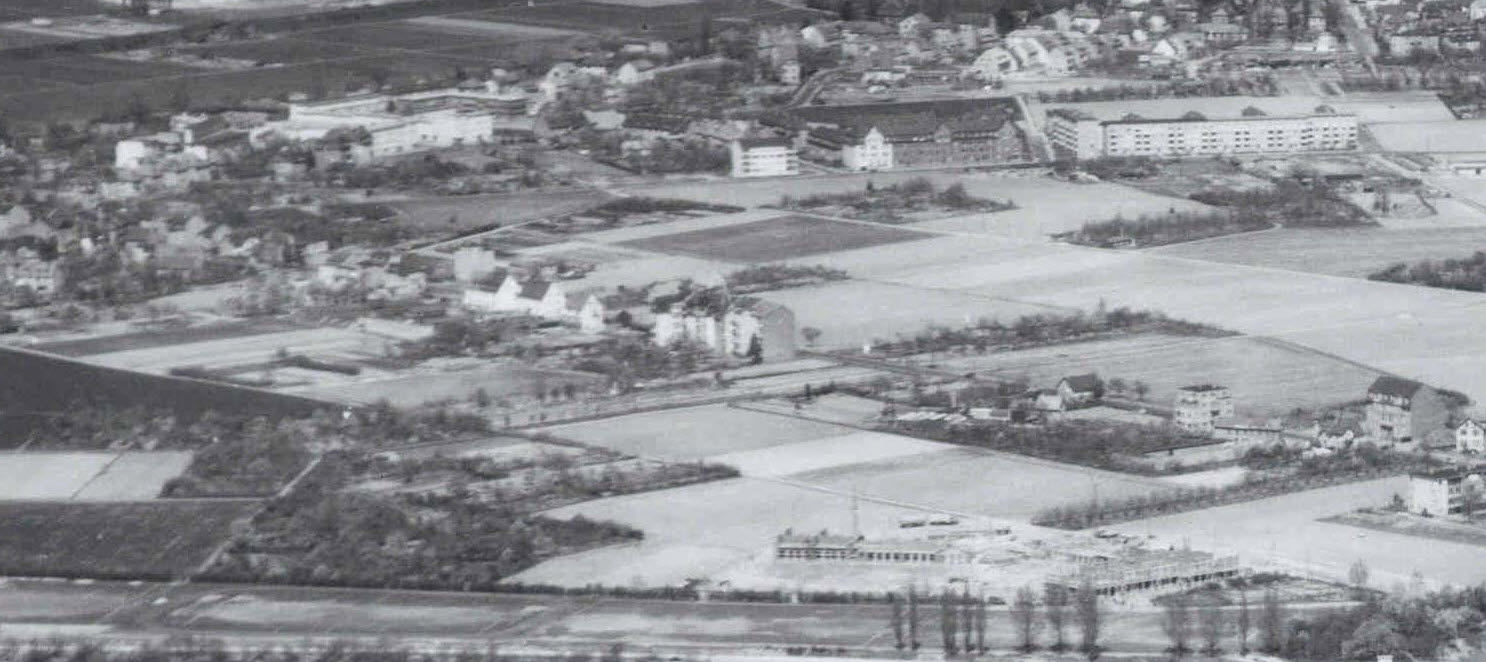
















 Starting in 1946, the US Department of Defense Dependents Schools (DoDDS)
made schooling available to children of military, consular, and other
American families in Germany and other occupied
countries[7]. So the correct way to refer to
these schools is DOD or DoDDS schools, but we always called them Army
schools. Why? Because (1) there was no Navy, Air Force, Marines, or Coast
guard in Frankfurt, it was all Army; and (2) the sign on our school said
"U.S. ARMY FRANKFURT HIGH SCHOOL" as seen on the inset, that comes from the
far right of this photo. Other
American school signs in Germany also said U.S. Army, such as
this one in Kaiserslautern.
Starting in 1946, the US Department of Defense Dependents Schools (DoDDS)
made schooling available to children of military, consular, and other
American families in Germany and other occupied
countries[7]. So the correct way to refer to
these schools is DOD or DoDDS schools, but we always called them Army
schools. Why? Because (1) there was no Navy, Air Force, Marines, or Coast
guard in Frankfurt, it was all Army; and (2) the sign on our school said
"U.S. ARMY FRANKFURT HIGH SCHOOL" as seen on the inset, that comes from the
far right of this photo. Other
American school signs in Germany also said U.S. Army, such as
this one in Kaiserslautern.















 The Straw Bar, unlike the other rowdy dives just listed, was sedate and
civilized, owned by a nice lady. Nobody knows why we called it the Straw
Bar; it wasn't labeled that way. A bunch of us guys and girls would go
there and sit around a large round table playing Hearts all night, drinking
white Mosel Wein out of Römers (photo at left) rather than the customary
Bier in Steins, in deference to the ladies, much more refined and
sophisticated.
The Straw Bar, unlike the other rowdy dives just listed, was sedate and
civilized, owned by a nice lady. Nobody knows why we called it the Straw
Bar; it wasn't labeled that way. A bunch of us guys and girls would go
there and sit around a large round table playing Hearts all night, drinking
white Mosel Wein out of Römers (photo at left) rather than the customary
Bier in Steins, in deference to the ladies, much more refined and
sophisticated.
















